This Printmaking Process Means “stone Writing” In Greek.
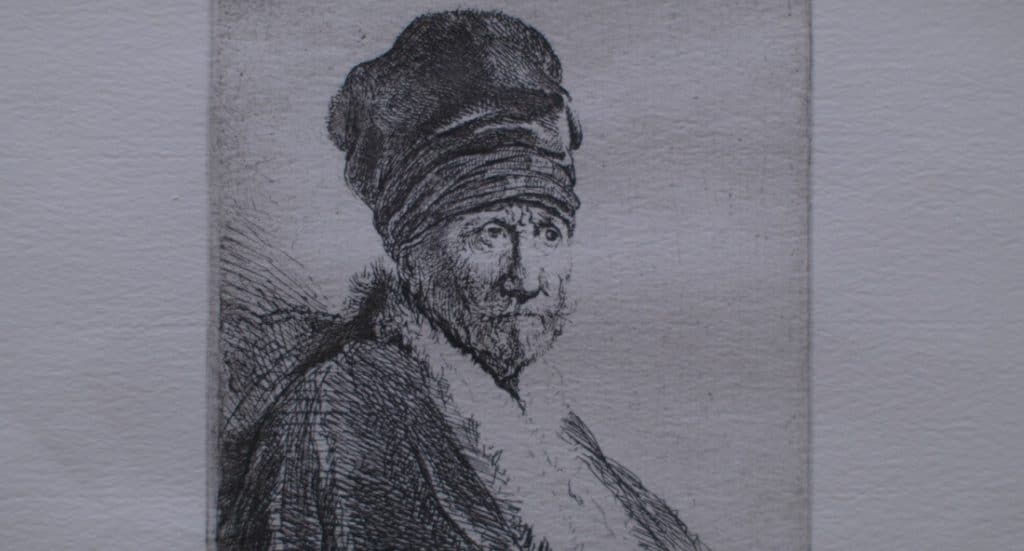
Even centuries after his lifetime, Rembrandt's etchings are still considered some of the finest examples of the medium. His innovations to the art of etching would go on to influence Goya, Picasso, Chagall, and generations of artists to come. Following Rembrandt's passing in 1669, his remaining copper etching plates virtually stayed intact as they passed […]
The post The Inside Story Behind Rembrandt's 8 Amazing Millennium Etchings appeared first on Park West Gallery.
]]>
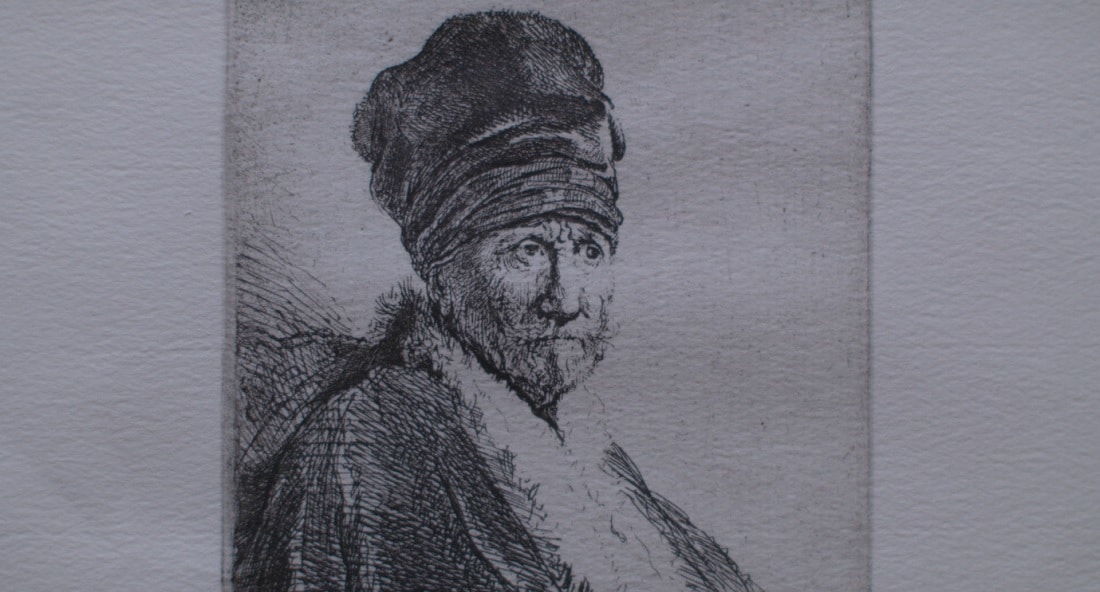
Detail from Rembrandt's 1630 etching "Bust of a Man Wearing a High Cap; Three-Quarters"
Even centuries after his lifetime, Rembrandt's etchings are still considered some of the finest examples of the medium. His innovations to the art of etching would go on to influence Goya, Picasso, Chagall, and generations of artists to come.
Following Rembrandt's passing in 1669, his remaining copper etching plates virtually stayed intact as they passed from collector to collector until 1993 when a sale at the London Original Print Fair dispersed the plates around the globe. The UK Independent, at the time, described the plates being sold as "like chips off the True Cross."
Following the 1993 sale, collector Howard Berger acquired eight of the plates. He then teamed with master printers Emiliano Sorini and Marjorie Van Dyke to pull impressions from Rembrandt's original copper plates.
The edition was limited to only 2,500 impressions of each image, pulled over a ten-year period in the last decade of the 20th century, which is why it has become known as the "Millennium Edition."
Today, Park West Gallery owns all eight of the Millennium Edition plates, which are now on extended loan to the North Carolina Museum of Art.
While their beauty is undeniable, the eight Millennium etchings also give fantastic insight into Rembrandt's personal life and what it was like to live in the 17th century.
Join us for a look at eight of Rembrandt's finest etchings and the inside details that inspired their creation:
"Landscape with a Cow Drinking" (ca. 1650)
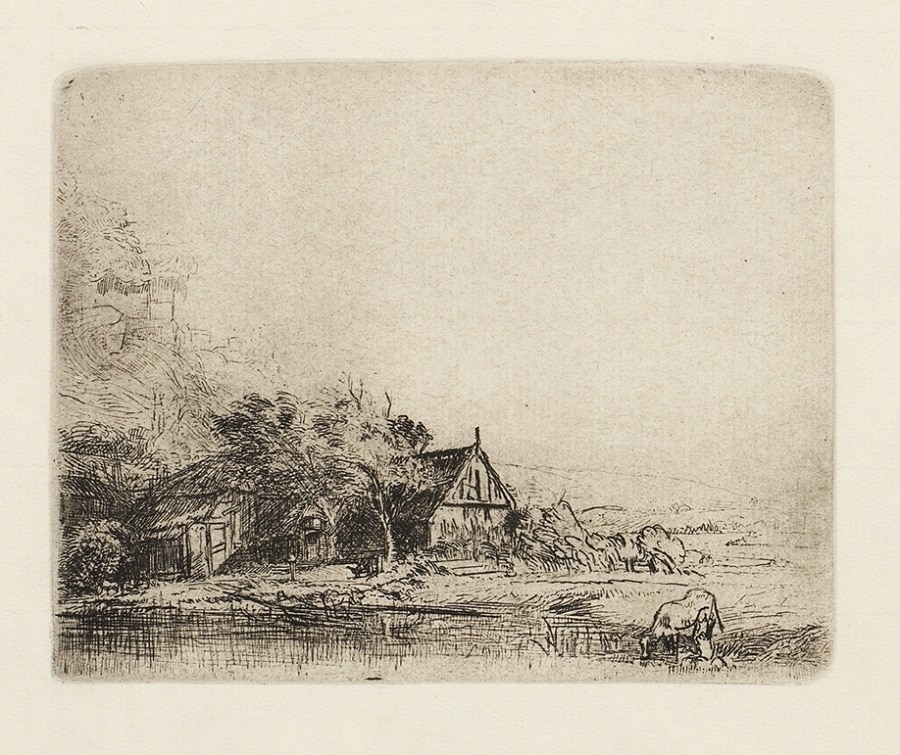
"Landscape with a Cow Drinking" (ca. 1650)
It is believed that, in this peaceful pastoral image, Rembrandt combined the landscape in the foreground—showing the countryside surrounding Amsterdam—with a series of mountains in the distance taken from a location hundreds of miles away.
To achieve the atmospheric quality found in this etching. Rembrandt employed very delicate linework created with a fine-etching needle.
Around the time of the creation of this etching plate (ca. 1650), Rembrandt's financial status began to deteriorate and grow desperate, and he was unable to make his mortgage and tax payments any longer. Scholars often suggest that this etching and other landscapes of the period may reflect his desire to be transported to peaceful and idyllic places far away from the troubles in his life.
"The Golf Player" (1654)
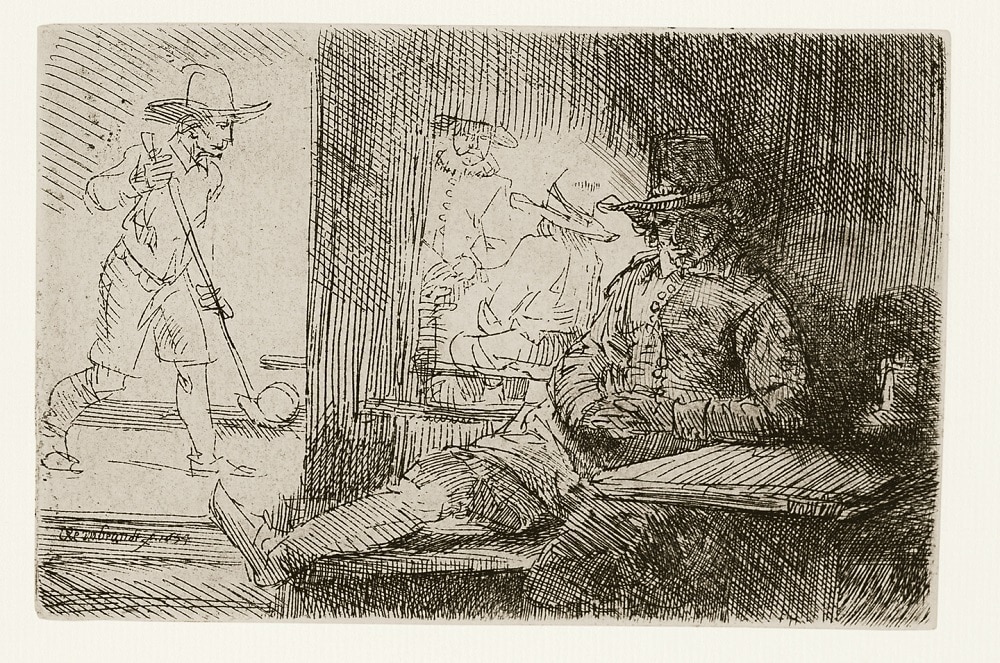
"The Golf Player" (1654)
The 17th-century game "Kolf," which lent its name to the modern game of golf, was extremely popular in Rembrandt's lifetime. Rembrandt's use of chiaroscuro in this etching—with its strong contrast of interior and exterior—reveals his ability to selectively use areas of light and shade to focus the viewer on the interior sitter.
This amusing and delightful genre scene of 17th-century Amsterdam was created the same year that Rembrandt's mistress, Hendrickje Stoffels, gave birth to their daughter, Cornelia.
"The Artist's Mother with Her Hand on Her Chest" (1631)
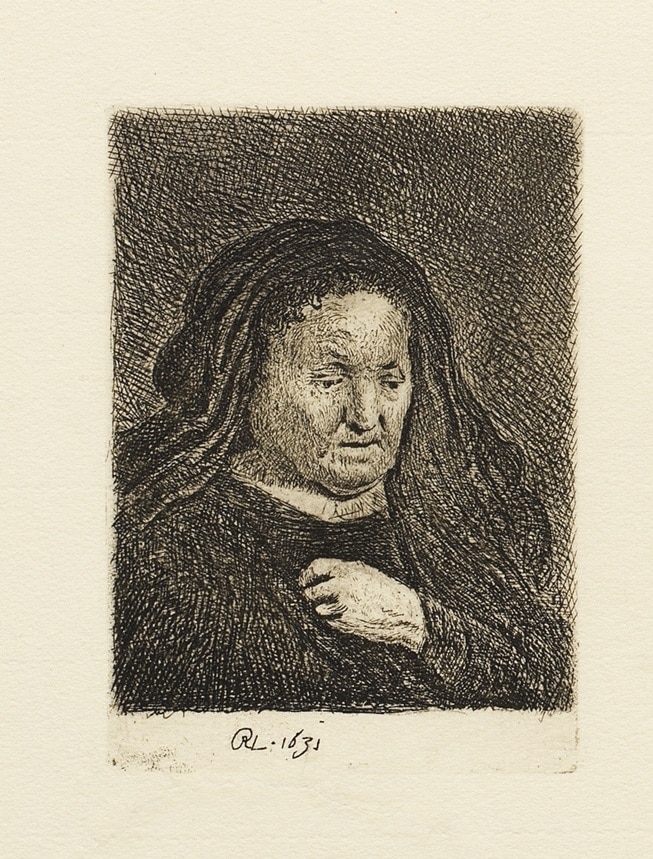
"The Artist's Mother with Her Hand on Her Chest" (1631)
In this poignant portrait, Rembrandt captures his mother's careworn face and tender expression as she is found in contemplation, her eyes cast downward. The position of her hand upon her chest suggests the importance of her thoughts and closeness to her heart.
The darkly etched dress and veil heighten the drama of the image, and the curve of the veil around and over her face creates an angelic effect, reinforced by the light behind.
In 1589, Rembrandt's mother, Neeltgen Willemsdochter van ZuytBrouck, married Harmen Gerritszoon van Rijn in Leiden, Holland. Rembrandt was the next to youngest of their nine children, two of whom died in infancy. Rembrandt created six etchings of his mother and several paintings of her as well. This work is an excellent example of Rembrandt's "psychological portraiture," where the sitter's humanity and spiritual essence are more deeply expressed than their mere physical likeness.
"Bust of a Man Wearing a High Cap; Three-Quarters" (1630)
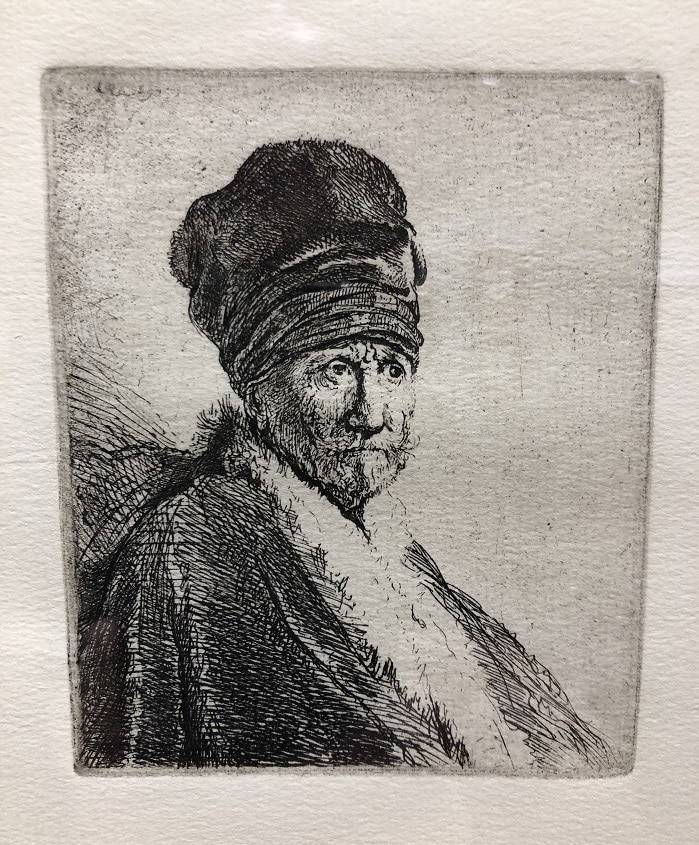
"Bust of a Man Wearing a High Cap; Three-Quarters" (1630)
Art historians believe that this etching depicts Rembrandt's father, although no conclusive evidence exists that supports this belief. Rembrandt's father, Harmen Gerritszoon van Rijn, was a miller and owned a half-interest in a windmill called "De Rijn."
In this delicate and facile portrait, Rembrandt depicts a man with a resolute jaw, earnest eyes, and a focused and intent expression, all qualities one could easily associate with the wisdom and fortitude of one's father. The exotic and ornate dress of the sitter—wearing a turban and coat—may suggest Rembrandt's desire to portray his father as a man of importance. His father died the same year this etching was completed.
"The Card Player" (1641)
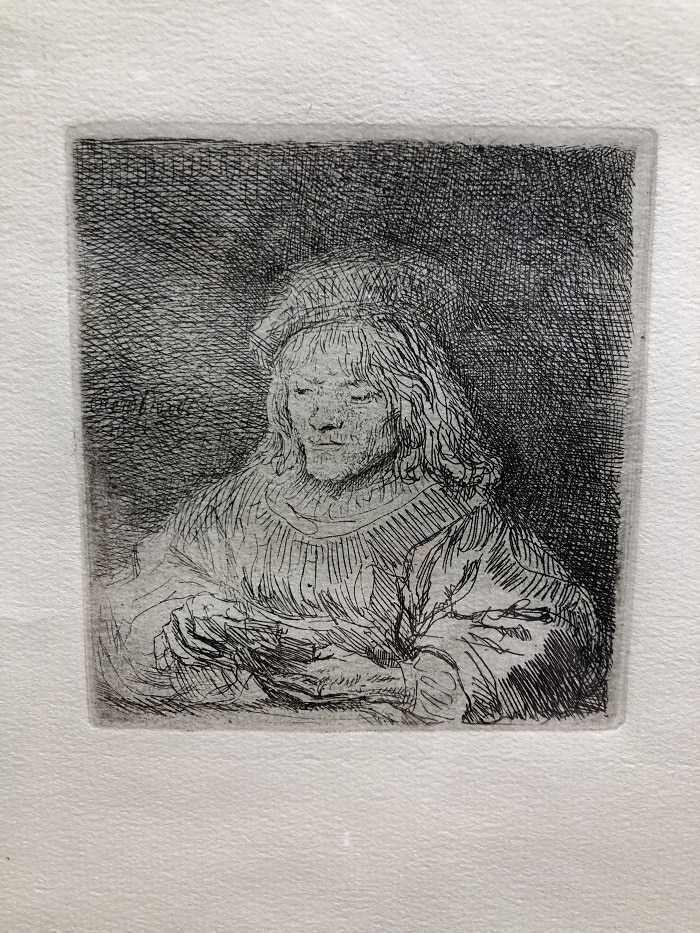
"The Card Player" (1641)
This etching reveals Rembrandt's mastery of depicting the character of his sitter, as the small, shifting eyes of the subject (thought to be a pupil of Rembrandt's) express his distrust of his opponents in the card game.
"The Card Player" also represents a major step forward in Rembrandt's experimentation with etching as he employs drypoint and burnishes to create the rich tonal effects found in the work. The extensive cross-hatching in the deep shadows behind the subject highlights the features of the sitter and enforce Rembrandt's desire to focus the viewer on his features.
"Christ and the Woman of Samaria: Among Ruins" (1634)
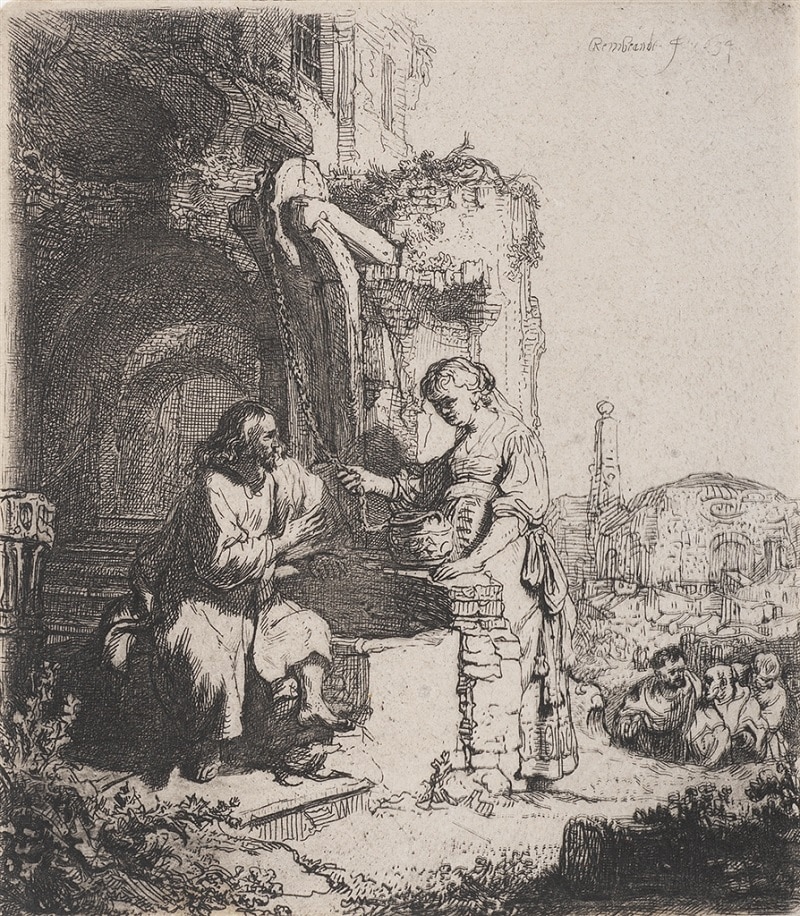
"Christ and the Woman of Samaria: Among Ruins" (1634)
In this dramatic Biblical scene, created with strong shadows and contrast, Rembrandt depicts the moment that Jesus revealed himself as the Messiah to the Woman of Samaria.
According to the Gospel of John, Christ and his Apostles stopped in Samaria on their way from Judea to Galilee and rested by Jacob's well near the town of Sychar. While Jesus was resting alone, a Samaritan woman came to the well to fetch water and Jesus asked the woman to give Him a drink. Jesus revealed that He was the Messiah and told the woman that "whosoever drinketh of the water I shall give them shall never thirst and have everlasting life." This story is also the subject of another etching, a drawing, and three paintings by Rembrandt.
Rembrandt's Biblical subjects comprise a substantial portion of his etching oeuvre. They have traditionally been some of his most desirable etchings amongst collectors and were innovative for their time in the manner in which they reveal Christ's personal interactions with the people of His time.
"Self Portrait Drawing at a Window" (1648)
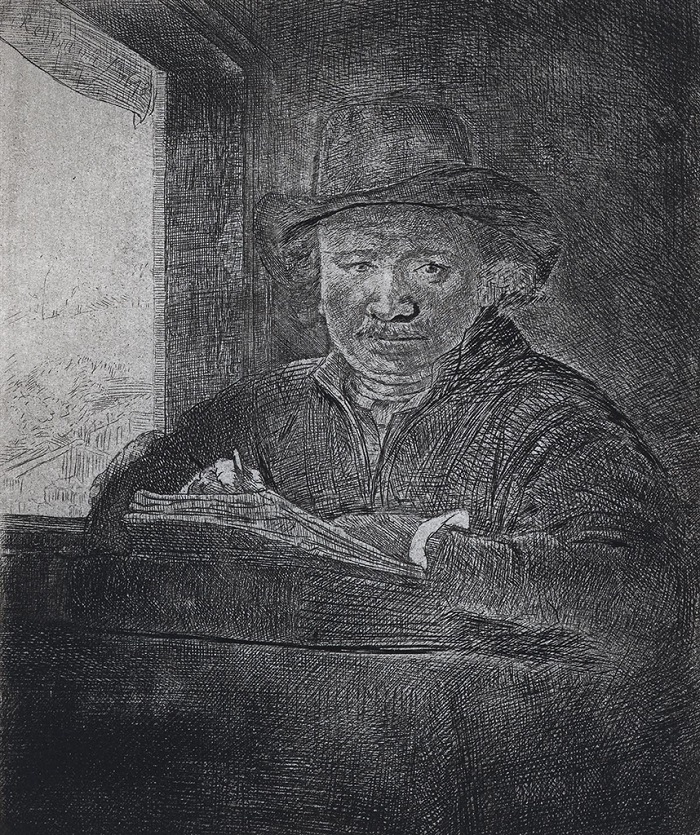
"Self Portrait Drawing at a Window" (1648)
In 1629, Rembrandt began to paint and etch his first self-portraits. Throughout his career, he would produce many subsequent self-portraits in both mediums. However, scholars differ as to Rembrandt's motivation for creating self-portraits.
While some have posited that he simply could not afford to pay for models, the more likely reason relates to his pursuit of "psychological portraiture." Rembrandt used his own face in an effort to reveal the human and spiritual nature of the etching's subject—which was a revolutionary approach for the time.
In this extraordinary image, Rembrandt depicts himself drawing at a window, as the light from the window seeps into the space and creates a symbolic dramatic contrast. Rembrandt's face is illuminated, but the interior of the room is cast in darkness.
He created this work in 1648 at the age of forty-two, after a troubled six-year period during which he etched no self-portraits. During that time, Rembrandt's wife Saskia died, his financial situation worsened, and his relationship with Geertge Dircx, the nursemaid of his young son, Titus, became troubled and later culminated in a court battle.
The work clearly depicts a man at maturity, contemplating his life, and suggests a wise, if not beleaguered man who has tasted life's joys and sorrows. This was the last self-portrait ever etched by Rembrandt.
"The Raising of Lazarus: The Larger Plate" (c. 1630)
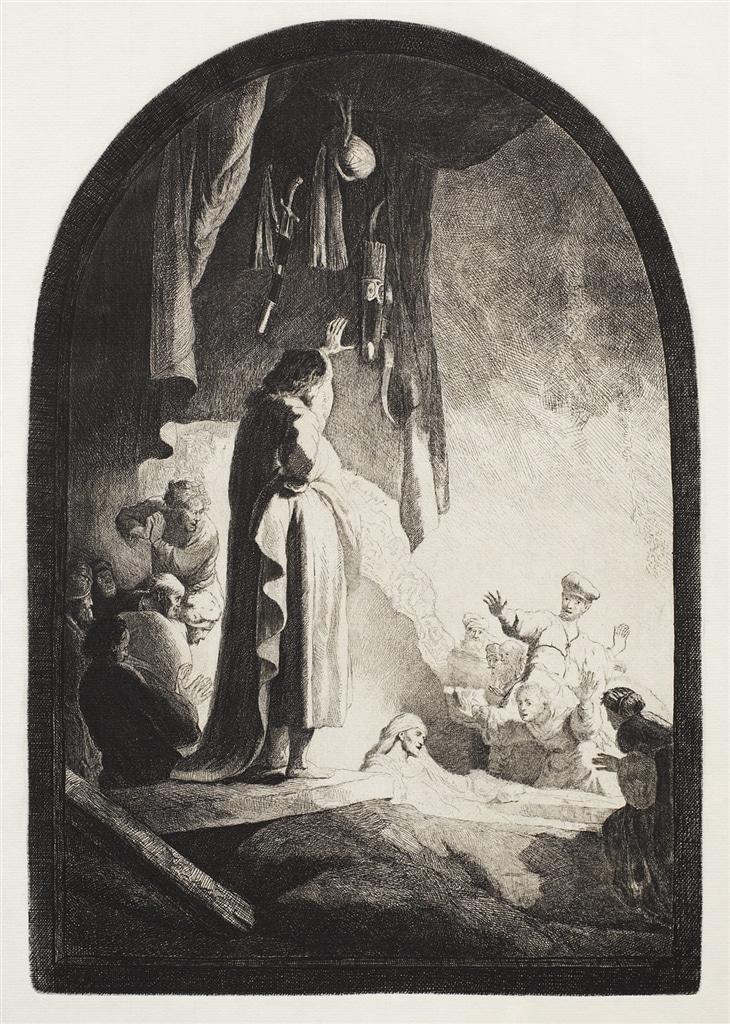
"The Raising of Lazarus: The Larger Plate" (c. 1630)
In this, one of Rembrandt's most astonishing and powerful works, he captures the dramatic scene as Jesus commands Lazarus to "come forth" from the dead. The figure of Jesus, seen from a three-quarter back view, is against the dark tomb wall. As Lazarus rises from the dead, Mary and Martha lean in over the edge of the tomb, their upraised hands signifying their faith and readiness to embrace their beloved brother.
The faces of the onlookers express open-mouthed amazement at Jesus' miracle. Rembrandt uses powerful contrasts in this work to evoke a heightened drama through his distinct use of light and shadow. Lazarus and the faces of the onlookers are bathed in the light of Christ, while the surrounding darkness symbolizes the blackness of death.
Rembrandt experimented greatly and labored over this work intensely, creating no fewer than ten states or variations in the evolution of the plate. It is a perfect example of the Baroque use of chiaroscuro, the strong contrast of light and shadow, to evoke a theatrical and highly emotional image. "The Raising of Lazarus" was extremely well-received by his contemporary collectors and remains one of the most sought-after etchings of Rembrandt's oeuvre to this day.
If you're interested in collecting the works of Rembrandt van Rijn or another master artist, please contact one of our gallery consultants at (800) 521-9654 ext. 4 during business hours or email sales@parkwestgallery.com for inquiries after hours.
The Park West Museum in Southfield, Michigan has over 20 examples of Rembrandt's remarkable etchings on display—including examples of all eight Millennium Impressions. For more information on visiting the museum, click here.
The post The Inside Story Behind Rembrandt's 8 Amazing Millennium Etchings appeared first on Park West Gallery.
]]>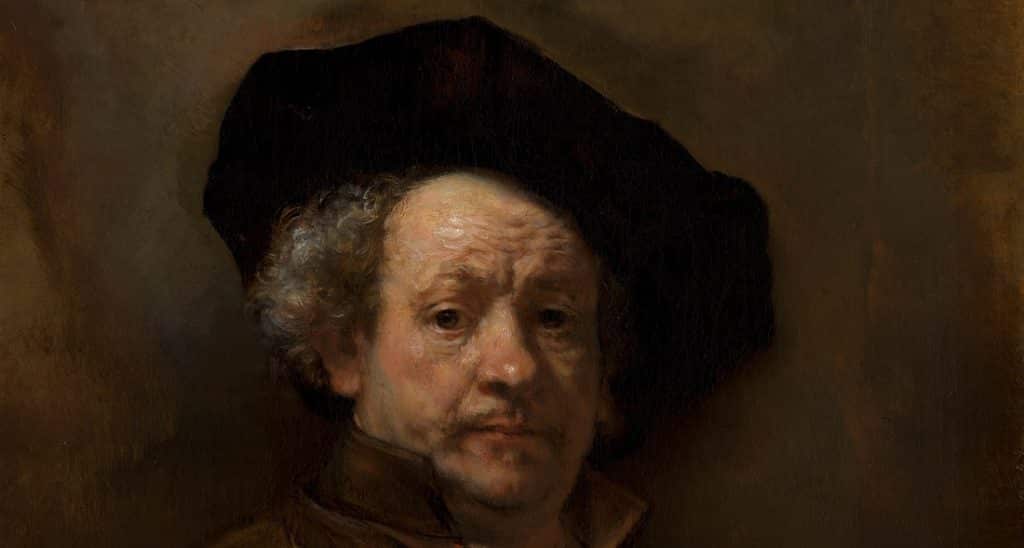
Nearly 400 years ago, Dutch visionary Rembrandt van Rijn famously wrote: "Choose only one master—nature." True to his muse, Rembrandt's magnitude continues to puzzle those in its presence. There are arguably few other artists who embody a talent so vast and incomprehensible, earthly, yet simultaneously immortal. As a tribute to his significance, the notable Spanish […]
The post Behind the Artist: Rembrandt van Rijn appeared first on Park West Gallery.
]]>
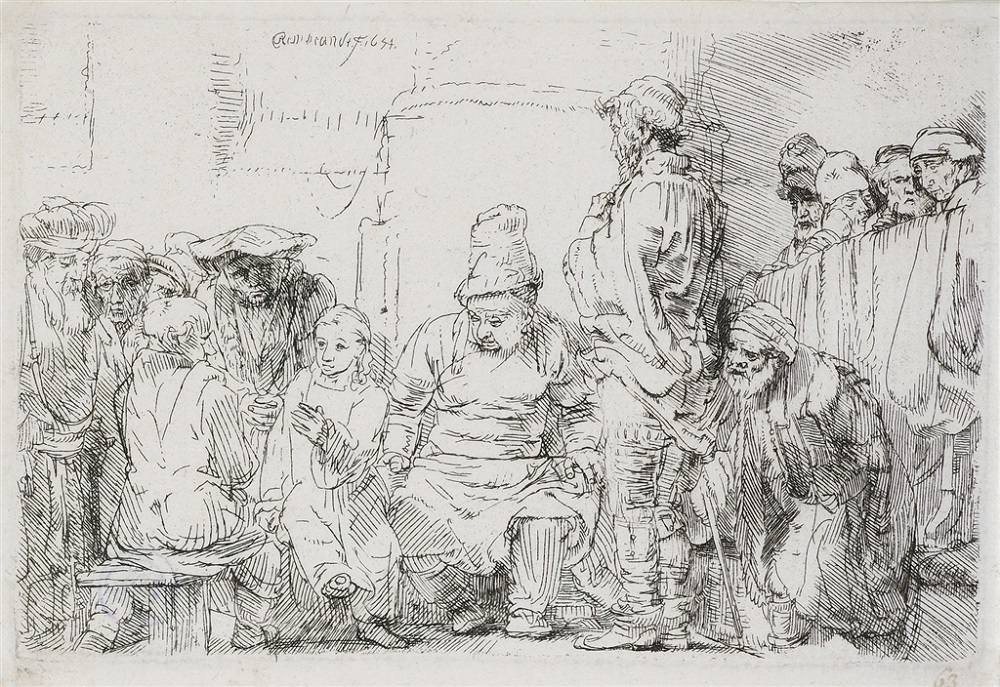
"Christ Seated Disputing with the Doctors" (1658), Rembrandt van Rijn
Nearly 400 years ago, Dutch visionary Rembrandt van Rijn famously wrote: "Choose only one master—nature."
True to his muse, Rembrandt's magnitude continues to puzzle those in its presence. There are arguably few other artists who embody a talent so vast and incomprehensible, earthly, yet simultaneously immortal.
As a tribute to his significance, the notable Spanish court painter Francisco Goya would later revise Rembrandt's statement to say: "I have had three masters—nature, [Diego] Velázquez, and Rembrandt."
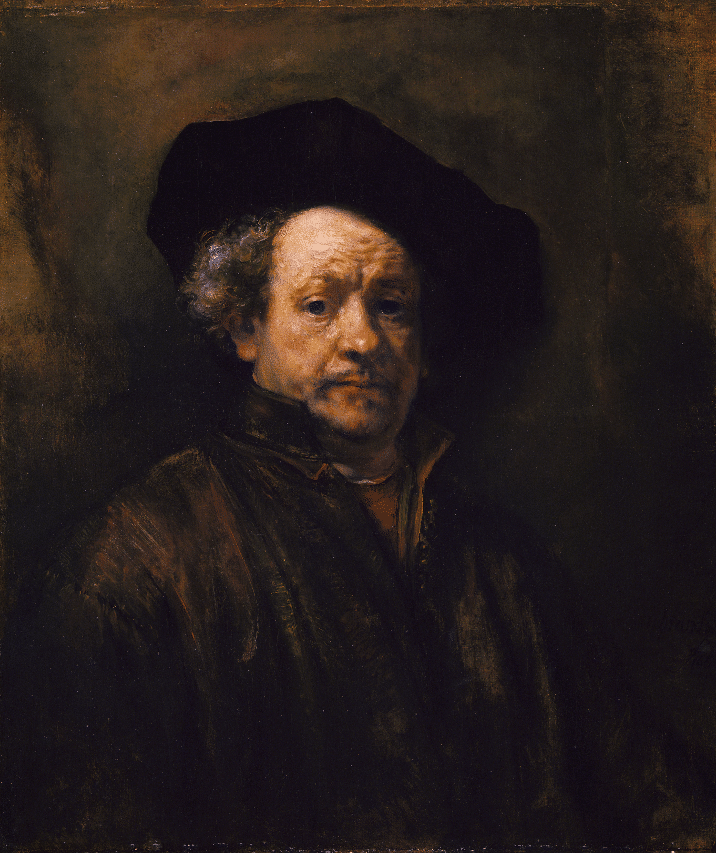
"Self-Portrait" (1660), Rembrandt van Rijn. Image Public Domain. Courtesy of Wikimedia Commons.
Born on July 15, 1606 in the Dutch Republic of Leiden, Rembrandt tenaciously developed his artistic talent at an early age. Working between the two foremost intellectual centers of the Baroque Age—Leiden and Amsterdam—Rembrandt opened a studio and began accepting students before the age of 22. By 1631, Rembrandt had officially settled in Amsterdam after boasting rapid success from the court of The Hague and Prince Frederik Hendrik.
Rembrandt's success was infectious, if not unstoppable. From leaders of the Dutch municipality to the scholastic elite, wealthy patrons eagerly commissioned portraits from the real-time celebrity, coveting the imperfect nobility he endowed in his work. As a subject of study, the artist's portraits are viewed as a manifestation of the human condition—brutal, triumphant, truthful, and transcendent.
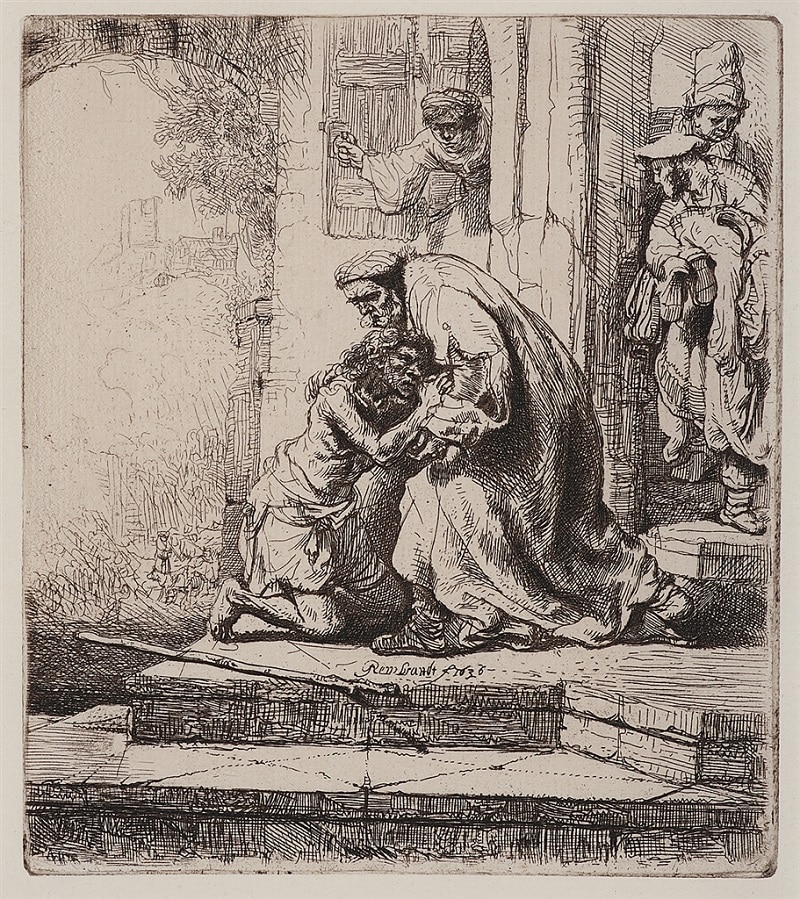
"Return of the Prodigal Son" (1636), Rembrandt van Rijn
Rembrandt's legacy is grounded in his deeply technical and empathetic understanding of representation, encouraging a prolific and versatile career across many media. As an embodiment of the sorrow he worked to portray, Rembrandt's unyielding rise to success was met with an equally merciless downfall.
Father of Printmaking
Though Rembrandt is commonly appreciated for his dexterity as a painter, he is widely considered to be one of history's most innovative and influential printmakers. The artist created more than 300 etchings and drypoints between 1626 and 1660 before selling his printing press due to financial hardship.
It is documented that the versatile master was thoroughly involved in the entire printmaking process, unlike many of his contemporaries. To Rembrandt, etching was the pinnacle of free expression; he is said to have carried a copper plate and burin as most artists would a sketchbook.
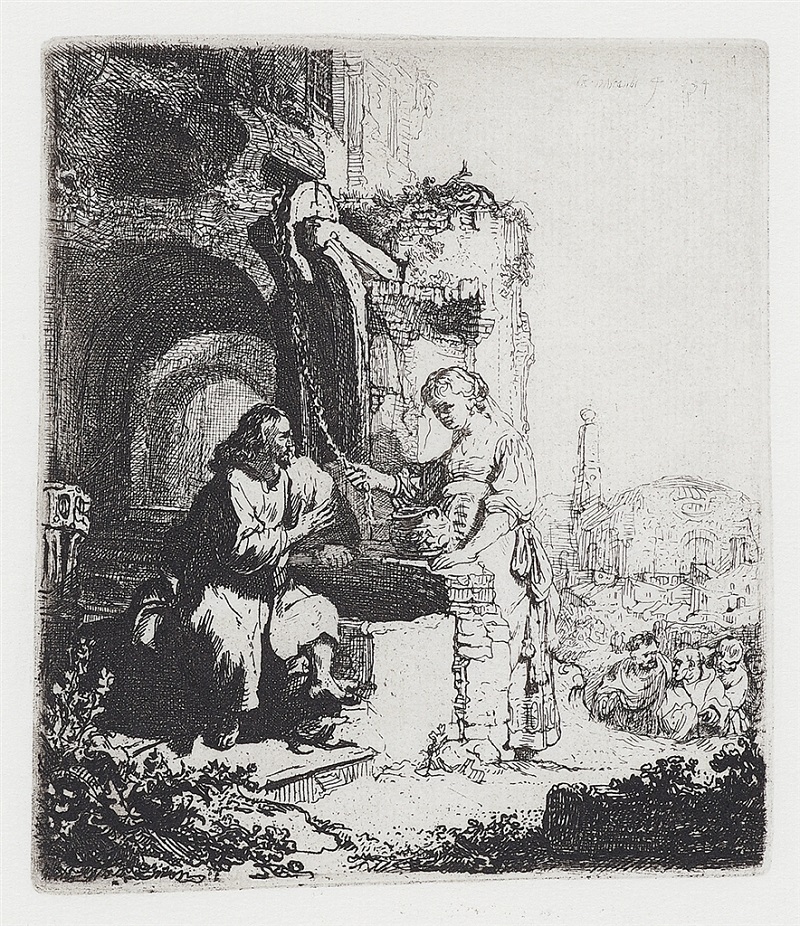
"Christ and the Woman of Samaria: Among Ruins" (1634), Rembrandt van Rijn
Rembrandt's career as an etcher surpasses his work as a painter in regard to creative fluency, emotional range, and emphasis on the contrast between light and dark, or "chiaroscuro." Biblical scenes, self-portraits, and landscapes are the most common subjects in the artist's body of printed work.
Rembrandt's contributions to the medium of etching inspired the printmaking masters of later generations: Francisco Goya, Marc Chagall, James Abbott McNeill Whistler, and Pablo Picasso.
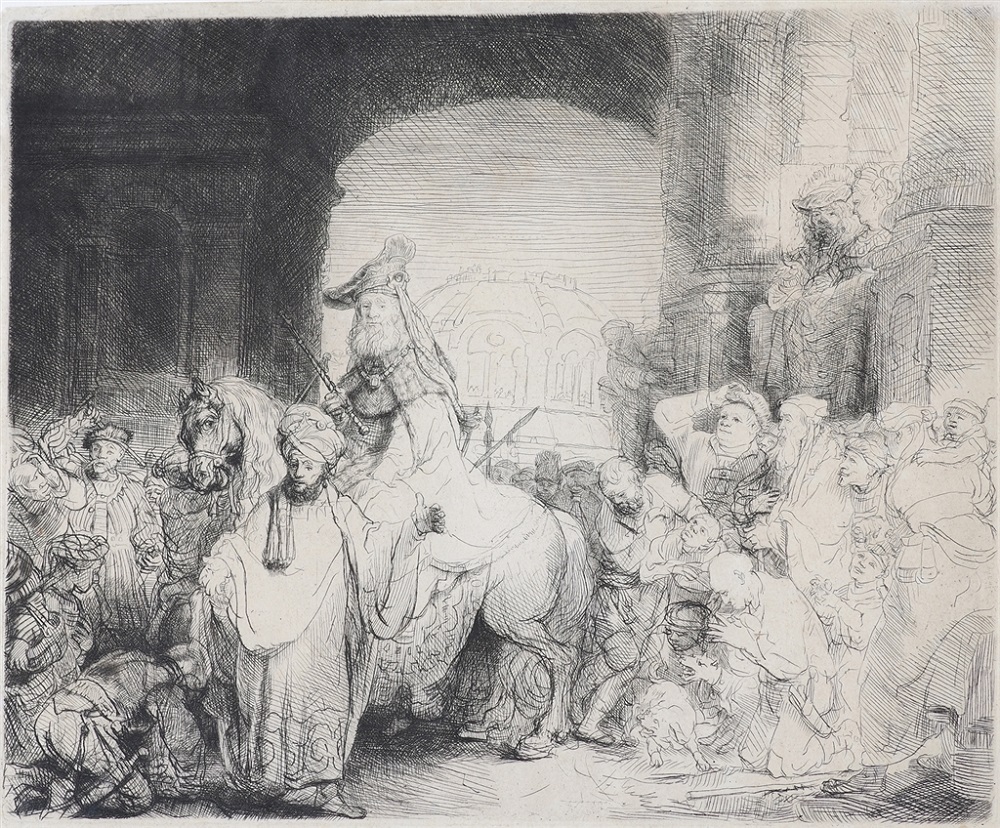
"Triumph of Mordecai" (1641), Rembrandt van Rijn
Span of Work and Museum Exhibitions
In addition to the 300 etchings, engravings, and drypoints Rembrandt created during his lifetime, his oeuvre is said to include around 300 paintings and 2,000 drawings.
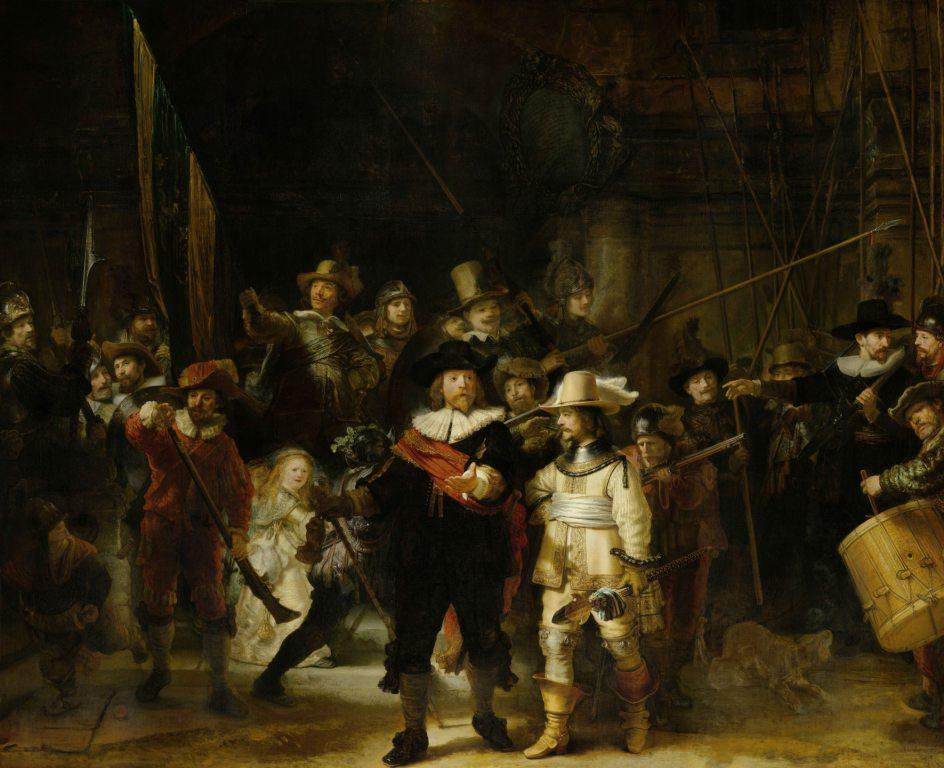
"The Night Watch" (1642), Rembrandt van Rijn. Image Public Domain. Courtesy of Wikimedia Commons.
Today, artworks by Rembrandt are included in many of the world's most prestigious museums, including the Rijksmuseum, the Louvre, the National Gallery, the State Hermitage Museum, the Frick Collection, and the Metropolitan Museum of Art, among countless other historical venues.
Spiraling Tragedy and Death
In 1634, Rembrandt married Saskia van Uylenburgh. While their marriage lasted only eight years, the partnership is woefully regarded as one of the great, tragic romances of art history. Of the couple's four children—Rumbartus, Cornelia, Cornelia, and Titus—only their youngest would live to adulthood.
Shortly after giving birth to Titus, Saskia passed away in 1642 from what was most likely tuberculosis. Testifying his sorrow, Rembrandt drew Saskia before her death. Today, these drawings are regarded by some to be the artist's most poignant and moving works. In the late 1640s, Rembrandt had a relationship with Hendrickje Stoffels, whom he would also outlive.
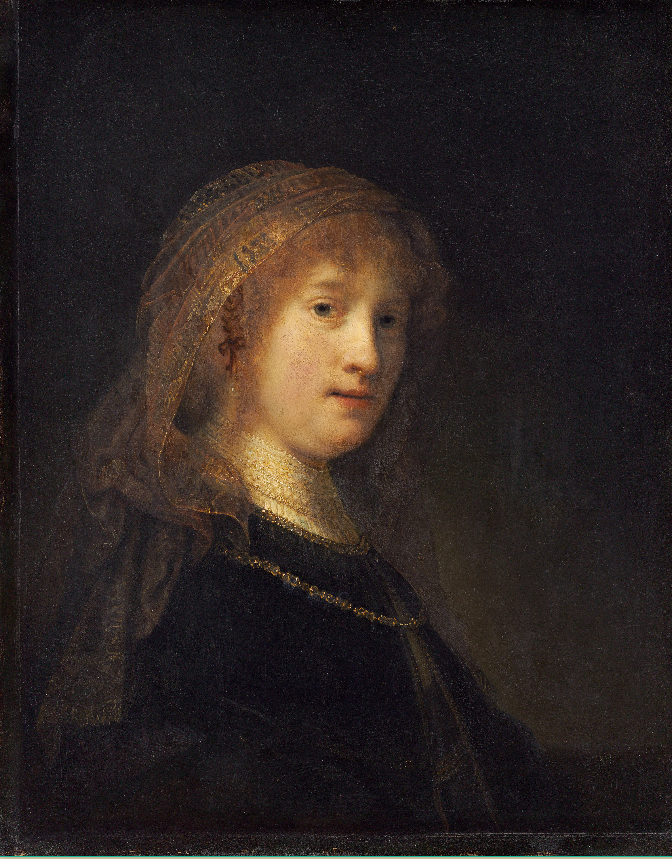
"Saskia van Uylenburgh, the Wife of the Artist" (c. 1635), Rembrandt van Rijn. Image Public Domain. Courtesy of Wikimedia Commons.
Like many artists in the Renaissance and Baroque era, Rembrandt was an avid art collector and connoisseur of historic objects. Rembrandt's ostentatious lifestyle and penchant to amass a great collection of his own, however, forced him to declare bankruptcy in 1656. Though the artist continued to fulfill commissions for Amsterdam's elite, the frequency and reception of his work began to plummet.
In 1661, the Amsterdam City Council commissioned Rembrandt to paint "The Conspiracy of Claudius Civilis." After its completion, the painting was rejected and scorned as a crude debasement of Roman history. The artist was forced to cut away at the masterpiece in the hopes that the central portion could be sold.
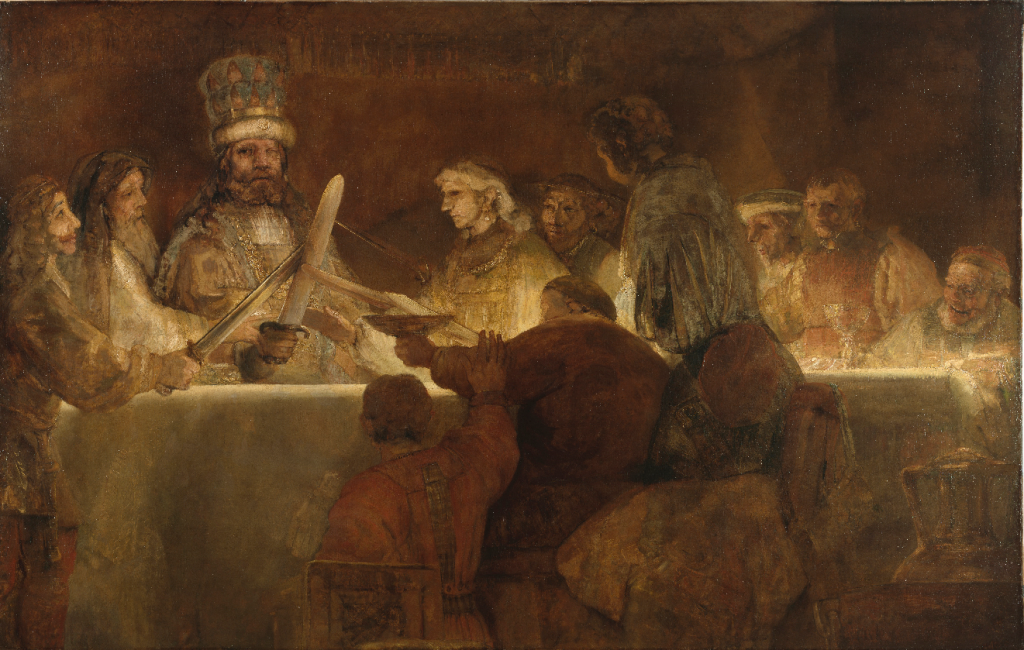
Remaining portion of "The Conspiracy of Claudius Civilis" (1661), Rembrandt van Rijn. Image Public Domain. Courtesy of Wikimedia Commons.
Rembrandt died in 1669. He was buried in an unmarked grave which was later destroyed due to his status as a poor man. However, despite the circumstances at the end of his life, the name "Rembrandt" would eventually be remembered as one of the most influential and renowned artists in all of recorded history.
To add a limited-edition masterpiece by Rembrandt van Rijn to your collection, register for our exciting weekly online auction or contact one of our gallery consultants at (800) 521-9654 ext. 4 during business hours or sales@parkwestgallery.com.
The post Behind the Artist: Rembrandt van Rijn appeared first on Park West Gallery.
]]>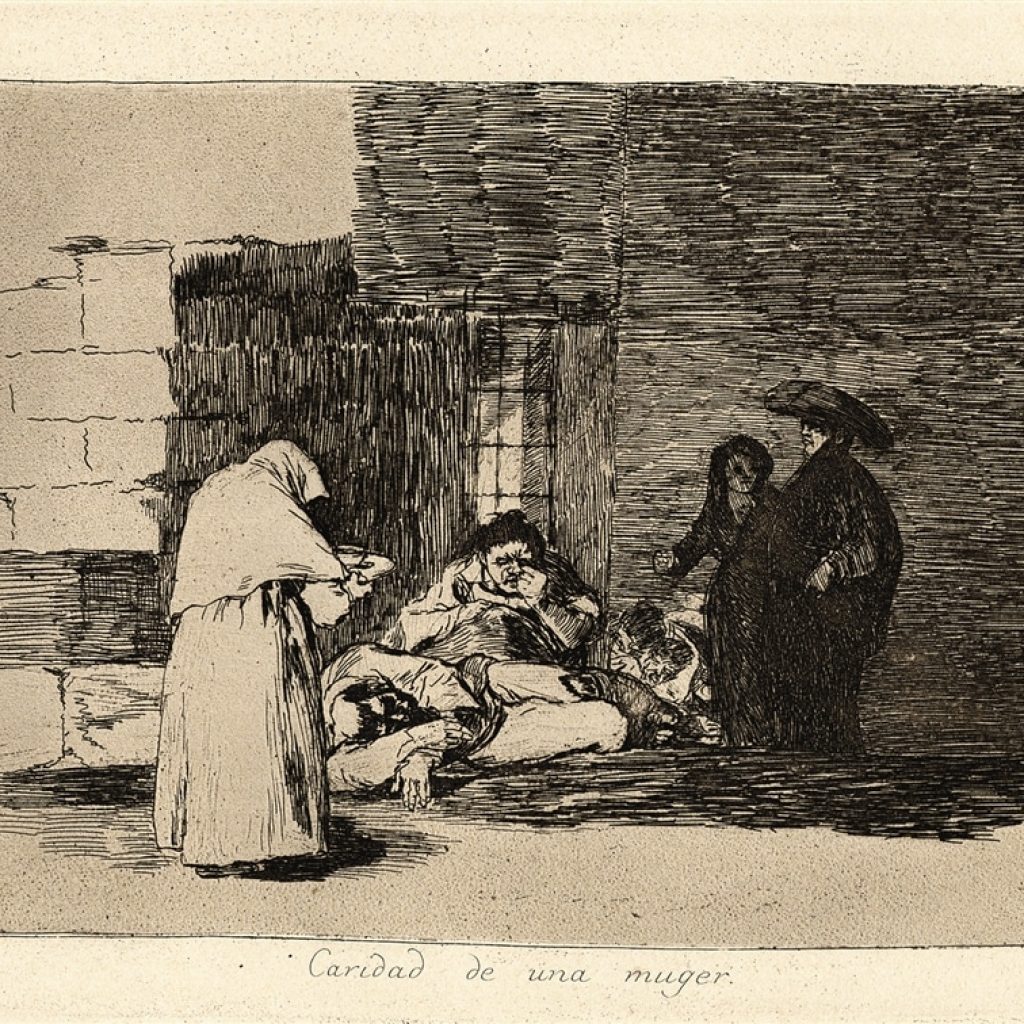
Etchings have been hugely influential in art history, particularly in the development of printmaking. The art of etching is one of the oldest printmaking mediums—originating in the 15th century and evolving out of techniques developed by armorers to decorate their wares. You can see innovative examples of etching in the works of master artists like […]
The post What is an Etching and How Are Etchings Made? appeared first on Park West Gallery.
]]>
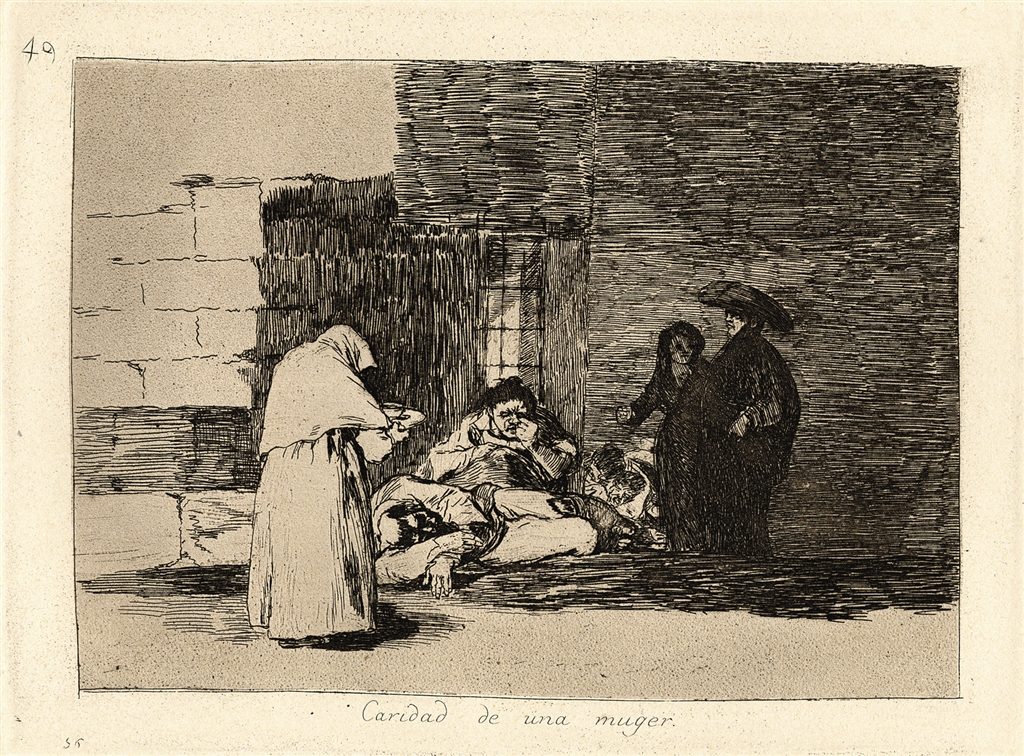
"Caridad de una muger" (A Woman's Charity, 1810-1820), Francisco Goya. Etching, lavis, burin, and burnisher on wove paper.
Etchings have been hugely influential in art history, particularly in the development of printmaking.
The art of etching is one of the oldest printmaking mediums—originating in the 15th century and evolving out of techniques developed by armorers to decorate their wares.
You can see innovative examples of etching in the works of master artists like Rembrandt van Rijn, Albrecht Dürer, and Francisco Goya. However, even if you're familiar with the term "etching," you might not know exactly what the process involves.
With that in mind, we've put together this beginner's introduction to etching, showing how artistic etchings are made. Our etching guide is illustrated by some visual aids we recorded while visiting Amsterdam's remarkable Rembrandt House Museum a few years ago.
Rembrandt completely revolutionized the art form of etching and, at the museum, you can witness etchings being created in the same way that Rembrandt did over 400 years ago.
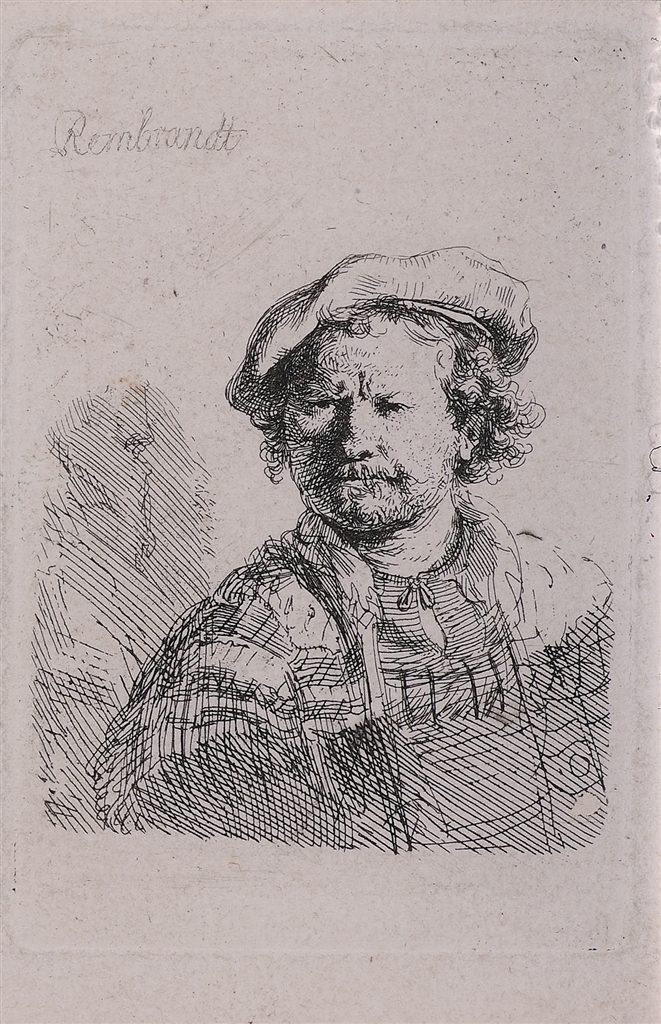
"Self Portrait in a Flat Cap and Embroidered Dress" (c. 1638), Rembrandt van Rijn. Etching on laid paper with small margins.
INTRODUCTION TO ETCHING
During Rembrandt's time, there were three basic techniques that 17th-century artists commonly used to create prints—copper engraving, drypoint, and etching.
Each involved crafting an image on a metal plate, inking the plate, and running the plate and paper through a printing press.
Copper engraving is the oldest technique and was very popular during the Renaissance. As the name suggests, it involves carving an image directly onto a copper plate. It could be quite difficult and involved a certain degree of metal-working skill.
Drypoint is similar—the artist used a needle called a burin to scratch lines onto a metal plate. The lines were superficial, but you could get a burr—that is, a rough edge—on the lines, which would hold ink. (The burr would quickly wear away.)
Etching, on the other hand, introduced a new innovation that made the medium more appealing to artists, particularly those without a metal-working background.
HOW ETCHINGS ARE MADE
Here are the essentials of the etching process:
1). Like with engraving and drypoint, etching begins with a metal plate, most commonly copper.
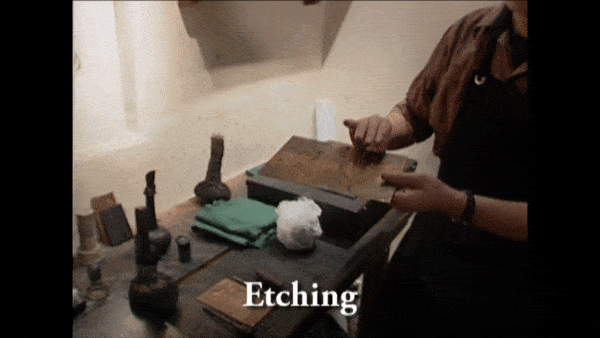
2). Acid-resistant wax, called the ground, is applied to the entire surface of the plate.
3). The artist scratches an image into the ground using a burin (needle), exposing the metal underneath.
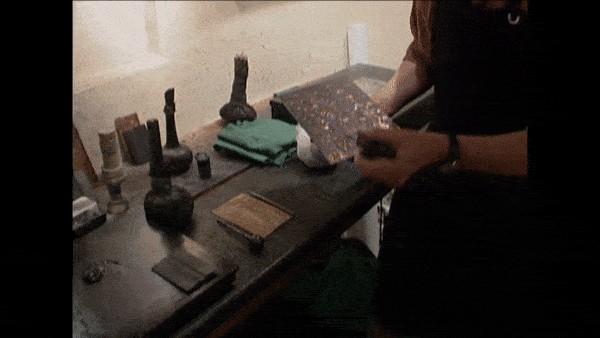
4). Once the image is complete, the plate is submerged in an acid
5). The acid bites away at the exposed metal, creating recessed lines on the plate.
6). The plate is removed and cleaned.
7.) The plate is inked. Ink fills the lines on the plate created by the acid.
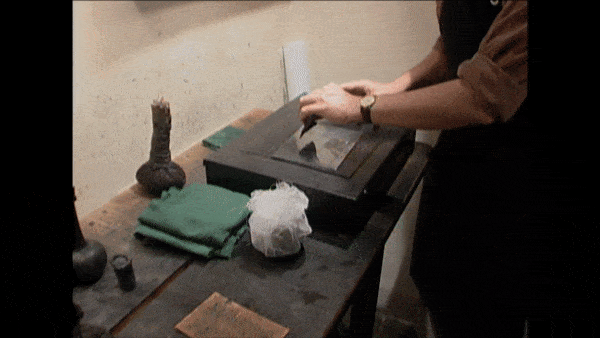
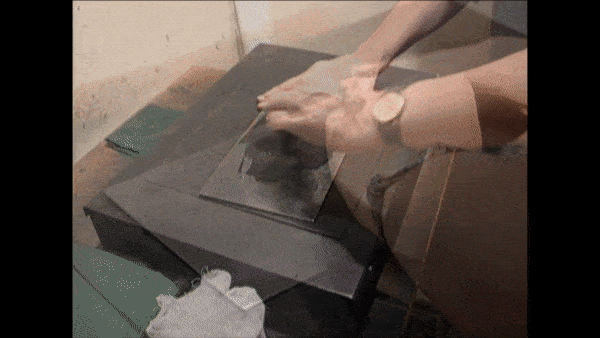
8). The excess ink is removed so ink only remains in the recessed lines.
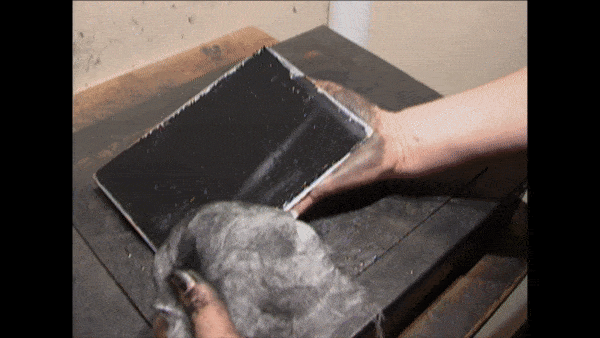
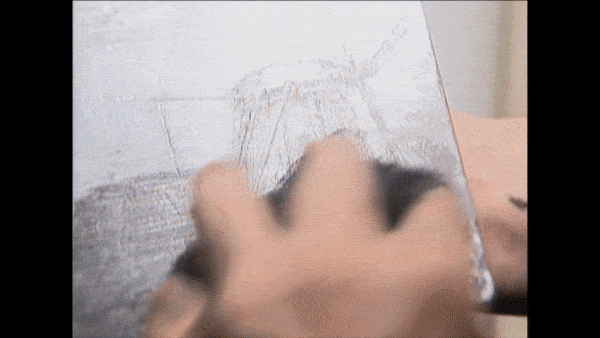
9). Dampened paper is placed over the plate and put through a printing press.
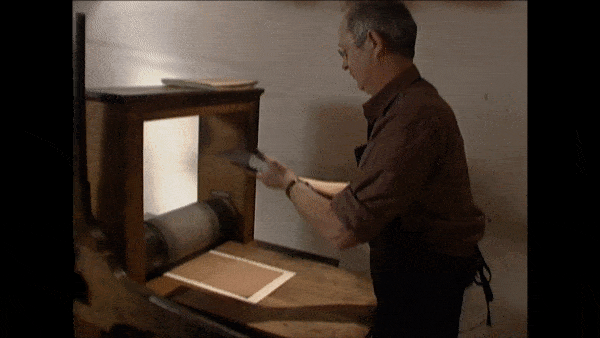
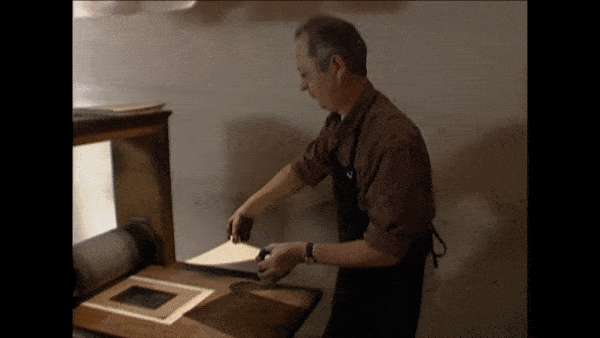
10). The press squeezes the paper and the plate together, impressing an inked image onto the paper.
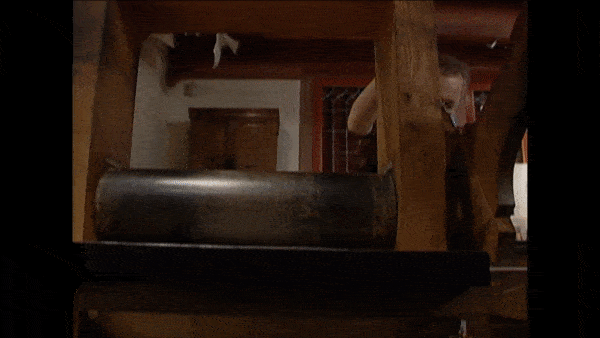
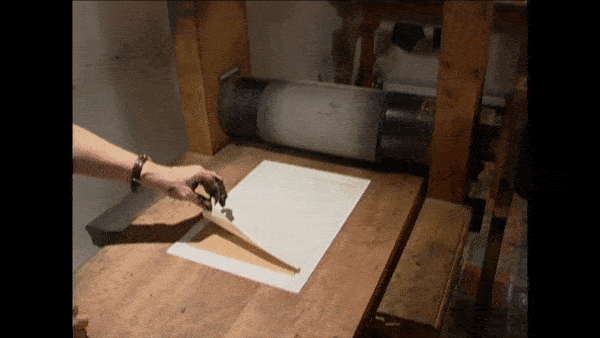
11). Additional impressions can be created by re-inking, cleaning, and putting the plate through the printing press again.
It was a complex and involved process, but it did allow artists to craft and mass-produce prints of staggering clarity and quality.
Take one look at the etchings from Dürer's "Little Passion," Rembrandt's "Millennium Collection," or Goya's "Los Caprichos," and you will marvel at the level of visual and psychological depth that this centuries-old art form could produce.
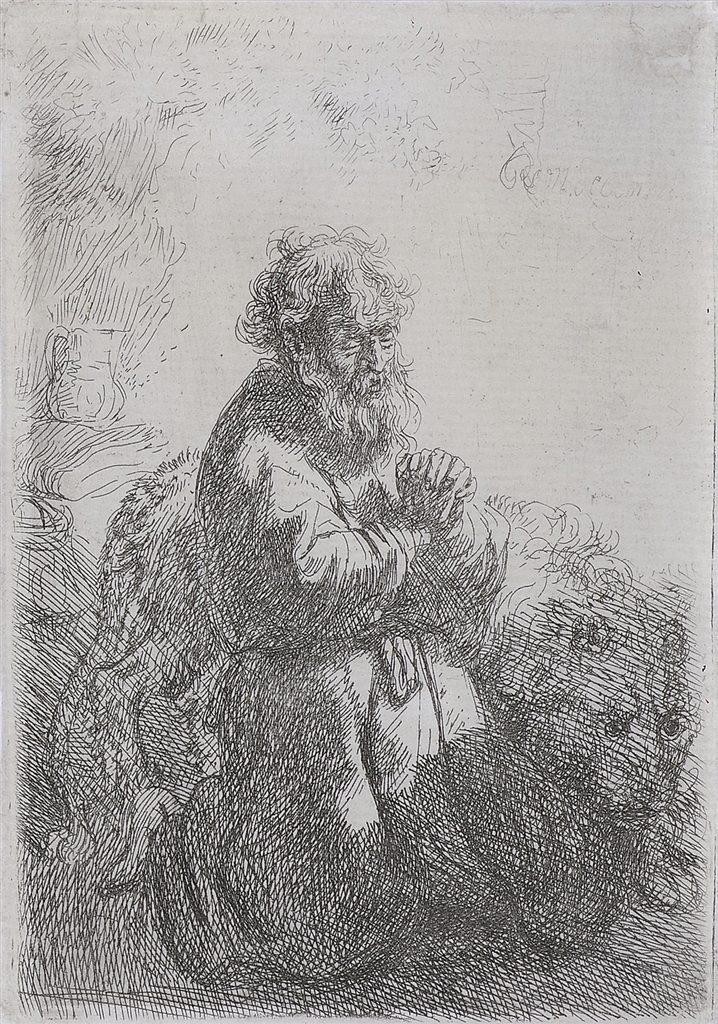
"St. Jerome Kneeling in Prayer, Looking Down" (1635), Rembrandt van Rijn. Etching on thin laid paper with narrow margins.
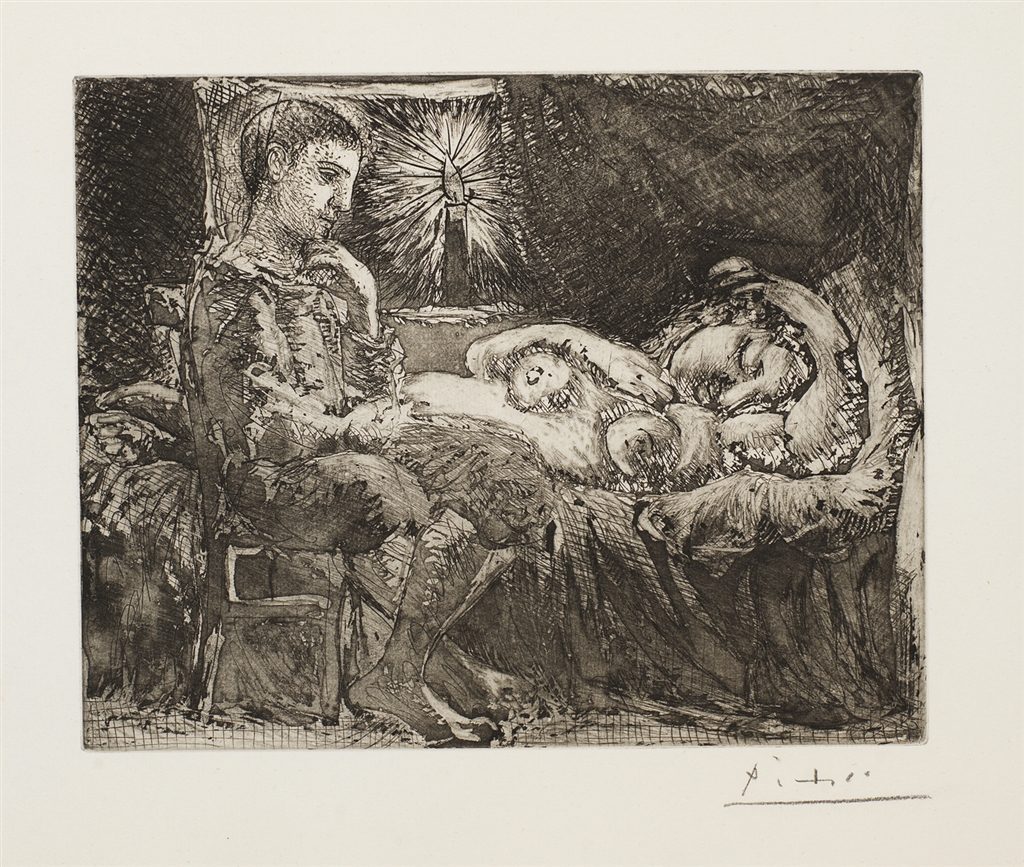
"Garcon et Dormeuse a la Chandelle" (1934), Pablo Picasso. From The Suite Vollard, Etching on Montval laid paper.
If you want to learn more or if you're interested in adding a master etching to your art collection, contact our gallery consultants at (800) 521-9654 ext. 4 or at sales@parkwestgallery.com. You can also register for our weekly live online art auction!
RELATED ARTICLES:
- How Rembrandt van Rijn Changed the Art of Etching Forever
- How 8 of Rembrandt's Original Etching Plates Changed Hands for Over 300 Years
The post What is an Etching and How Are Etchings Made? appeared first on Park West Gallery.
]]>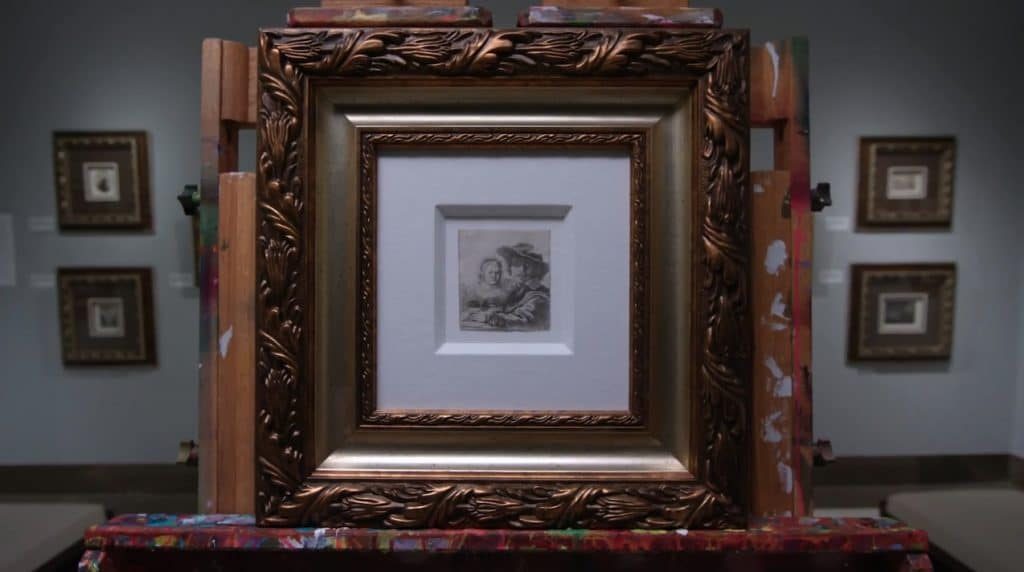
How does an artist become a Master? In this new video, Park West profiles seven undeniable masters of art history—Albrecht Dürer, Rembrandt van Rijn, Francisco Goya, Pablo Picasso, Pierre-Auguste Renoir, Marc Chagall, and Joan Miró.
The post What Makes a Master Artist? Meet 7 Legendary Masters in Our New Video appeared first on Park West Gallery.
]]>
What is great art?
While it's difficult to weigh the impact of Ancient Greek pottery to Impressionist paintings, art history is defined by certain watershed moments. These huge leaps forward stretch the creative and intellectual capabilities of humankind and produce artistic works that effortlessly withstand the test of time.
Their creators? Today, they're known as the Masters.
In this fascinating video, Park West Gallery Director Morris Shapiro invites you to meet seven of the most influential art world masters of all time—Albrecht Dürer, Rembrandt van Rijn, Francisco Goya, Pablo Picasso, Pierre-Auguste Renoir, Marc Chagall, and Joan Miró.
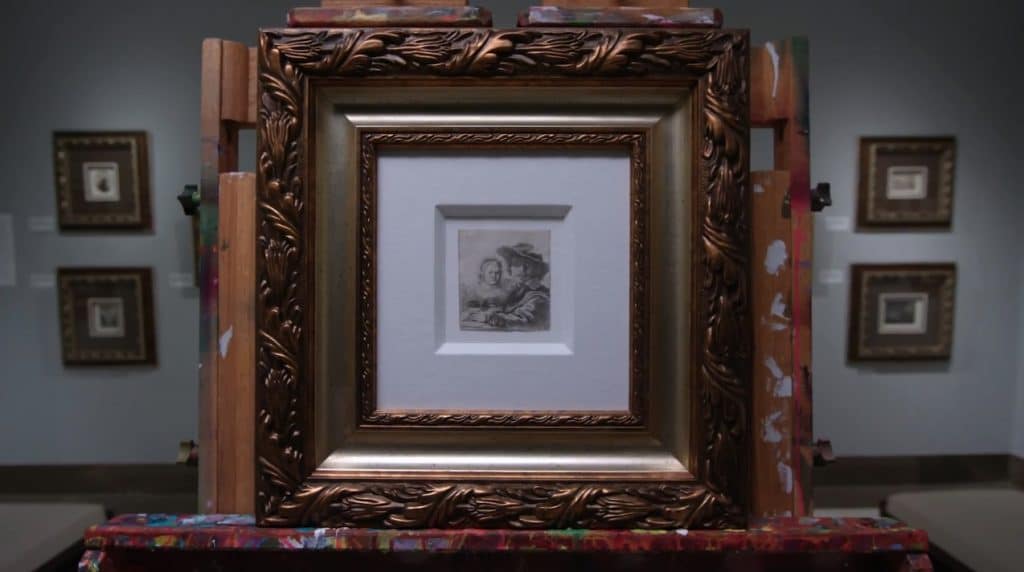
Etching by Rembrandt van Rijn
But how did these seven men change art forever? Shapiro says, "It's not something you can describe with words, but you feel it in your soul and you know what it is when you see it. It's the mark of the master."
Each of these artistic geniuses had a monumental impact on the evolution of art and aesthetics, inspiring generations of artists who followed in their footsteps.
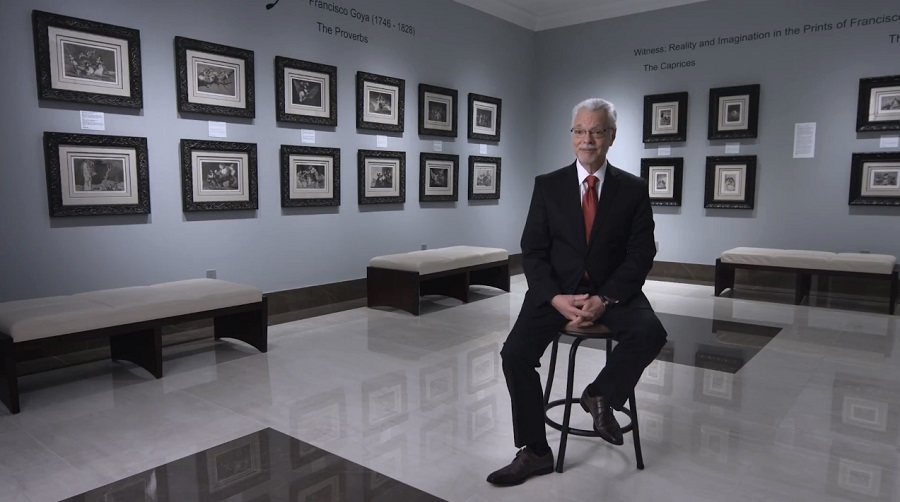
Park West Gallery Director Morris Shapiro discussing seven true masters of art.
You can learn more about the lives and legacies of these artists in the above video, which explains why each one undeniably deserves the title of "Master."
• • • •
All seven of these master artists have works on display at Park West Museum in Southfield, Michigan, just outside of Detroit. The museum is open and free to the public. (You can find more information about visiting here.)
Here's just a small selection of works by these legendary artists that are currently being showcased at Park West Museum.
Albrecht Dürer
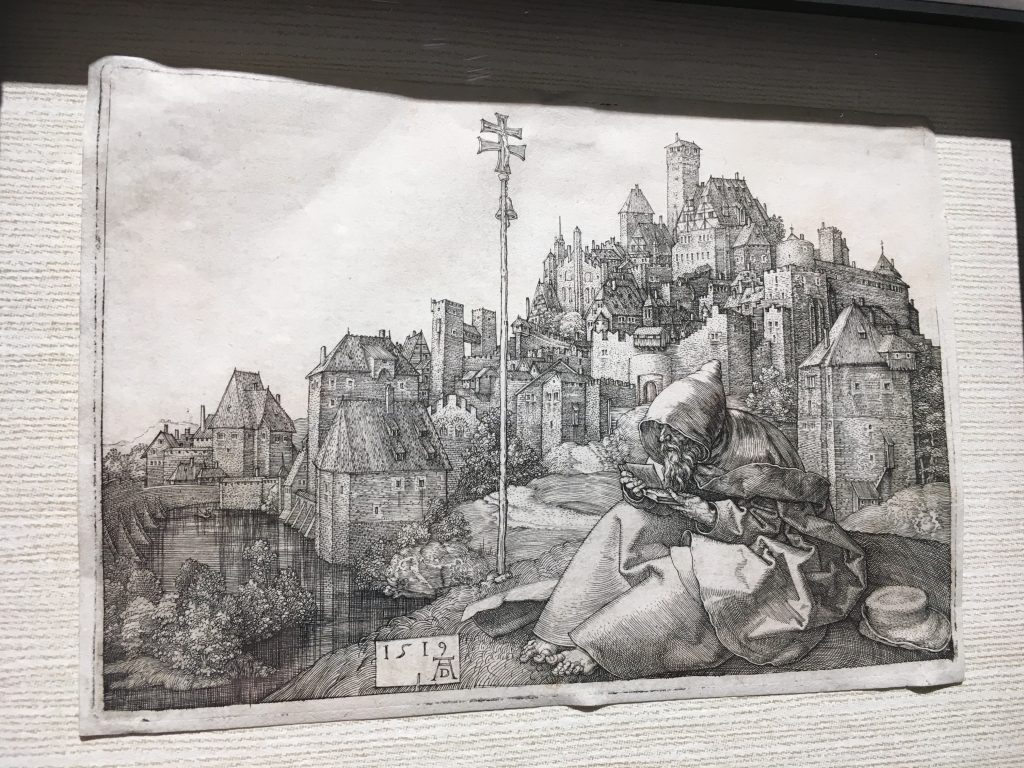
"St. Anthony Reading" (1519), Albrecht Dürer, engraving.
Rembrandt van Rijn
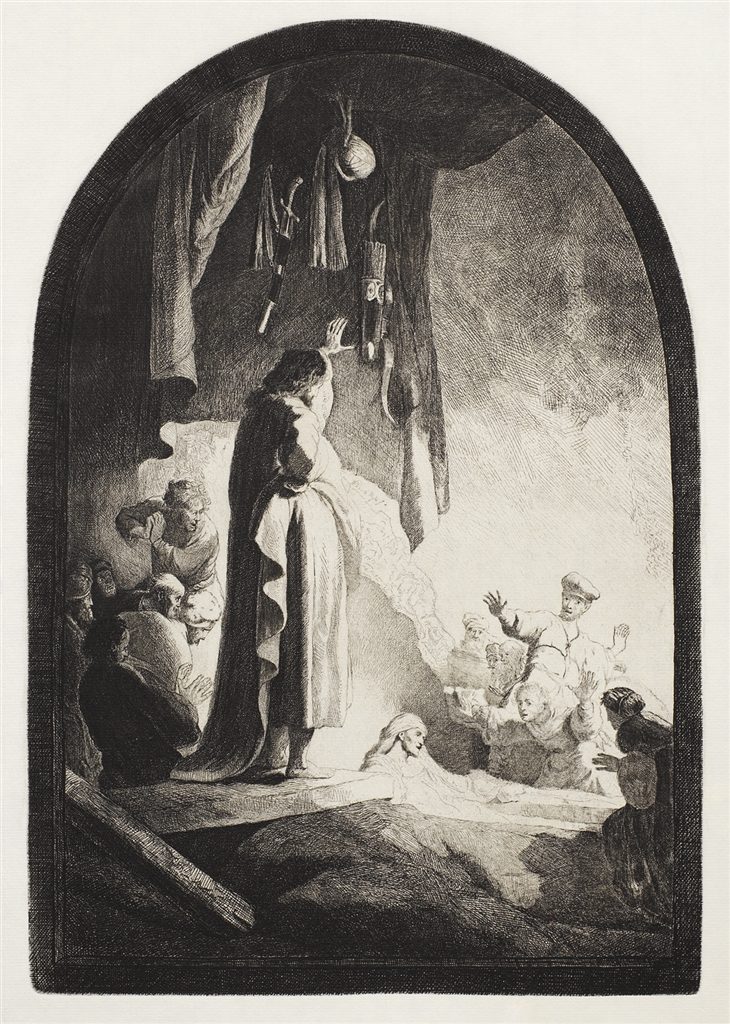
"The Raising of Lazarus: The Larger Plate" (c. 1630), Rembrandt Van Rijn, etching.
Francisco Goya
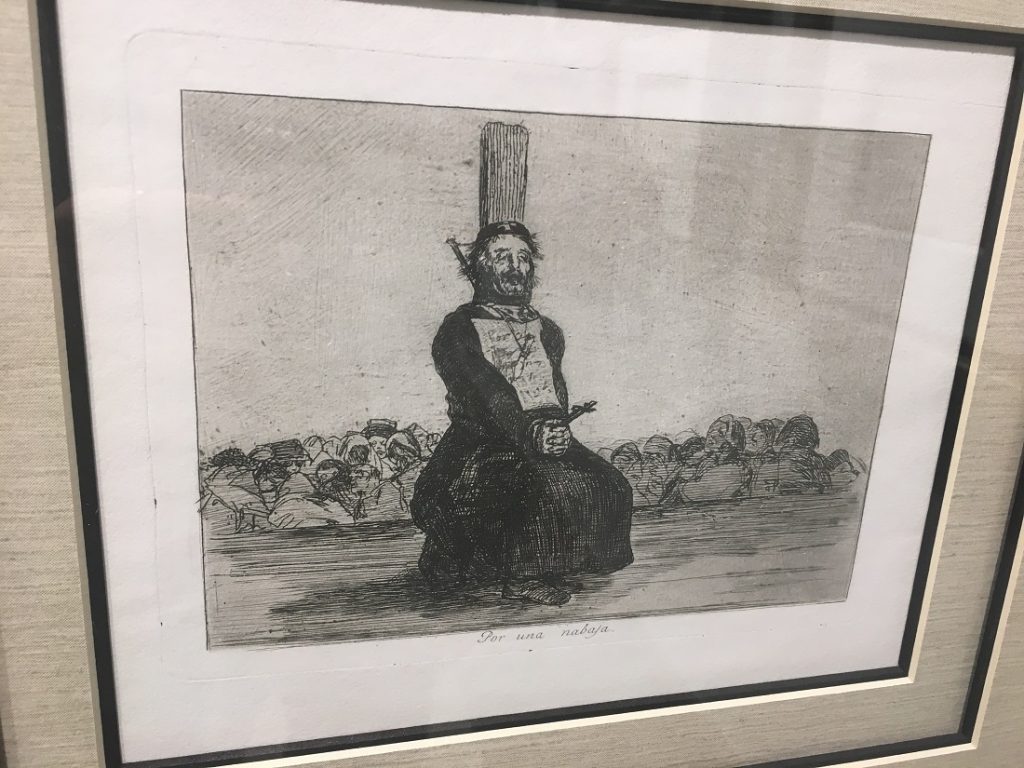
"Por Una Navaja" (On Account of a Knife, c. 1810-1820), Francisco Goya, etching.
Pablo Picasso
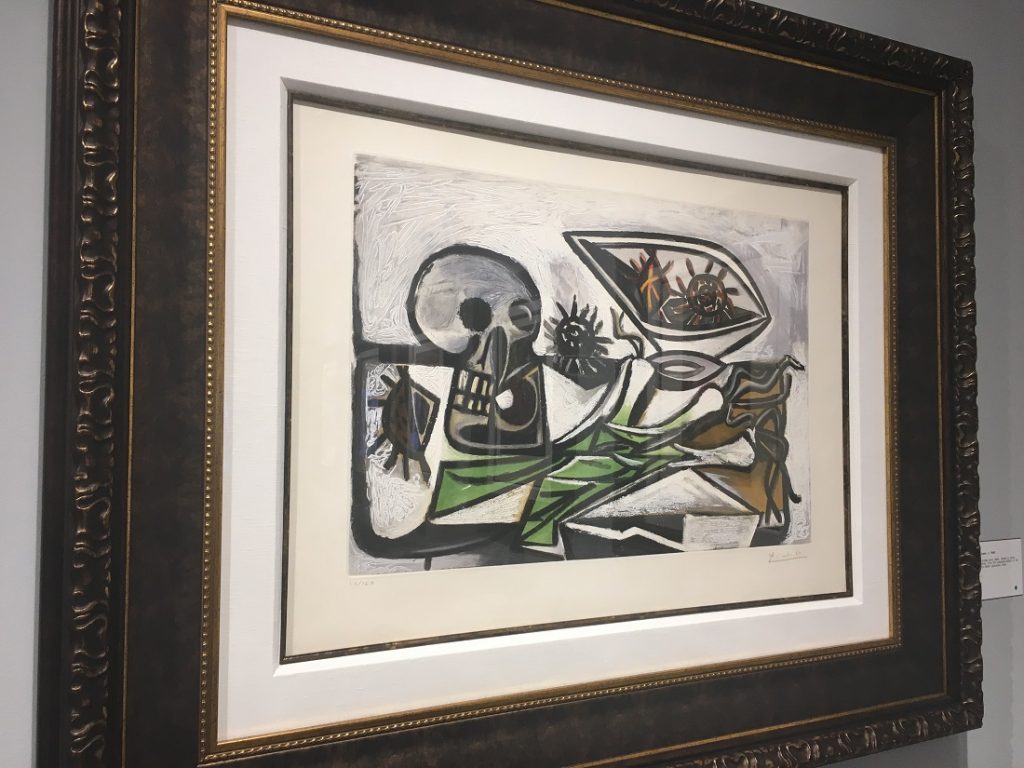
"Nature Morte au Crane" (c. 1960), Pablo Picasso, aquatint.
Pierre-Auguste Renoir
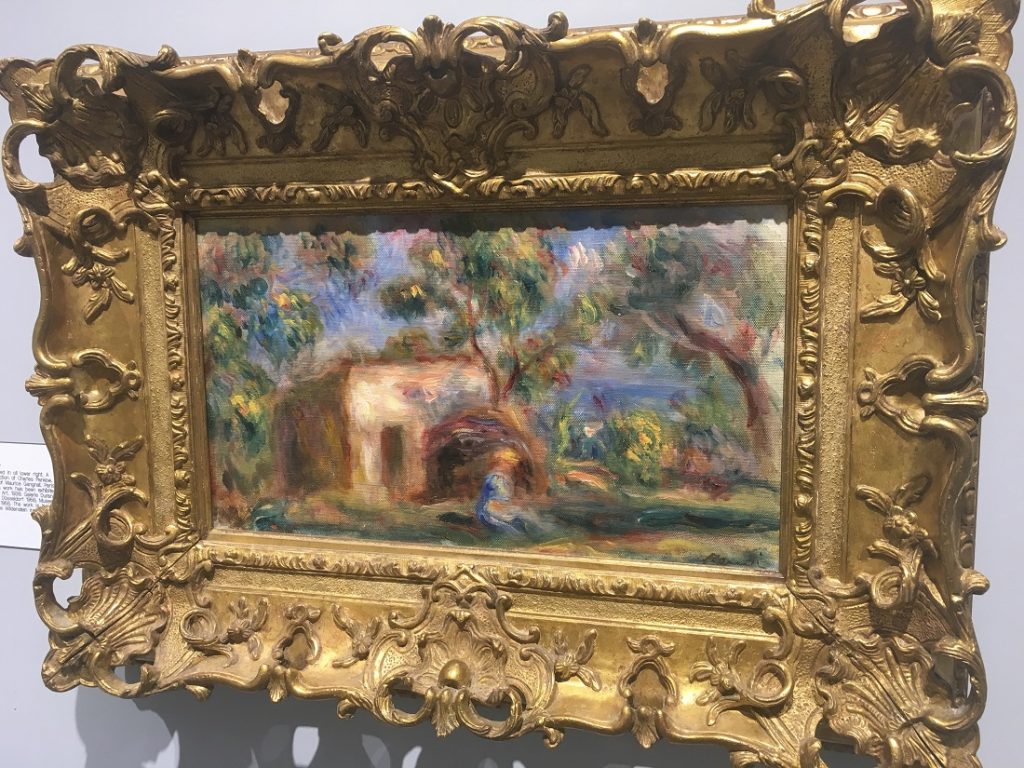
"La Cabane a Cagnes" (1917), Pierre-Auguste Renoir, oil painting on canvas.
Marc Chagall
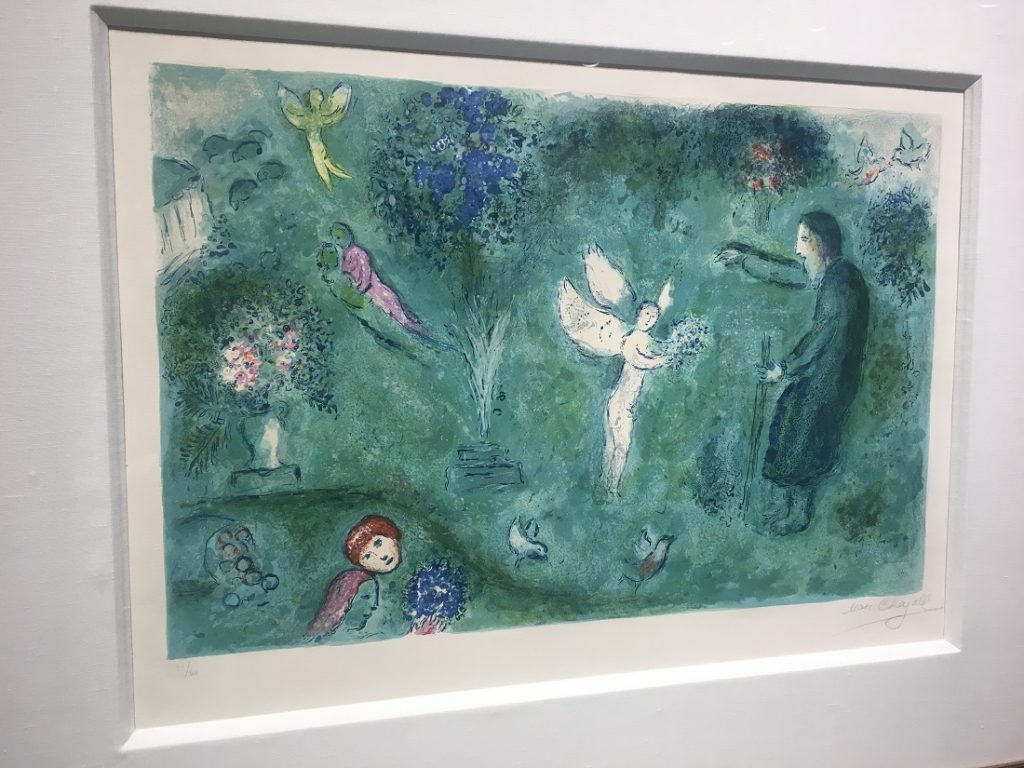
"Philetas' Orchard" (1961), Marc Chagall, lithograph.
Joan Miró
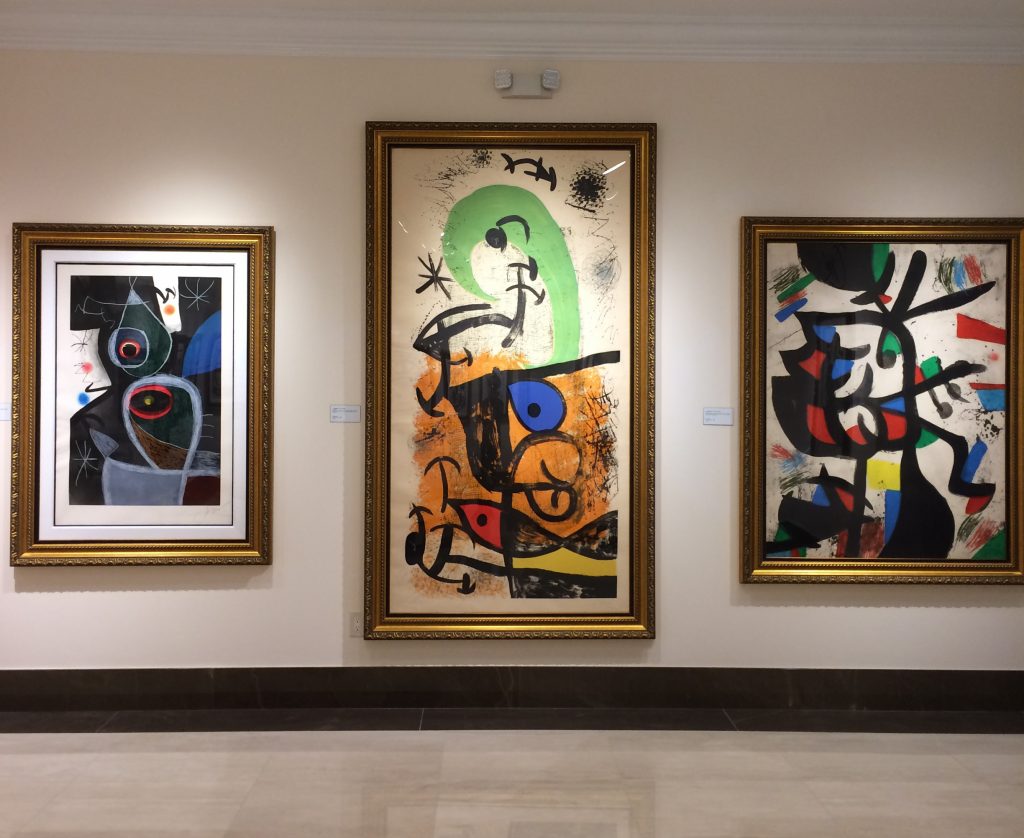
Three works by Joan Miró—"Le Somnambule" (1974), etching; "La Meneuse de Lune" (1975), lithograph; and "La Marchande de Couleurs" (1981), etching.
If you're interested in collecting the works of any of these master artists, Park West can help. Just contact our gallery consultants at (800) 521-9654 ext. 4 or at sales@parkwestgallery.com.
LEARN MORE ABOUT ART HISTORY'S MASTERS:
- How Rembrandt van Rijn Changed the Art of Etching Forever
- Behind the Artist: Francisco Goya
- The Barcelona Suite: Picasso at the Turn of the Century
- 100 Years Ago, Joan Miró Held His First Art Show—and It Was a Disaster
- Behind the Artist: Albrecht Dürer
- How Marc Chagall Came to Illustrate One of the Greatest Love Stories of All Time
- Behind the Artist: Pierre-Auguste Renoir
The post What Makes a Master Artist? Meet 7 Legendary Masters in Our New Video appeared first on Park West Gallery.
]]>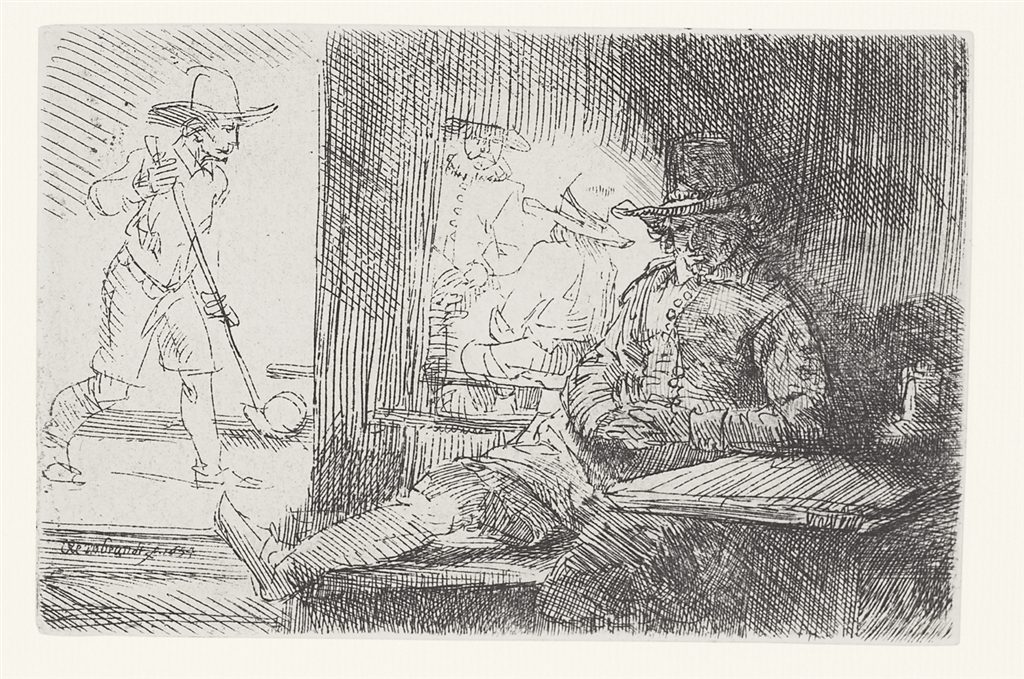
In the popular musical "Hamilton," George Washington reminds the audience that no one has any control over "who lives / who dies / who tells your story." That can be especially true for artists who, at the end of their lives, leave behind all of their artwork and often thousands of sketches, rough drafts, and […]
The post How 8 of Rembrandt's Original Etching Plates Changed Hands for Over 300 Years appeared first on Park West Gallery.
]]>
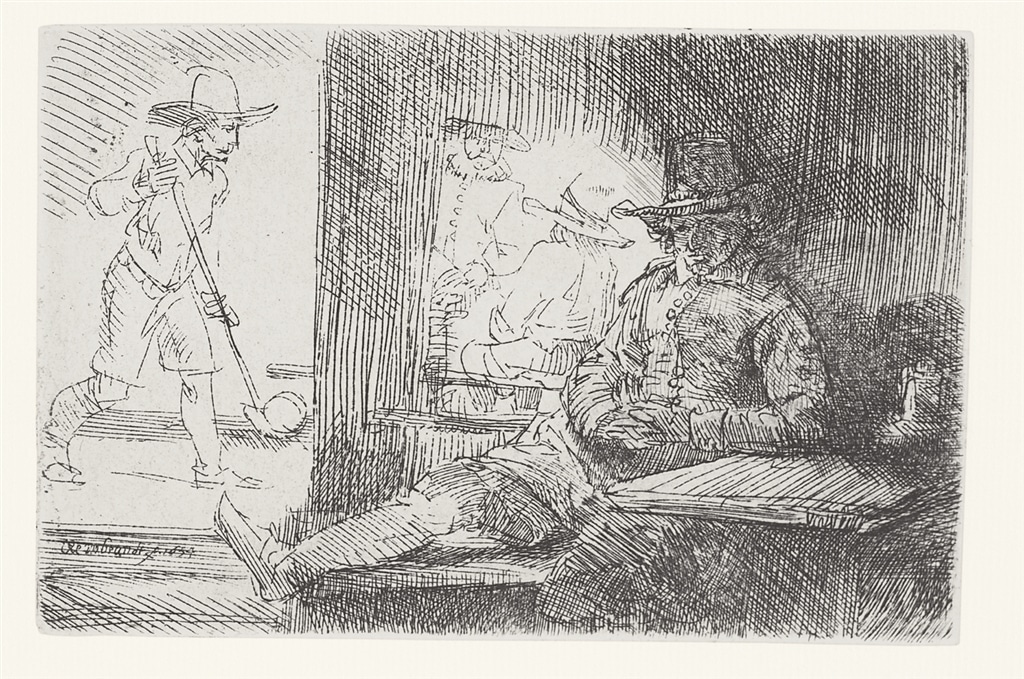
"The Golf Player" (1654), Rembrandt Van Rijn. A 20th/21st Century impression from the "Millennium Collection," printed by master printer Marjorie Van Dyke.
In the popular musical "Hamilton," George Washington reminds the audience that no one has any control over "who lives / who dies / who tells your story." That can be especially true for artists who, at the end of their lives, leave behind all of their artwork and often thousands of sketches, rough drafts, and works in progress.
For some artists—particularly classical artists who lived before the era of estate planning and copyright law—their artistic legacy can often depend on whoever ends up with their works after they die.
That was definitely the case for Rembrandt van Rijn. The creation of his "Millennium Collection" is a fascinating case study of how collectors can help posthumously shape an artist's body of work.
While Rembrandt's paintings like "The Night Watch" are internationally famous, the artist is perhaps best remembered in the art world for his unrivaled contributions to the art of etching. He not only innovated how etchings were made, but he also experimented with altering the states of his etchings, allowing for a greater variety of imagery than had ever been previously thought possible.

"The Raising of Lazarus: The Larger Plate" (c. 1630), Rembrandt Van Rijn. A 20th/21st Century impression from the "Millennium Collection," printed by master printer Marjorie Van Dyke.
During his lifetime, Rembrandt created more than 300 etchings, engravings, and drypoints. However, after he died in 1669, there are few records of what happened to his remaining original etching plates that had not been previously canceled or destroyed.
Most records suggest that only 82 of his 300-plus copper plates survived past his death. In 1677, there's documentation showing that 74 of those remaining plates were housed in the estate of Clement de Jonghe, one of Rembrandt's former art dealer friends.
Sometime between 1677 and 1766, Pieter de Haan acquired that collection. In 1767, de Haan's estate placed 76 Rembrandt plates up for auction—the additional two plates came from other sources. Sale records show that these plates continued to pass between different collectors throughout the years and, at various intervals, were published as posthumous impressions of Rembrandt's artwork.

"The Artist's Mother with her Hand on her Chest" (1631), Rembrandt Van Rijn. A 20th/21st Century impression from the "Millennium Collection," printed by master printer Marjorie Van Dyke.
In 1993, the estate of Dr. Robert Lee Humber decided to sell the 78 original Rembrandt copper plates the doctor had previously acquired from Alvin Beaumont. Within two months, almost all of the plates were sold to a large number of private collectors, dealers, and museums, including six Dutch museums and the Bibliothèque Nationale in Paris.
Eight of the plates from Humber's collection were sold to Robert Light, a noted Rembrandt expert and art dealer in New York. He sold the plates just one year later to Howard Berger.
The eight plates Berger acquired are titled: "The Golf-Player"; "Bust of a Man Wearing a High Cap (Three-Quarters)"; "Christ and the Woman of Samaria: Among Ruins"; "The Artist's Mother with Her Hand on Her Chest"; "The Card Player"; "Landscape with a Cow Drinking"; "The Raising of Lazarus: The Larger Plate"; and "Self Portrait Drawing at a Window."
Following in the tradition of former collectors of Rembrandt's plates, Berger decided to pull impressions of a limited edition of the eight images—a suite he referred to as the "Millennium Collection."

"Christ and the Woman of Samaria: Among Ruins" (1634), Rembrandt Van Rijn. A 20th/21st Century impression from the "Millennium Collection," printed by master printer Marjorie Van Dyke.
In 1994, master printer Emiliano Sorini was hired to lead the project and, with his protégé Marjorie Van Dyke, they researched suitable papers, inks, and printing methods. The Millennium Impressions would be a limited edition, with only 2,500 impressions of each image pulled over a 10-year period. The end result was a collection of beautifully printed etchings that all highlight the artist's amazing vision and skill.
The eight "Millennium" copper plates are now on display, along with a set of the etchings, at the North Carolina Museum of Art in Raleigh, from where Dr. Humber had originally lent them.
While Rembrandt may not have been able to control the ultimate fate of his plates—or who "told his story"—it is fortunate that works so important to his artistic legacy have consistently ended up in the hands of collectors who truly value the innovation and intricacy of his etchings.
The Park West Museum in Southfield, Michigan has over 20 examples of Rembrandt's remarkable etchings on display—including examples of all eight Millennium Impressions. For more information on visiting the museum, click here.

The Rembrandt etching gallery at Park West Museum

The Rembrandt etching gallery at Park West Museum
If you're interested in collecting the works of Rembrandt van Rijn or another master artist, please contact one of our gallery consultants at (800) 521-9654 ext. 4 during business hours or email sales@parkwestgallery.com for inquiries after hours.
The post How 8 of Rembrandt's Original Etching Plates Changed Hands for Over 300 Years appeared first on Park West Gallery.
]]>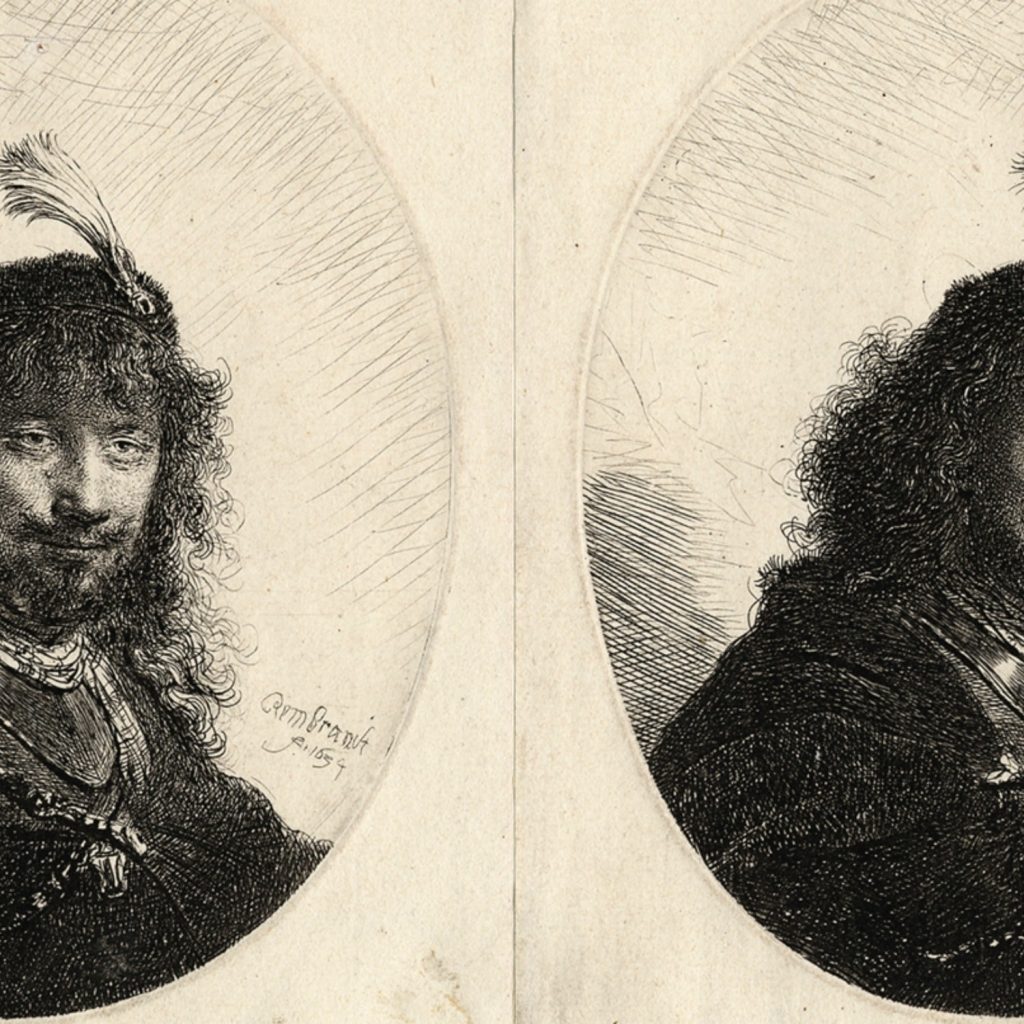
Rembrandt van Rijn's name is synonymous with fine art and a mastery of technique, but few realize that his impact on the art world has more to do with printmaking than his skills with a brush. Sure, his world-famous paintings like "The Night Watch" and "The Return of the Prodigal Son" will forever be studied and admired, […]
The post How Rembrandt van Rijn Changed the Art of Etching Forever appeared first on Park West Gallery.
]]>
Rembrandt van Rijn's name is synonymous with fine art and a mastery of technique, but few realize that his impact on the art world has more to do with printmaking than his skills with a brush.
Sure, his world-famous paintings like "The Night Watch" and "The Return of the Prodigal Son" will forever be studied and admired, but it was Rembrandt's remarkable innovations in the field of printmaking—specifically, etching—that helped immortalize him.
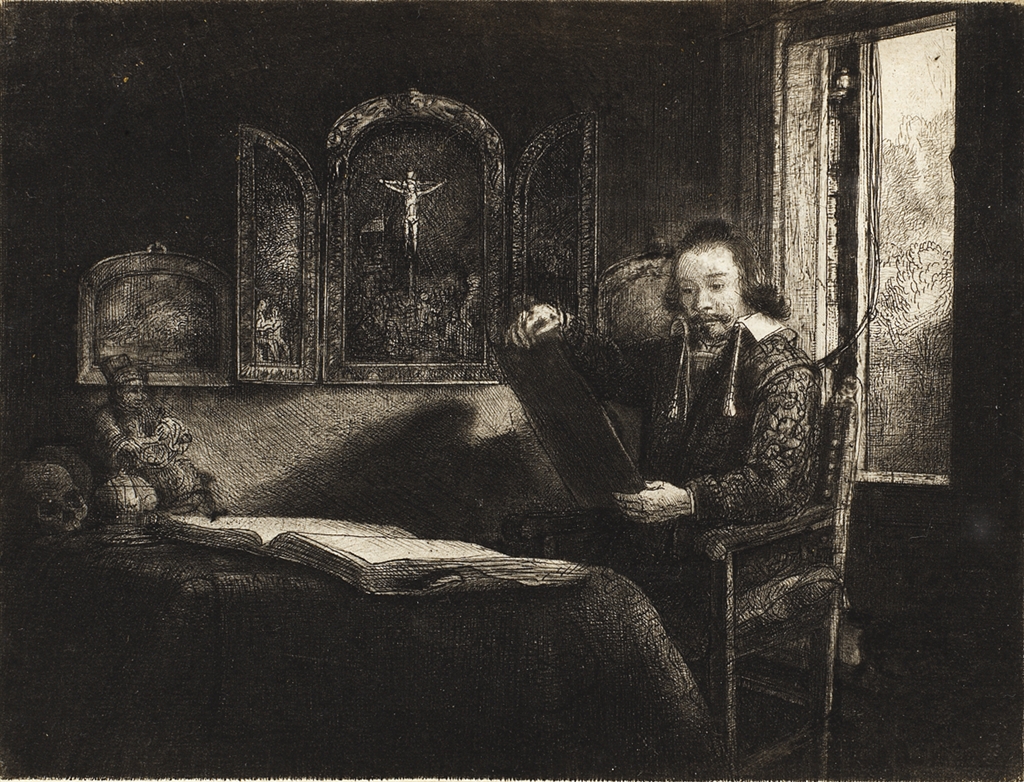
Etching, "Abraham Francen, Apothecary" (c. 1656), Rembrandt Van Rijn
THE ORIGINS OF ETCHINGS
Etching was first popularized in the 15th century, with artists such as Albrecht Dürer employing the method. The process has its origins in the armorer's trade, where it was used to add elaborate patterns to swords and armor, but it was later adopted to mass-produce images on paper.
To produce an etching, a piece of metal known as a "plate"—initially iron, but later copper and zinc—is coated with a varnish called a "ground." An image is then drawn into the varnish using a sharp tool and treated with an acid that eats away at the exposed metal, creating fissures. The depth and subsequent darkness of the fissures depend on the length of time the metal is exposed to the acid.
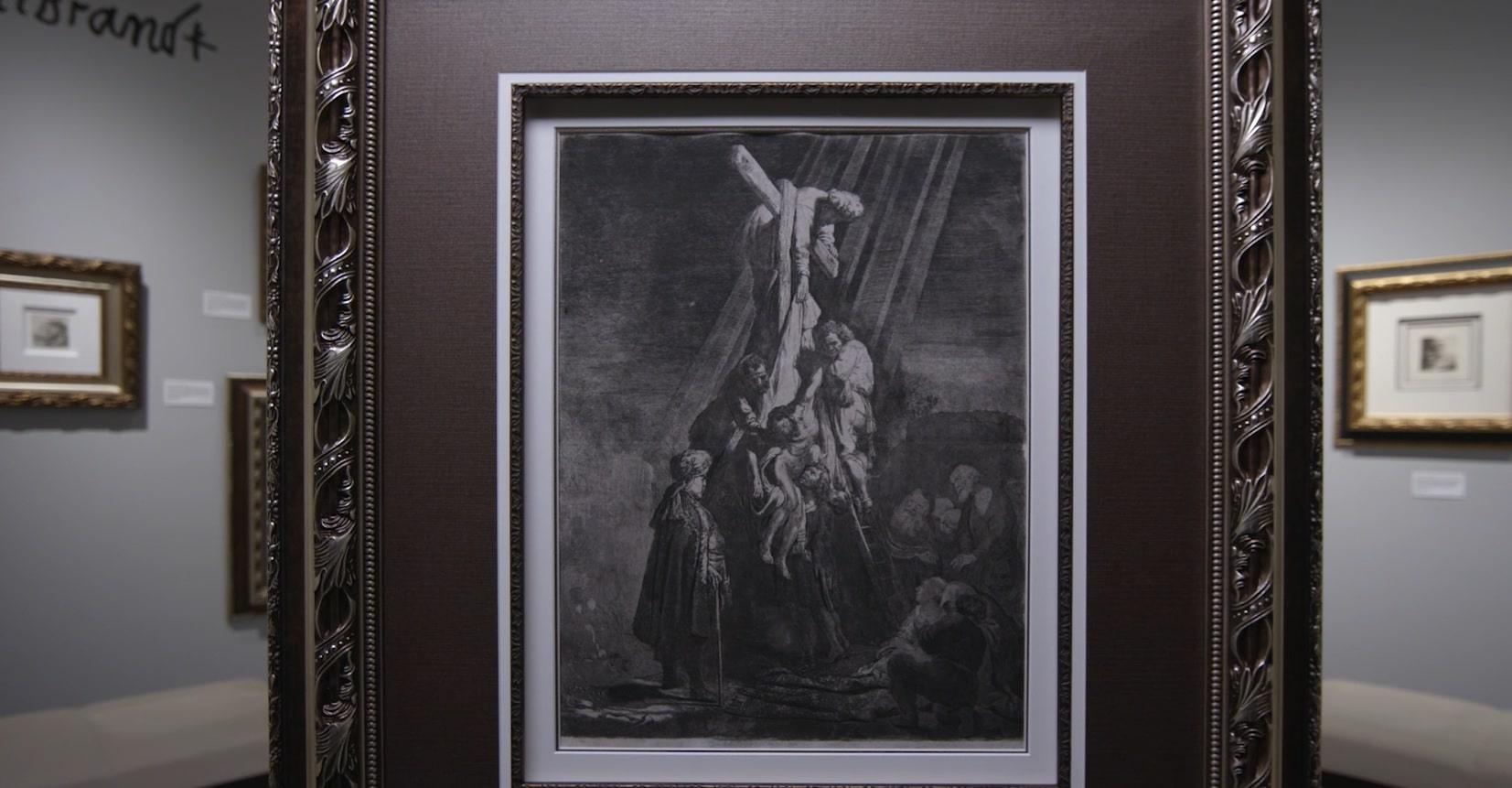
Etching, "The Descent From the Cross" (1633), Rembrandt Van Rijn
Ink applied to the cleaned plate settles into the etched lines and is then transferred to paper during the printing process, allowing multiple images to be created from a single plate.
Since most of the etching process is comparable to drawing on a sheet of paper, and the acid baths and printing could be handled by professionals, many artists found etching to be an easy and accessible printmaking process.
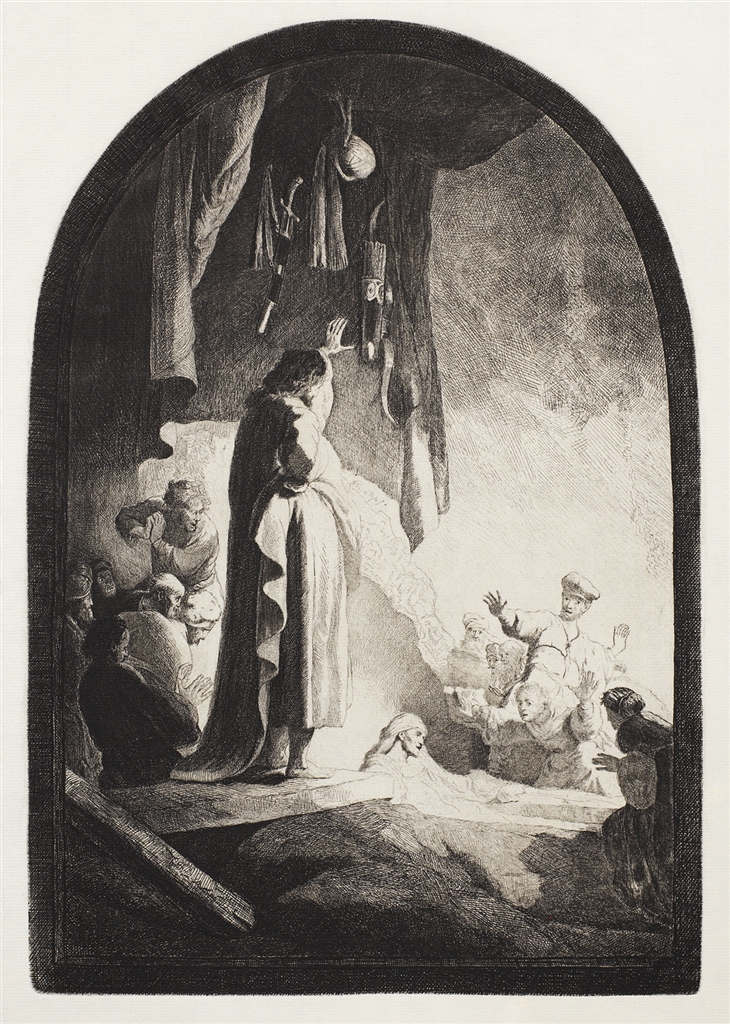
Etching, "The Raising of Lazarus: The Larger Plate" (c. 1630), Rembrandt Van Rijn
However, it did have its limits. If the acid bath was too weak, the lines would not show clearly, and stronger acids could cause lines to become irregular and print less finely.
REMBRANDT'S ETCHING INNOVATIONS
By the 17th century, more artists were working with etchings and many were attempting to refine the method, including Rembrandt.
However, what is extraordinary about Rembrandt's printmaking is how he experimented with ink and paper to produce noticeable differences from one plate-pressing to another—a revolutionary technique that ultimately made a lasting impact on the art of etching.
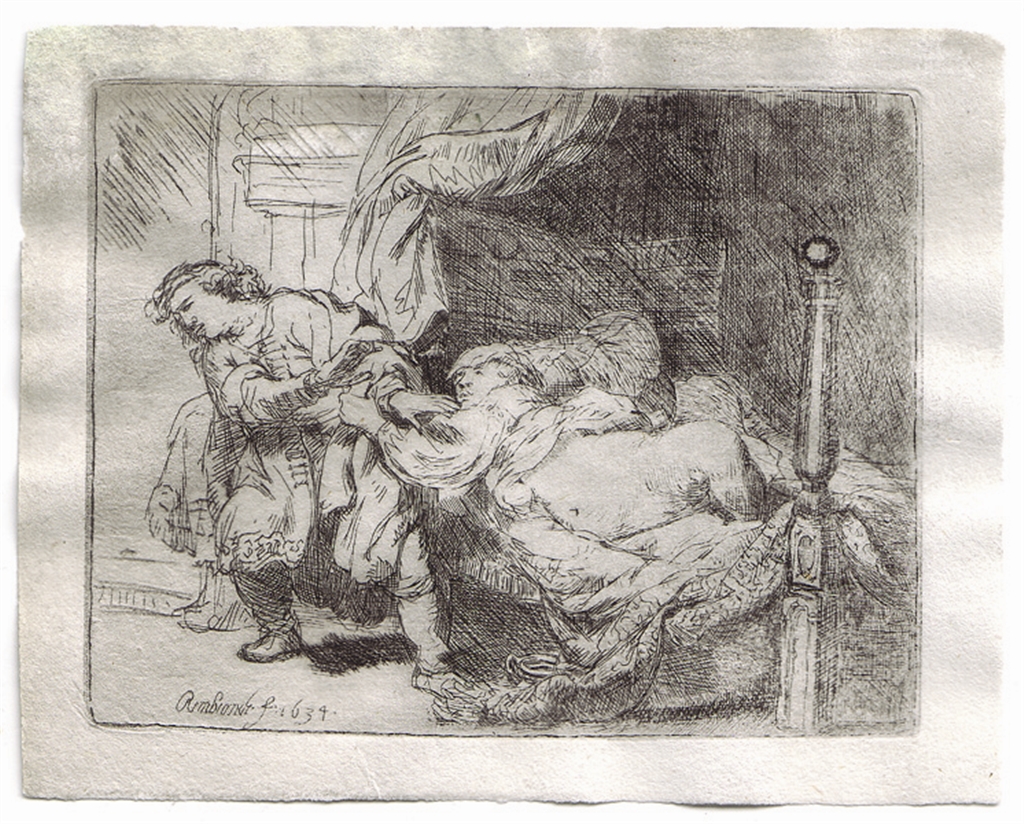
Etching, "Joseph and Potiphar's Wife" (1634), Rembrandt Van Rijn
Typically, when a plate was inked for an etching, the excess ink that had not settled into the etched lines was completely wiped from the plate. Rembrandt experimented with this process, allowing the ink to partially remain on the plates after each pressing. This allowed him to construct varying contrasts and tones, which changed with each printing. The artist used this tonality to create deep shadows that dramatically altered the atmosphere of a print.
Rembrandt also observed the different properties of various papers and inks and tested different combinations. He was particularly drawn to Japanese paper due to its yellowish color, which he found ideal for landscape prints.
From time to time, Rembrandt used different intaglio styles within his etchings—"intaglio" represents any printing or printmaking technique that involves adding ink to a plate with lines or indents added to it. One of those intaglio styles was drypoint, the process of drawing onto a plate by using a sharp needle. Drypoint pulls up pieces of the metal called "burr," and the burr helps catch additional ink to produce a fuzzy texture within the print.
Many artists found the effect appealing, but the burr wears away quickly during the printing process, making it unsuitable for mass printings. However, Rembrandt found that, due to the smooth texture of Japanese paper, the drypoint elements of his prints were more distinguishable and did not wear away as quickly.
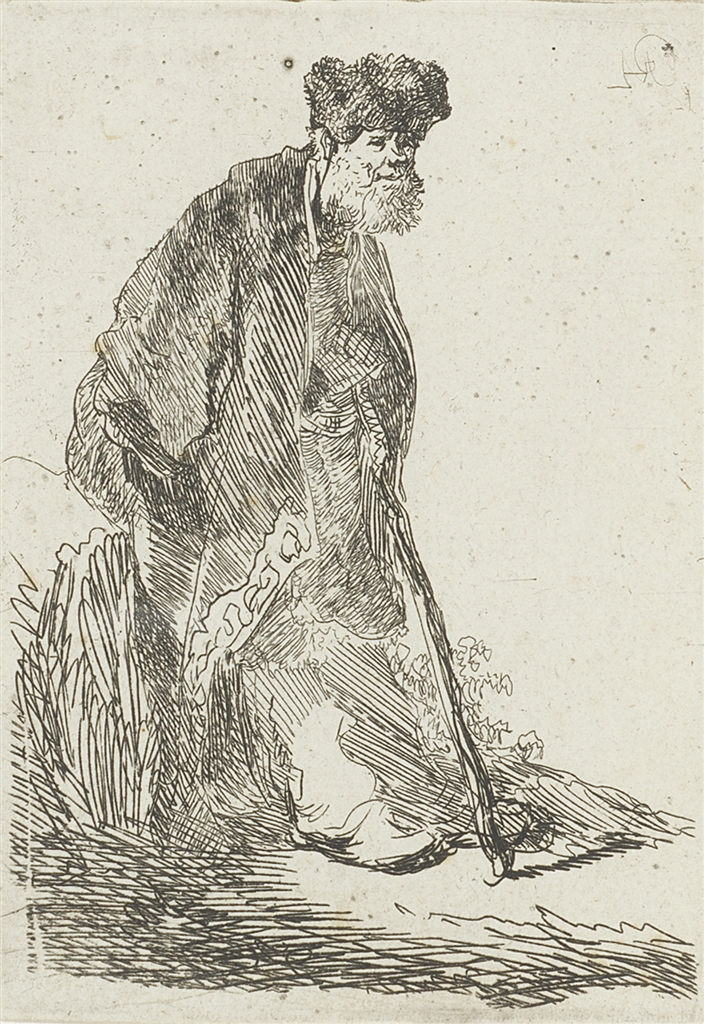
Etching, "Man in Cloak and Fur Cap Leaning Against a Bank" (c. 1630), Rembrandt Van Rijn
CREATIVE CHANGES DURING THE ETCHING PROCESS
Rembrandt not only experimented with the materials used to create his prints, but he also reworked his imagery. He was able to do this because of the nature of copper plates, which are comparatively soft and can be pounded or burnished so lines can be removed or added.
Rembrandt sometimes spent years working on a single plate, making prints from the plate between various changes. These changes—referred to as "states"—offer a rare glimpse into the artist's creative process.
These states have been meticulously documented by Rembrandt scholars for centuries, in what are known as "catalogs raisonné" of his etchings. The most recent publication includes photographs of each state. These sources are referenced in the Park West descriptions for each etching and are the standard references used throughout the art world.
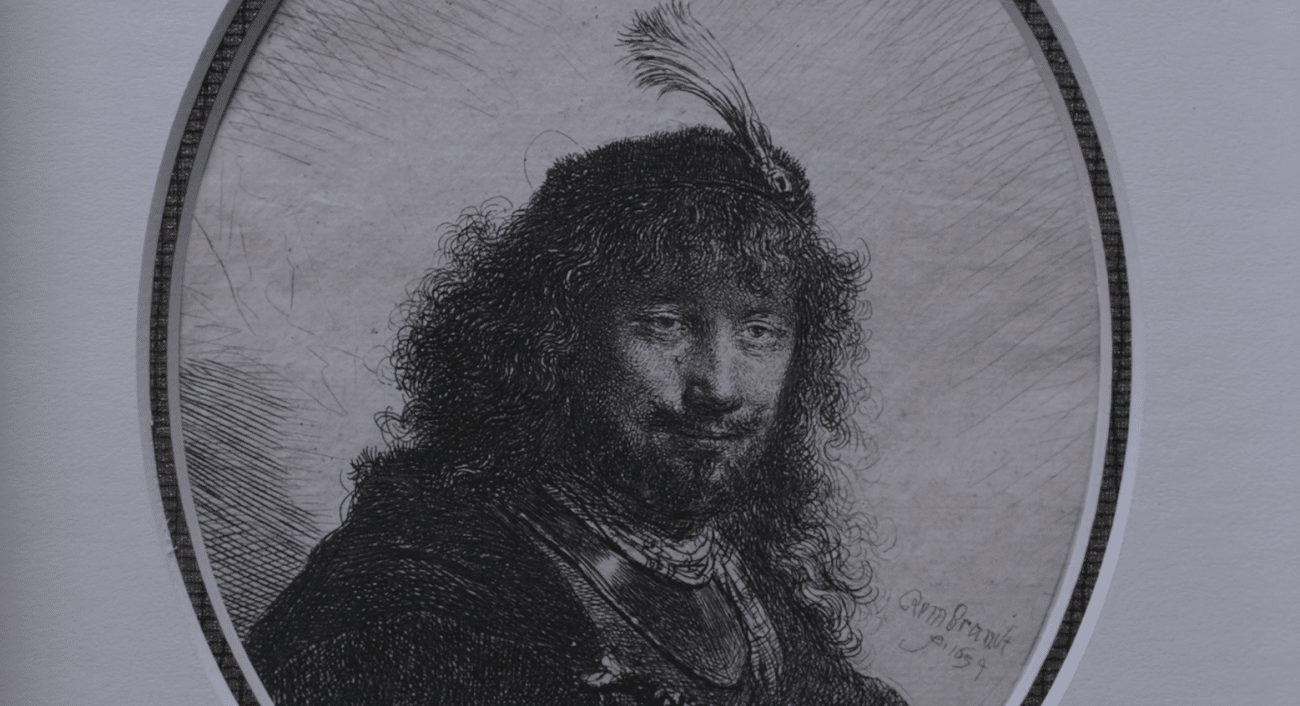
Etching, "Self-Portrait with Plumed Cap and Lowered Sabre" (1634), Rembrandt Van Rijn
The combination of the various states of Rembrandt's prints, along with his distinctive printing techniques, created a sense of uniqueness in a method known for its mass production qualities. This, in turn, helped increase the popularity and collectability of Rembrandt's etchings.
Collectors sought to acquire multiple examples of Rembrandt's images in order to capture the variations between the different states. Through this, a record of Rembrandt's creative process was captured and can be studied long into the future.
Rembrandt's importance to the history of etching cannot be overstated. The over 300 etchings, engravings, and drypoints he created throughout his career helped influence generations of printmakers to come.
The Park West Museum in Southfield, Michigan has over 20 examples of Rembrandt's remarkable etchings on display—including all of the etchings pictured in this article. For more information on visiting the museum, click here.
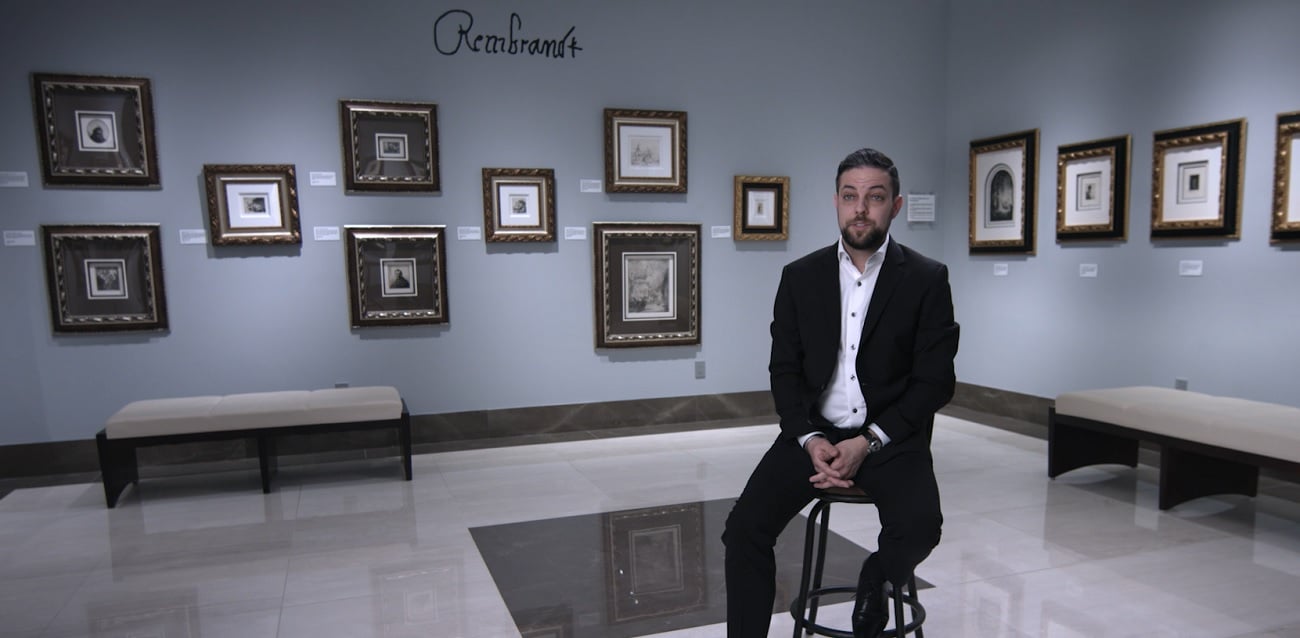
Park West Gallery Director David Gorman in the Park West Museum Rembrandt gallery.

The Rembrandt etching gallery at Park West Museum
To add a limited-edition masterpiece by Rembrandt van Rijn to your collection, register for our exciting online auctions or contact one of our gallery consultants at (800) 521-9654 ext. 4 during business hours or email sales@parkwestgallery.com for inquiries after hours.
RELATED LINKS:
- Rembrandt Etching Discovered in a University Bathroom
- Major Collection of Rembrandt Etchings and the Artist's Studio on View
- Subjects of Rembrandt Etchings
The post How Rembrandt van Rijn Changed the Art of Etching Forever appeared first on Park West Gallery.
]]>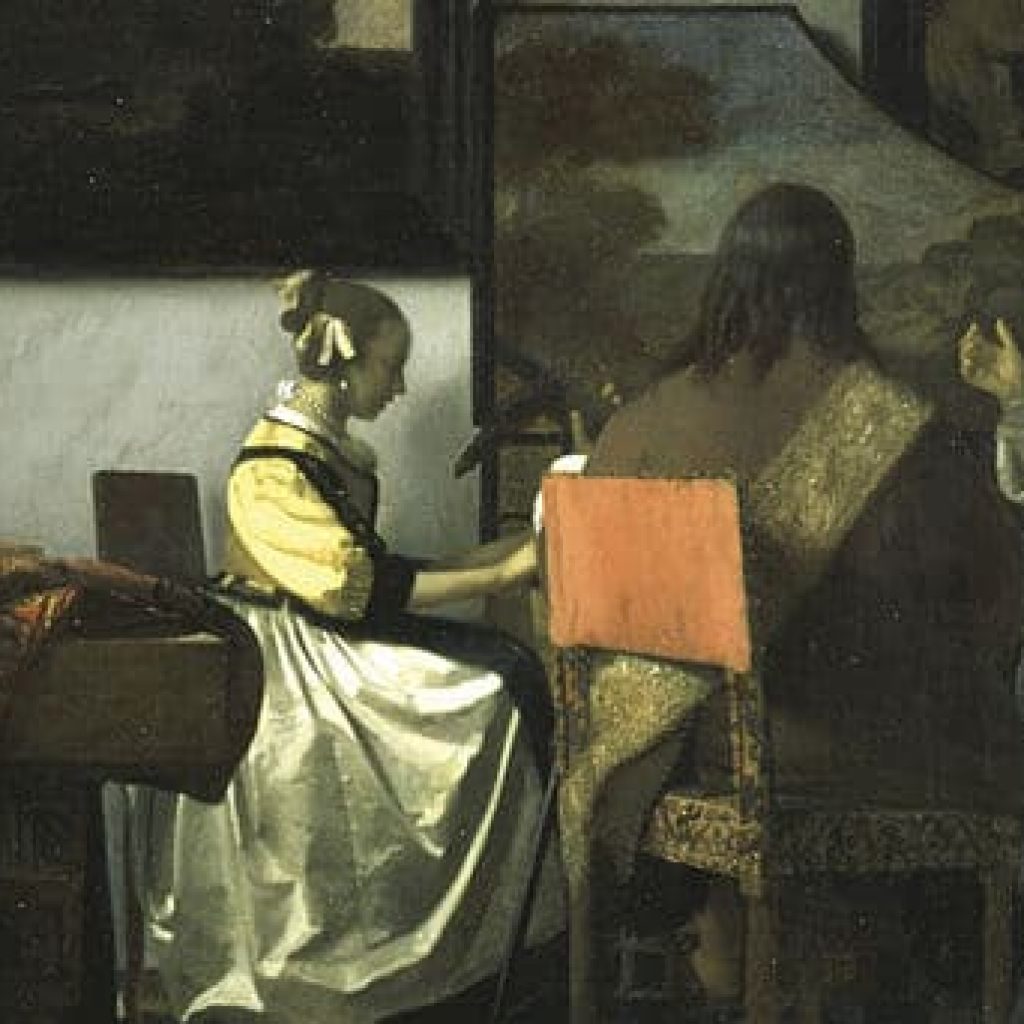
The art world is full of fascinating exhibitions, intriguing discoveries, and moments that shape history. Here are some of the latest news items making art headlines. New Leads in Gardner Museum Theft A Dutch private investigator claims to have new leads on recovering $500 million in stolen art from the Isabella Stewart Gardner Museum in […]
The post Art News: New Gardner Museum Lead, Herzog Court Victory, 'Genius' to Profile Picasso appeared first on Park West Gallery.
]]>
The art world is full of fascinating exhibitions, intriguing discoveries, and moments that shape history. Here are some of the latest news items making art headlines.
New Leads in Gardner Museum Theft
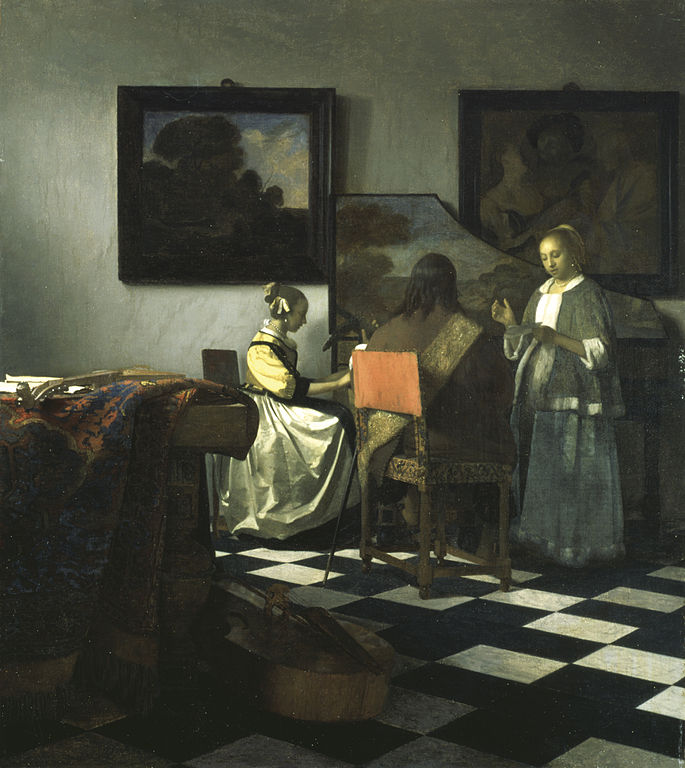
"The Concert" (c. 1665), Johannes Vermeer. (Public domain. Image courtesy of Wikimedia Commons)
A Dutch private investigator claims to have new leads on recovering $500 million in stolen art from the Isabella Stewart Gardner Museum in Boston.
The New York Daily News spoke with investigator Arthur Brand, who says he is in negotiations with sources connected to the 13 paintings famously stolen from the museum in 1990. The paintings include works by Rembrandt van Rijn, Johannes Vermeer, and Édouard Manet.
"These are some of the most famous paintings ever produced by mankind, and it's time to bring them back," Brand told CBS Boston.
The article states Brand has "two good leads" that make him believe the stolen artworks are in Ireland. One lead involves photos from a Dutch criminal, while the other lead was not disclosed.
The museum recently increased its reward for the missing artwork to $10 million, though Brand insists in the article that the "$10 million will not be for me."
U.S. Court Rules in Favor of Family Reclaiming Art Seized by Nazis
The U.S. federal appeals court rejected Hungary's attempts to throw out a lawsuit from a family seeking to reclaim a $100-million art collection seized by Nazis.
An article from Bloomberg states this is the second time in four years the U.S. court rejected Hungary's request. The ruling opens the way for the claims to proceed to a lower court judge.
The Herzog family is seeking the return of 40 works of art that belonged to their ancestor, Baron Mór Lipót Herzog. The Hungarian banker assembled a private collection of more than 2,000 works by artists including El Greco, Diego Velazquez, Pierre-Auguste Renoir, and Claude Monet. Bloomberg reports the art was looted during the Nazi occupation of Hungary and is in possession of Hungarian museums and a university.
The family sued in 2010 after struggling for decades to recover the art.
Picasso to Become Focus of NatGeo's 'Genius' Show
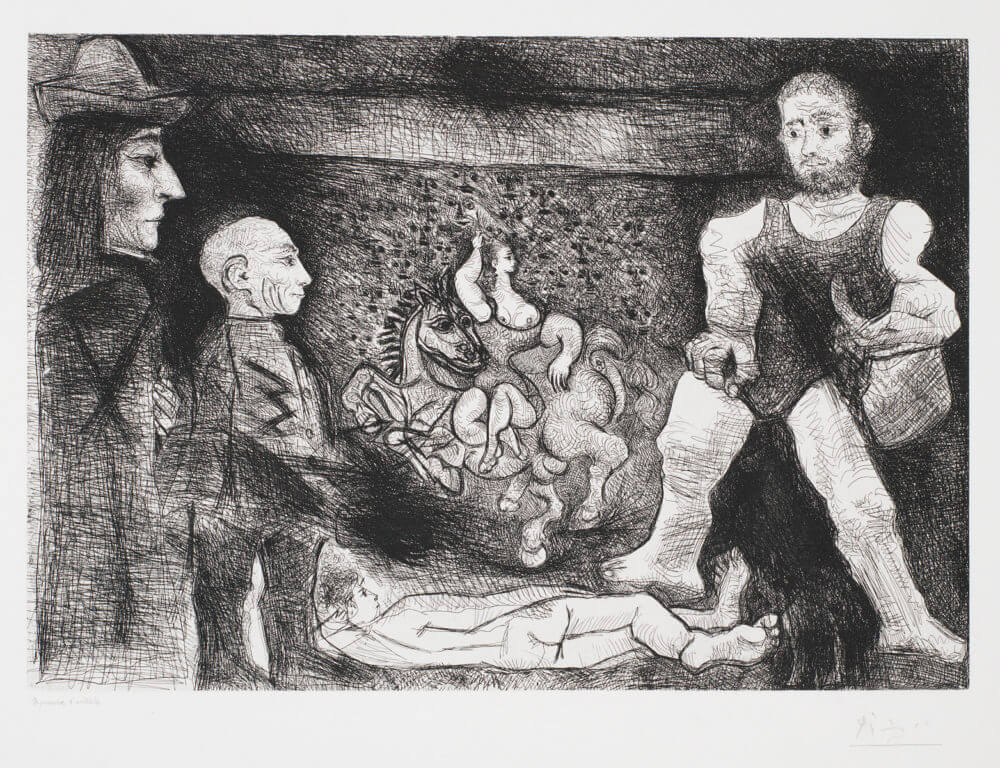
"Picasso, Son Oeuvre, et Son Public" 347 Series: No. 1 (1968), Pablo Picasso. B. 1481; Baer 1496
ScreenRant reports that season two of National Geographic's "Genius" show will examine the life of legendary artist Pablo Picasso.
Executive Producer Ron Howard said hours of debate and discussion went into the decision to choose Picasso. He describes Picasso as "an enigmatic figure, famous, a household name," but "you don't really know the story of his life, or what inspired him, drove him, troubled him."
The season will portray Picasso and how he achieved artistic greatness throughout his 80-year career. There is no word on who will portray the famous Cubist, but the season will air in 2018.
Season one of the "Genius" focused on the life of Albert Einstein. Geoffrey Rush portrayed the scientist's older years while Johnny Flynn starred as the younger version. The show was lauded for its high production value and non-linear narratives.
For the latest in art news and events, follow Park West Gallery on Facebook, Twitter, Instagram, and Pinterest.
The post Art News: New Gardner Museum Lead, Herzog Court Victory, 'Genius' to Profile Picasso appeared first on Park West Gallery.
]]>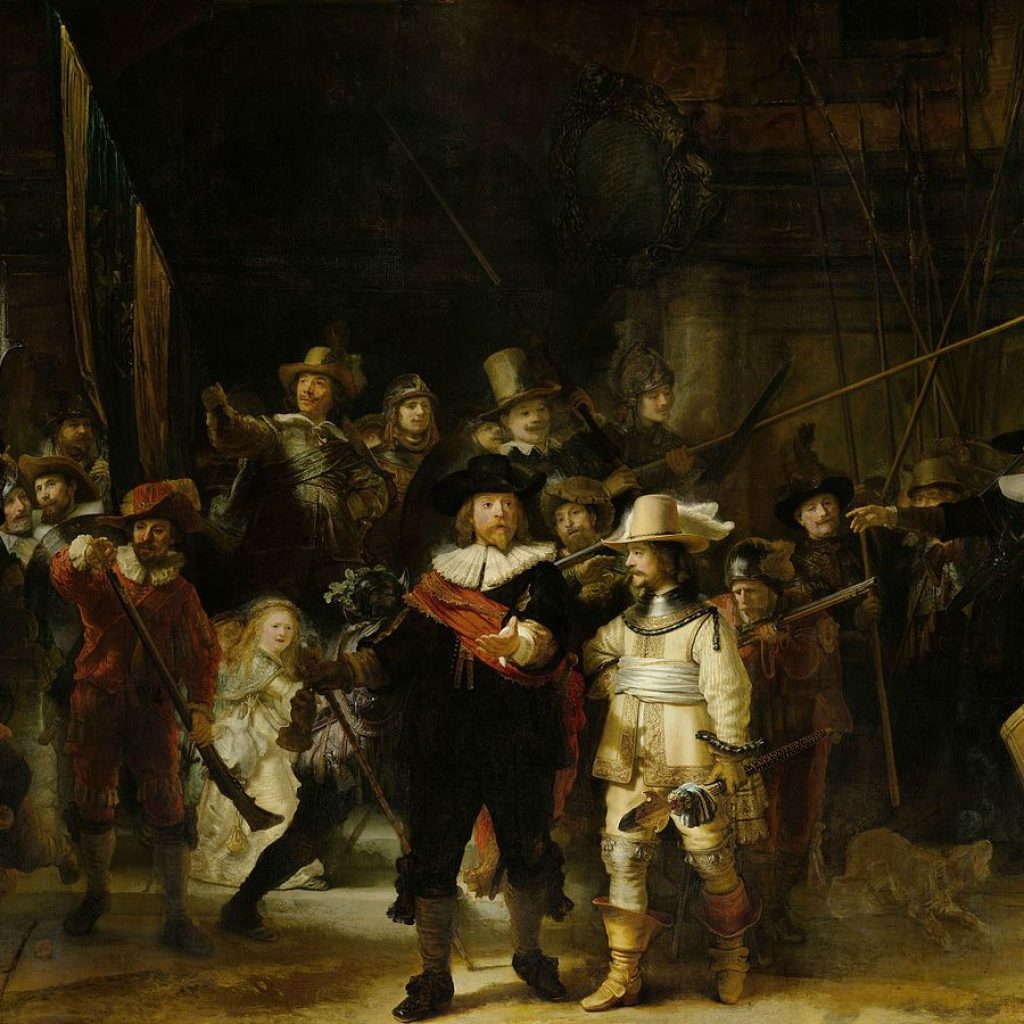
The art world is full of fascinating exhibitions, intriguing discoveries, and moments that shape history. Here are some of the latest news items making art headlines. Dutch Teacher Spends the Night With Rembrandt's 'The Night Watch' A Dutch teacher became the first person to spend a night admiring Rembrandt van Rijn's "The Night Watch" […]
The post Art News: 'The Night Watch' Sleepover, Fine Art Inspires 'Wonder Woman,' Top 20 Museums appeared first on Park West Gallery.
]]>
The art world is full of fascinating exhibitions, intriguing discoveries, and moments that shape history. Here are some of the latest news items making art headlines.
Dutch Teacher Spends the Night With Rembrandt's 'The Night Watch'
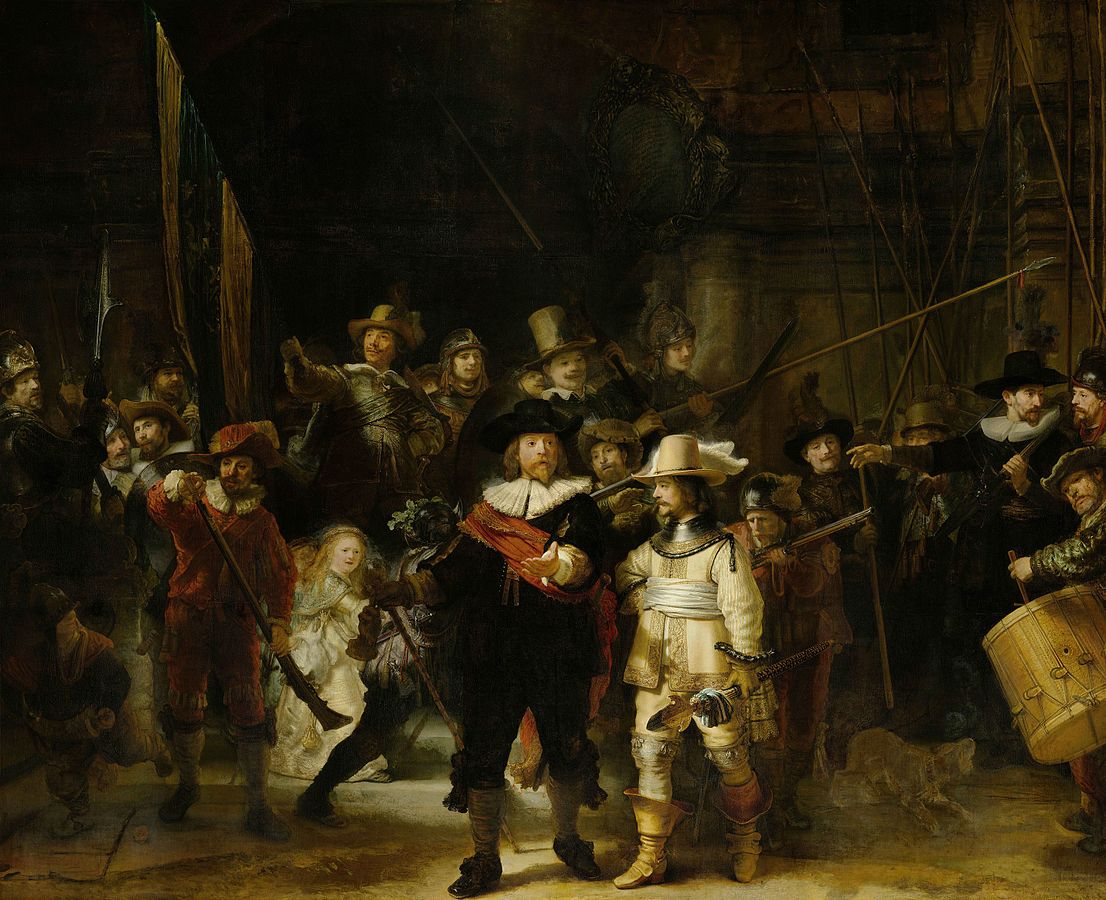
"The Night Watch" (1642), Rembrandt van Rijn (By Rembrandt – www.rijksmuseum.nl : Home : Info, Public Domain, Link)
A Dutch teacher became the first person to spend a night admiring Rembrandt van Rijn's "The Night Watch" in Amsterdam's Rijksmuseum.
The BBC reports Stefan Kasper was the 10 millionth visitor to the museum since it reopened in 2013. The status earned Kasper the prize of spending a night at the museum. Along with the chance to admire "The Night Watch," the teacher was treated to a meal prepared by a chef from a Michelin-star restaurant.
"I still can't believe it," Kasper told AFP news agency. "I discovered characters that I have never seen before. They came to life in front of me. It's an experience that is forever etched in my memory."
"The Night Watch" is considered one of Rembrandt's most significant paintings and one of Amsterdam's most important artworks, according to Rijksmuseum director Taco Dibbits.
John Singer Sargent Inspired 'Wonder Woman' Aesthetics
The new "Wonder Woman" movie gave the classic superhero a modern look and feel. The inspiration for its aesthetics, however, was pulled from a centuries-old source.
According to Matt Jensen, the film's director of photography, he and director Patty Jenkins were influenced by the colors, lighting, and portraiture of 19th-century American painter John Singer Sargent when designing the film's look.
"His lighting style influenced the way that I lit the movie. I think Patty really responded to the beautiful soft light that [Sargent] used in his paintings on his subjects," Jensen told Digital Spy.
The superhero movie, starring Gal Gadot as Wonder Woman, is receiving positive reviews from critics and has grossed more than $300 million worldwide.
New Report Lists Top 20 Museums in the World
A new report from the Themed Entertainment Association and engineering firm AECOM reveals surprising results for which museums are ranked as the top 20 in the world.
Smithsonian Magazine broke down the results of the report, which categorized museums based on the number of visitors they received during 2016. The study concludes the National Museum of China topped the list, having brought in 7.6 million visitors. The National Air and Space Museum in Washington, D.C. was second at 7.5 million.
The Louvre, perhaps the most famous museum in the world, came in third with 7.4 million attendees in 2016. This is a 15-percent decrease from the prior year where the Paris museum received 8.7 million visitors.
Overall, the report shows museum attendance has been stable over the past few years, demonstrating tourists and locals alike still have an appreciation for art, artifacts, and relics.
Follow Park West Gallery on Facebook, Twitter, Instagram, and Pinterest to keep up with the latest art news.
The post Art News: 'The Night Watch' Sleepover, Fine Art Inspires 'Wonder Woman,' Top 20 Museums appeared first on Park West Gallery.
]]>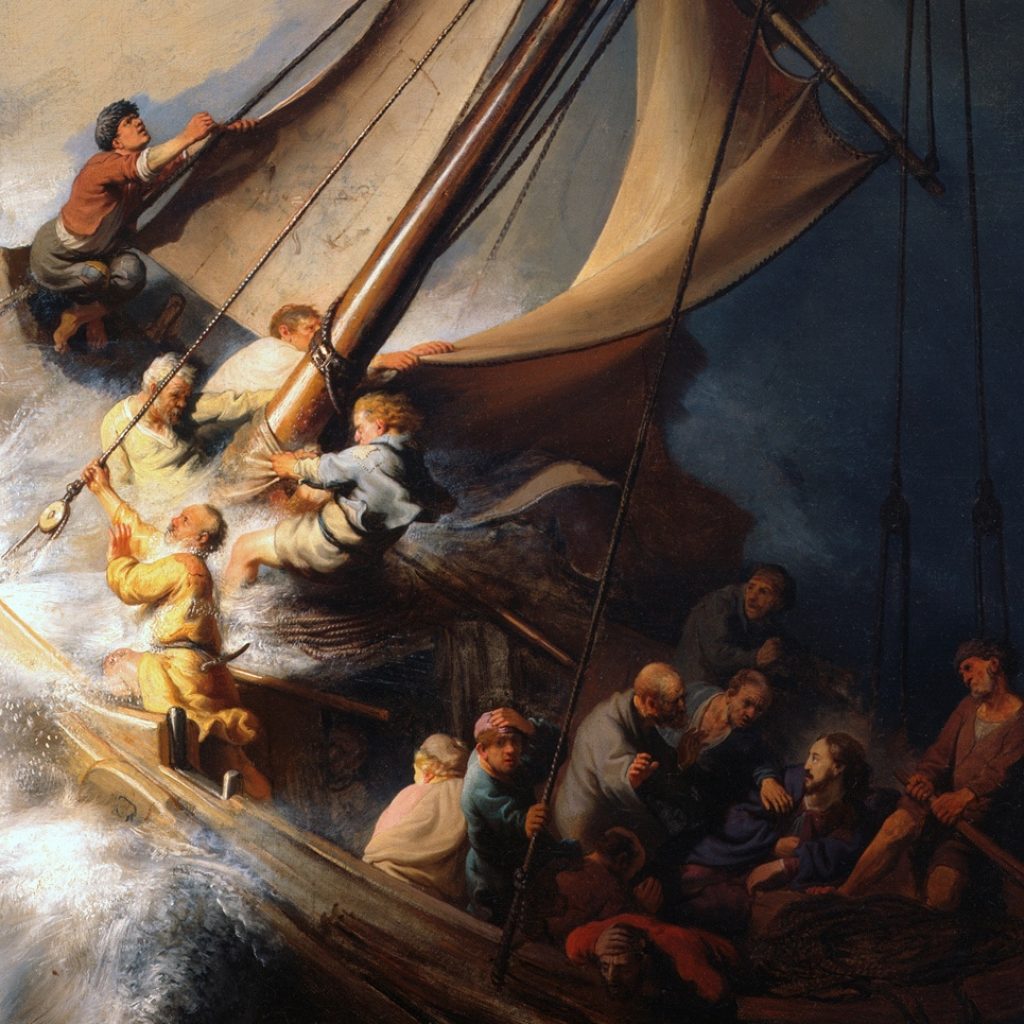
The art world is full of fascinating exhibitions, intriguing discoveries, and moments that shape history. Here are some of the latest news items making art headlines. Reward for Stolen Gardner Museum Artwork Doubles The Isabella Stewart Gardner Museum in Boston doubled its reward to $10 million for the recovery of 13 works of art […]
The post Art News: $10-Million Gardner Museum Reward, Renoir Museum, Famous Photos Recreated appeared first on Park West Gallery.
]]>
The art world is full of fascinating exhibitions, intriguing discoveries, and moments that shape history. Here are some of the latest news items making art headlines.
Reward for Stolen Gardner Museum Artwork Doubles
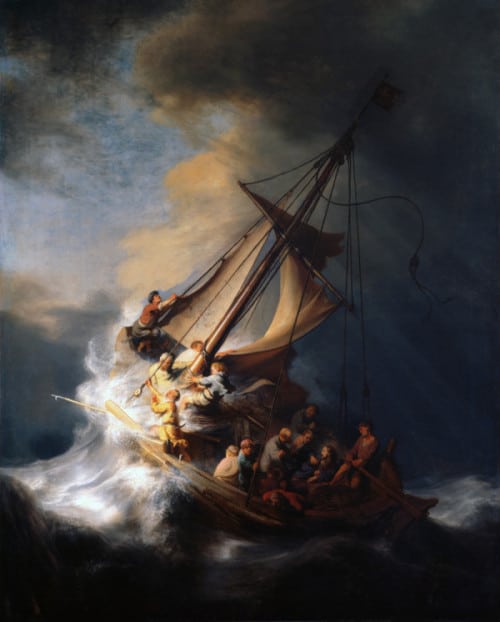
Rembrandt Christ in "The Storm on the Lake of Galilee" by Rembrandt – www.gardnermuseum.org. Picture licensed under Public Domain via Wikimedia Commons.
The Isabella Stewart Gardner Museum in Boston doubled its reward to $10 million for the recovery of 13 works of art stolen from the museum almost 30 years ago.
The New York Times reports the artwork, which includes masterpieces by Johannes Vermeer, Rembrandt van Rijn, Edgar Degas, and Édouard Manet, is valued at $500 million. The artwork was stolen in 1990 by two thieves posing as police officers.
"It is our fervent hope that by increasing the reward, our resolve is clear that we want the safe return of the works to their rightful place and back in public view," Steve Kidder, president of the board, said in a statement.
The stolen works made recent headlines when, according to the Hartford Courant, a West Virginia man claimed he had "The Storm on the Sea of Galilee" by Rembrandt and Vermeer's "The Concert." The man, identified as Todd Andrew Desper, was attempting to sell the paintings through Craigslist. The FBI is charging Desper with fraud and attempted fraud.
The museum previously identified the people who stole the art, but was convinced they no longer possessed the artwork.
Renoir Summer Home to Become Public Museum

The Renoir home in Essoyes, France (Photo courtesy of Voyages etc)
The summer home of Pierre-Auguste Renoir in Essoyes, France is opening as a public museum on June 3 after four years of restoration.
According to the Art Newspaper, Renoir's great-granddaughter, actress Sophie Renoir, sold the house to the village council for $670,000 (€600,000) in 2012. Over the past four years, the village made $1.1 million (€1 million) in restorations to convert the home into a museum. The restoration team is reported to have used Renoir's paintings of the house as inspiration for the renovations.
Renoir bought the home in 1896. The famed French Impressionist eventually moved a decade later to Cagnes-sur-Mer, but still spent his summers at the Essoyes home until his death in 1919.
Artist Recreate Famous Photos in 'Icons' Series

The footstep of Neil Armstrong on the moon (Public domain. Photo courtesy of Ur Cameras)
A story from CNN shows how Swiss artists Jojakim Cortis and Adrian Sonderegger are recreating iconic photographs using cardboard, wood, and glue.
The artistic duo creates 3D miniatures of scenes captured throughout history, such as man's first step on the moon, the Paris Concorde crash, and the Tiananmen Tank Man. The series is on display at Photo London.
The final composition of each recreation is shot from a distance, showing the studio and tools surrounding the miniatures. This forces viewers to question fact and fiction.
"One should not simply trust photography," Cortis explains. "When there was no digital image processing, there was still a means to stage a picture or direct it in one way."
Follow the latest art news on Park West Gallery's Facebook, Twitter, Instagram, and Pinterest pages.
The post Art News: $10-Million Gardner Museum Reward, Renoir Museum, Famous Photos Recreated appeared first on Park West Gallery.
]]>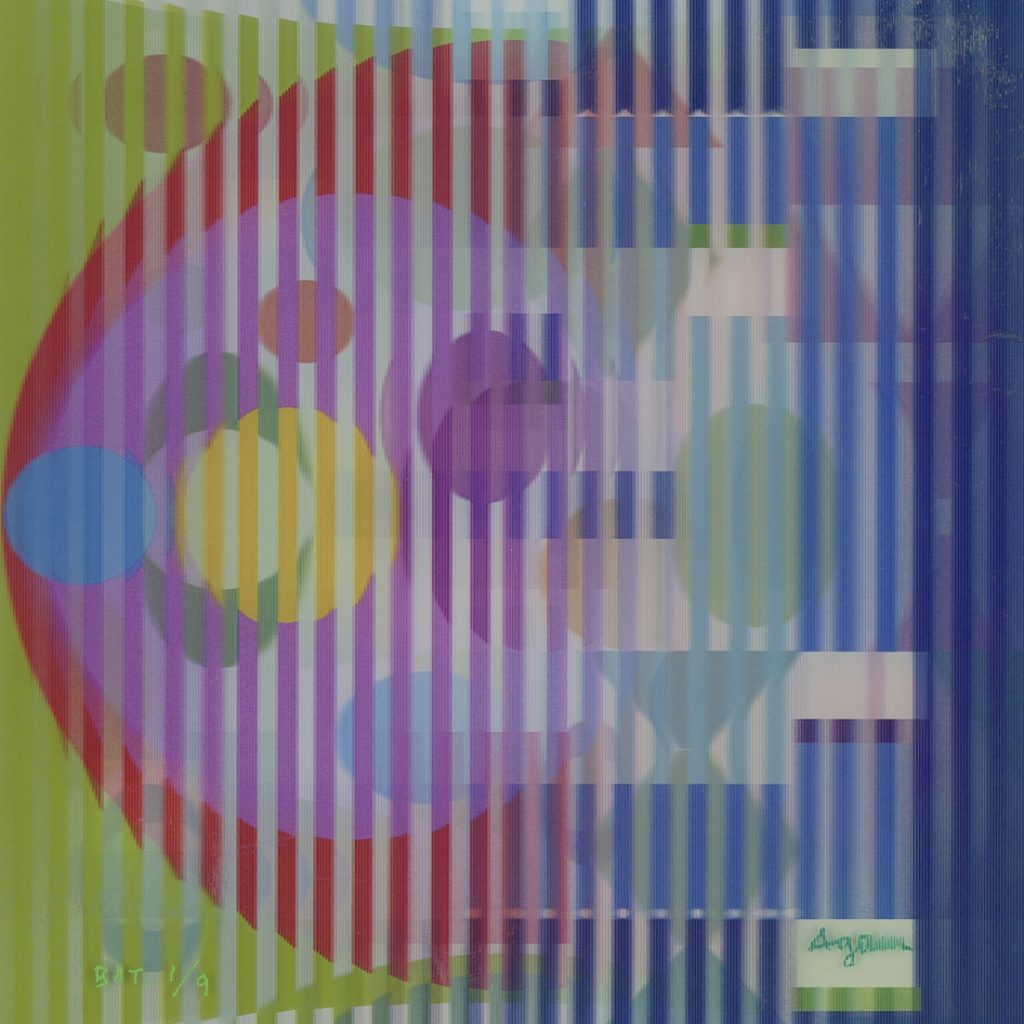
Artificial intelligence is on its way to becoming the next instrument in an artist's toolkit. The creation of art has advanced over the centuries, starting with pigments on cave walls and evolving to mediums like lithography and serigraphy. Although technology and art seem at odds, artists often adapt technology to their needs, like Autumn de Forest […]
The post Could Artificial Intelligence Be a New Paintbrush? appeared first on Park West Gallery.
]]>
Artificial intelligence is on its way to becoming the next instrument in an artist's toolkit.
The creation of art has advanced over the centuries, starting with pigments on cave walls and evolving to mediums like lithography and serigraphy. Although technology and art seem at odds, artists often adapt technology to their needs, like Autumn de Forest teaching students to project their faces onto canvases or Yaacov Agam creating digital art.
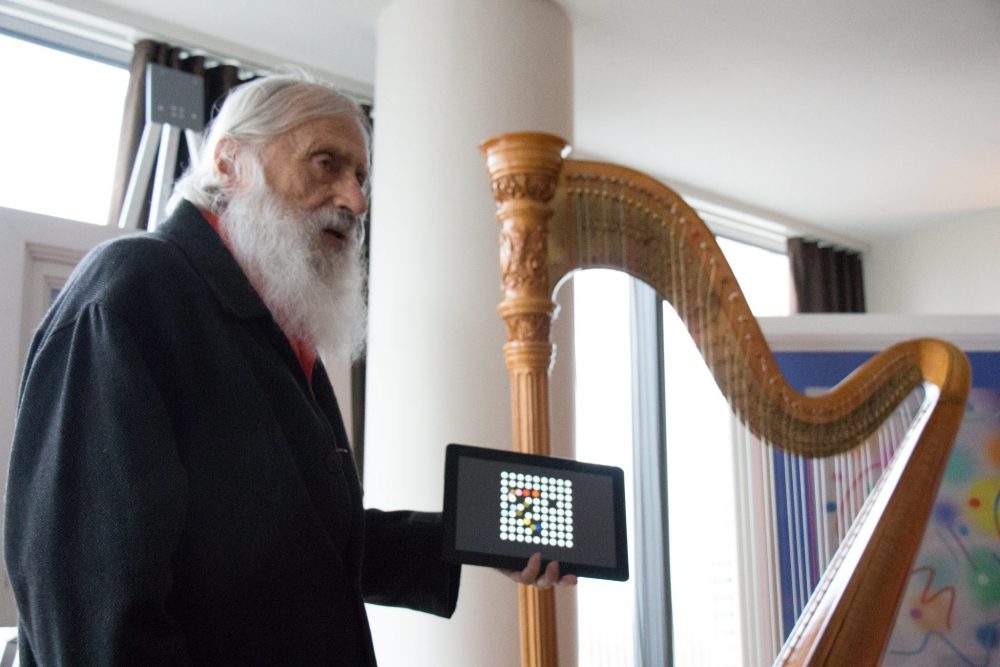
Yaacov Agam demonstrates one of his interactive digital works of art.
Artificial intelligence may be next in line for artists. In 2016, an artificial intelligence project from ING created a painting in the fashion of Rembrandt van Rijn. The portrait was the result of an 18-month analysis of 346 painting and 150 gigabytes of graphics.
The final product was a 3-D printed portrait that even took into account Rembrandt's brushstrokes. Still, as detailed as the work is, the creators admit it won't fool experts.
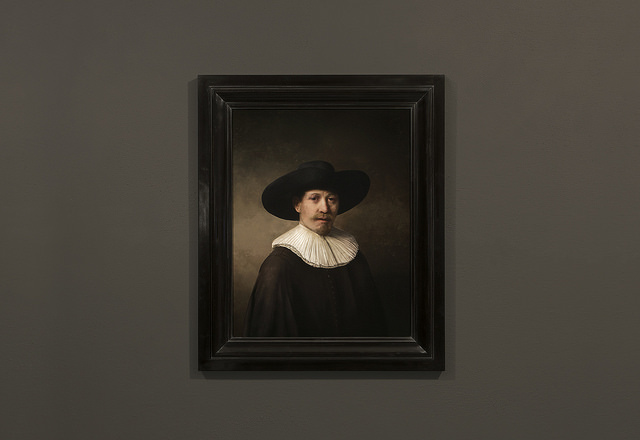
The results of ING's Rembrandt project (Photo courtesy of ING Group)
Large tech companies like Facebook and Google are creating artificial neural networks that recognize faces, animals, and other objects in photos. By reversing this process, these networks are able to generate images.
Facebook's neural network is able to create realistic images that fool human viewers 40 percent of the time. Google trained its neural nets to produce psychedelic works of art, even going so far as to transform images of clouds into objects—as a child would do when looking at the sky.
Technology and Park West Art
Artist Tim Yanke discussed the use of technology in art during an interview on the "Sunday Edition." He draws parallels to other advancements in art, such as the mass production of paint in lieu of self-made pigments.
"It's all part of a progression, it's all part of a timeline," Yanke says.
Yanke is one of many Park West Gallery artists who embrace dye sublimation, the latest in digital art technology. With it, artists can manipulate their images to be vibrant and sharp, and then apply them to durable mediums such as aluminum.
Yanke points out how American artist Norman Rockwell used photographs as a basis for his iconic artwork, demonstrating that even most renowned artists will utilize technology to create art.
"Did [Rockwell] cheat because he used a photograph? No, he used technology that was there," Yanke says.
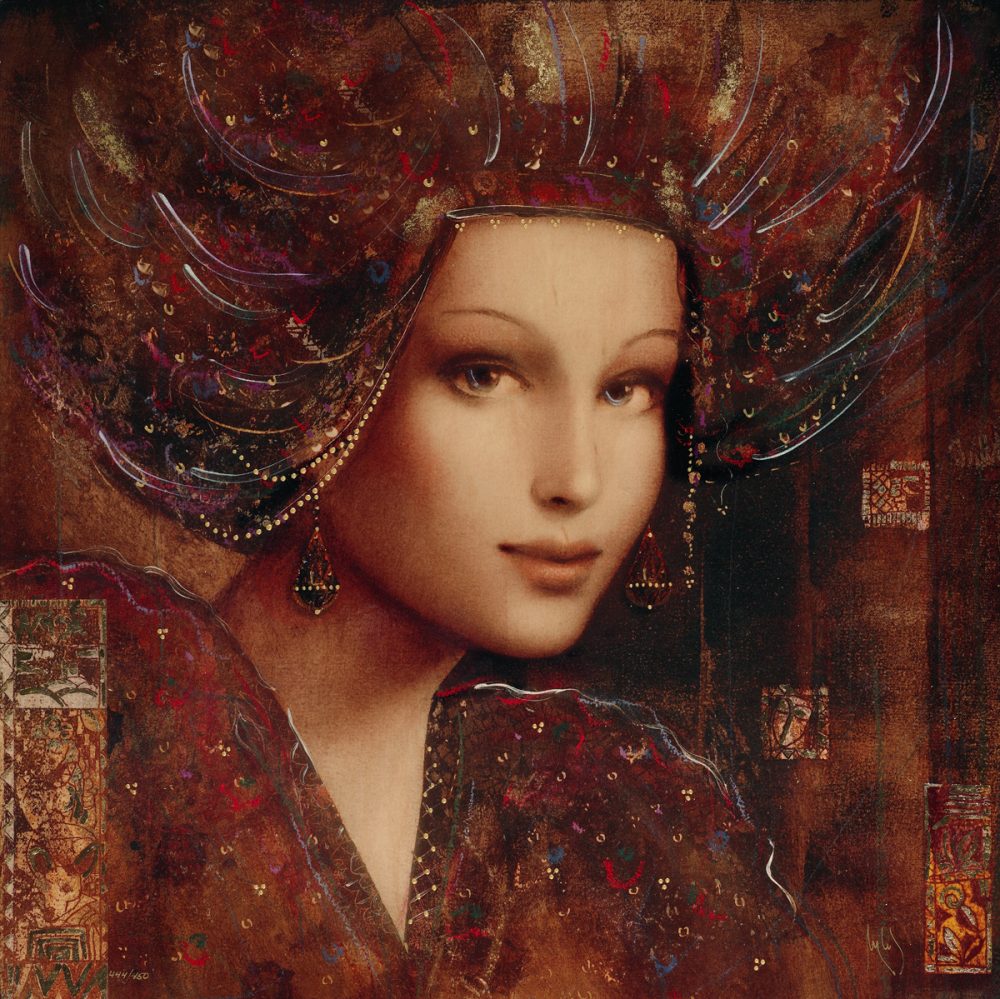
"Ciania" (2016), Csaba Markus
Csaba Markus is among the artistic innovators who implement technology as a medium. Markus utilizes digital printing methods to create caldographs, artwork on wood that pays tribute to the artistic traditions of the Renaissance through the use of dye sublimation.
"High pressure and heat generate gases so the ink from the paper sublimates into the wood, it's a very beautiful technique," Markus says.
Computers and Creativity
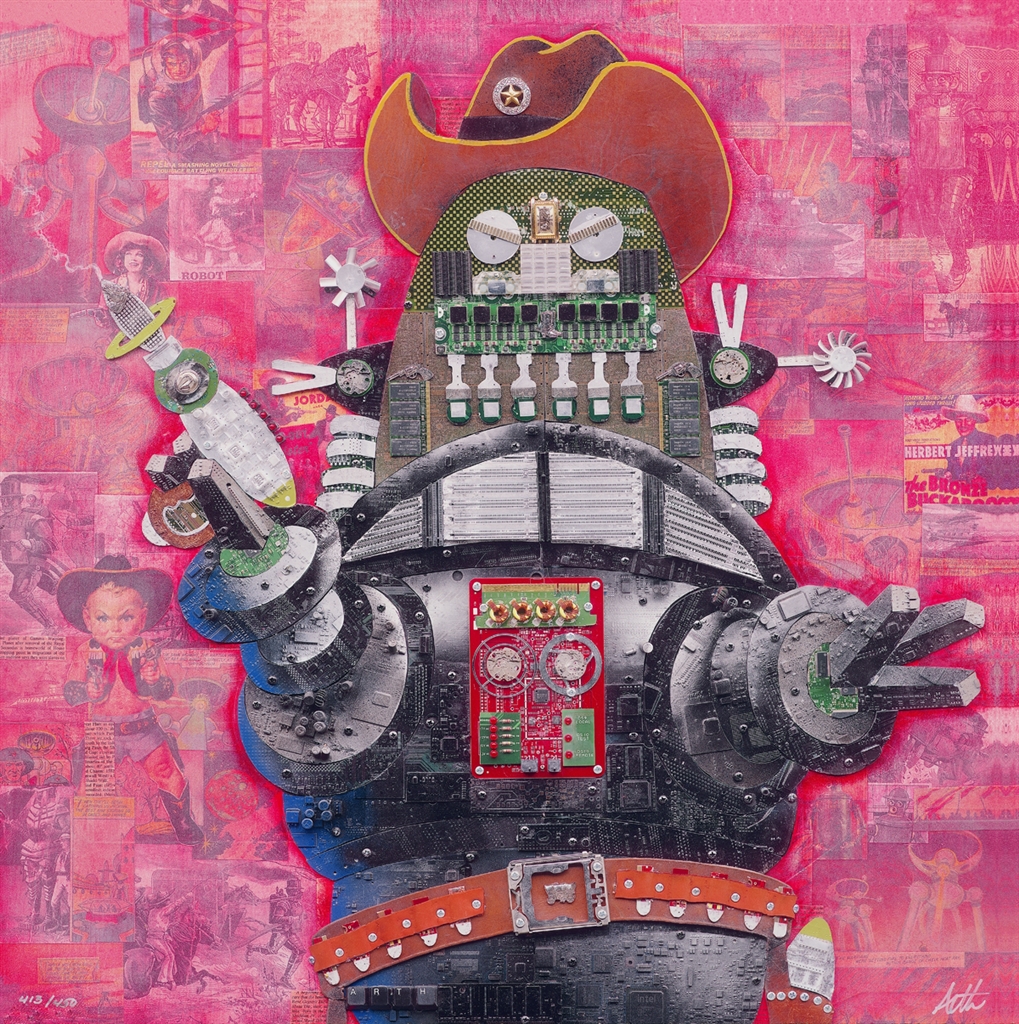
"Sheriff Robby" (2017), Gregory Arth
The use of technology raises an interesting question: What is creativity if artificial intelligence can make art? Is creativity merely the combination of gathering and processing information to achieve a desired effect?
An article from NPR explores the question with Mark Riedl, an associate professor at the Georgia Tech School of Interactive Computing. Riedl believes there are two types of creativity. One is creativity with a small 'c,' which is more akin to performing everyday activities.

"Picasso, Son Oeuvre, et Son Public" 347 Series: No. 1 (1968), Pablo Picasso. B. 1481; Baer 1496
The second is Creativity with a capital 'C,' reserved for the Picassos and Mozarts of the world—those with a spark and imagination whose creations take on additional meanings.
"It's my sense that we, as creative beasts, want the computers to keep up with us," Riedl says.
Keep up on the latest artistic innovations of our artists by following Park West Gallery on Facebook, Twitter, and Instagram.
The post Could Artificial Intelligence Be a New Paintbrush? appeared first on Park West Gallery.
]]>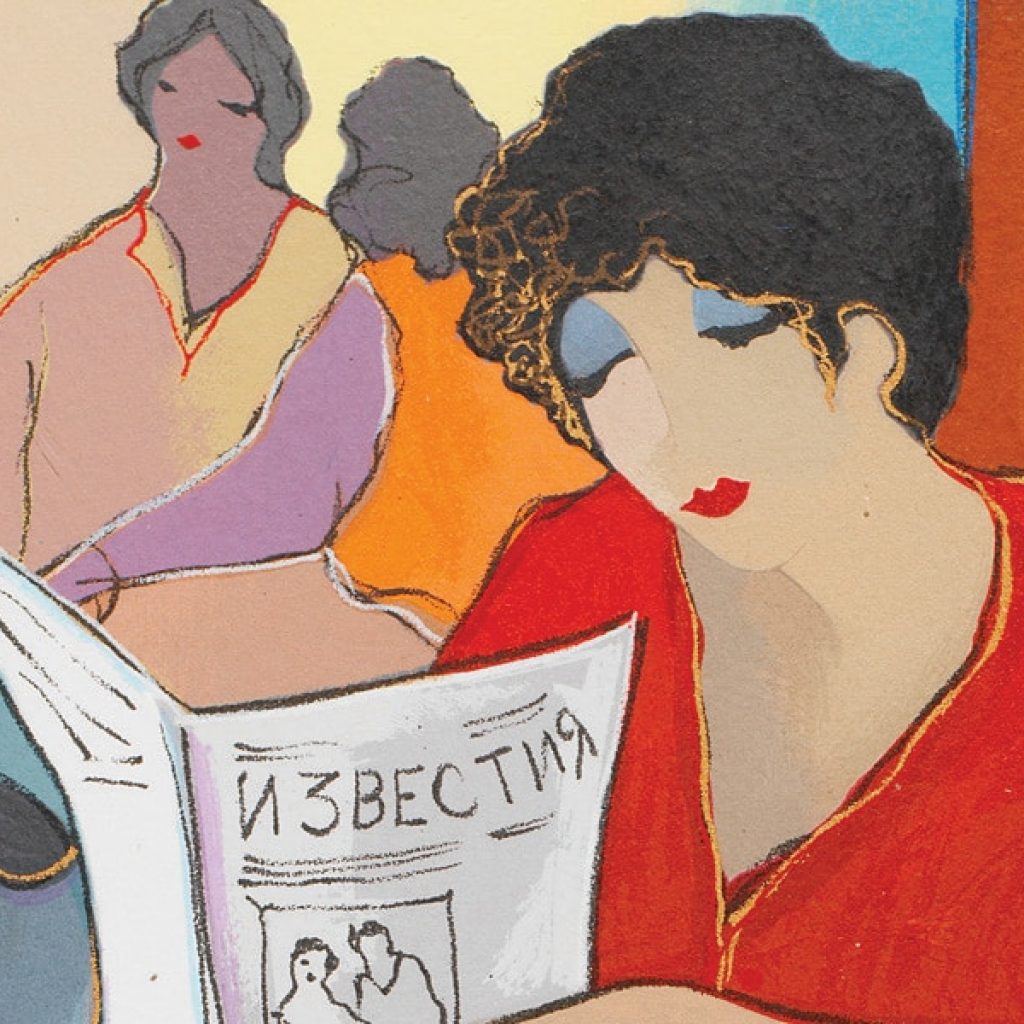
The art world is full of fascinating exhibitions, intriguing discoveries, unfortunate thefts and welcomed recoveries. Here are some of the latest news items making art headlines. "Big Maple Leaf" Gold Coin Stolen from Berlin's Bode Museum NBC News The Bode Museum in Berlin reported a 220-pound gold coin dubbed "Big Maple Leaf" was stolen […]
The post Art News From Around the World appeared first on Park West Gallery.
]]>
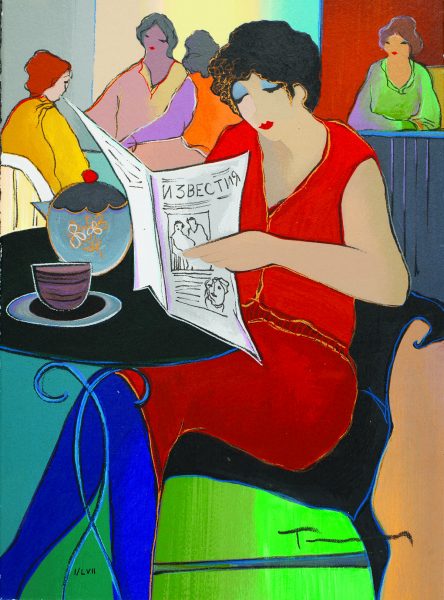
"Daily News" (2008), Itzchak Tarkay
The art world is full of fascinating exhibitions, intriguing discoveries, unfortunate thefts and welcomed recoveries. Here are some of the latest news items making art headlines.
"Big Maple Leaf" Gold Coin Stolen from Berlin's Bode Museum
NBC News
The Bode Museum in Berlin reported a 220-pound gold coin dubbed "Big Maple Leaf" was stolen from its facilities.
The coin, which boasts a gold purity of 999.99/1000, has a face value of 1 million Canadian dollars ($750,000), but its real value is closer to 6 million Canadian dollars ($4.5 million) based on weight alone. The coin features a portrait of Queen Elizabeth II on one side and a maple leaf on the other.
Police say a group of thieves likely entered the museum undetected through a window, possibly with the help of a ladder. The coin was secured in bullet-proof glass.
The "Big Maple Leaf" was on loan from a private collection.
Mystery Man: Research Quest at the Fralin Museum of Art at UVA
University of Virginia
A painting attributed to the 17th-century Dutch master Rembrandt van Rijn made headlines when a series of academic studies revealed a shocking piece of information: Rembrandt didn't create it.
The painting was re-discovered at the University of Virginia's Fralin Museum of Art. The museum turned it over to Larry Goedde, chair of the university's McIntire Department of Art and a scholar of Dutch painting, for analysis. He expressed doubts that it was from the 17th century.
X-ray tests revealed another painting underneath the surface of the supposed masterpiece. The practice of reusing panels or canvases is not uncommon, but the hidden painting's origins date back to the 18th century, well past Rembrandt's death in 1669.
Additional tests led researchers to discover pigments on the uppermost painting contained titanium, an element introduced to paint in the 20th century. Even the lattice attached to the back of the painting showed signs of being machine cut, and was likely milled in the late 19th century.
The forgery will be on display in the Fralin Museum of Art's exhibition, "Collect, Care, Conserve, Curate: The Life of the Art Object," running through July 23.
Paris Exhibition Highlights Picasso's Passion for Distant Cultures
Reuters
An exhibition in Paris is showing how Spanish artist Pablo Picasso found inspiration from all over the world.
The Quai de Branly Museum is holding "Picasso Primitif," an exhibition featuring artwork from Picasso's private collection as well as sketches, sculptures and paintings by the artist.
The display allows visitors the opportunity see how non-Western artists from Africa, Oceania and Asia influenced Picasso's art. The exhibition runs until July.
Keep up-to-date on Park West Gallery artists and exhibitions by following us on Facebook, Twitter and Instagram.
The post Art News From Around the World appeared first on Park West Gallery.
]]>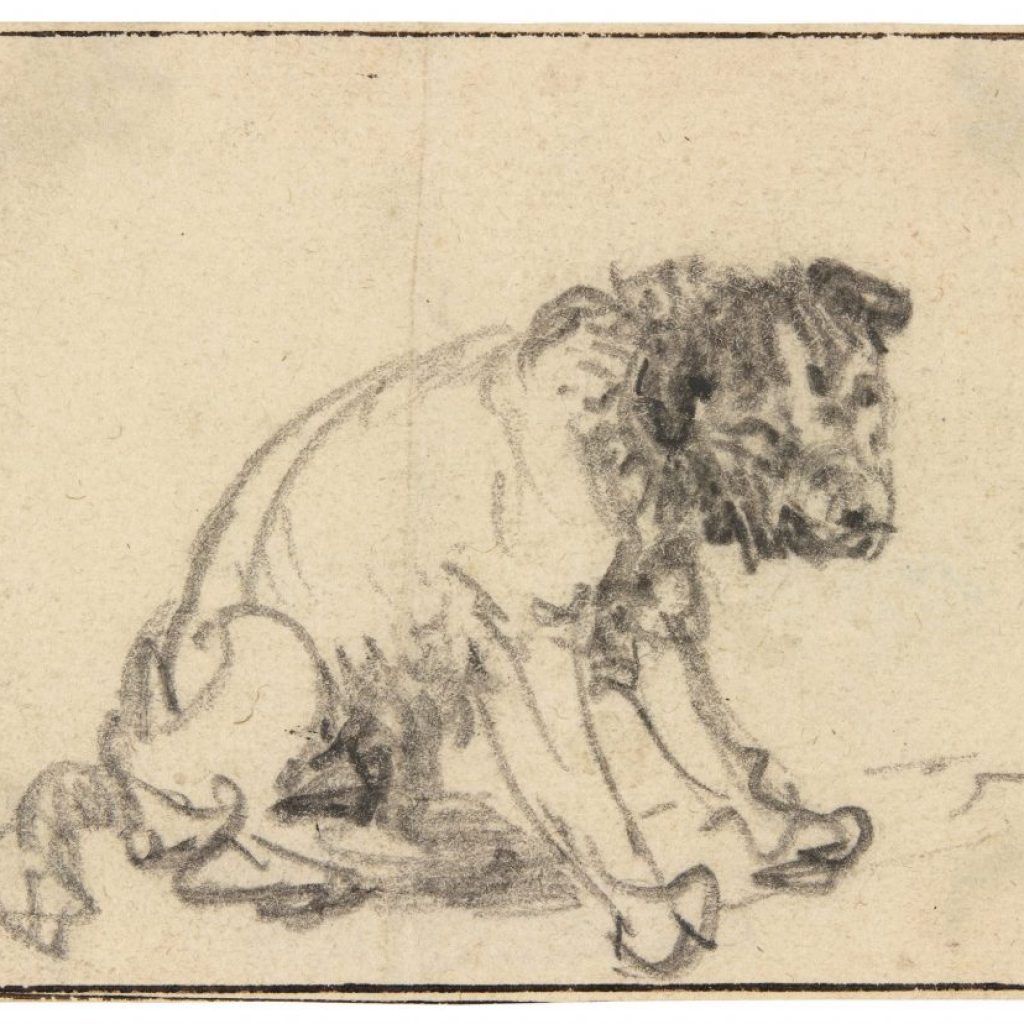
A chalk drawing credited to a German painter for more than two centuries has been identified as a work by Dutch master Rembrandt van Rijn. For the past 250 years, the Herzog Anton Ulrich Museum in Braunschweig, Germany attributed "the Braunschweig terrier," a chalk drawing of a dog, to German animal painter Johann Melchior Roos. […]
The post Museum Discovers Drawing is Actually by Rembrandt appeared first on Park West Gallery.
]]>
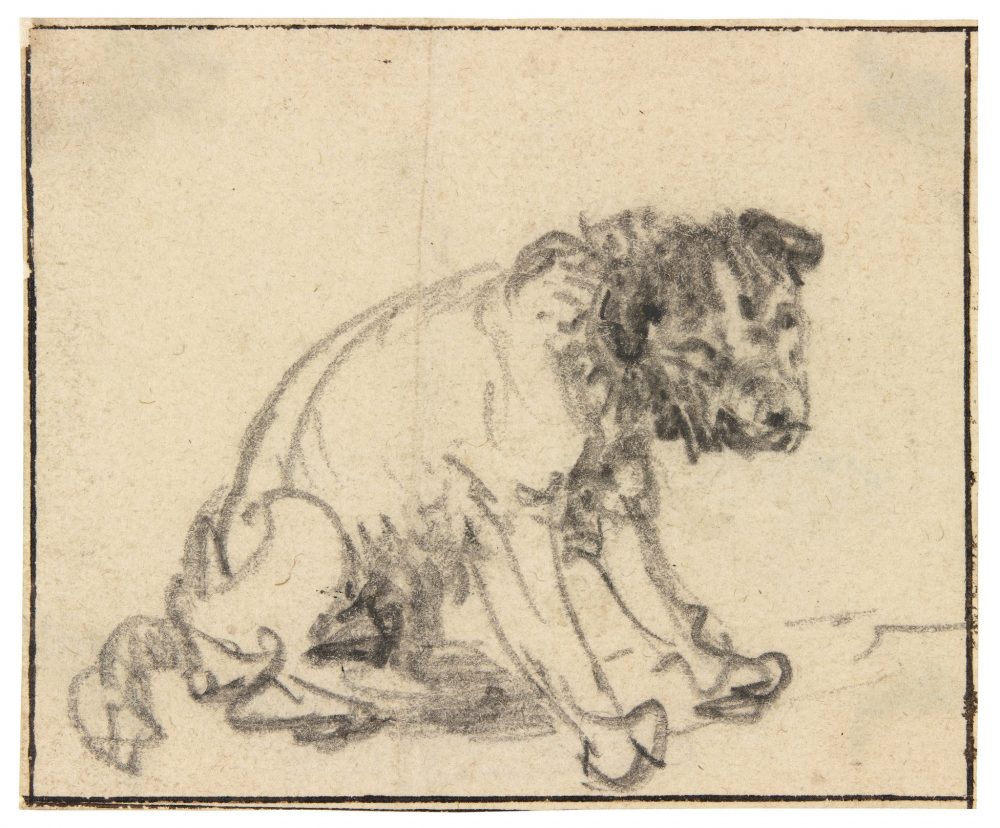
Rembrandt Harmensz. Van Rijn (1606-1669), study of a sitting dog, around 1637, black chalk, 82 x 99 mm, © C. Cordes, Herzog Anton Ulrich Museum Braunschweig, Kupferstichkabinett
A chalk drawing credited to a German painter for more than two centuries has been identified as a work by Dutch master Rembrandt van Rijn.
For the past 250 years, the Herzog Anton Ulrich Museum in Braunschweig, Germany attributed "the Braunschweig terrier," a chalk drawing of a dog, to German animal painter Johann Melchior Roos. The drawing has been a part of the museum's collection since 1770 and is said to have originated in 1637.
Professor Thomas Doring, the museum's curator of prints and drawings, came across the drawing two years ago while cataloging the museum's 10,000 drawings for a digital archive.
"The boldness of the strokes, the variations in the shading from very gentle to quite violent and the expressive gaze [of the dog] — these are very typical idiosyncrasies of Rembrandt's work," Doring told CNN.
Doring showed the drawing to three of the top scholars of Rembrandt's drawings. All expressed confidence it was created by Rembrandt.
"It's extremely rare for all of the experts in a field to agree on an issue as controversial as this," said Doring.
Rembrandt's previous animal studies include drawings of elephants and a horse-drawn carriage. A statement from the museum points out the dog in the drawing bears resemblance to the dog depicted in Rembrandt's masterpiece, "The Night Watch."
The museum will display the properly-attributed artwork during an exhibition that opens April 6.
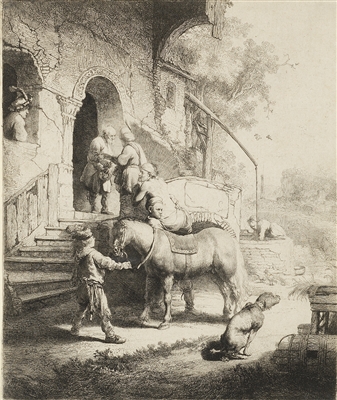
"The Good Samaritan" (1633), Rembrandt van Rijn
This is not the first time in recent history a work of art has been properly identified as a Rembrandt. In 2015, the Mauritshuis museum declared a painting, "Saul and David," was painted by Rembrandt and not one of his pupils.
Rembrandt's mastery of painting, printmaking and draftsmanship place him as one of the greatest visual artists in history. Contact Park West Gallery at (800) 521-9654 ext. 4 or sales@parkwestgallery.com for information on how to collect artwork by Rembrandt.
The post Museum Discovers Drawing is Actually by Rembrandt appeared first on Park West Gallery.
]]>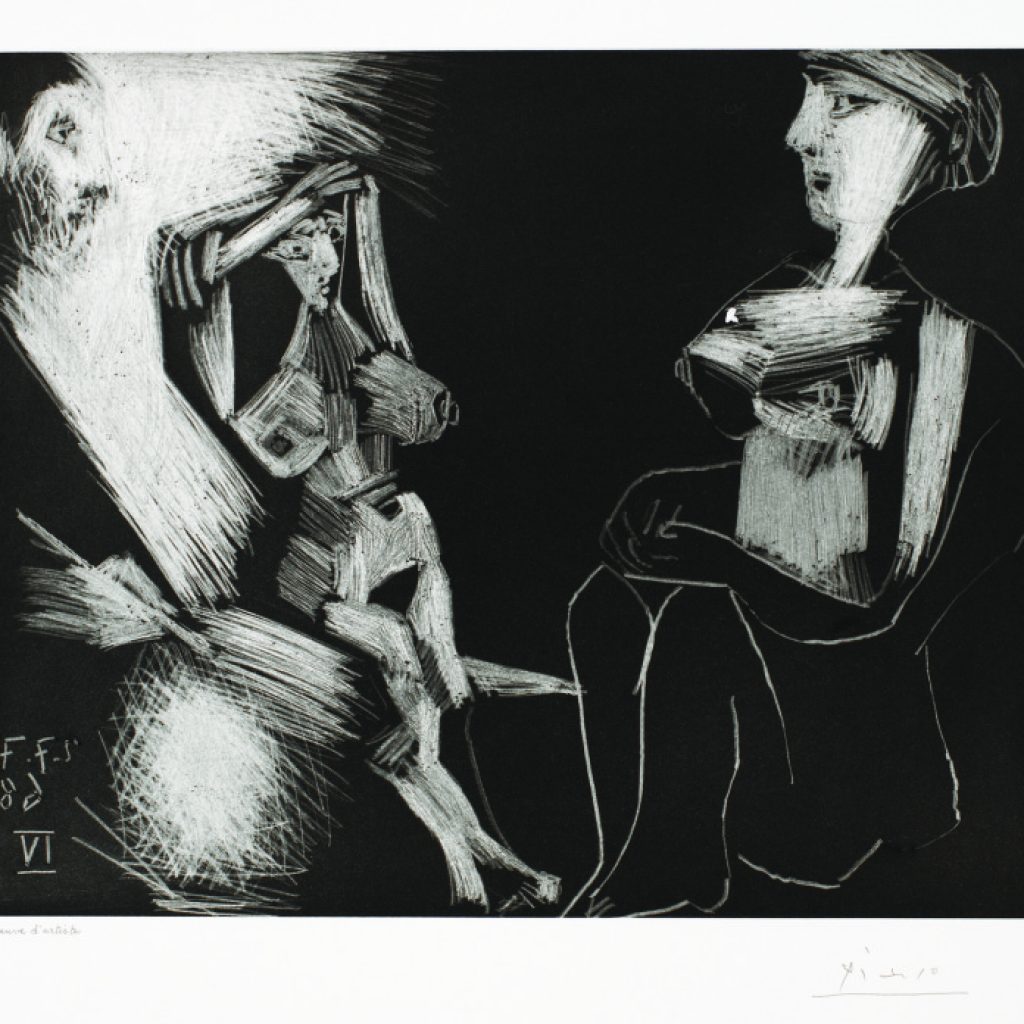
How does one credit a great artist? Ascribing artistic greatness is no simple task. The definition itself is relative to the time and place of an artwork's creation. Undoubtedly, it would be difficult to objectively compare the artistic triumphs of potters in ancient Greece, the delicate veneer of chapel frescoes or to the elated impressions of […]
The post How the Masters Changed Art History appeared first on Park West Gallery.
]]>
How does one credit a great artist?
Ascribing artistic greatness is no simple task. The definition itself is relative to the time and place of an artwork's creation. Undoubtedly, it would be difficult to objectively compare the artistic triumphs of potters in ancient Greece, the delicate veneer of chapel frescoes or to the elated impressions of Paris' Golden Age.
Even so, the history of art hinges on certain achievements, preserving them as relics of humankind, revealing their ubiquity across cultures, and lastly, casting their creators as those at the pinnacle of intellectual and creative achievement known as the Masters.
Learn more about some of the greatest figures in artistic achievement with these five Master artists.
Rembrandt van Rijn (1606 – 1669)
Rembrandt van Rijn is widely considered to be the great Master of the Baroque Age. The Dutch visionary possessed a deep technical understanding of artistic practices as well as a devoted empathy toward his subjects, encouraging an incredibly prolific and versatile career across many media.
Through his art, Rembrandt endowed ordinary laymen with imperfect nobility. Standing as a testament to the human condition, the artist's portraits cast a comprehensive vignette on the episodic triumphs and burdens of mankind. Unlike his contemporaries, Rembrandt was capable of capturing the brutal physical truth of a subject, while also using light and chiaroscuro as a means to illustrate corporeal transcendence.
Though commonly revered for his portraiture, Rembrandt remains one of history's most innovative and influential printmakers. The artist created more than 300 etchings during his lifetime depicting biblical scenes, landscapes and self-portraits. Rembrandt's etchings continue to astonish viewers with their virtuosity, subtle illumination and dramatic presence.
"Descent From Cross: By Torchlight" (1654), Rembrandt van Rijn.
How Rembrandt van Rijn Changed Art History: Advanced the artistic conception of light and shadow, also known as chiaroscuro; instituted the notion that portraiture could be psychologically revealing; innovated the medium of etching.
 Francisco Goya: (1746-1828)
Francisco Goya: (1746-1828)
Famed Spanish court painter Francisco Goya is historically regarded to be the catalyst of Modernism, creating artwork defined by unapologetic realism, somber detail and social consequence. Goya uncompromisingly captured the horrors of war and the darker side of human nature, inspiring later generations of artists who sought truth in realism. Goya's commentary, although oftentimes unflinchingly bleak, initiated the notion of the artist at the "front guard" of socio-political strife.
Goya gained artistic acclaim through his appointment to the esteemed Royal Academy of San Fernando in Madrid in 1780. He later became a commissioned favorite amongst Spanish and Napoleonic rulers. In 1786, Goya became the official painter of King Charles III and was named court painter to his successor, Charles IV, in 1789.
Aside from being an adept painter, Goya was also a prolific printmaker. Using the medium of etching, he captured the horrifying atrocities of the French and Spanish conflict, Spanish customs such as bullfighting, and critiqued the nature of man. The series "Los Desastres de la Guerra," "Tauromaquia," "Los Caprichos," and "Los Proverbios" brutally demonstrate Goya's talents in the medium.
"Aguarda que te Unten" (1799), Francisco Goya.
How Francisco Goya Changed Art History: Garnered the notion that art could document and react to socio-political injustices; enacted a dramatic shift in audience where art was no longer entrusted solely to the ruling class; called for a shift in subject matter toward darker studies.
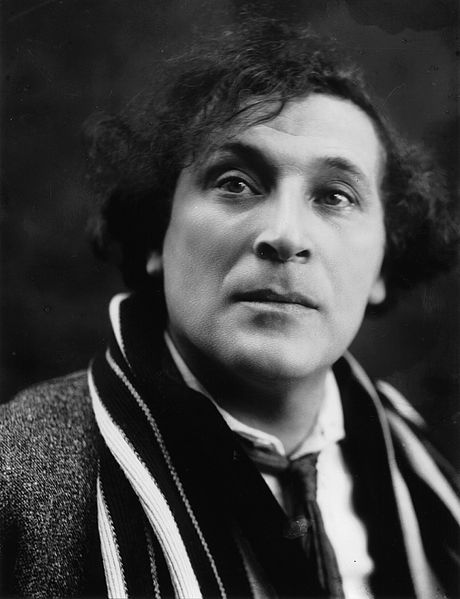 Marc Chagall: (1887-1985)
Marc Chagall: (1887-1985)
Widely considered to be lithography's innovator, the Russian-born artist, Marc Chagall, revolutionized and redefined the bounds of color lithography. Chagall's efforts proved that printmaking could rival the artistic achievements found in paint, not only in its technical refinement but also in its emotional charge.
Chagall created his own style – equally poignant and poetic – employing techniques characterized by Cubism, Fauvism, Symbolism, and Surrealism, while abiding by his own unique expressions.
Renowned art publisher, Ambroise Vollard commissioned Chagall to illustrate Nicolai Gogol's "Les Ames Mortes", Jean de la Fontaine's "Fables," and an extensive illustration of the Bible, considered to be one of Chagall's most evocative artistic achievements.
"Springtime on the Meadow" (1961), Marc Chagall.
How Marc Chagall Changed Art History: Rejected the tenets of the modern art movement and instead appealed to narrative and allegory; reawakened art's poetic capabilities.
 Pablo Picasso (1881-1973)
Pablo Picasso (1881-1973)
No artist changed the course of art history with such velocity as Pablo Picasso. Initially drawing inspiration from the foreboding facades of Iberian sculpture and the drastic color contrasts of Paul Cézanne, Picasso created a style that was simultaneously jarring, upsetting, romantic, poignant and revolutionary.
Unquestionably one of the greatest and most influential artists of the 20th century, Picasso lived several lives artistically. Picasso co-founded the Cubist movement alongside George Braque, invented constructed sculpture, co-invented the widespread use of collage, and helped foster a wide variety of styles through his successors.
Picasso was exceptionally prolific throughout his long life. The artist's immense body of work estimates approximately 1,885 paintings, 1,228 sculptures, 2,880 ceramics, and roughly 12,000 drawings, many thousands of prints and numerous tapestries and rugs.
"Homme avec Deux Femmes Nues" (1968), Pablo Picasso.
How Pablo Picasso Changed Art History: Helped develop and explore dozens of artistic theories, techniques and ideas; deconstructed conventions of perspective that dominated painting for centuries; revolutionized attitudes toward the depiction of form, dimension and space.
Joan Miró: (1893-1983)
The Spanish Surrealist Joan Miró stood at the cusp of Modernism's jolt in the early 20th century. Miró, alongside Salvador Dali, Max Ernst, Yves Tanguy, and Andre Breton – the founder of the Surrealist movement – turned the world inwards to explore its most fundamental parts. Seeking sanctuary from the palls of the world-at-large, the Surrealists enlisted a philosophic study of the world on a more granular, microscopic level, where biology created a unique psychological universe for every individual.
In favor of upsetting the visual elements of established painting, Miró found inspiration in Catalan folk art, the art of children, and the subconscious mind, thereby developing a new kind of pictorial space. In Miró's imagery, he abandoned traditional precepts of representation for an exploration beyond the material realm. Often working with a limited palette of primary colors, Miró was one of the first artists to suggest that color could be a subject in itself.
Miró's talents spanned all mediums as he exhibited mastery in painting, lithography, etching, ceramics, sculpture, and in the creation of larger-than-life murals.
"Lezard aux Plumes II (M 821)" (1971), Joan Miró.
How Joan Miró Changed Art History: Explored the visual boundaries of psychoanalytic study; created an entirely non-representational artistic style; initiated the notion that color possessed narrative qualities.
Park West Gallery offers the unique opportunity to collect limited edition artworks from your favorite Master artists, such as Picasso, Miró, Rembrandt, Chagall and Goya.
Contact our gallery consultants at (800) 521-9654 ext. 4 or sales@parkwestgallery.com to learn more about collecting art from the Masters.
The post How the Masters Changed Art History appeared first on Park West Gallery.
]]>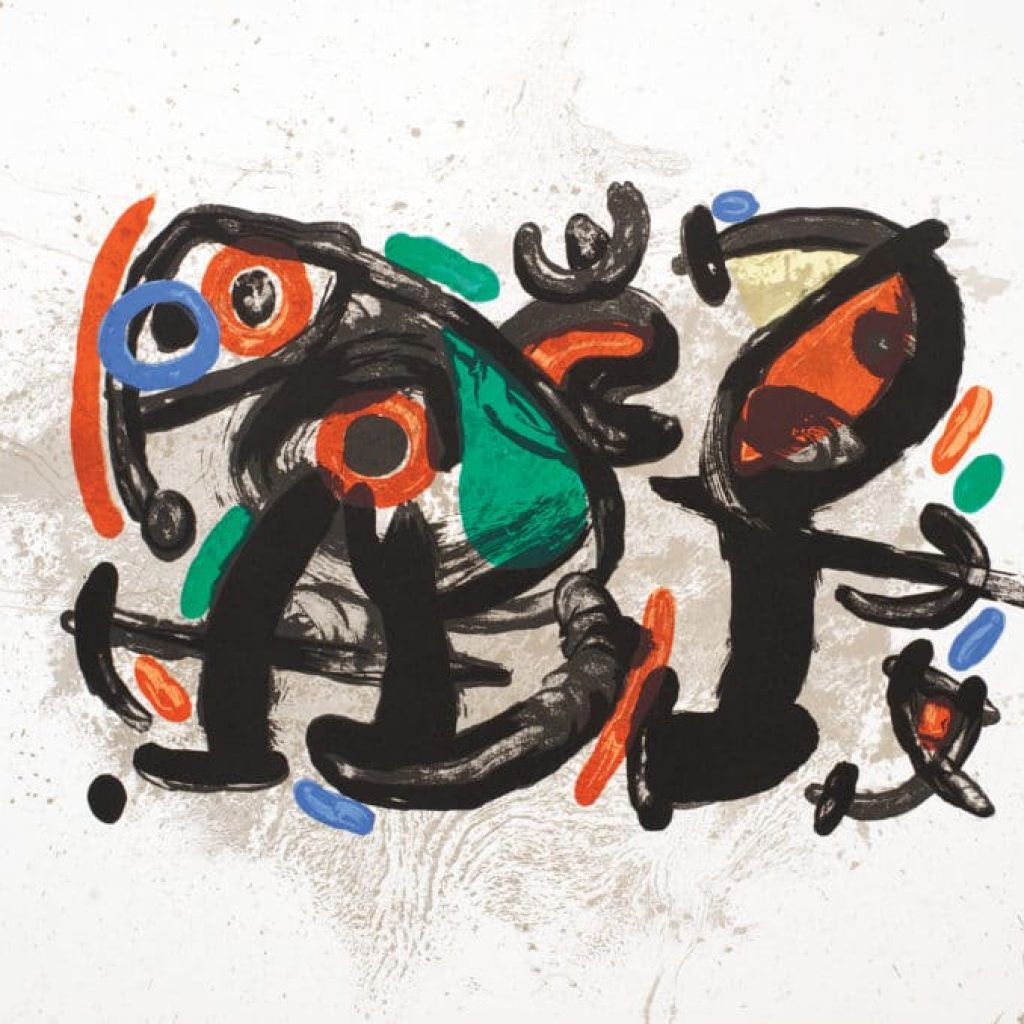
Have you ever been in a museum admiring artwork by a master artist and thought, "What would it be like to own this? How would it look in my living room or study?" Owning artwork by an old or contemporary master is a privilege and joy that cannot be compared. Collectors can experience this joy […]
The post Own a Piece of Art History with the Holiday Sale appeared first on Park West Gallery.
]]>
Have you ever been in a museum admiring artwork by a master artist and thought, "What would it be like to own this? How would it look in my living room or study?"
Owning artwork by an old or contemporary master is a privilege and joy that cannot be compared. Collectors can experience this joy for themselves with Park West Gallery's Holiday Sale, featuring works by some of history's greatest artists.
Rembrandt van Rijn (1606-1669)
"Jan Antonides van der Linden, Physician" (1665), Rembrandt van Rijn. B., Holl. 264; BB. 65-1
Rembrandt is considered one of the greatest visual artists in the history of art. The artistic genius is known for his mastery of painting, printmaking and draftsmanship. During his lifetime, the Dutch artist earned the reputation of being the greatest etcher in history.
Rembrandt's "Jan Antonides van der Linden, Physician" is the artist's last-known etching, created four years before his death. The image was intended to be used for the frontispiece (an illustration facing the title page of a book) of an edition of writings by Hippocrates. The publisher rejected it, as they required an engraving instead of an etching.
Francisco Goya (1773-1812)
"Se aprovechan" (They make use of them), (1810-1820), Francisco Goya. Delteil 135; Harris 136
Goya is classified as the last of the Old Masters – skilled artists who worked in Europe before 1800 – and the first of the modern artists. The Spanish romantic painter and printmaker is considered the most important Spanish artist of the late 18th and early 19th centuries. He worked as a court painter for Spanish royalty.
Goya suffered from an unknown disease in 1792 that left him deaf. Following this, his artwork became bleak and dark. This theme carried into his collection of 82 prints, "The Disasters of War." The collection represents his visualization of, and protests against, the atrocities of war in the early 1800s. "Se aprovechan" (They Make Use of Them) shows one such horror – soldiers stripping the dead of clothing.
Pablo Picasso (1881-1973)
"Faune Devoilant une Femme" by Pablo Picasso.
Picasso is one of the most renowned artists in the world. The Spanish artist is regarded as one of the most influential artists of the 20th century, having co-founded important movements like Cubism and also the medium of collage, and contributing to the development of mediums such as painting, sculpting and printmaking.
"Faune Devoilant une Femme" (The Faun Unveiling a Woman) is part of the Vollard Suite, a collection of 100 etchings by Picasso. This etching is the largest and one of the most celebrated of the Vollard works. The imagery is based on Rembrandt's etching, "Jupiter and Antiope," which was inspired by the myth about the Roman god Jupiter's seduction of a princess. The artwork is said to be Picasso's acknowledgement of the end of his passionate relationship with Marie-Thérèse Walter.
Marc Chagall (1887-1985)
"Femme de Cirque" (1960), Marc Chagall (after)
Chagall created artwork in nearly every format, and is a pioneer of modern art who revolutionized the medium of lithography. The Russian-French artist is counted as one of the most significant Jewish artists of the 20th century.
Park West Gallery's Holiday Sale features a colorful Chagall lithograph titled "Femme de Cirque" (Circus Woman). Chagall once wrote: "Circus! A magical word, a centuries old entertainment parading before us, in which a tear, a smile, a gesture of arm or leg takes on the quality of great art." This artwork depicts that sentiment by featuring a female acrobat holding her balance atop a bucking goat.
"Celui qui dit les choses sans rien dire" (Those who say things without saying), (1975-76), Marc Chagall. Cr. 99
The second work is an etching, titled, "Celui qui dit les choses sans rien dire" (Those who say things without saying), originating from Chagall's suite of 25 images that visualize the words of French poet Louis Aragon, a founding member of the Surrealist movement.
Joan Miró (1893-1983)
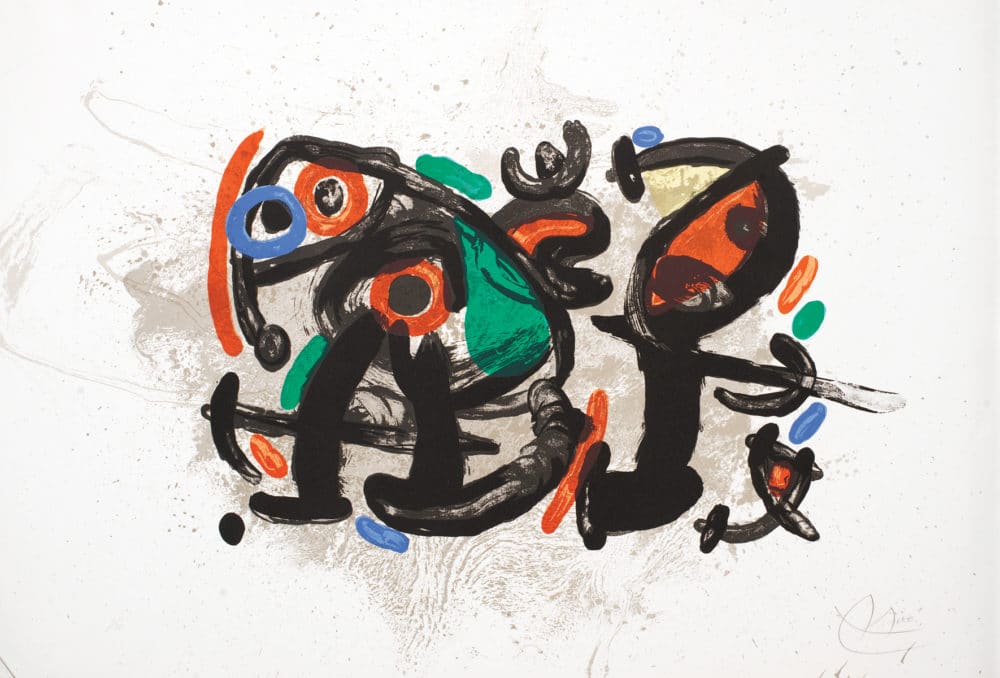
"Ronde Nuit" (Night Watch), (1970), Joan Miro. M. 672; C. books 134
Andre Breton, a founder of Surrealism, called Miró "the most Surrealist of us all." Miró earned international acclaim for his re-creation of the childlike mindset in his art. The Spanish painter, sculptor and ceramicist developed his style based on Catalan folk art, using organic forms, flattened planes and sharp lines.
The above color lithograph, "Ronde Nuit" (Night Watch), is taken from a catalog for an exposition of Miró sculptures. The artwork may be referencing Rembrandt's famous painting, "The Night Watch." With its abstract forms, one can find multiple interpretations of "Rone Nuit." For example, the black and red shape on the right could be a night watchman armed with a crossbow.
Marcel Mouly (1918-2008)
"Le Compotier Rouge" (1978), Marcel Mouly
The boldly-colored, semi-abstract art of French artist Mouly is found in the permanent collections of over 20 museums, including the Museum of Modern Art in Paris. He studied with masters of modern art, including Picasso and Chagall, earning a reputation as one of the most important artists of the late 20th and early 21st centuries.
Park West Gallery offers the chance to own a unique oil painting by Mouly, "Le Compotier Rouge" (translated literally to be "The Red Fruit Dish"). When examining the painting, it is apparent Mouly was deeply influenced by Picasso's Cubism and Henri Matisse's Fauvism. Mouly's connection to the leaders of modern art is even more apparent when one discovers that his art was shown alongside art by Matisse in Paris in 1945.
Contact our gallery consultants at (800) 521-9654 ext. 4 or sales@parkwestgallery.com to learn more about collecting art from the masters.
The post Own a Piece of Art History with the Holiday Sale appeared first on Park West Gallery.
]]>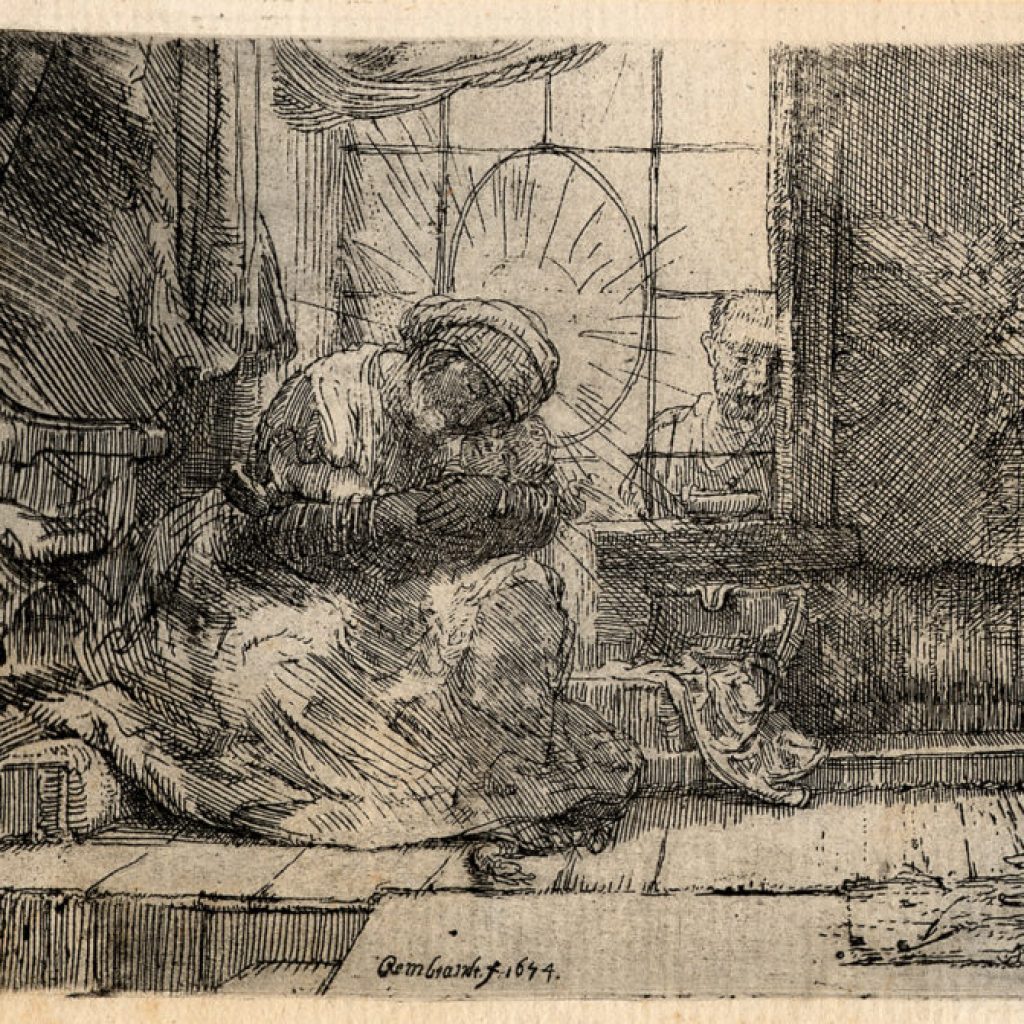
For the first time in history, the works of master Dutch painter and etcher Rembrandt van Rijn are being displayed at the Vatican. The exhibition, "Rembrandt at the Vatican: Images from Heaven and Earth," is open to the public and will run until February 26, 2017 at the Vatican Museums. The exhibition contains 53 of […]
The post Vatican Holds Inaugural Display of Rembrandt Art appeared first on Park West Gallery.
]]>
"Angel Appearing to the Shepherds" (1634), Rembrandt Van Rijn. B., Holl. 44; H. 120; NH. 125.
For the first time in history, the works of master Dutch painter and etcher Rembrandt van Rijn are being displayed at the Vatican.
The exhibition, "Rembrandt at the Vatican: Images from Heaven and Earth," is open to the public and will run until February 26, 2017 at the Vatican Museums. The exhibition contains 53 of Rembrandt's etchings and two of the master's paintings.
Rembrandt's mastery of painting, printmaking and draftsmanship have placed him as one of the greatest visual artists in history. The Dutch artist turned to the Bible as a source of inspiration, especially during the 1650s. The son of a Protestant father and Catholic mother, Rembrandt's works depict imagery containing elements from both Christian denominations, such as in the etchings "The Three Crosses" and "Virgin and Child with a Cat."

"The Virgin and Child with the Cat" (1654), Rembrandt van Rijn. B., Holl 63; H. 275; BB 54-C.
In a preface to the exhibition, Antonio Paolucci, Director of the Vatican Museums, notes that Rembrandt's etchings have been in Rome at the Scuderie del Quirinale in 2008, but this exhibition places him among the other master artists in the Vatican.
"He is now returning, returning to the Papal Museum in the heart of Roman Catholicism, alongside masterpieces of classical statuary, alongside Michelangelo and Raphael," Paolucci writes. "We could not imagine a finer tribute to Rembrandt in Rome."
"Descent from Cross: By Torchlight" (1654), Rembrandt van Rijn. B., Holl. 83; BB. 54-G
The exhibition opens roughly a month after His Holiness Pope Francis visited Sweden to mark the 500th anniversary of the Protestant Reformation. The exhibition is organized by the Pontifical Council for Promoting Christian Unity and the Swedish Embassy with the etchings loaned from the Zorn Museum in Mora, Sweden.
Park West Gallery is a leading source for art lovers wishing to elevate their collections with etchings by Rembrandt, including the images seen above. Contact our gallery consultants at (800) 521-9654 ext. 4 or sales@parkwestgallery.com for more information.
The post Vatican Holds Inaugural Display of Rembrandt Art appeared first on Park West Gallery.
]]>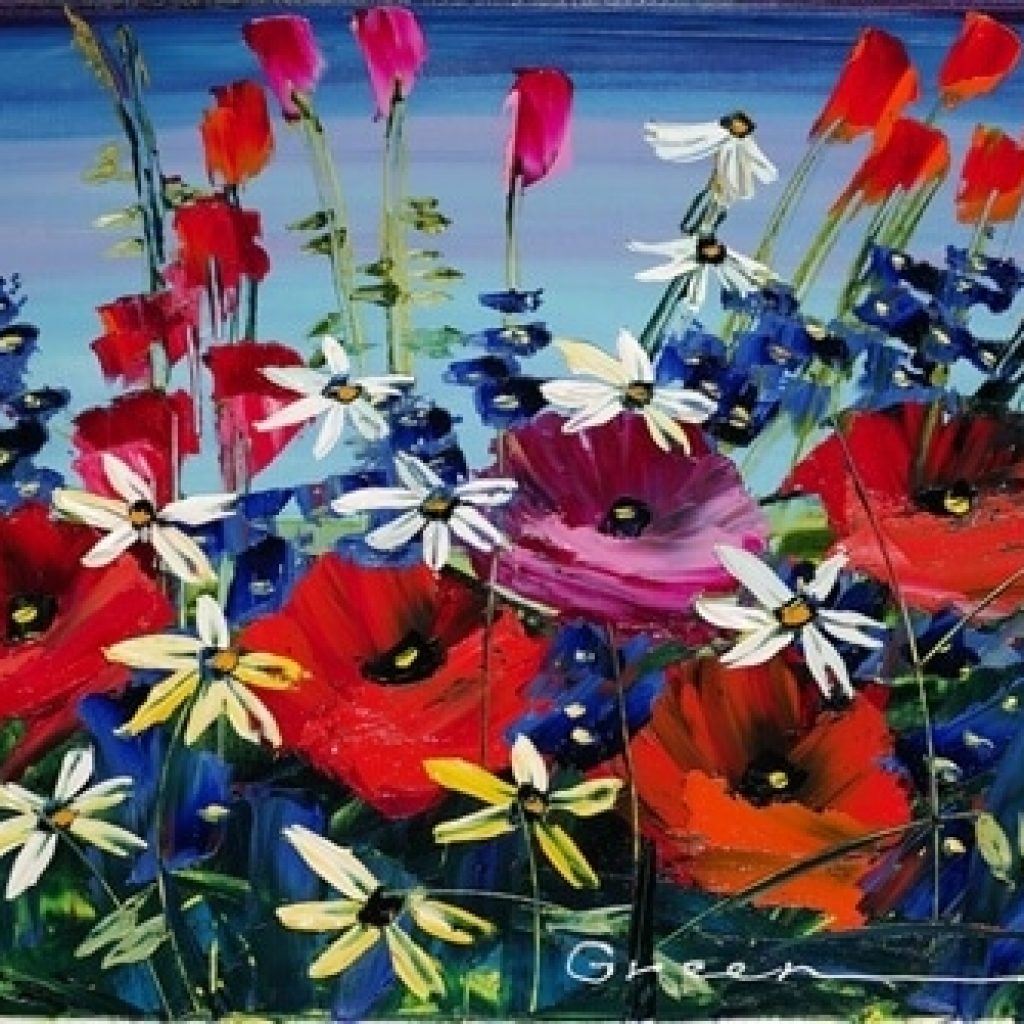
We all know the saying – beauty is in the eye of the beholder. Art, too, is subjectively rooted, oftentimes lending itself to strong attitudes to a favorite art medium. To put it simply, art attracts, engages and moves individuals in different ways. At Park West Gallery, we embrace and encourage a diverse scope of […]
The post What Your Favorite Art Medium Says About You appeared first on Park West Gallery.
]]>
We all know the saying – beauty is in the eye of the beholder. Art, too, is subjectively rooted, oftentimes lending itself to strong attitudes to a favorite art medium. To put it simply, art attracts, engages and moves individuals in different ways.
At Park West Gallery, we embrace and encourage a diverse scope of work from our family of artists, and are further enlivened by the myriad of stories, experiences, and viewpoints collectors around the globe share with us.
If there is one thing Park West Gallery advocates, it's this: collect what you love.
Read on to discover what your favorite art medium and technique might say about you.
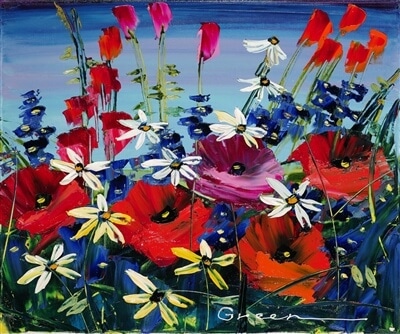
"Take Me Home" (2016), Maya Green
Favorite Art Medium: Oil Paint
Classic as visual culture yourself, you're steadfast, relentless, dignified, and elegant to the eye. Don't let this guise of tradition fool, however; capable of capturing even the most nuanced details, nothing escapes you; shadowed amidst light and dark, you perpetually walk the line between euphoria and melancholy.
Artists you'll love: Maya Green, Csaba Markus, Michael Milkin
"Waiting for Suzanne" (2006), Itzchak Tarkay
Favorite Art Medium: Watercolor
Sought after and imitated across cultures, you're often the subject of flattery and imitation, and not without reason. Fluid as ancient rivers themselves, you're seductive, difficult to delineate, and rarely walk the same path twice. You falter in your resoluteness, however, often spreading yourself too thin and caving to your whims.
Artists you'll love: Itzchak Tarkay, Anatole Krasnyansky, Duaiv
"Quiet Lake Ver. I" (2016), Peter Max
Favorite Art Medium: Acrylic Paint
Loud and rambunctious, attention-seeking is your game, and you're the master of it. You're always one step ahead of the curve, but the step is never your own, as you often run with a cosmopolitan crowd. Celebrity aside, you possess a striking sense of wit and intellectual curiosity. Absurd, yet endearing, you can win over any room.
Artists you'll love: Peter Max, Simon Bull, Marko Mavrovich
"Sur la Table," Marcel Mouly
Favorite Art Medium: Lithography
A true innovator, you're intelligent and live to solve problems. You like routine, but aren't too overwhelmed when things don't turn out as planned. Rather, you find the beauty in messy situations. You're often conflicted internally, but you have a difficult time revealing your softer side, making you often seem calculated and harsh.
Artists you'll love: Marcel Mouly, Joan Miró, Marc Chagall
"Interior with Chagall" (2008), Fanch Leda
Favorite Art Medium: Serigraphy
Young and fresh, you undeniably possess qualities of approachability and likability. Your looks are striking, you're patient, precise, and sharp as a tack. This sharpness can reveal your more cunning side, however, and those close to you realize how difficult you truly are.
Artists you'll love: Fanch Ledan, Yaacov Agam, Erte
"Christ and the Woman of Samaria Among Ruins" (1634), Rembrandt Van Rijn
Favorite Art Medium: Etching
You're a masterpiece that hasn't been discovered yet. Your muted exterior, shy demeanor and knack for obsessive detail often leave you overlooked and misunderstood. While you may seem black and white, your imagination and creativity are second to none. You're able to think theoretically and your deeply-rooted sympathy marks a kind heart.
Artists you'll love: Pablo Picasso, Rembrandt van Rijn, Francisco Goya
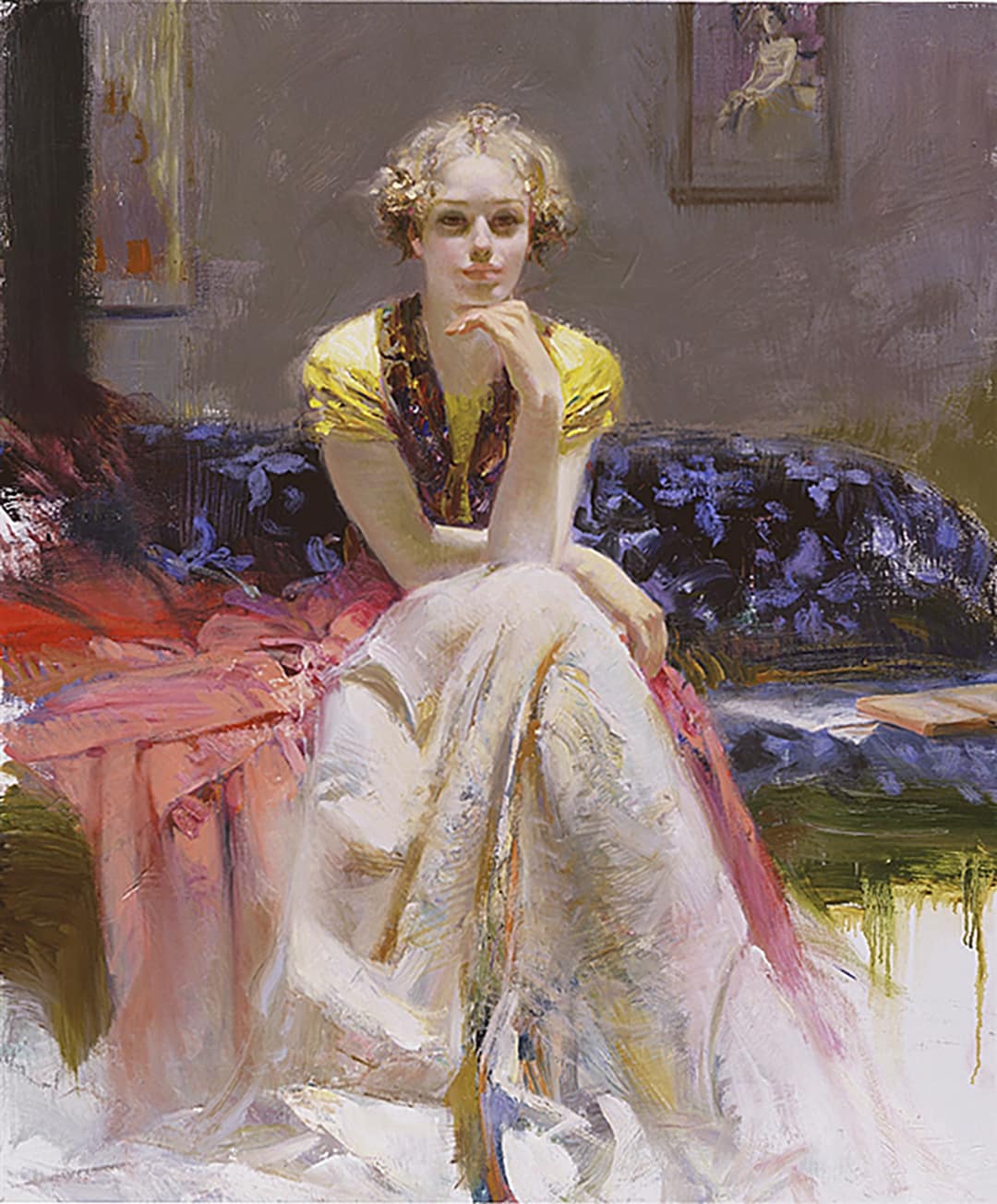
"Enchantment" (2009), Pin
Favorite Art Medium: Giclée
There is something real, refreshing and fundamentally cool about you. You like to take traditions of old and turn them into something modern. You have a keen eye for detail and get things done quickly and efficiently, but often become distracted by tiny flaws and are often too quick to judge others different than you.
Artists you'll love: Pino, Scott Jacobs, Michael Godard
"Escape to Guy's World" (2015), Guy Harvey
Favorite Art Medium: Dye Sublimation
Well-informed on what's au courant, you have your eye on the next big thing and are always ready for a good challenge. You're able to draw forth color in seemingly bleak situations, maintaining a positive attitude. You have a tendency to always be in a rush, and have a hard time staying on track.
Artists you'll love: Guy Harvey, Michael Cheval, Craig Tracy
To collect the artwork of the Park West artists, contact our gallery consultants at (866) 654-2882 ext. 4 or sales@parkwestgallery.com, or register for our weekly live online auction!
Related Articles:
- Test Your Knowledge of 14 Park West Artists With Our Quiz
-
Know Your Art – Mediums and Techniques
The post What Your Favorite Art Medium Says About You appeared first on Park West Gallery.
]]>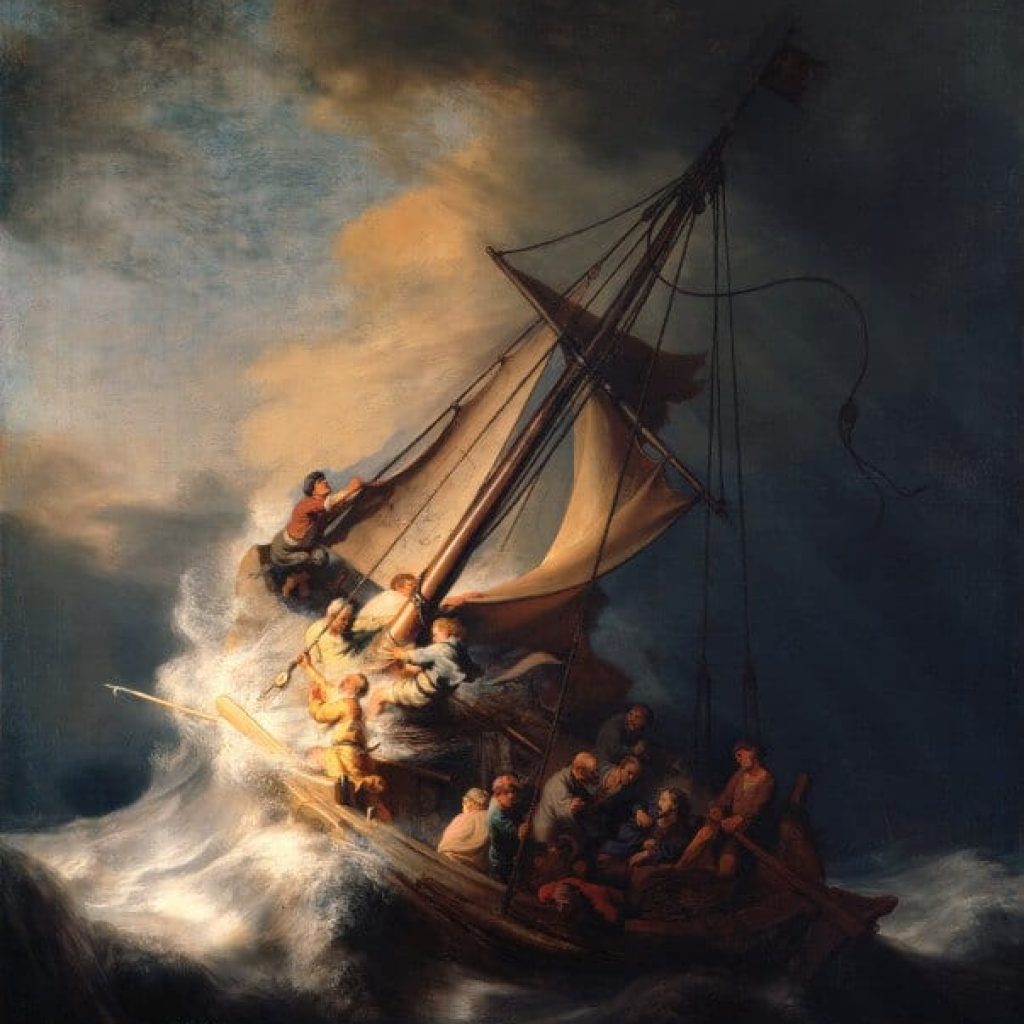
Although world-renowned artist Rembrandt van Rijn passed away almost 350 years ago, his art still lives on today. In fact, it's still revered; artists today are using modern techniques and technologies to emulate his style and works. In the past month, two separate projects related to emulating Rembrandt have been publicized. Ankur Patar is an […]
The post How technology is recreating Rembrandt art appeared first on Park West Gallery.
]]>

Rembrandt Christ in "The Storm on the Lake of Galilee" by Rembrandt – www.gardnermuseum.org. Picture licensed under Public Domain via Wikimedia Commons.
Although world-renowned artist Rembrandt van Rijn passed away almost 350 years ago, his art still lives on today. In fact, it's still revered; artists today are using modern techniques and technologies to emulate his style and works.
In the past month, two separate projects related to emulating Rembrandt have been publicized.
Ankur Patar is an award-winning illustrator who re-created Rembrandt's "Storm on the Sea of Galilee" using only stock images from the internet and the Adobe Stock software. He chose this work in particular because it's what was stolen from the Gardner Museum in Boston during the infamous 1990 heist. The goal of this artwork was not to put a twist on a legendary work of art, but to replicate the original. It was an off-kilter idea, and it turned out to be impressive.
In similar news, an innovative computer technology was revealed at this year's Cannes Lions Festival – an eight-day event in Cannes, France that promotes creativity – that can actually paint in the style of Rembrandt. Bas Korsten, an executive creative director at the J. Walter Thompson (JWT) advertising agency, was the mastermind behind this technology. Korsten was tasked with coming up with an idea that connects art and innovation for JWT's banking client, ING. His epiphany came when he read an article about scientists putting together a hypothetical image of what Jesus actually looked like using ancient skulls found in his native Israel. Korsten decided that historical artifacts were the key to his idea of creating a hybrid between art and science.
"I thought, if you could create something new out of historical material, why can't we take all the paintings from an old master and recreate something new out of that?" said Korsten in a story from AdWeek. "That's how the idea was born."
After teaming up with art historians, material researchers, data scientists and engineers from the likes of Microsoft and the Rembrandt House Museum, Korsten and his creative team began work on the new project.
The computers used to carry out this technology were fed copious amounts of data about Rembrandt's painting style and his nuances; they gathered information about his brush strokes (and their height), geometries and composition patterns. Using complicated algorithms and facial recognition techniques, the team was able to make the computer create a completely new work of art that follows Rembrandt's style to the 'T.' Possibly the most interesting part of the process is that the computer is able to create completely new features in the artwork while still keeping the style, essence and aesthetic of Rembrandt's art.
Rembrandt "look-alike" (photo courtesy of Adweek)
This technology was a smashing success at the festival, winning 16 Lions (awards), including an award for cyber and creative data. Despite criticism – art critics say the colors aren't the same as original Rembrandt works – the overall project was a success.
Giving computers the ability to be flexible could have a great influence on the future of art and the future of the world in general.
Park West Gallery's extensive collection features etchings by master artist Rembrandt van Rijn. Own a part of history with Park West's Rembrandt collection.
What do you think of these projects? Let us know in the comments below.
The post How technology is recreating Rembrandt art appeared first on Park West Gallery.
]]>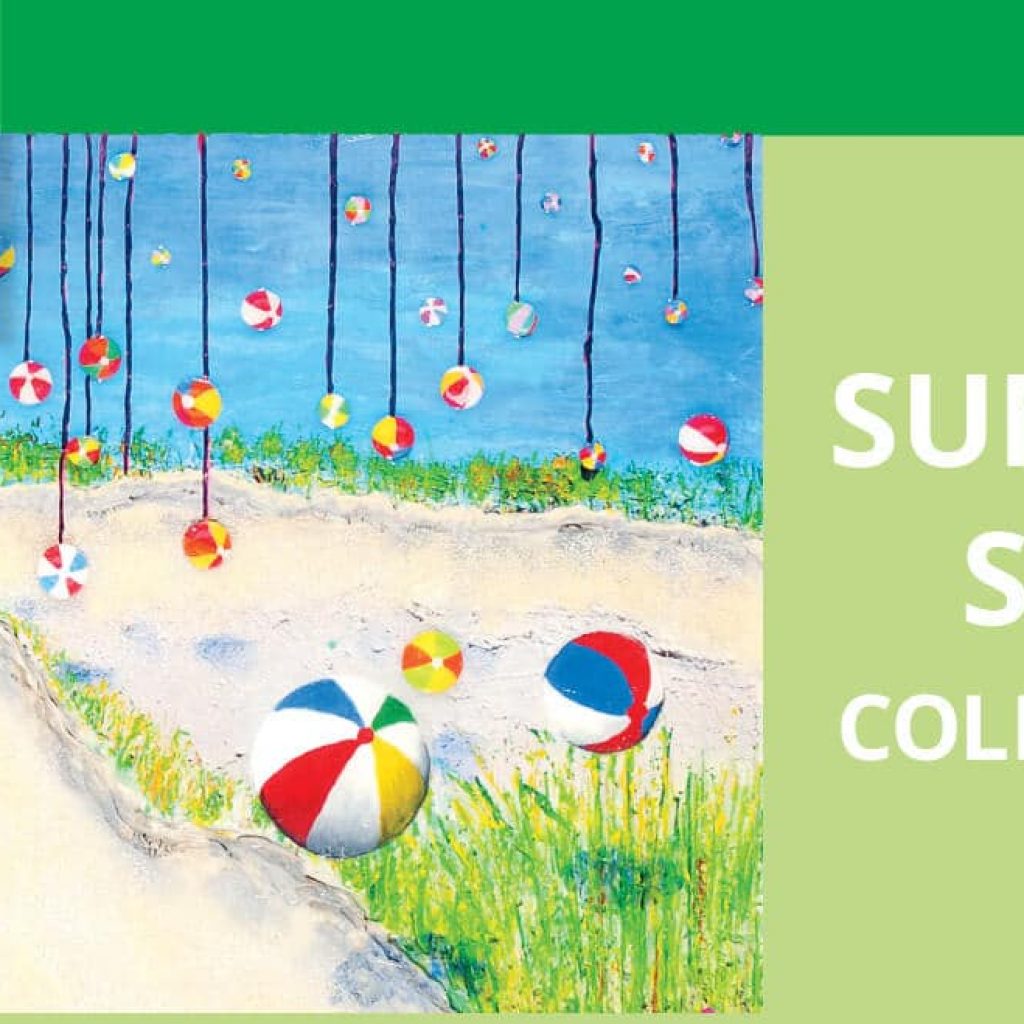
Take your collection to the next level with the Park West Gallery Summer Sale Collection, featuring 69 works of fine art and high-end jewelry. The artists available in this year's Summer Sale Collection reads like a who's who of the art world, featuring 31 of the greatest contemporary and old masters alike. These include Romero […]
The post Park West's Summer Sale of 2016 appeared first on Park West Gallery.
]]>
Take your collection to the next level with the Park West Gallery Summer Sale Collection, featuring 69 works of fine art and high-end jewelry.
The artists available in this year's Summer Sale Collection reads like a who's who of the art world, featuring 31 of the greatest contemporary and old masters alike. These include Romero Britto, Autumn de Forest, Csaba Markus, Itzchak Tarkay, Pino and Peter Max to name a few.
Some of Park West's newest artists are also available through this sale, including Jim Warren and Australian artists Graeme Stevenson and Donna Sharam. Don't miss this opportunity to collect works from old and modern masters as well, including Rembrandt, Picasso, Norman Rockwell and Joan Miró.
For collectors seeking mediums outside of canvas and paper, the collection offers a selection of works such as sculptures, ceramics and even tapestries from artists Linda Le Kinff, Lebo and Nano Lopez.
"Our summer collection is a fantastic compilation of select works designed with the season in mind, highlighted by several rare masterworks and some outstanding new artworks on metal," says Mike Snodgrass, gallery consultant. "We've had a lot of interest thus far, especially in these new releases. With summer half over and word about the sale continuing to spread, inquiries are already increasing and we expect many of these works to sell."
Art on metal is quickly becoming one of the most sought-after mediums due to its vivid colors and enhanced durability. The Summer Sale Collection provides the opportunity to collect art on metal from artists Guy Harvey and Michael Cheval. For a different type of metal art, be sure to check out the collection's works by Patrick Guyton and Chris DeRubeis.
Need a break from the summer heat? Visit Park West Gallery's exhibition space in Southfield, Michigan. In addition to the art in the Summer Sale Collection, guests can enjoy complimentary admission to view and collect artwork from a multitude of artists, including Yaacov Agam, Marcus Glenn, Simon Bull, Tim Yanke and Igor Medvedev.
Gallery consultants are available to assist with any questions at (800) 521-9654 ext. 4, (248) 354-2343 (international) or by email at sales@parkwestgallery.com.
Park West Gallery is located at 29469 Northwestern Highway, Southfield, Michigan. Gallery hours are Monday-Saturday 10 a.m. to 6 p.m. and Sundays 11 a.m. to 5 p.m.
The post Park West's Summer Sale of 2016 appeared first on Park West Gallery.
]]>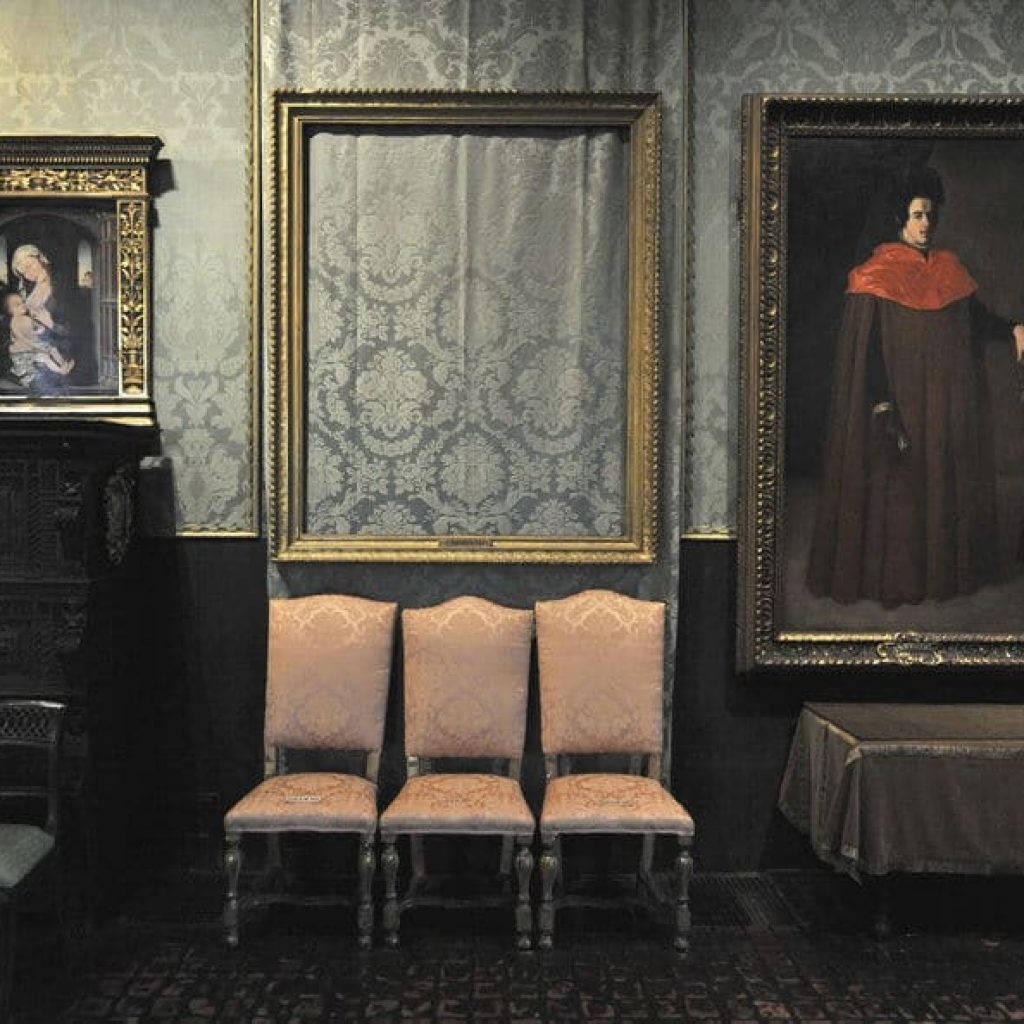
On March 18, 1990, the Isabella Stewart Gardner Museum in Boston was robbed of 13 works of art. As of March 2015, the stagnant investigation was ongoing. Over 16 years and many red herrings later, the FBI has found an encouraging lead. On March 18, 2013 — 23 years after the exact day of the […]
The post FBI investigates leads on Gardner Museum heist 26 years later appeared first on Park West Gallery.
]]>
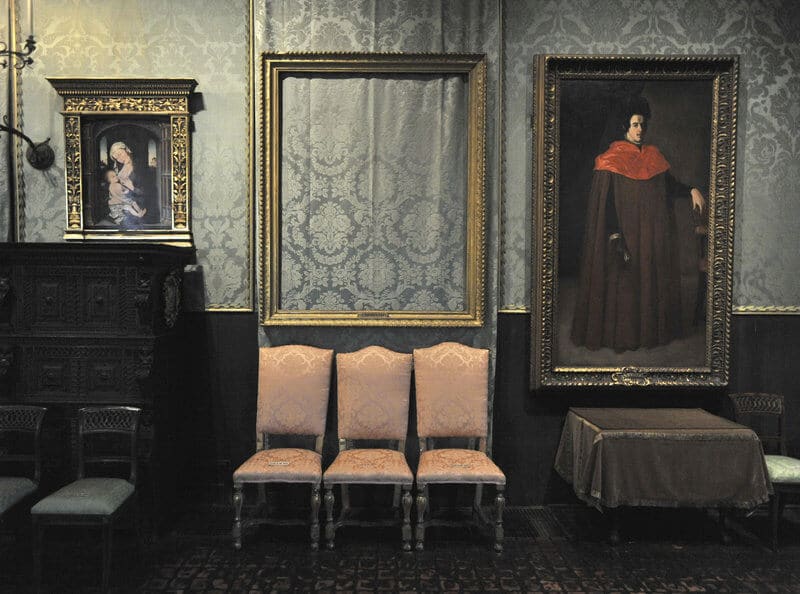
An empty frame sits where Rembrandt's "The Storm on the Sea of Galilee" hung until it was stolen in 1990. (Josh Reynolds / AP)
On March 18, 1990, the Isabella Stewart Gardner Museum in Boston was robbed of 13 works of art. As of March 2015, the stagnant investigation was ongoing. Over 16 years and many red herrings later, the FBI has found an encouraging lead.
On March 18, 2013 — 23 years after the exact day of the heist — the FBI announced that they had information on the crime. The art had been transferred to Philadelphia by way of Connecticut, but the FBI was still unable to locate it. Federal investigators announced they knew the identities of the perpetrators, but did not provide any further information.
Authorities arrived May 1, 2016 at the Manchester, Connecticut home of Robert Gentile, 79, who is believed to be affiliated with the Philadelphia Mafia, with a search warrant for the $500 million worth of lost art. Gentile failed a lie detector test in 2012 when asked about the whereabouts of the art; that is what gave detectives a reason to believe he may have been involved in committing the crime.
Gentile was not present at the house during the search. In 2015, he was convicted of various gun and drug related charges and is currently serving a two-and-a-half year sentence in federal prison. In the past, Gentile vehemently denied any connection to the robbery.
"He laughed and he couldn't believe they were there, that they were at his house again," said Rome McGuigan, Gentile's lawyer, in an interview with ABC News, "He said, this is a quote, 'They ain't gonna find nuttin.'"
According to the Gardner Museum website, the stolen artworks are as follows: Rembrandt's "Storm on the Sea of Galilee" (1633), "A Lady and Gentleman in Black" (1633) and "Self Portrait" (1634); Jan Vermeer's "The Concert" (1658 – 1660); Govaert Flinck's "Landscape with an Obelisk" (1638); five Edgar Degas works on paper; and Edouard Manet's "Chez Tortoni "(1878 – 1880). Also stolen were a Chinese vase and a finial from the top of a Napoleonic silk flag.
The FBI is offering a $5 million reward for the return of the artwork in good condition. There is no word yet on whether investigators found anything from their search.
The post FBI investigates leads on Gardner Museum heist 26 years later appeared first on Park West Gallery.
]]>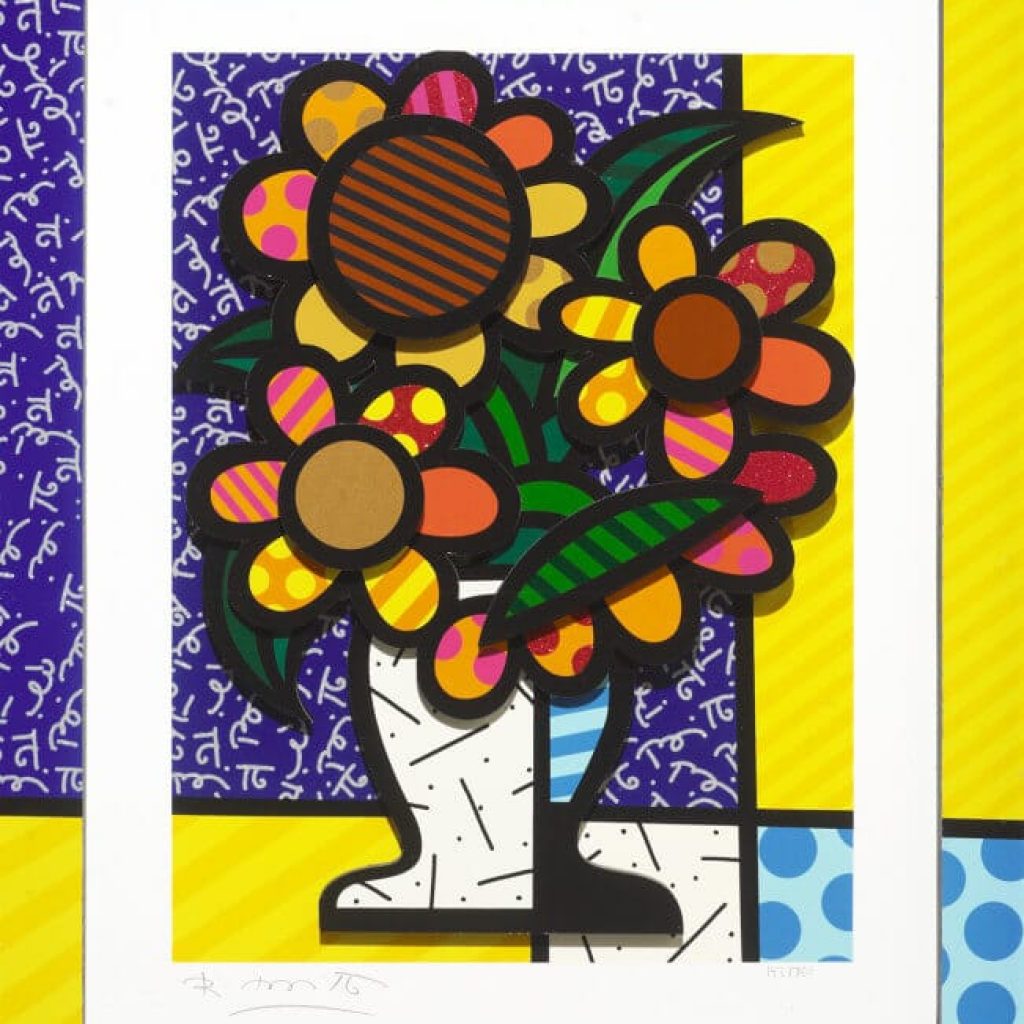
Mother's Day is all about celebrating moms and motherhood, whether it is your own mom, a sister, daughter, grandmother, godmother, aunt or other special women in your life. At Park West Gallery, we have put together a small collection of art that celebrates the many aspects of motherhood. Park West's expansive collection also features stunning jewelry […]
The post Enjoy our Mother's Day Collection appeared first on Park West Gallery.
]]>
"Sunflower" (2015), Romero Britto
Mother's Day is all about celebrating moms and motherhood, whether it is your own mom, a sister, daughter, grandmother, godmother, aunt or other special women in your life. At Park West Gallery, we have put together a small collection of art that celebrates the many aspects of motherhood.
Park West's expansive collection also features stunning jewelry that makes perfect gifts, and in case your mom is an animation fan, Park West's collection includes animation art.
Contact our gallery consultants at 800-521-9654 ext. 4 or sales@parkwestgallery.com if you're interested in acquiring any of these works.
Click on the images for larger versions.
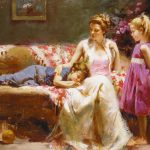
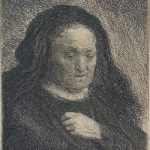
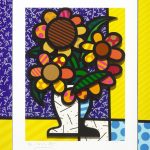
The post Enjoy our Mother's Day Collection appeared first on Park West Gallery.
]]>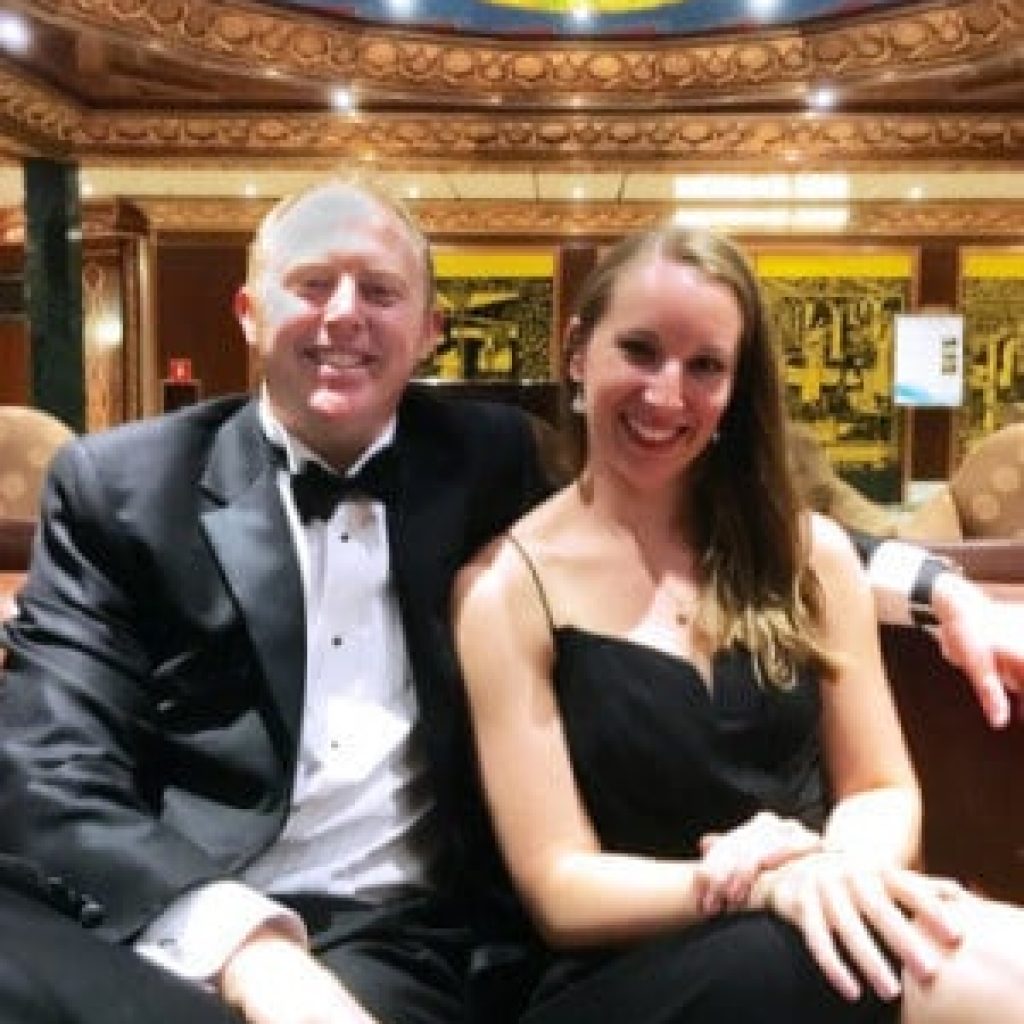
Many of our Park West collectors develop friendships with the art teams over the course of their land or sea vacations. Here's a chance to get to know them better as they share their favorite adventures in the art world. William Roberts, from Lugoff, South Carolina, left his position at the biggest contractor for Medicare […]
The post Auctioneer Spotlight: William Roberts and Justine Covey appeared first on Park West Gallery.
]]>
Many of our Park West collectors develop friendships with the art teams over the course of their land or sea vacations. Here's a chance to get to know them better as they share their favorite adventures in the art world.
William Roberts, from Lugoff, South Carolina, left his position at the biggest contractor for Medicare and his job at his family's dive center to explore new opportunities. His passion for living on the water and connecting people with fine art was left unfulfilled until he found Park West Gallery, the perfect fit. In September 2011, he met Justine Covey. Justine is from Greenfield, Massachusetts and at the time had just graduated from Lehigh University with a degree in international business. Since then, the two have had the opportunity to grow professionally while traveling the world.

William Roberts and Justine Covey dressed to the nines on Carnival Spirit, one of the many ships they've been auctioneers on. Photo credit: Justine Covey
Previous ships as Auctioneer: Celebrity Century, Celebrity Solstice, Celebrity Reflection, Carnival Cruise Line (CCL) Imagination, CCL Destiny, CCL Conquest, CCL Spirit, Norwegian (NCL) Pearl, NCL Jewel, Royal Caribbean International (RCI) Navigator of the Seas, and Holland America Westerdam
Current ship: RCI Voyager of the Seas
What do you like most about being an auctioneer?
William: It's the thrill of helping people understand why art is so culturally impactful and teaching them which artists fit into their collections at home. As part of my responsibilities with the company, I also train many auctioneers and gallery directors. Watching them come into their own is one of the most satisfying aspects of my leadership role.
Who is your favorite Park West artist and why?
William: It's easier to pick eras of art and fit a favorite artist to each one. For example, I am fortunate to own artwork by some of my favorite artists from the past, Albrecht Dürer and Rembrandt van Rijn. Moving to the modern era, I love the romantic Marc Chagall and the vibrancy of Peter Max. Today, I strongly connect with Michael Godard and David "Lebo" Le Batard after meeting them.
Justine: I was never a fan of abstract or surreal art until I started to learn about Joan Mirό. He completely changed my perspective and introduced me to a whole new genre of art that I had never even considered. After spending an unforgettable afternoon at Mirό's Foundation in Barcelona a few years ago, my admiration and respect for his work was solidified. Now we have several abstract works in our collection that have become some of my favorites, including several from Tim Yanke and David "Lebo" Le Batard.
What is your favorite guest memory?
William: My favorite cruise experience was on a trans-Atlantic cruise where we met two people who were instantly drawn to the artistry of Mirό. Over our eight days at sea, we discussed modern art in depth and, by the time we reached Barcelona, they collected two Mirό lithographs from the Broder Collection and one Daphnis and Chloe lithograph by Marc Chagall. We even bumped into our newfound art collectors at the Mirό museum. We still keep in touch to this day
Justine: About three years ago, we were cruising in Alaska where we met a wonderful woman named Alyce. She was immediately drawn to the detailed artworks of Csaba Markus, and collected several of his works throughout the cruise. As luck would have it, Csaba was cruising with us that week for a VIP event. I'll never forget the look on her face when we told her that he was actually on board with us! We were able to introduce Alyce to the man behind the art she had fallen in love with. Helping her connect with one of her favorite artists was simply unforgettable.
Will and Justine at the top of the Sydney Harbor Bridge, 440 feet (134 meters) above seal level. Photo credit: Justine Covey
What has been your favorite port?
William: My favorite port is Sydney, Australia. There's an abundance of culture. My tip would be to spend a few extra days to fit it all in. Climb the Sydney Harbor Bridge, take in a performance at the Sydney Opera House and enjoy marvelous cuisine found everywhere. If you enjoy a good cigar, make sure you head over to Darling Harbor where you can sit on the balcony at Cohibar, enjoy a fantastic cigar and take in the atmosphere.
Justine: There is something almost other-worldly about Venice, Italy. As soon as you step off the ship, you feel as though you've stepped into another era. Be sure to bring your walking shoes because there is no shortage of places to discover. I highly recommend visiting the Peggy Guggenheim Collection. She amassed incredible works of modern art from the likes of Pollock, Picasso, Braque and Chagall.
What do you like best about cruising in the South Pacific?
William: I love cruising in the South Pacific, especially in Australia. Their continent is steeped in history, but their country is still very young. Much like the United States, the Australian spirit of adventure and culture is still being defined. As an art dealer here, it is fascinating to learn about Aboriginal art while helping people connect to the modern international art market each day.
The post Auctioneer Spotlight: William Roberts and Justine Covey appeared first on Park West Gallery.
]]>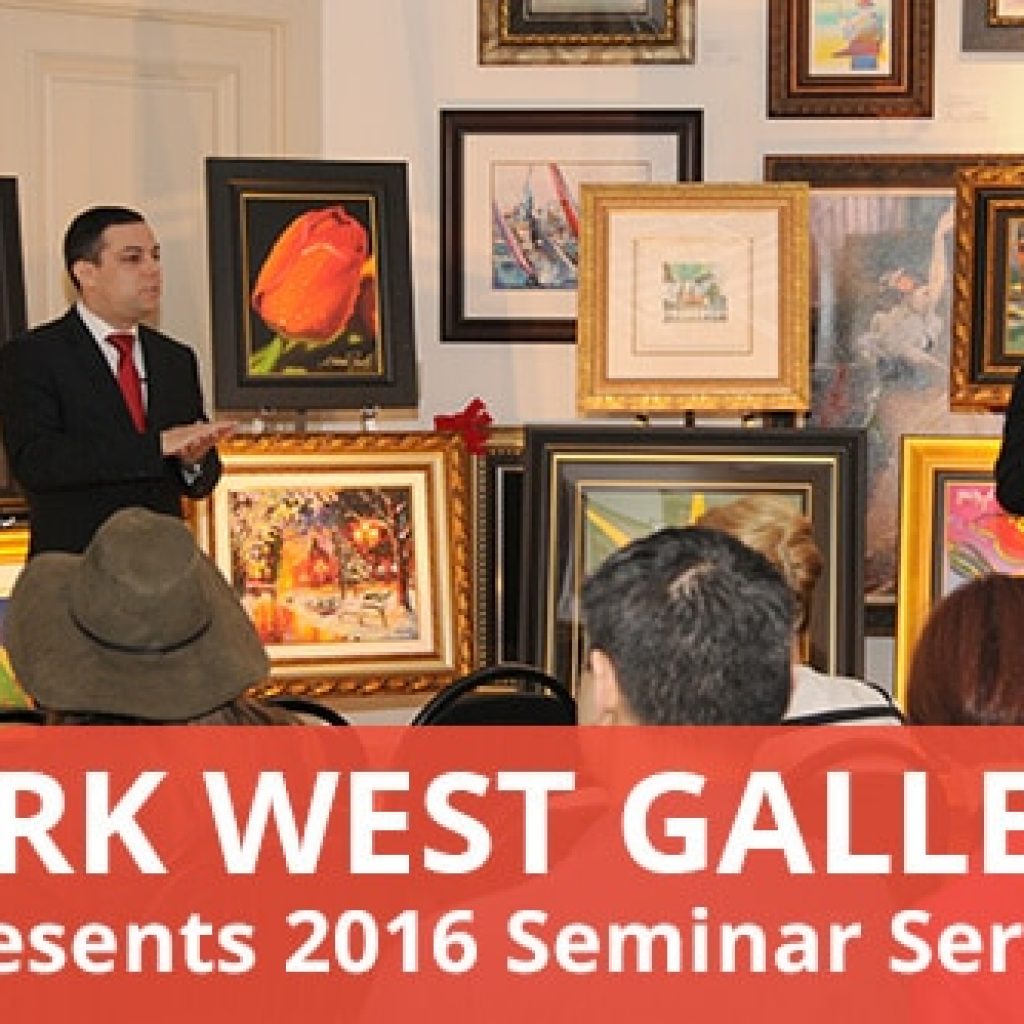
Discover more about your favorite artists, brush up on art history and gain valuable tips for collecting art with Park West Gallery's new 2016 art seminar series. Visit the gallery in Southfield, Michigan at 3 p.m. each Sunday from January 10 through March 20 for free art seminars that are sure to enhance your knowledge […]
The post Free 2016 Seminar Series begins January 10 appeared first on Park West Gallery.
]]>

Visit the gallery in Southfield, Michigan at 3 p.m. each Sunday from January 10 through March 20 for free art seminars that are sure to enhance your knowledge of collecting and the art world. Topics include animation art, masters such as Picasso and Rembrandt, "Art Collecting 101" and contemporaries such as Thomas Kinkade and Yaacov Agam.
"Whether you're a novice or seasoned collector, these seminars are designed to instill a new passion for art collecting and gain a more well-rounded understanding for all aspects of art appreciation," says David Gorman, Park West Gallery Director.
The seminars are held at Park West Gallery in Southfield, Michigan. Each art seminar lasts 30-45 minutes and are free of charge to attend. Complimentary light refreshments will be served. Seating is limited, so RSVP at 1-800-521-9654 ext. 4 or email sales@parkwestgallery.com.
See the following schedule for more details:
January
1/10 – "400 Years of Art History in 40 Minutes"
From Baroque to Pop Art and everything in between, join your Park West Gallery staff in a fun, fast and informative approach to understanding the evolution of modern art through the past four centuries.
1/17 – The Life & Art of Thomas Kinkade
Learn how Thomas Kinkade was able to establish the largest artwork collector base in history. This seminar will also discuss hidden metaphors and initials/names of his loved ones found in some of his works of art. Ever wonder what the number next to his Rockwell-esque signature means? Find out in this short and sweet seminar on the life and work of America's most collected artist.
1/24 – Living Legends, featuring the art of Max and Agam
With careers spanning over five decades and countless museum exhibitions, find out why Peter Max and Yaacov Agam are considered some of the most important painters alive today!
1/31 – Art Collecting 101
This seminar is designed to give the audience a more complete understanding of various printmaking methods as well as powerful collecting tips gained from over 2 million collectors in our 47-year history.
February
2/7 – The History of Animation
Something everyone can relate to! Find out about the history of animation before the digital age took over, including original production cels from your favorite Saturday morning cartoons. These rare pieces of animation history will give you a better appreciation and knowledge for collecting animation art.
2/14 – Dali & Destino
Walt Disney and Salvador Dali met, inspired one another, and collaborated back in 1945. This film has been shrouded in history for over six decades and will be shown, along with the art, in this one-time-only showcasing and analysis of this important six-minute animated film.
2/21 – The Art of Etching, featuring Goya & Rembrandt
A discussion on two of the most important etchers to have ever lived. Gain insight into the inspiration and technique of two of art history's greats, Rembrandt van Rijn and Francisco de Goya. For those who desire to take their collection to the next level, this seminar is worth its weight in gold!
2/28 – Antique Art Collecting, featuring illuminated manuscripts & Japanese woodblock prints
Whether inheriting an heirloom or thinking of acquiring one for your family, this seminar will cover provenance, care, restoration and more for your antique art collection. Featuring original illuminated manuscripts dating back to the medieval ages and Japanese woodblock prints dating back to the mid-19th century, you will learn everything there is to know about collecting antique art!
March
3/6 – 20th Century Masters, featuring Picasso, Chagall, & Miró
Three of the most influential artists of the 20th century will be discussed in this seminar. Many say, "My kid can do that!" when approaching works by these artists, but in this seminar, you will learn that they were not only revolutionary for their time, but influenced the course of modern art.
3/13 – Modern Masters, featuring Mouly, Tarkay, Medvedev, & Lebadang
A tribute seminar to some of the most influential artists Park West has dealt with during its lifetime. Although they have all passed on, they live on through their art. As Park West was the primary dealer for these painters for the majority of their careers, no one could put on a better seminar to learn about the lives and works of these historic painters.
3/20 – Emerging Israeli Artists
Considered by many critics and historians to be the early 20th century Paris of today, Tel Aviv is a booming melting pot of culture that is making waves in art history. This seminar will feature some of the more prominent painters emerging from Israel, specifically Tel Aviv, in 2016. Don't miss out on the chance to discover and even collect art from some of the most exciting Israeli artists today!
The post Free 2016 Seminar Series begins January 10 appeared first on Park West Gallery.
]]>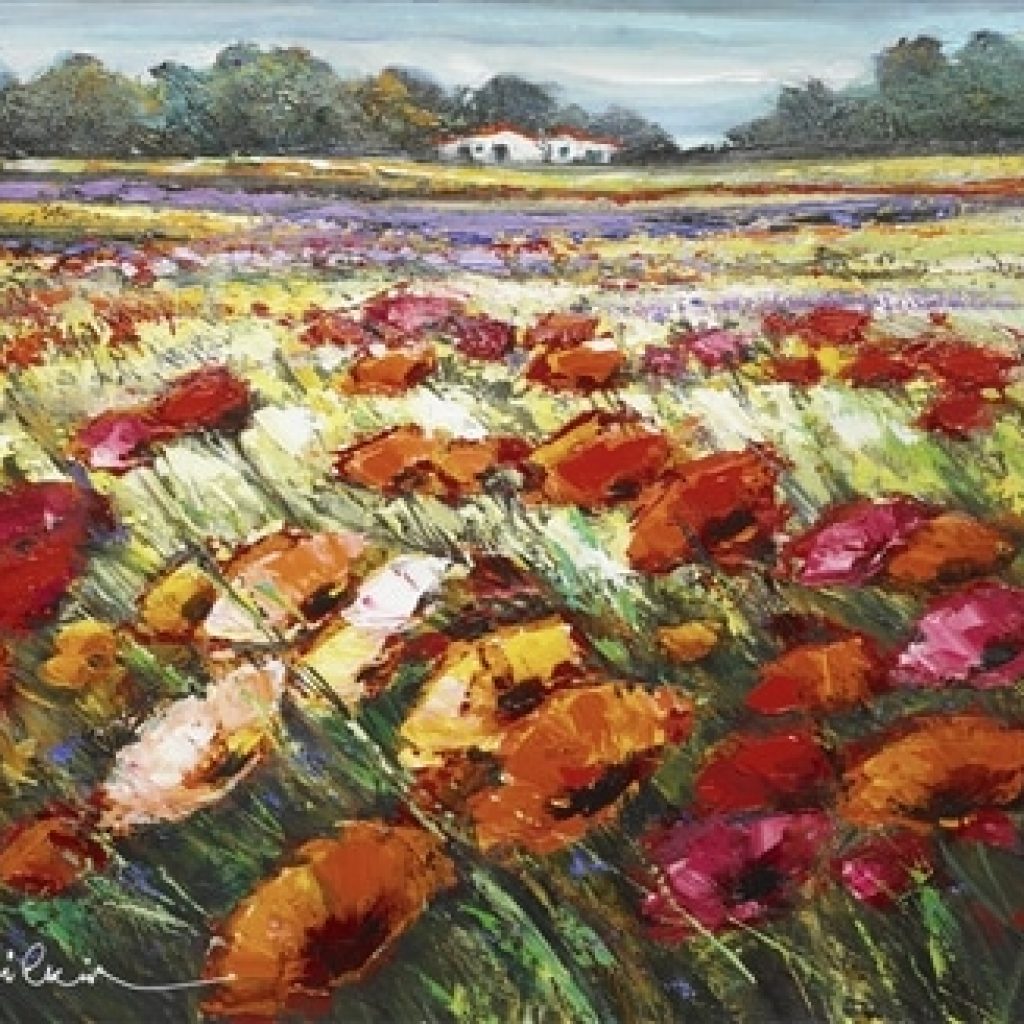
Art – you either get it, or you don't, right? There is no in-between. You're either gifted with the know-how of all things higher and nobler or you're a skeptic forever, right? Wrong. At Park West Gallery, our aim is to make art accessible from the beginning, providing a space and dialogue that enriches collectors […]
The post Know Your Art – Mediums and Techniques appeared first on Park West Gallery.
]]>
Art – you either get it, or you don't, right? There is no in-between. You're either gifted with the know-how of all things higher and nobler or you're a skeptic forever, right?
Wrong.
At Park West Gallery, our aim is to make art accessible from the beginning, providing a space and dialogue that enriches collectors uniquely. In this article, you'll learn about some of the most common mediums and techniques utilized by our family of artists, the characteristics of each, as well as famous artistic innovators who heightened their creative possibilities.
Painting Techniques
Oil:
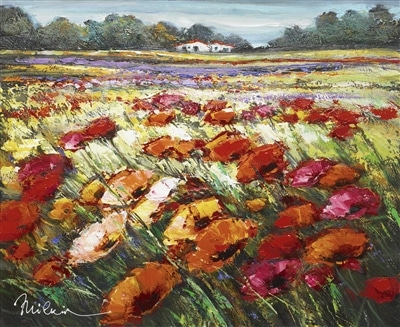
"Lilacs in the Distance" (2016), Michael Milkin
Capable of capturing even the most nuanced details shadowed amidst light and dark, oil is the paint of history. Oil paint is made with natural pigments, linseed oil and turpentine, making it recognizable in sight and smell. The main downside is that it can take up to nine months to dry completely and even years for heavy impasto (texture).
Oil paint usage can be traced back in origin to the 5th century in Asia, broadening the scale of its beauty when introduced to European traders in the 15th century. The Old Masters like Leonardo da Vinci, Rembrandt van Rijn and Francisco Goya used oil as a tool to evoke sentiments of agony, ecstasy and poetry. Modern artists seeking color saturation, versatility and subtle illumination, prefer to use oil paint. These include Park West Gallery artists Duaiv, Csaba Markus, Emile Bellet, Maya Green, Slava Ilyavev, Michael Milkin, and Hua Chen.
Watercolor:
"Waiting for Suzanne" (2006), Itzchak Tarkay
Watercolor was initially developed in Asia during the 8th century to be laid on fine silks and woven paper. The paints slowly made their way to Byzantium and Europe in the 14th century, placing its aesthetic hold onto illuminated manuscripts, and later rendered itself to the gossamer aesthetic of the French Impressionists.
Watercolor paint uses ground pigments mixed with water-soluble binders. Watercolor painting lends itself to a gradient of tonal hues that can imitate the washes of sky and sea, but it is considered one of the most difficult mediums to master, as it doesn't lend itself to correction after application. Many consider Itzchak Tarkay (1935-2012) to be an especially gifted watercolorist who awed viewers with his technique.
Acrylic:
"Vase of Flowers Series 60 Detail Ver. VI #281" (2016), Peter Max
Made commercially available only as recent as the 1950s, acrylic is paint that binds its pigment with a synthetic resin. Acrylics are water soluble during application, yet water-resistant when dry, making them easy to blend and fast-drying.
Unlike its oil-infused predecessor, acrylic paint emerged in the era of advertising, graphic design and glossy, cosmopolitan editorials. Therefore, by association, acrylic paints are vibrantly hued, eye-catching and possess an advertent pop of bright ceruleans and magentas. No surprise that creators of pop art like Peter Max, Simon Bull, Romero Britto and Andy Warhol brought acrylic paint into celebrity.
Spray Techniques
Giclée:
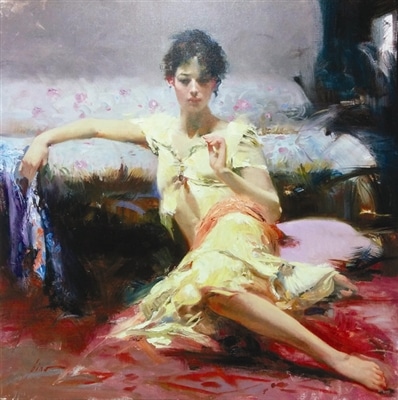
"Parisian Girl" (2006), Pino
Giclée (pronounced gee-clay) printing is the art medium of "now," fusing together traditions of realism and digital innovation. A French term, translating into "the spraying of ink," giclées aren't simply printed reproductions; rather, they're the result of obsessive digital fine-tuning and modification, and are able to capture great photorealistic detail. The process begins with a high resolution photograph of the artwork being translated into giclée form. The image is then scanned, turned into a digital source file, color corrected, printed, revised, reprinted – and subject to constant adjustment until the artist is satisfied with the printed product.
Artists liked Pino, Andrew Bone, Scott Jacobs, Autumn de Forest, and many more have utilized giclées for their limited edition artworks.
Dye Sublimation:
"Melody of Rain" (2016), Michael Cheval
Dye sublimation is one of Park West Gallery's latest and most innovative mediums. Dye sublimation is the digital printing process that transfers imagery onto materials such as metal, glass and plastic. The concept is based on sublimation, which is when a substance changes from a solid to a gas without becoming a liquid. The original image is rendered into a digital matrix, or map, and from there the artist has complete control over how the colors will appear on the final work of art. Lastly, the mapped image is printed onto transfer paper using dye-based inks, and then transferred onto a specially coated aluminum plate with heat and pressure.
Dye sublimation works are renowned for achieving striking and crisp detail and vivid luminosity. Artists such as Michael Cheval, Guy Harveyand Yuval Wolfson utilize the technique.
Surface Techniques
Lithography:
"Theiere et compotier" (1975), Marcel Mouly
Lithography, or "stone writing," is a printmaking process where images are inked and pressed on slabs of stone. Lithography was heavily utilized by 19th and 20th century artists like Henri de Toulouse-Lautrec, Marc Chagall and Marcel Mouly. Revered for its capability to produce atmospheric, delicate colors and soft tonalities, lithography lends itself to a painterly aesthetic.
Based on the antipathy of water and oil, the lithographic process begins by drawing an image, in reverse, on a stone using a greasy crayon or liquid form called a tusche. The stone is treated with water, which adheres to all areas except those drawn with the crayon. Lastly, a layer of ink is rolled onto the stone, which is repelled by the water and sticks only to the greasy drawn or painted areas. Paper is then placed on the surface and pressed, transferring the ink to paper. This process must be completed separately for each color on each example. In fact, it can take months to finish an edition of lithographs.
Serigraphy:
"Pre-Mazor No. 3" (1987-89), Yaacov Agam
From applying images to T-Shirts, stenciling holiday cards or even airbrushing, we've all dabbled in serigraphy, or its common iteration, screen printing. Don't let this familiarity trick you, however, as fine art serigraphy is a time-consuming and physically demanding medium.
In serigraphy, stencils are adhered to a porous polymer screen and tightly stretched around a frame. Paper is then placed under the screen, and ink is applied to the top of the screen and layered across the entire surface with the aid of a squeegee. Like lithography, a separate stencil or matrix is created for each color, which requires a patient and precise eye. Serigraphy creates images of striking texture, decisive lines and sharp colors. Artists like Erte, Tarkay and Yaacov Agam are among the innovators of the medium.
Serio-lithography:
"L' Escalier du Jardin" (2004), Jean-Claude Picot
As the name suggests, serio-lithography is a hybrid medium, incorporating characteristics of both serigraphy and lithography. Artworks that utilize this technique are initially inked and pressed on a lithography plate and then enhanced with one or more serigraphic screens. By combining these two graphic techniques, serio-lithographs are appreciated for their vivid colors, tonal depth, and texture.
Intaglio Techniques
Etching:
"The Good Samaritan" (1633), Rembrandt van Rijn
Etching is a laborious and painstakingly detail-oriented medium. Old masters such as Rembrandt van Rijn and Francisco Goya heavily utilized the medium to achieve awe-inspiring images.
Creating an etching begins with covering a metal plate with an acid-resistant ground. The image being printed is then scratched into the ground with a fine tool, exposing the metal plate beneath. The plate is then submerged into an acid bath, burning away at the exposed metal – the longer the plate is submerged, the deeper the impressed lines became. Once removed from the bath, the plate is inked, the surface is cleaned so that ink is only residing in the incisions and moistened paper is pressed into the paper, extracting the ink and creating the mirror image of the composition.
Fun Fact: Though most commonly recognized for his achievements in painting, historical records indicate that Rembrandt carried and scratched on an etching plate like one would casually doodle in a sketch pad!
Engraving:
"St. Simon" (1523), Albrecht Durer
Engraving, like etching, requires a patient hand and keen eye for detail. However, unlike etching, engraving uses cutting tools to incise lines directly into the surface of a metal plate – no acids are employed or grounds used to treat the plate. This means a precise technique is needed to print a successful impression. The plate is then inked and pressed against paper, to create a mirrored version of the engraving. Albrecht Durer preferred the technique, creating some of the most intricate engravings of all time.
Relief Techniques
"Diurnes (Femme Assise en Pyjama de Plage II)" (1961), Pablo Picasso
Relief printing is done as you would imagine pressing a rubber stamp, however, the process for creating a relief matrix is comprehensive and requires a clean design. Relief techniques are essentially the opposite of the intaglio techniques described previously, which mean that the image's negative areas are cut away with a knife or chisel, leaving the image to reside on the surface level once inked. Like many forms of printing, the final image is the reverse image of the matrix. Examples of relief techniques include wood cuts and linocuts, where the relief is chiseled onto a block of wood in the former and a sheet of linoleum in the latter.
The post Know Your Art – Mediums and Techniques appeared first on Park West Gallery.
]]>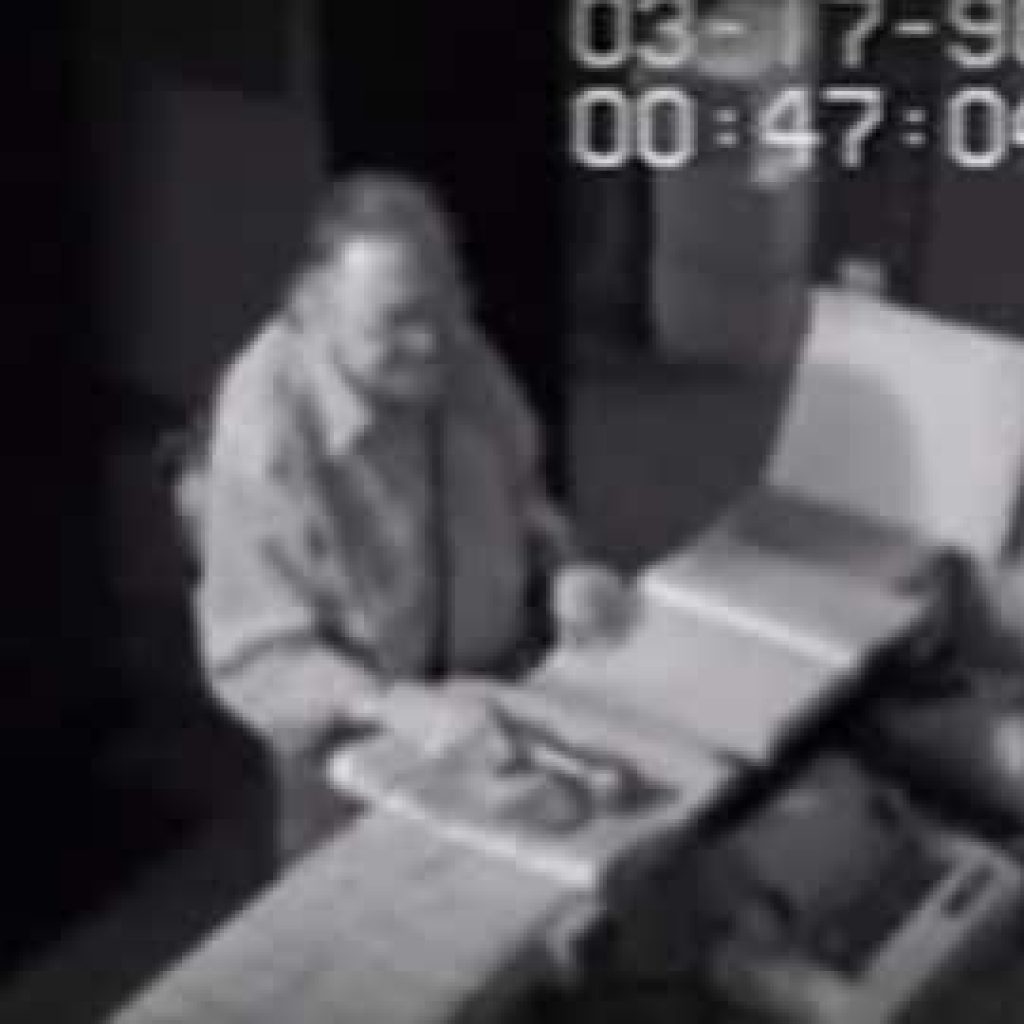
Video footage related to the infamous Gardner Museum heist may shed light on a case that has remained unsolved for 25 years. Federal investigators released previously-unseen surveillance footage related to the Isabella Stewart Gardner Museum burglary that resulted in the theft of $500 million in art, the largest heist in art history. The video captured […]
The post New video from 1990 Gardner art heist appeared first on Park West Gallery.
]]>
Video footage related to the infamous Gardner Museum heist may shed light on a case that has remained unsolved for 25 years.
Federal investigators released previously-unseen surveillance footage related to the Isabella Stewart Gardner Museum burglary that resulted in the theft of $500 million in art, the largest heist in art history.
The video captured activity at the museum 24 hours before the theft took place. In it, an unidentified man exits a car matching the general description of the vehicle parked outside of the museum minutes before the theft.
This unidentified man exits the vehicle and is allowed into the museum through a side door by the security guard. The footage's timestamp shows this occurred at 12:49 a.m. on March 17, 1990.
On the morning of March 18, 1990, two white men dressed as Boston Police officers gained entry to the museum by telling the security guard they were responding to reports of a disturbance. Against museum policies, the guard allowed them in. The thieves then subdued the on-duty security guards, handcuffed them and took them to separate areas of the museum's basement.
The FBI says the men did not use weapons, the museum's panic button was not activated and the police were not notified. Along with the stolen artwork, the men stole the surveillance footage from that evening, but not the prior night.
United States Attorney Carmen Ortiz explained that the video was released as part of an exhaustive re-examination of the available evidence.
"Today we are releasing video images from the night before the theft — images which have not previously been seen by the public — with the hope of identifying an unauthorized visitor to the museum," said Ortiz in a written statement.
Among the 13 stolen items were works by Vermeer, Degas, Manet and three works by Rembrandt – including "The Storm on the Sea of Galilee," his only seascape painting. To add insult to injury, the thieves cut the Rembrandt painting out of the frame when stealing it.
Rembrandt Christ in "The Storm on the Lake of Galilee" by Rembrandt – www.gardnermuseum.org. Picture licensed under Public Domain via Wikimedia Commons.
"With the public's help, we may be able to develop new information that could lead to the recovery of these invaluable works of art," said Ortiz.
The focus of the investigation has shifted to recovering the art. Two years ago, the FBI suggested it knew who stole the artwork, but no one was ever charged. In a recent report, as described by The Guardian, the FBI is claiming that the suspects are likely deceased.
"Now Peter Kowenhoven, the FBI's assistant special agent in charge in Boston, has settled the lingering mystery of why no one was ever charged: the suspects are dead."
Anyone who might have information related to the video is encouraged to call the FBI at 617-742-5533 or the Gardner Museum at 617-278-5114.
The post New video from 1990 Gardner art heist appeared first on Park West Gallery.
]]>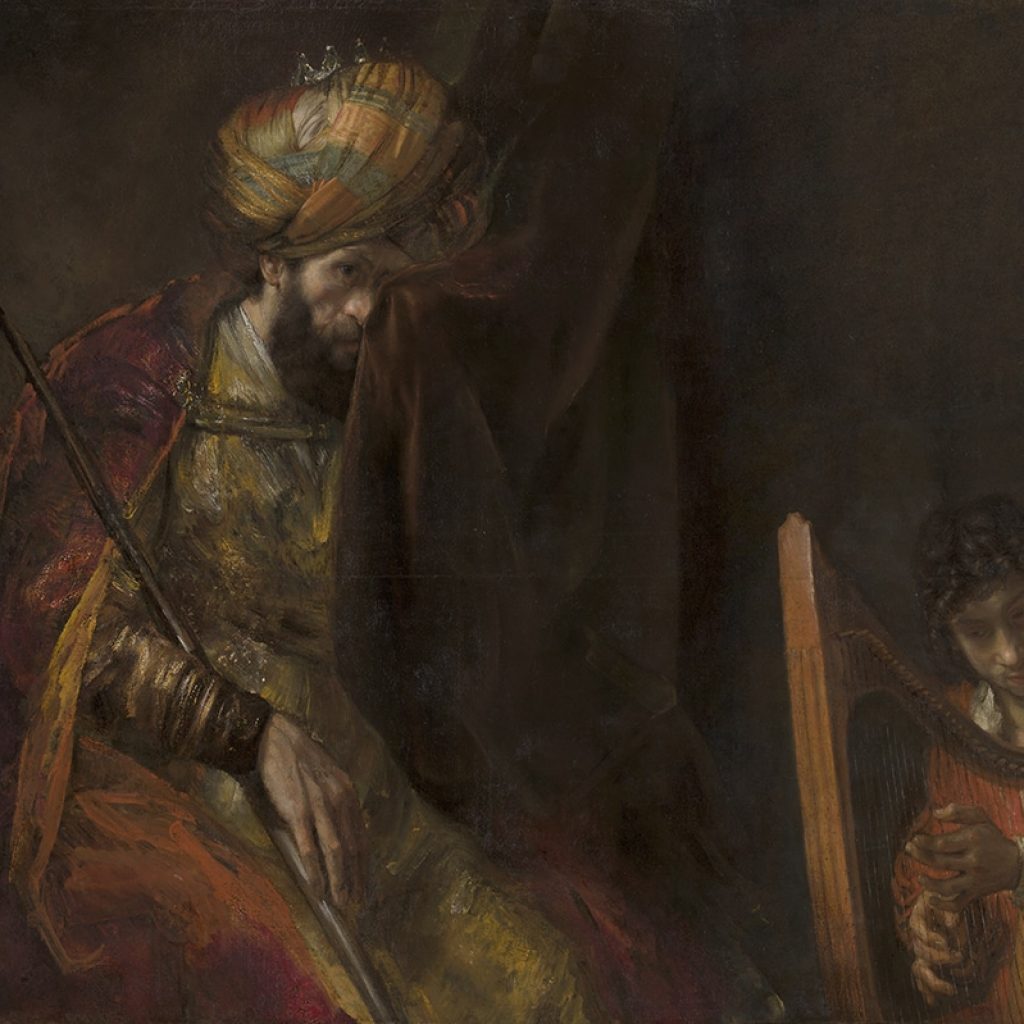
A painting disputed as a mere studio copy of Rembrandt van Rijn for 46 years has been declared to be an authentic work created by the master artist. After eight years of research using the latest techniques, the Mauritshuis museum in The Hague has declared that "Saul and David" is in fact one of Rembrandt's greatest […]
The post Disputed painting proven to be authentic Rembrandt appeared first on Park West Gallery.
]]>
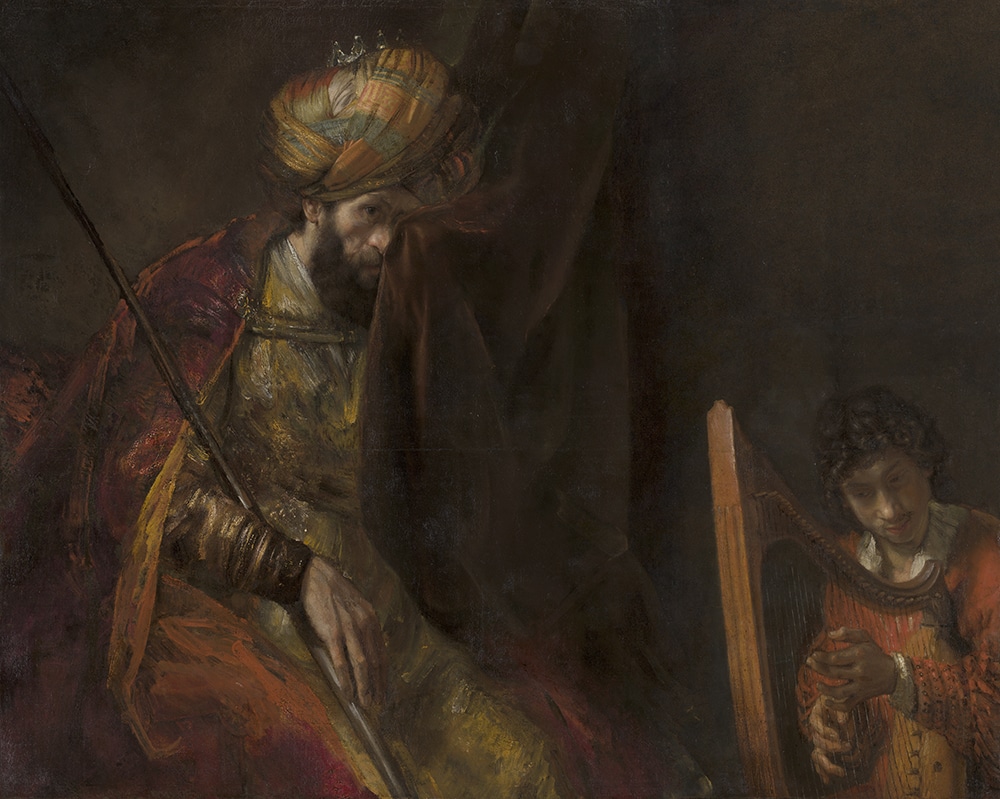
"Saul and David" by Rembrandt. Photograph: © Margareta Svensson
Credits: Mauritshuis, Den Haag.
A painting disputed as a mere studio copy of Rembrandt van Rijn for 46 years has been declared to be an authentic work created by the master artist.
After eight years of research using the latest techniques, the Mauritshuis museum in The Hague has declared that "Saul and David" is in fact one of Rembrandt's greatest interpretations of Biblical history.
Park West Gallery Founder and CEO Albert Scaglione says in what has become all too common in the art world, a declaration by an expert that later proved to be false caused a museum to have to reestablish the authenticity of the work of art.
"Fortunately, with modern scientific tools and proper research, this invalid opinion was set aside and the painting returned to its prominence as an original Rembrandt, taking its rightful place in the museum and in the art world," says Scaglione.
The painting depicts two figures against a dark background. On the right is David, kneeling and playing a harp. On the left is King Saul, who is so moved by the music that he wipes away tears with a curtain. The painting is said to be based on I Samuel 18:9-11 from the Bible.
The authenticity remained undisputed until, according to the New York Times, German-Dutch art historian Horst Gerson questioned the authorship of the painting in 1969. He suggested the work could have been painted by one of Rembrandt's pupils. The painting's condition didn't help – it was dark and its varnish yellowed and cracked. Since then, the authorship has been debated, and caused the museum to label it as "Rembrandt and/or Studio."
So what led to the conclusion that Rembrandt himself painted it? Like a good crime novel or TV show, it's all about where the evidence leads. Experts used advanced techniques and technology to analyze the painting, including weave angle mapping and a technique that allowed restorers to peer beneath the painted over surface.
"A wide range of trusted and innovative research techniques have been employed," said Emilie Gordenker, director of the Mauritshuis. "The result is significant: the Mauritshuis has one of its most famous Rembrandts back."
Restorers used advanced technology and techniques to analyze the painting. Credits: Mauritshuis, Den Haag.
One of the more disputed elements is the curtain, which endured heavy over-painting. Since X-Ray and infrared reflectography (used to look through paint layers) weren't effective in analyzing the original layers, a macro-X-ray fluorescence analysis (MA-XRF) was conducted with the assistance of the University of Antwerp and Delft University of Technology.
The MA-XRF isolated individual elements in the pigments. Not only did it prove the curtain was part of the original design, it revealed that this section of the painting was largely intact despite its discoloration.
Paint samples were also tested to determine if the materials matched those that Rembrandt used during the time the painting was created. Researchers found that the pigments were in fact characteristic of Rembrandt's paintings in the 1650s and 1660s.
A part of the initial dispute was the discrepancies, most noticeably in the lower left mantle and in Saul's face. After uncovering the varnish layer, the research team determined it was in fact painted in phases, which may explain Gerson's determination that it was "superficial and inconsistent."
At some point in time, the painting had been cut apart and rejoined, and consists of no fewer than 15 different pieces of canvas. Because of this, researchers say the painting is smaller than its original size. The last time the painting was restored was more than a century ago by Alois Hauser in Berlin.
A restorer works on "Saul and David." Photograph: © Ivo Hoekstra
Credits: Mauritshuis, Den Haag.
The painting first emerged in 1830 at an art auction in Paris, and remained on the market until Mauritshuis director Abraham Bredius purchased it in 1898. Upon his death in 1946, he left the painting to the museum, where it was a favorite among visitors.
The painting will be the star of its own exhibition, "Rembrandt? The Case of 'Saul and David'," that details the history, research and restoration of the painting. The exhibition runs June 11 to September 13, 2015.
The post Disputed painting proven to be authentic Rembrandt appeared first on Park West Gallery.
]]>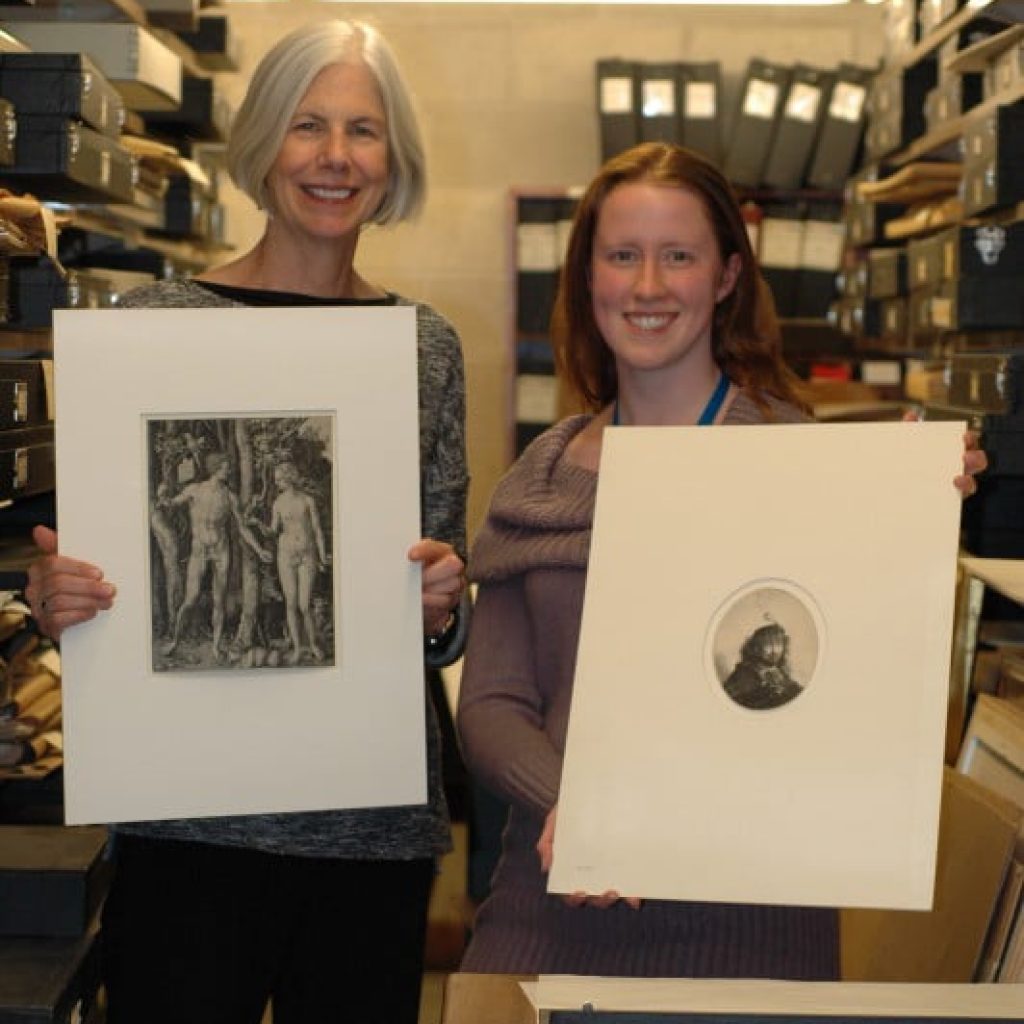
Two works by Albrecht Dürer and Rembrandt van Rijn reported as missing from the Boston Public Library (BPL) were revealed to have been misfiled. After digging through nearly 60 percent of the library's print collection, the etching by Rembrandt and engraving by Dürer were located, ending a search that involved the FBI, Boston Police Department […]
The post UPDATE: Missing Dürer, Rembrandt works found appeared first on Park West Gallery.
]]>

From left, Boston Public Library President Amy Ryan and Conservation Officer Lauren Schott wear relieved smiles after the library relocated missing works by Dürer and Rembrandt. Photo courtesy of BPL.org
Two works by Albrecht Dürer and Rembrandt van Rijn reported as missing from the Boston Public Library (BPL) were revealed to have been misfiled.
After digging through nearly 60 percent of the library's print collection, the etching by Rembrandt and engraving by Dürer were located, ending a search that involved the FBI, Boston Police Department and U.S. Attorney's Office.
The announcement was made on June 4, eight weeks after the library realized the works were missing. Library President Amy E. Ryan had said the library hoped the works were simply misplaced. Boston police, however, didn't rule out the possibility that the works, valued at a combined $620,000, may have been stolen.
"We're thrilled to have found these treasures right here at home," said Ryan. "They were found safe and sound, simply misfiled. BPL is still committed to enhanced security and a full inventory, but today is a day of celebration for the entire team at BPL."
Lauren Schott, a conservation officer with the Boston Public Library, was the one who found the items. She was modest about locating the valuable artwork amidst the library's 200,000-item collection of prints.
"I was shocked to find the two prints, but it really was just luck of the draw. Anyone of the team that's been looking for the Dürer and Rembrandt could have found them," said Schott.
The Rembrandt and Dürer were found together approximately 80 feet from where the items should have been filed. A total of 14 staff members searched 180,000 of the print stack's 320,000 items – which includes 200,000 prints and drawings in the Print Collection and 120,000 chromolithographs – totaling 38 rows of the 60 rows of print stacks.
The Dürer engraving, "Adam and Eve," was made in 1504 and has an estimated value of $600,000.
Rembrandt's "Portrait with Plumed Cap and Lowered Sabre" etching, made in 1634, is valued at $20,000 to $30,000.
The case has inspired the library to enhance its security measures, especially as it receives more than 3.7 million visitors on an annual basis. The plan includes an inventory of the 320,000 collection by an expert preservationist and upgrading from catalog cards to an electronic catalog.
Ryan has also announced that she will resign from her position as of July 3, 2015, saying it will "allow the work of the Boston Public Library to continue without distraction."
The crisis of the missing Dürer and Rembrandt may have been averted, but Boston is still the victim of an unsolved art crime. Read more about how the infamous Gardner heist has remained a mystery for 25 years.
The post UPDATE: Missing Dürer, Rembrandt works found appeared first on Park West Gallery.
]]>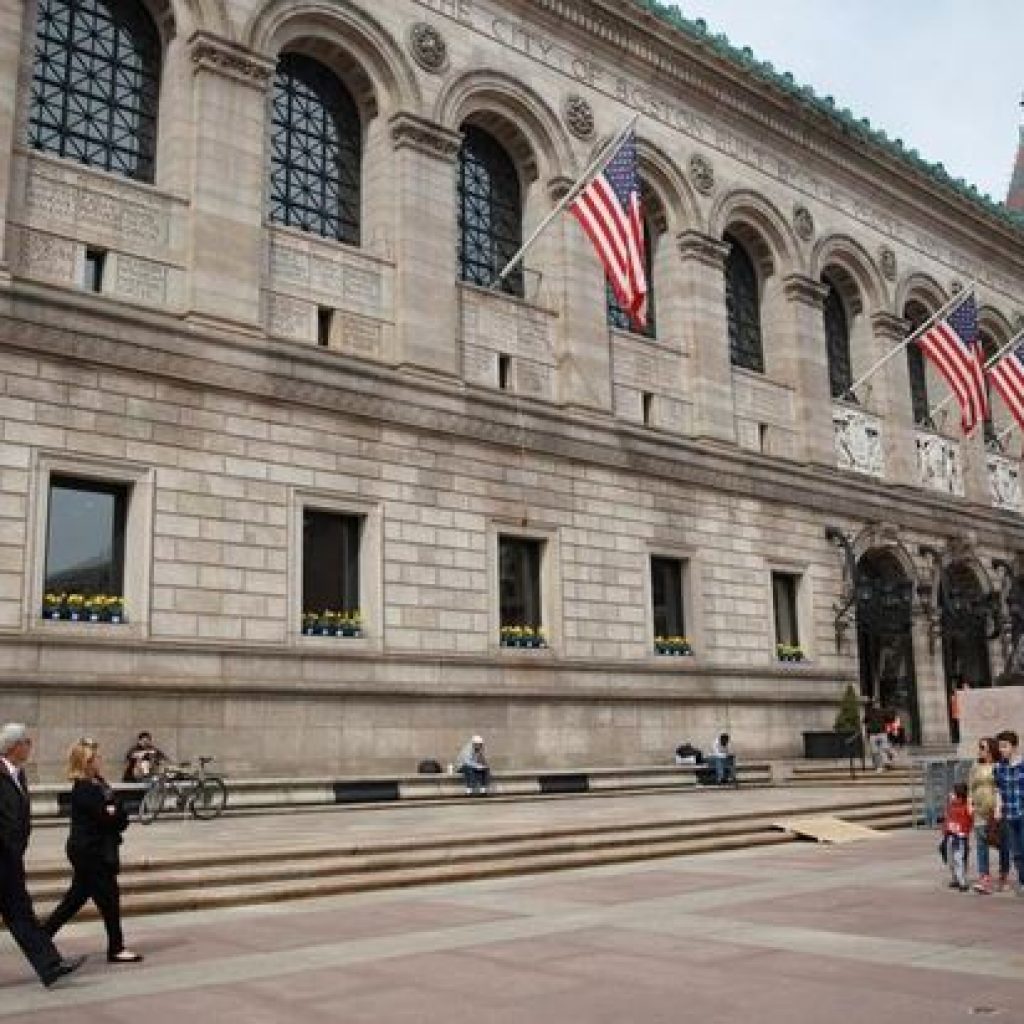
An engraving by Albrecht Dürer and an etching by Rembrandt van Rijn were reported as missing from the Boston Public Library. In a statement released May 20, Boston Public Library President Amy E. Ryan said the works of art were discovered to be missing from the library's print collection. "It is our hope that these […]
The post Works by Rembrandt, Dürer missing from Boston library appeared first on Park West Gallery.
]]>

The Boston Public Library in Copley Square, where two prints valued at $620,000 by old master artists are missing. Photo by Wendy Maeda/Globe Staff, courtesy of the Boston Globe.
An engraving by Albrecht Dürer and an etching by Rembrandt van Rijn were reported as missing from the Boston Public Library.
In a statement released May 20, Boston Public Library President Amy E. Ryan said the works of art were discovered to be missing from the library's print collection.
"It is our hope that these two significant pieces have simply been misfiled," she said in the statement.
She says the curators and department staff are conducting a search of the 200,000-plus collection of prints and drawing. The library is working with the Boston Police Department (BPD) to determine if the missing works are the result of a theft.
"We are continuing to work closely with BPD during their investigation and are conducting an independent security review, and an item by item audit of our print collection," Ryan said.
WCVB Boston reports that the Dürer engraving, "Adam and Eve," was made in 1504 and is valued at $600,000. The Rembrandt etching, "Self Portrait with Plumed Cap and Lowered Sabre," was made in 1634 and is valued at $20,000.
According to the library's statement, Boston police have been actively involved since April 15 when Ryan notified them about the missing artwork. In the Boston Globe, police have said they are looking at the possibility of the case being an inside job. Police Commissioner William B. Evans says the works may have been missing for up to a year.
In the meanwhile, the library is determining how to improve its procedures for allowing the public to view such valuable items.
The post Works by Rembrandt, Dürer missing from Boston library appeared first on Park West Gallery.
]]>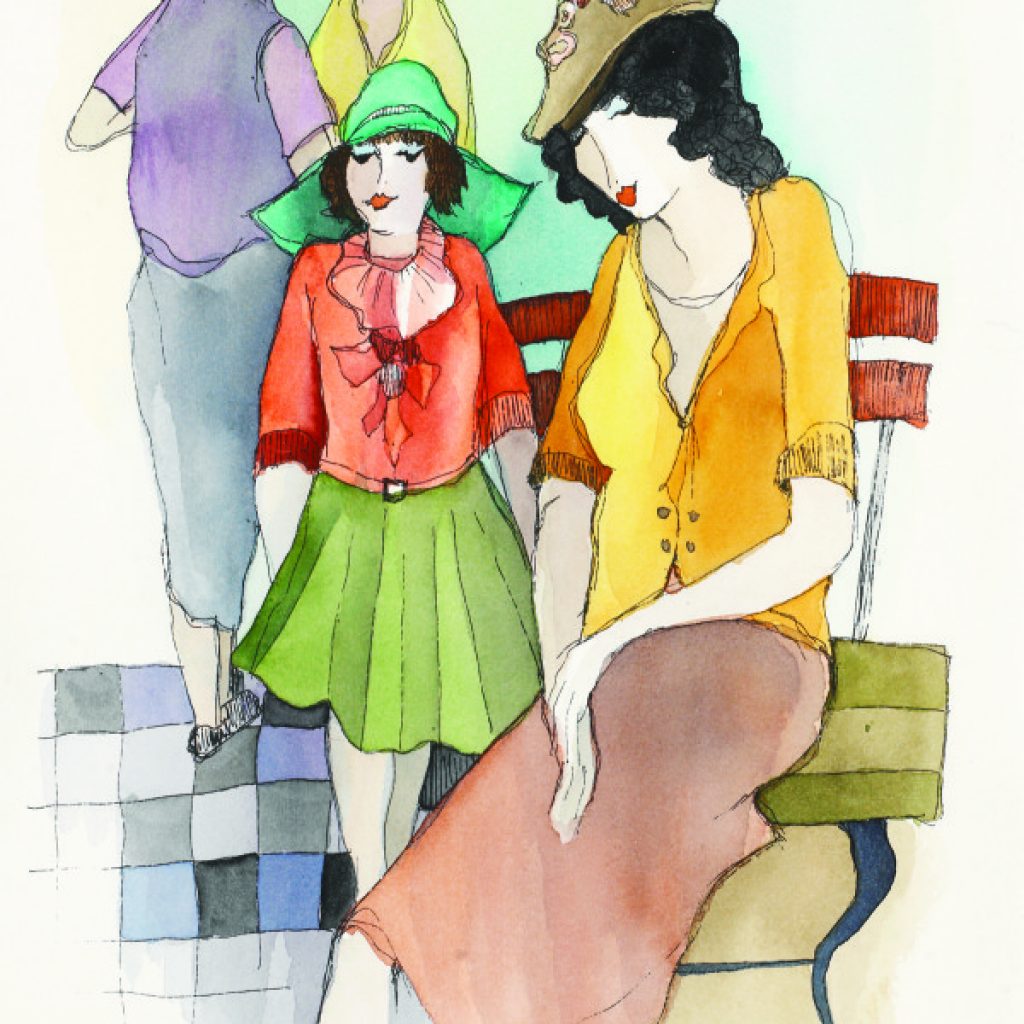
Mother's Day is all about celebrating motherhood and maternal bonds, whether it is one's own mom, grandmother, sister or other loved one. Read on to see how some of the Park West Gallery artists, past and present, have celebrated mothers through their artwork. Itzchak Tarkay Itzchak Tarkay, the master acrylic painter, watercolorist and graphic artist, […]
The post Celebrating Mother's Day with 7 artists appeared first on Park West Gallery.
]]>
Mother's Day is all about celebrating motherhood and maternal bonds, whether it is one's own mom, grandmother, sister or other loved one. Read on to see how some of the Park West Gallery artists, past and present, have celebrated mothers through their artwork.
Itzchak Tarkay
"Mother And Daughter" (2007) by Itzchak Tarkay.
Itzchak Tarkay, the master acrylic painter, watercolorist and graphic artist, portrayed women throughout his oeuvre. His "natural woman" spoke to the depth and complexity of women, and shows her as satisfied, calm, and serene. In our Mother's Day art, Tarkay depicts a gathering where a mother and daughter share a quiet moment together.
Rembrandt van Rijn
"Artist's Mother with her Hand on her Chest" (1631) by Rembrandt.
Rembrandt immortalized his mother in etchings as well as in several paintings. In the above etching, Rembrandt demonstrates his use of "psychological portraiture," which captures more than the subject's likeness, but their humanity and spirituality. Hints of what she was like might be gleaned from Rembrandt's works, as he depicted her as a prophetess, reading a book, or playing a role in religious imagery.
Linda Le Kinff
"New Mother" (2014) by Linda Le Kinff.
Thanks to her powerful colors and warm scenes, collectors find themselves connecting to the artwork of Linda Le Kinff. In this mixed media painting, Le Kinff expresses the indescribable feelings and emotions of motherhood as a new mother cradles her child. Le Kinff's works capture a myriad of scenes, whether it's music or intimate moments in the lives of her subjects.
Hua Chen
"Mother and Daughter" (2012) by Hua Chen.
Hua Chen's delicate style is perfect for portraying the female figure without seeming provocative. A perfect example of this is seen in this oil painting of mother and child spending time together at the beach. Like the love of a mother, Chen's subjects are calming, subtle and ageless.
Maya Green
"Mother Nature" (2014) by Maya Green.
In a slightly different vein, Mother's Day can be about celebrating the wonders of Mother Nature, as seen in this floral painting by Maya Green. She says she seeks to break down life to its visual essentials, such as light, dark, balance and movement, and "capturing the essence of a moment."
Pino
Pino grew up in Italy surrounded by women – whether it was sisters, aunts or his mother – and in turn, he recognized their physical and spiritual beauty. Pino illustrated sensual, attractive women on book covers, but switched to creating works of fine art in the early 1990s. For Mother's Day, examine how his mastery of technique and figure portrays the loving care of a mother with her child.
Learn more about Pino at our free exhibition, "Pino: An American Master," which runs until May 17.
Andrew Bone
Of course, humans aren't the only ones that appreciate their mothers, as seen in the artwork by wildlife painter Andrew Bone. The Zimbabwe native personally photographs the animals he renders onto canvas, giving him a first-hand look at how animals interact with one another, including this family of cheetahs under the watchful eye of their mother.
Interested in collecting any of the artwork seen here? Click here for information on how to contact our sales department.
The post Celebrating Mother's Day with 7 artists appeared first on Park West Gallery.
]]>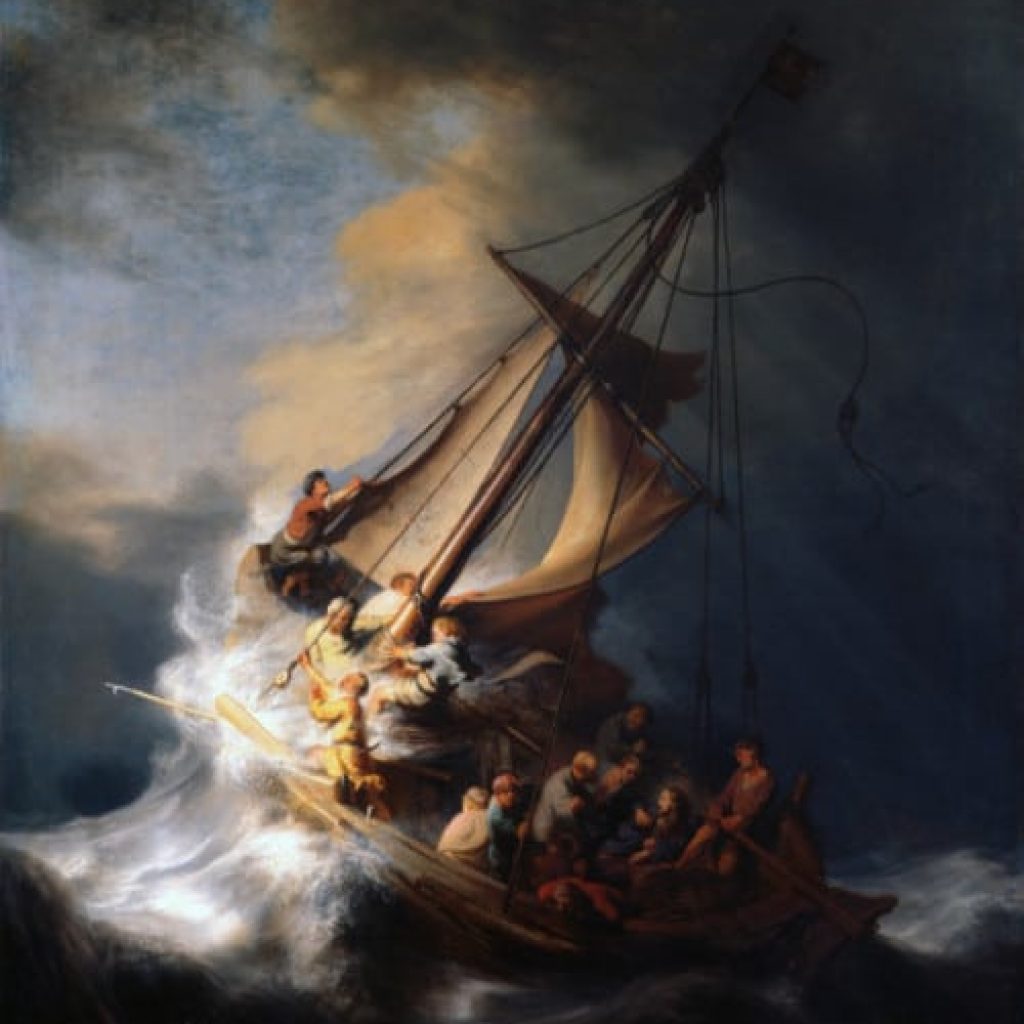
March 18, 2015, marks 25 years since the Gardner heist, when thieves removed prized works of art from a Boston museum. On the morning of March 18, 1990, 13 works of art were stolen from the Isabella Stewart Gardner Museum by two men disguised as police officers. The works are collectively valued at more than […]
The post Gardner heist a mystery 25 years later appeared first on Park West Gallery.
]]>

"The Storm on the Lake of Galilee" by Rembrandt – www.gardnermuseum.org. Picture licensed under Public Domain via Wikimedia Commons.
March 18, 2015, marks 25 years since the Gardner heist, when thieves removed prized works of art from a Boston museum.
On the morning of March 18, 1990, 13 works of art were stolen from the Isabella Stewart Gardner Museum by two men disguised as police officers. The works are collectively valued at more than $500 million, making it the largest private property theft ever.
The paintings included works by Vermeer, Rembrandt and Manet. Rembrandt's "Storm on the Sea of Galilee" oil painting was among them, which thieves took by cutting it from the frame. The damage is only worsened by the fact that this is Rembrandt's only seascape. Another painting, Vermeer's "The Concert," is one of only 34 known works by the artist in the world.
Oddly enough, one of the items stolen was the top of a flag pole (the "finial") shaped like an eagle from a Napoleonic flag. The thieves had to walk past works by Raphael and Botticelli to take the finial.
Anne Hawley, the museum's director, talks about the theft and the toll it's taken on her and the museum in this article from the Boston Globe. She had joined the museum only months prior to when the theft occurred, and has announced she will retire at the end of this year.
"So much energy had been expended on it," she said. "At a certain point I developed this distancing capacity. I wouldn't believe in anything. I would just be clinical about it."
Anne Hawley, Isabella Stewart Gardner Museum director, speaks to reporters in 1990 about the theft of 13 works of art from the Isabella Stewart Garnder Museum. Photo by Tom Landers/Globe Staff/File 1990.
The investigation has followed up on hundreds of leads, taking the FBI to Boston, Japan, France and Ireland. On March 18, 2013, the FBI announced it knew who was responsible for the crime, and a $5 million reward is offered for information leading to the recovery of the works.
Now, 25 years since the heist occurred, the investigation is ongoing and the artwork is still missing. The empty frames hang in the museum in homage to the missing works; they also serve as placeholders should the art ever be returned.
The Boston Globe's coverage of the Gardner heist includes this video that details how the crime was committed as well as an open letter by art critic Sebastian Smee asking for the return of the works. Smee writes:
"Please return the stolen paintings. They belong in the Isabella Stewart Gardner Museum, an extraordinary place, which should not have to be connected in anyone's mind with empty frames and stories about art heists and skulduggery [sic]. But thanks to you, it is."
Click here to learn more about Boston, and check out Park West Gallery artist Autumn de Forest's recent trip to the city here.
The post Gardner heist a mystery 25 years later appeared first on Park West Gallery.
]]>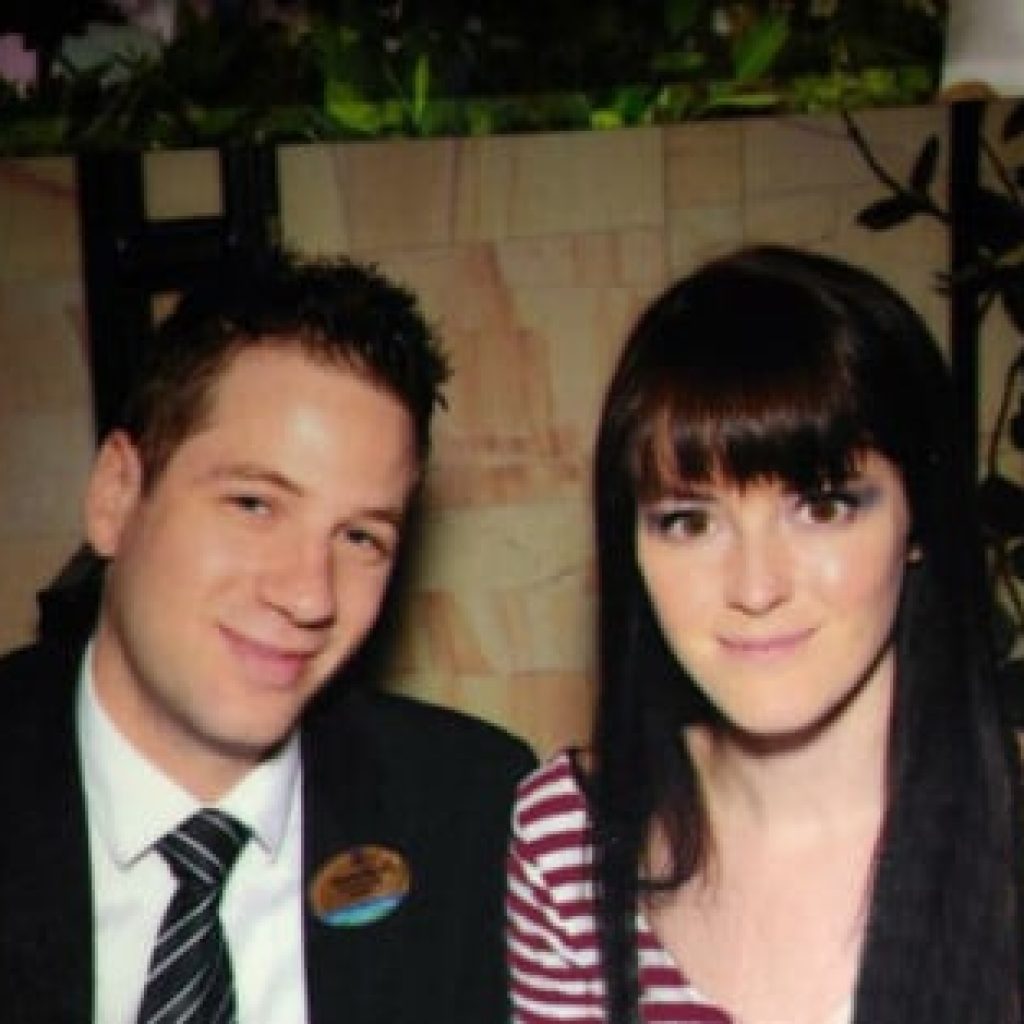
Many of our Park West collectors develop friendships with the art teams over the course of their land or sea vacations. Here's a chance to get to know them more as they share their favorite adventures in the art world. Travis Rizzo, principal auctioneer, is from Sault Ste. Marie, Ontario, Canada. Before becoming an auctioneer, […]
The post Auctioneer Spotlight: Travis Rizzo and Liezel van Heerden appeared first on Park West Gallery.
]]>
Many of our Park West collectors develop friendships with the art teams over the course of their land or sea vacations. Here's a chance to get to know them more as they share their favorite adventures in the art world.
Travis Rizzo, principal auctioneer, is from Sault Ste. Marie, Ontario, Canada. Before becoming an auctioneer, he completed studies in philosophy and psychology at Laurentian University. Liezel van Heerden is from Barberton, South Africa where she enjoyed a career as a realtor. Now, as international art dealers, they have both found the day-to-day excitement they were seeking, as well as each other.

Travis and Liezel celebrating their back-to-back birthdays together for the first time. Photo credit: Tavis Rizzo
Previous ships as Auctioneer: Carnival Cruise Lines Imagination, Celebrity Constellation, Holland America (HAL) Noordam, HAL Nieu Amsterdam, Princess Cruises Ruby Princess, Royal Caribbean (RCI) Quantum of the Seas
Current ship: RCI Oasis of the Seas
What do you like most about being an auctioneer?
Travis: I love seeing how happy people are when we help them. Art can be emotional for some people and I have heard so many stories over the years about the lives of clients and who they are all through art. Some of the friendships we have had over the years with the people we have met onboard have been amazing and long lasting. I would not label my career as a job, but rather an experience I will never forget.
Who is your favorite Park West artist and why?
Travis: I would say Linda Le Kinff is my favorite artist in the Park West family. The way that she uses line and the bold colors she creates is special to me. I happen to love Amedeo Modigliani and Le Kinff's work has aspects of Modigliani in it that I cannot resist. Also, I have collected several artworks by Scott Jacobs, Andrew Bone, Anatole Krasnyansky and Peter Max.
Liezel: My two favorites are Peter Max and Rembrandt. I absolutely love the manner in which Max depicts the Statue of Liberty. While in South Africa, I often heard the saying, "Land of the free, home of the brave," but at the time the words never really meant anything to me. It was only when I came to the States and experienced the opportunities and freedom of America that his works really started to resonate with me. Then, of course, there's Rembrandt! I am mesmerized by the technical ability that Rembrandt shows in his etchings. Not only was he a master, but he also managed to capture the emotional aspects of all his subjects.
What is your favorite guest memory?
Liezel: We built a great relationship with a couple, and on the last night found out that it was his birthday. Needless to say, there wasn't any time to get him something meaningful and special. We thought long and hard, and finally Travis suggested that I give him my Dominic Pangborn pen. When the guest opened his gift he found it rather ironic as he collected pens and had a special cabinet built in his office for his collection. A couple of days later, we received a photograph from him placing the Pangborn pen in his collection.
What has been your favorite port?
Liezel: By far, St. Petersburg, Russia. Travis and I celebrate our birthdays on the 18th and 19th of August. Travis surprised me with tickets to see the Russian ballet. Just when I thought it couldn't get any better, he arranged for us to be escorted to a world-famous roof top restaurant in St. Petersburg. It was absolutely perfect, almost like a fairy tale, with the sun setting and beautiful ancient cathedrals in the background.
What is like to work on one of the largest cruise ships in the world?
Liezel: In 2010, I remember leaving my small town as an only child who had never traveled out of the country by herself. I have to admit that I was rather scared, yet super excited. At first the experience was tough, but I persevered and slowly started making my way to bigger ships. When I met Travis, our ship often docked with the Oasis and we dreamed about being auctioneers on one of the largest cruise ships in the world. With his guidance and training, we became an incredible team and our dreams turned into reality.
Travis: Liezel and I come from small towns on different sides of the planet. We both found each other through Park West Gallery and have grown with each other. We are at a surreal place right now in our careers. All the hard work that we put into growing and developing has started to pay off. This experience just keeps getting better and I don't know how we are going to be able to top this at any point in our lives.
Auctioneer Spotlight
The post Auctioneer Spotlight: Travis Rizzo and Liezel van Heerden appeared first on Park West Gallery.
]]>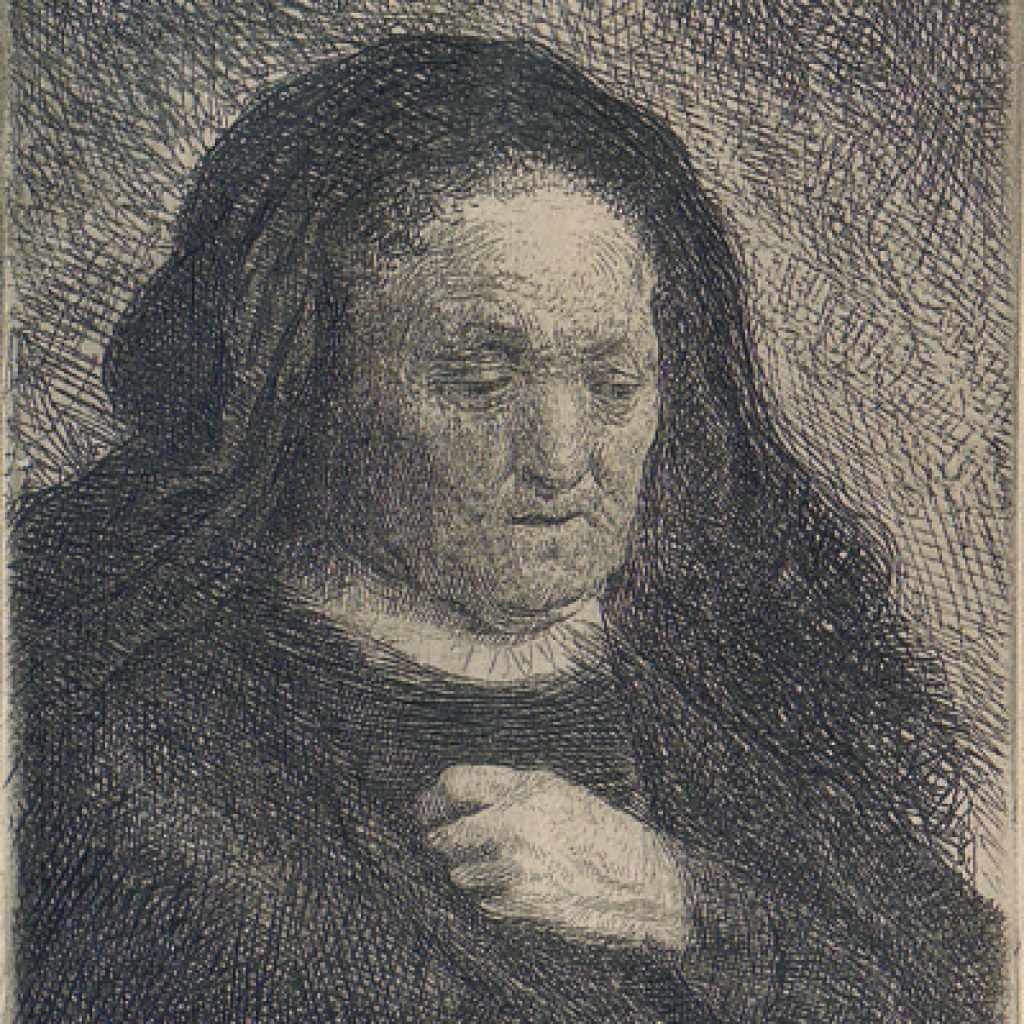
Wingate University is celebrating a donation of Rembrandt and Peter Max art that was originally acquired through Park West Gallery. The Charlotte Observer reports that on Jan. 22, the university revealed that Dr. Lee Bates and his wife, Dawn, donated seven Rembrandt works as well as artwork from iconic pop artist Max. "What a marvelous […]
The post Dentist donates Rembrandt, Max art from Park West Gallery appeared first on Park West Gallery.
]]>
"Artist's Mother with her Hand on her Chest" by Rembrandt.
Wingate University is celebrating a donation of Rembrandt and Peter Max art that was originally acquired through Park West Gallery.
The Charlotte Observer reports that on Jan. 22, the university revealed that Dr. Lee Bates and his wife, Dawn, donated seven Rembrandt works as well as artwork from iconic pop artist Max.
"What a marvelous contribution Dr. Bates and his wife have made," university spokesman Jeff Atkinson said Friday (Jan. 23). "I've never seen a real Rembrandt, and now we'll have seven."
According to the article, Bates was inspired to start collecting art when he was on a cruise to Bermuda in 2005. He attended an onboard art auction where he acquired a photo of Muhammad Ali with the Beatles that was signed by Ali. From there, he "got caught up in the auction" and acquired the Rembrandts.
The Rembrandts were part of 2,500 Millennium Impression etchings created between 1998 and 2008. The copper plates themselves were created and signed by Rembrandt, and in 2003 Park West Gallery purchased the plates and the Millennium Impressions.
Many of the Millennium Impressions are sold out and can only be found in private collections or galleries.
The etchings donated to the university include: "Self Portrait at a Window," "Bust of a Man Wearing a High Cap," "The Golf Player," "The Card Player," "Artist's Mother with Hand on Her Chest," "Christ and the Woman of Samaria" and "Landscape with a Cow."
The article does not specify which Max artwork was donated, but Bates did keep the Ali/Beatles photo for himself.
The artwork hung in his dentist office, located across the street from the university, until he sold his 22-year-old business in June. Bates said very few people and patients realized they were Rembrandt etchings. He decided the artwork should be donated to the museum following their daughter's graduation from the university.
The art donation was made over the summer, but the artwork was first displayed on Jan. 27 in the Helms Gallery at the Battle Center.
The post Dentist donates Rembrandt, Max art from Park West Gallery appeared first on Park West Gallery.
]]>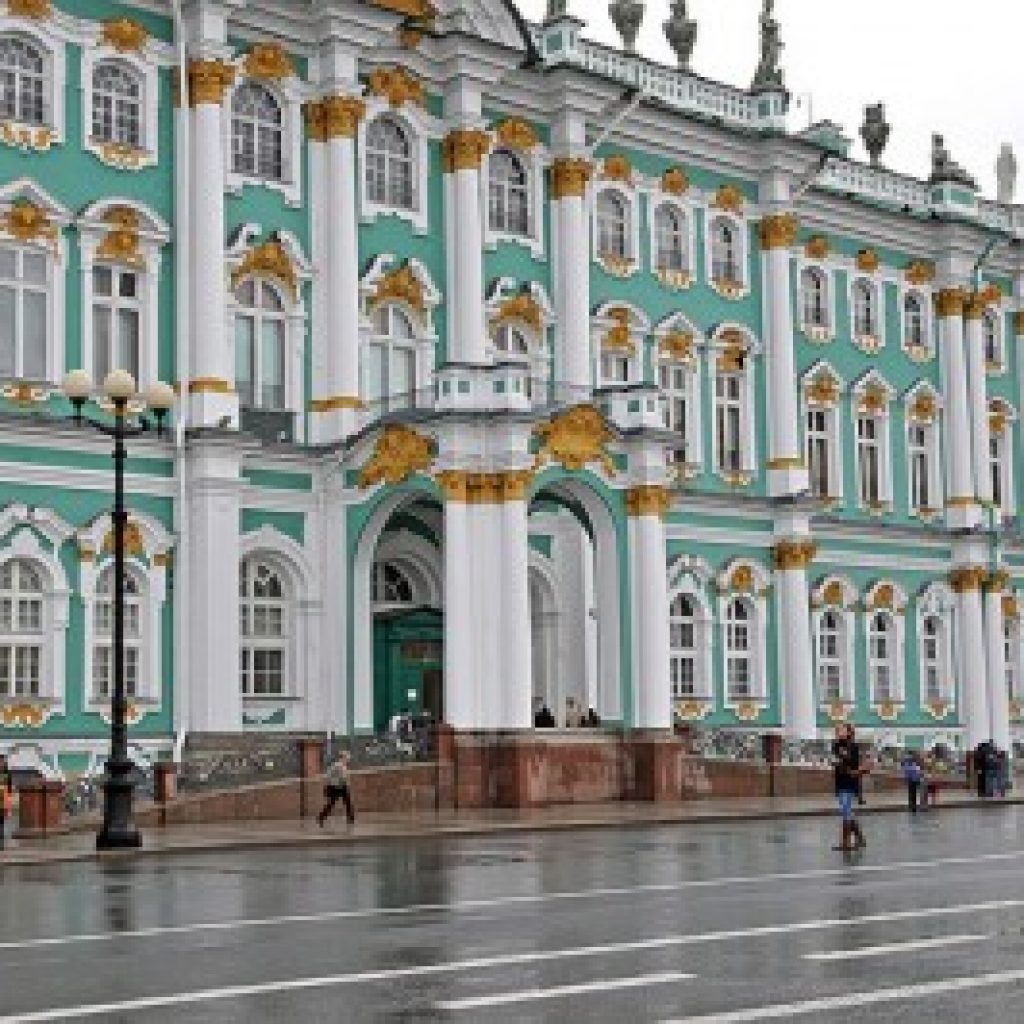
Park West Gallery loves art and travelling so we have compiled a list of our top ports to experience world-class art. Below are seven ports that are home to exceptional works of art—all within a 20-minute drive from the cruise terminal. 1. St. Petersburg, Russia St. Petersburg is the second largest city in Russia […]
The post Top 7 Ports for Art Lovers appeared first on Park West Gallery.
]]>
Park West Gallery loves art and travelling so we have compiled a list of our top ports to experience world-class art. Below are seven ports that are home to exceptional works of art—all within a 20-minute drive from the cruise terminal.
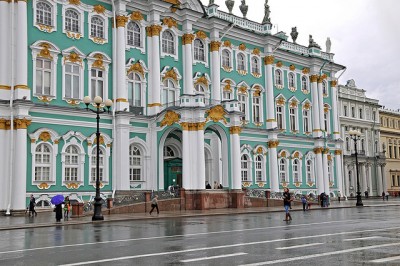
The State Hermitage Museum in St. Petersburg. Photo Credit: Dennis Jarvis
1. St. Petersburg, Russia
St. Petersburg is the second largest city in Russia and a popular stop on the Baltic cruises. Though the city was founded in 1703 and is relatively young, it is already known for its rich art scene.
The biggest art attraction is the prestigious State Hermitage Museum which is regularly ranked as one of the top 10 museums in the world. It has a collection of over 3 million works of art and world culture artifacts, including the largest collection of paintings in the world. If you want to study Russian art more in depth, venture over to The Russian Museum. The collection spans almost two and a half centuries featuring an outstanding representation of Russian figurative art. Looking for something a little more modern? On your way back to the ship, head over the Erata Museum and Galleries of Contemporary Art. It's Russia's largest private museum of contemporary art.
2. Barcelona, Spain
Barcelona has been home to many great artists over the years. They have visually left their mark on Barcelona and a few of the more prominent artists have even had museums built to commemorate their achievements.
The Picasso Museum's emphasis is on his formative years as an artist in Barcelona. If you admire Picasso's work, this a must-see stop that will further enrich your understanding of his later movements. In addition, the Picasso Museum is one out of the seven museums and institutions that own a complete set of the "347 Series." Another artist that has his own museum in Barcelona is Joan Mirό. The Fundaciό Joan Mirό has over 14,000 works of art. Also, you can view Mirό sculptures at the Parc de Joan Mirό. Other museums that are worth a visit are the National Art Museum of Catalonia, well-known for its Romanesque and Gothic art collections, and the Museu Europeu d'art Modern, a smaller museum of contemporary works.
3. Amsterdam, Netherlands
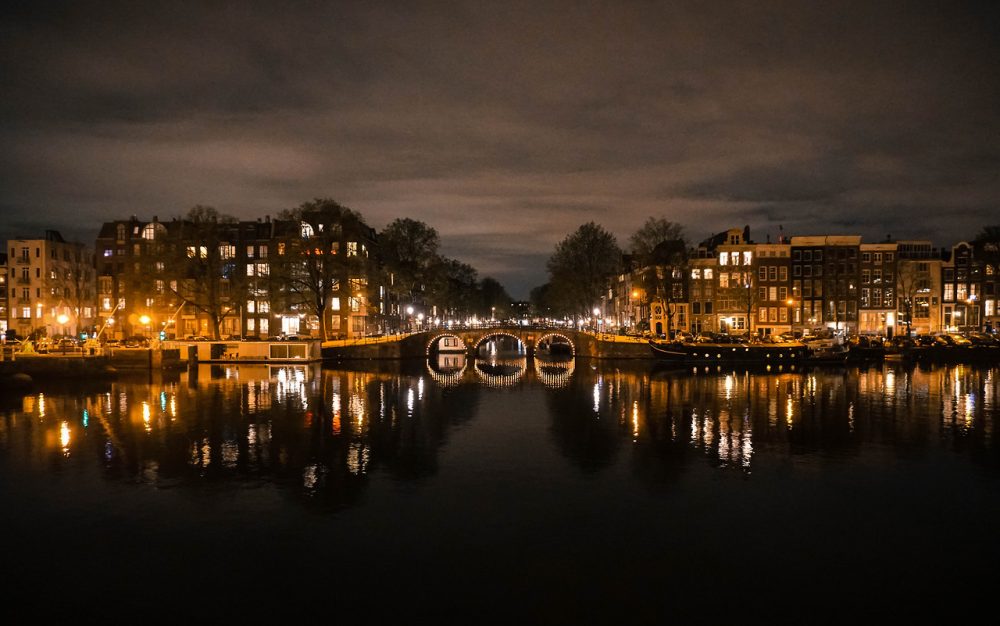
Amsterdam's canals transport you to a bygone era so it is not surprising that the city contains a multitude of works by old masters.
The Rijksmuseum reopened the main building in 2013 after a massive renovation. Here, you can view artworks from Vermeer, Rembrandt, and Hals. If you would like to learn additional history about Dutch masters, you can visit the actual house Rembrandt resided in between 1639 and 1658. They even give demonstrations on etching. Moving forward in time to post-impressionism, the Van Gogh Museum displays some of his popular works including "The Bedroom, 1888" and "Sunflowers, 1889." Also, in Museum Square is the Stedelijk Museum that exhibits modern and contemporary art. Lastly, if you miss the State Hermitage Museum in St. Petersburg, you have an opportunity to visit their branch in the Netherlands, Heritage Amsterdam.
The Charles Engelhard Court at the Met. Photo credit: Phil Roeeder
4. New York City, NY
There are several possible cruise terminals when visiting New York City. However; if your ship is in the Manhattan Cruise terminal they city's prestigious museums are a short cab, or subway, ride away.

The Upper Eastside has several museums that are just blocks away from each other, earning the title Museum Mile. The Metropolitan Museum of Art, the largest art museum in North America, is located on the west side of 5th Avenue. It could take a whole day just to explore its maze of rooms. The east side of 5th Avenue is home to the Solomon R. Guggenheim Museum, focusing on international art from late 1800s to present day in a space designed by Frank Lloyd Wright; and the Neue Galerie, home to Gustav Klimt's portrait of Adele Bloch-Bauer. Down the street, just outside of Museum Mile, is The Frick Collection which houses Henry Frick's personal collection of old masters including Bellini, Goya, and Rembrandt. Beyond 5th Avenue, there is the cutting-edge Museum of Modern Art and the new Whitney Museum of American Art which is currently being relocated downtown and will reopen May 1. 2015.
5. Villefranche-sur-Mer (Nice), France
Villefranche-sur-Mer is the port of entry for cruise ships; however, picturesque Nice is a short drive away. The light and scenery attracted many artists to this coastal town in the 20th Century.
Henri Matisse and Marc Chagall both resided in the area in their later years and each have a museum in their honor. The Musée Matisse original collection consisted of artwork that Matisse donated himself from his local studio-apartment. While Marc Chagall was still alive, he decided where to hang each work of his art in the Musée National Marc Chagall. In addition, the museum is known for the numerous works containing biblical images in its collection, including the Bible Series etchings. Visitors can view Matisse and Chagall's artistic forefathers at the Fine Arts Museum, also known as Musée de Beaux-Arts, as well view the movements that the artists paved the way for at the Museum of Modern and Contemporary Art.
6. Sydney, Australia
Sydney has two cruise terminals, both of which are conveniently located right downtown. When in port you will not only see famous landmarks like the Sydney Opera House, but you are minutes away from two exceptional, though contrasting, museums.
The Art Gallery of New South Wales is a much bigger institution than its name may convey. The large rooms in the classical building contain a vast collection of artworks spanning over centuries. Visitors especially enjoy the Aboriginal and Torres Strait Islander galleries. Right next to the Circular Quay dock is the Museum of Contemporary Art. This museum strives to have ground-breaking exhibits from international contemporary artists. As part of its permanent collection, the museum has numerous powerful Aboriginal artworks. Both museums can brag about their gorgeous views. The Art Gallery of New South Wales overlooks the Sydney Harbor and the Museum of Contemporary Art has the Sculpture Terrace on the top floor next to the dock.
The historic waterfront, Nyhavn, in Copenhagen, Denmark. Photo credit: Michelle Vetovitz
7. Copenhagen, Denmark
Copenhagen is a blend of new and old. It has a mixture of architecture from different periods since much was rebuilt in the 1700s after damage from the plague and several fires. Today, as a European financial center, the city attracts a diverse population.
The National Gallery is representative of its turbulent past with a collection that spans over 700 years. The original collection consisted of the collections acquired by the Danish monarch. Now, the collection has expanded to include avant-garde, contemporary works. In contrast, the Hirschsprung focuses on a much smaller time frame, the 19th Century to the early 20th Century, and the art is displayed in an intimate, home-like setting. Besides having museums that represent the visual past and present, The David Collection exhibits art that represents the varied cultural make-up of the city. This museum has three collections: European 18th century art, Danish early modern art, and Islamic art. The latter is actually its largest and most popular collection.
The post Top 7 Ports for Art Lovers appeared first on Park West Gallery.
]]>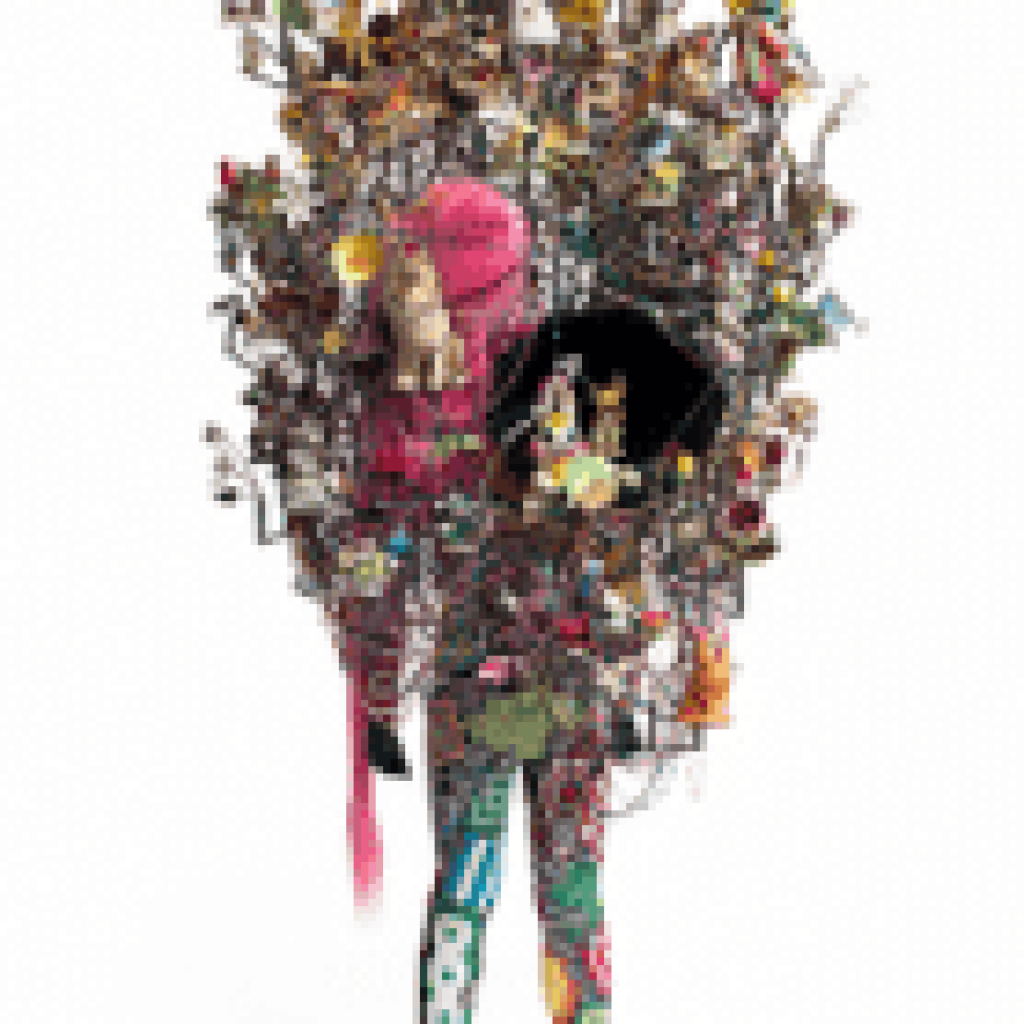
A few local art exhibits worth checking out this weekend.
The post Around Town: Rembrandt at the DIA, Cranbrook's Grand Reopening, U of M's 'Face of Our Time' appeared first on Park West Gallery.
]]>
Need a break from stressful holiday shopping? Here are a few local art exhibits worth checking out this weekend. And if you're in the neighborhood, stop by for a visit! Park West Gallery will be open Friday, 9am – 6pm and Saturday, 11 am – 6 pm (map).
NO OBJECT IS AN ISLAND: NEW DIALOGUES WITH THE CRANBROOK COLLECTION
The first exhibition in the Cranbrook Art Museum's newly redesigned building highlights works once forgotten in closed storage. Pieces by 50 leading contemporary artists and designers are juxtaposed in challenging ways, providing insightful pairings to depict their similarities. Museum director and co-curator, Gregory Wittkopp, notes that some of these pieces have never been on display before, making this an exhibition you don't want to miss.
When: Nov. 11, 2011 – March 25, 2012
Where: Cranbrook Art Museum
Website: www.cranbrookart.edu/museum
FACE OF OUR TIME
Five photographers – Jacob Aue Sobol, Jim Goldberg, Zanele Muholi, Daniel Schwartz, and Richard Misrach – document five different perspectives on contemporary culture. From Sobol's interpretations of life in the Arctic to Misrach's photographs in the aftermath of Hurricane Katrina, each artist sheds light in a discerning, provoking way, commenting on the development of pop culture today.
When: Nov. 12, 2011 – Feb. 5, 2012
Where: University of Michigan Museum of Art
Website: www.umma.umich.edu
REMBRANDT AND THE FACE OF JESUS
For the first time ever, 64 of Rembrandt's paintings, prints, and drawings come together in a study of the artist's unique style as he depicts the face of Jesus. Against the grain for his time, Rembrandt humanized Christ in the mode of popular 17th century culture, rather than representing him in the popular, glorified manner, as a chiseled Greek god. In this series, guests will have the ability to follow Rembrandt's progress through the years, beginning with a heroic, godlike representation then shifting to his break with tradition.
When: Nov. 20, 2011 – Feb. 12, 2012
Where: The Detroit Institute of Arts
Website: www.dia.org
To learn even more about the artist and his work, visit the Park West Gallery Rembrandt Collection at http://rembrandt.parkwestgallery.com.
The post Around Town: Rembrandt at the DIA, Cranbrook's Grand Reopening, U of M's 'Face of Our Time' appeared first on Park West Gallery.
]]>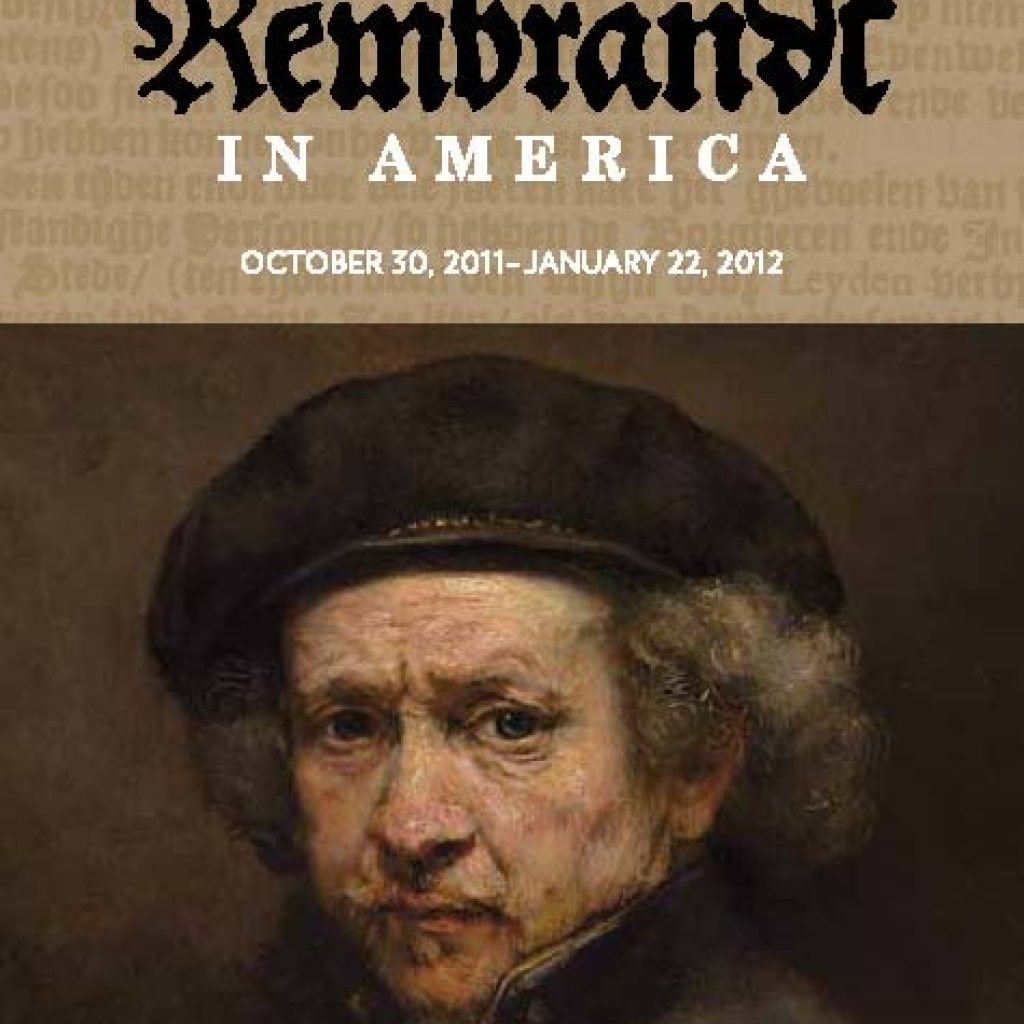
On loan from Park West Gallery, Rembrandt's "Self Portrait Drawing at a Window" is now on view at the North Carolina Museum of Art.
The post 'Rembrandt in America' at the North Carolina Museum of Art appeared first on Park West Gallery.
]]>
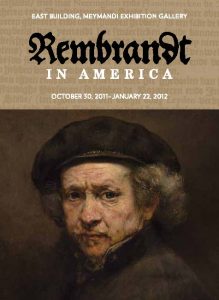
In June of 2009, Park West Gallery and the family of its founder and CEO, Albert Scaglione, placed on loan eight original Rembrandt copper plates along with a set of the etchings printed from them (known as the "Millennium" editions), to the North Carolina Museum of Art in Raleigh. NCMA was chosen for this loan as these eight copper plates and 70 other surviving Rembrandt copper plates had been deposited on loan there years ago after they were purchased by Dr. Robert Lee Humber in 1938.
The "Self Portrait Drawing at a Window" etching from the Park West loan is now on display and featured in the current exhibition, "Rembrandt in America" which runs until January 22, 2012 in the East Building Meymandi Exhibition Gallery. The eight original copper plates have been installed since 2009 in the Circle of Rembrandt Gallery in the West Building and are regularly there on display. NCMA and its fellow organizers, the Cleveland Museum of Art and the Minneapolis Institute of Arts, according to its exhibition announcement, "Have assembled a diverse yet representative group of pictures highlighting issues associated with the collecting and connoisseurship… of Rembrandt paintings in America."
"Park West was delighted to bring the 'Millennium' copper plates back to Raleigh and the museum was delighted to receive the loan," said Morris Shapiro, Park West Gallery Director and the individual who hand-carried the plates from the printer's studio in New York to the museum in 2009. "It was one of the highlights of my career to bring these historical treasures from the hands of the master printer who had printed the 'Millennium' edition, and place them back into the hands of the museum from where they had rested for so many decades. It's wonderful that so many people have had the opportunity to view the original copper plates and now to see this important etching in this exhibition."
For more on the "Rembrandt in America" exhibition, visit http://ncartmuseum.org/exhibitions/rembrandt or download the exhibition gallery guide (pdf)
For more on the "Millennium Edition" etchings and the Park West Gallery Rembrandt Collection, visit http://rembrandt.parkwestgallery.com
The post 'Rembrandt in America' at the North Carolina Museum of Art appeared first on Park West Gallery.
]]>The post Park West Rembrandt House Tour – Part Three appeared first on Park West Gallery.
]]>The final part of the Park West Gallery Rembrandt House Tour is perhaps the most informative. Few people know that Rembrandt was a master etcher of his time and worked tirelessly to revolutionize the medium of etching.
During part three of the tour, join Park West Gallery Director Morris Shapiro for a demonstration of Rembrandt's process, using the actual tools and materials utilized by the artist in his day to create his sublime etchings.
WATCH PART 1 » | WATCH PART 2 »
Related Links:
The post Park West Rembrandt House Tour – Part Three appeared first on Park West Gallery.
]]>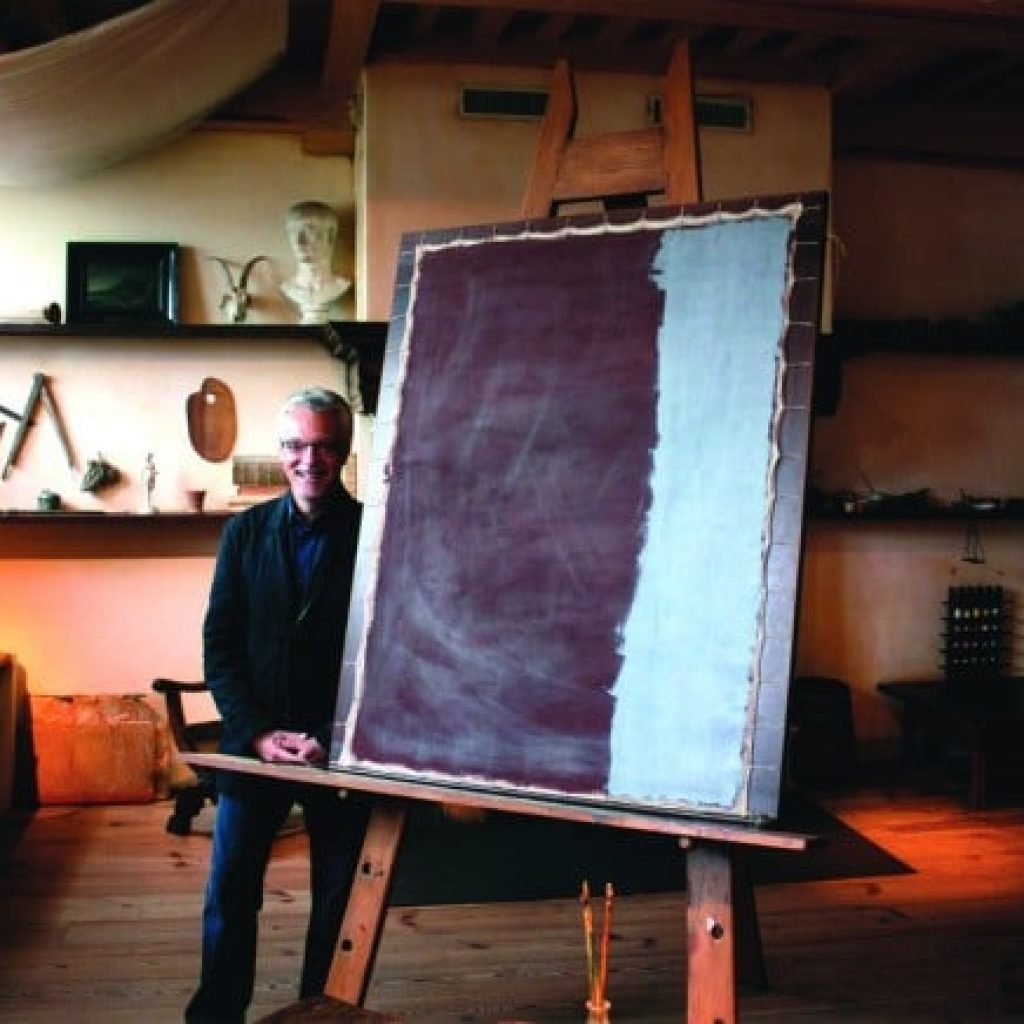
Park West President, Marc Scaglione; Gallery Director, Morris Shapiro and staff escorted approximately 70 Park West clients through a private tour of the house in Amsterdam in June.
The post Park West Visits Rembrandt House in Amsterdam – Part 2 appeared first on Park West Gallery.
]]>
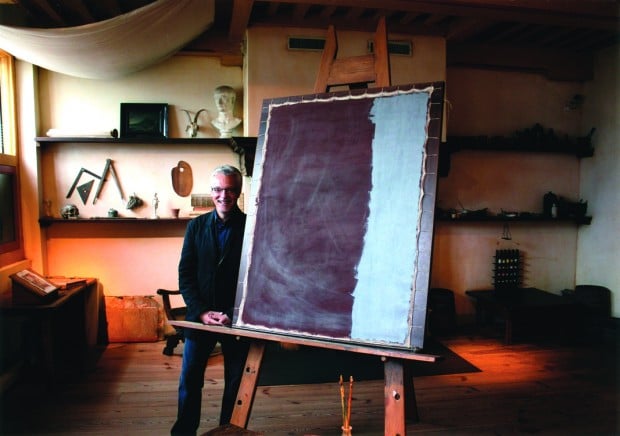
Park West President, Marc Scaglione; Gallery Director, Morris Shapiro and staff escorted approximately 70 Park West clients through a private tour of the house in Amsterdam in June.
Included in the tour were visits to Rembrandt's painting studio (see photo above), his meeting room for his clients, bedroom, kitchen, cabinet, printing room for etchings and a gallery featuring a part of the Rembrandt House etching collection (which includes over 300 etchings). The house located on Jodenbreestraat, which coincidentally was built in 1606, the same year Rembrandt was born, was purchased in 1906 by a foundation set up to establish the museum which was opened three years later.
The Rembrandt House is a "reconstruction" of his living and working environment, as Rembrandt's possessions were liquidated in his bankruptcy of 1656. However, due to the meticulous inventory prepared by the bankruptcy court and Rembrandt's own drawings of his home and studios, the house has been reassembled with painstaking detail and reproductions of 17th century furniture, tools, painting materials and even a hand-turned flat bed etching press.
"It's hard to really appreciate the substantial genius Rembrandt possessed," says Morris Shapiro. "When one has the opportunity to observe his living and working spaces, examine the kinds of tools he used, and stand in the room where some of the greatest paintings created in the history of art were born, one can begin to absorb what he accomplished.
"For me, as a life long devotee to art history and deep fan of Rembrandt's paintings and prints, to stand in that space was a special moment. Just to see the types of limitations he overcame everyday is astonishing—he had to mix and create his own paints; he stored them in pig's bladders to keep them from drying up.
"In the photo of me in the painting studio, you can see a window behind me at the top left. Rembrandt would manipulate the drapery lifted above that window to control the amount of light that would illuminate his model. His use of light is of course legendary and Rembrandt is synonymous with the notion of 'chiaroscuro,' the strong and dramatic contrast of light and shadow, so experiencing that space and comprehending his method was such a powerful experience for me, and one that I will never forget. I am so glad we were able to share the experience with some of our clients."
In 2008, Shapiro and Marc Scaglione were toured through the Rembrandt House by Leonore van Sloten, Assistant Curator of the museum and their tour was videotaped. Included in the video is a demonstration of the process Rembrandt used to print his etchings, and an etching plate is printed on a reproduction of a 17th Century etching press in the manner Rembrandt used.
WATCH PART 1 » | WATCH PART 3 »
Related Links:
The post Park West Visits Rembrandt House in Amsterdam – Part 2 appeared first on Park West Gallery.
]]>The post Take the Rembrandt House Museum Video Tour appeared first on Park West Gallery.
]]>Part One (which can be viewed below) explores the living and business areas. Stay tuned for parts two and three of this fascinating video series…
Join Park West Gallery President Marc Scaglione and Park West Gallery Director Morris Shapiro for a guided tour of the Rembrandt House Museum in Amsterdam. Glimpses into both living and business areas are provided as well as insights into the day-to-day life and activities of the master and his students. In addition to being a painter, Rembrandt was also a master etcher and an art dealer.
WATCH PART 2 » | WATCH PART 3 »
Related Links:
The post Take the Rembrandt House Museum Video Tour appeared first on Park West Gallery.
]]>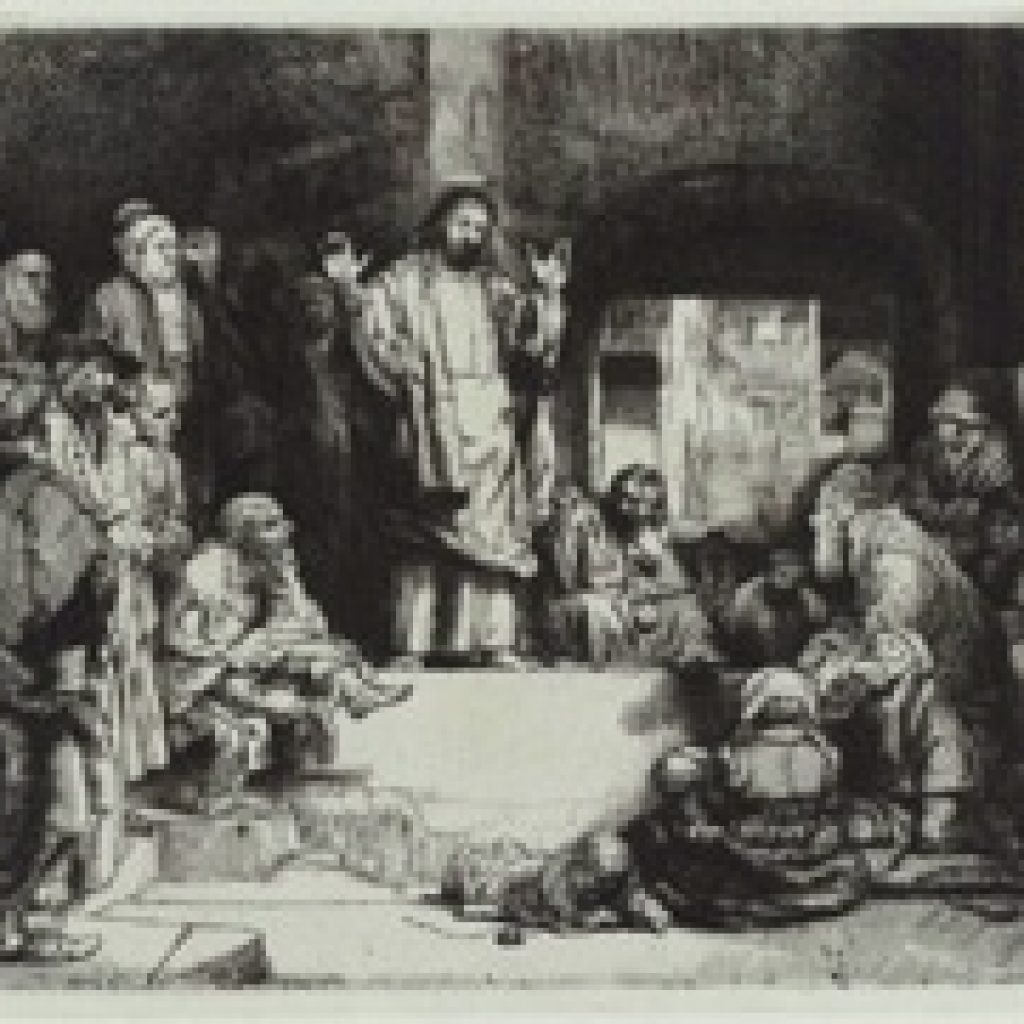
Rembrandt's Recession: Passion and Prints in the Dutch Golden Age features 14 selections representing Rembrandt's illustrious career as a printmaker.
The post Rembrandt's Recession: Passion and Prints in the Dutch Golden Age appeared first on Park West Gallery.
]]>
The Timken Museum of Art in Balboa Park, California had record attendance while featuring its latest Rembrandt van Rijn exhibit, so much so that it extended the exhibit's run date until this Sunday, May 9th. So if you are in the area, be sure to check it out!
Rembrandt's Recession: Passion and Prints in the Dutch Golden Age features 14 selections representing Rembrandt's illustrious career as a printmaker.
Accompanied by a fully illustrated catalog, the exhibition contains some of the artist's best-known prints, including such landmark examples as Christ Preaching (Le Petite Tombe) from around 1652 andThree Crosses from around 1660.
An event has also been added to the Timken's "Art in the Afternoon" series. Museum director John Wilson will give a talk about the financial woes and personal issues that marked and marred Rembrandt's life during the 1650s.
"The images all display Rembrandt's gift as one of the greatest artists of the human condition. All the prints are exceptional impressions and masterpieces of 17th century printmaking by one of the greatest printmakers of all time," said John Wilson, Ph.D., executive director of the Timken Museum of Art. "This is a perfect exhibition for our museum which has long been known for being home to San Diego's only Rembrandt painting on public display."
One of the greatest artists of all time, Rembrandt van Rijn is equally famous for his extraordinarily creative etchings and drawings as his paintings. Rembrandt's Recession: Passion and Prints in the Dutch Golden Age, examines the artist's New Testament subject matter in light of his life and times.
For additional Rembrandt etchings, visit www.parkwest-rembrandt.com to view a selection of prints from the Park West Rembrandt Collection. For over 40 years, Park West Gallery has been a world-wide source for collectors of original etchings by Rembrandt Van Rijn, with its collection including rare 17th century impressions and nearly 700 different posthumous impressions.
Related Links:
The post Rembrandt's Recession: Passion and Prints in the Dutch Golden Age appeared first on Park West Gallery.
]]>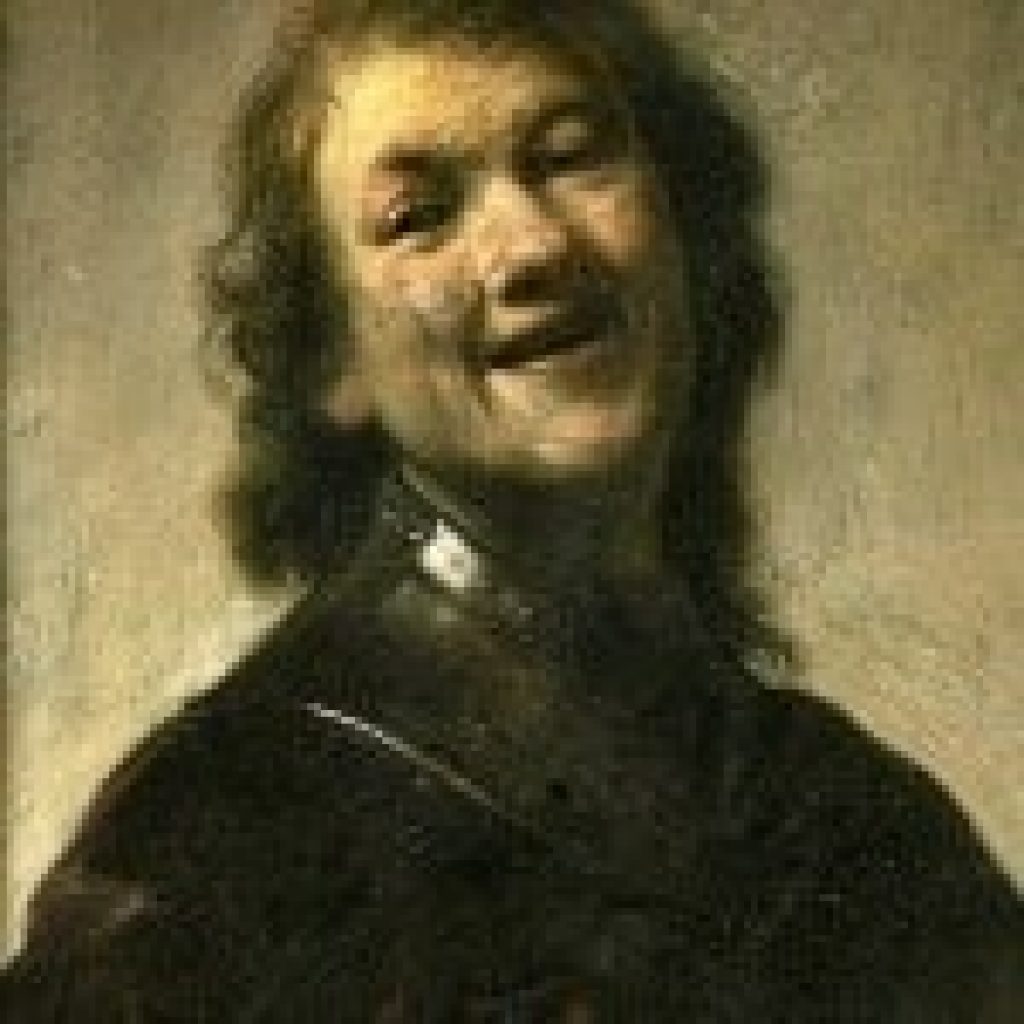
Art historians now know that Rembrandt Laughing is one of the first and most joyful chapters of the artist's autobiography in paint.
The post Rediscovered Rembrandt Painting at Kimbell Art Museum appeared first on Park West Gallery.
]]>
Rembrandt Laughing. Painting by Rembrandt van Rijn. Image courtesy of Dallas Art News.
Rembrandt van Rijn's self-portrait, Rembrandt Laughing, was mistakenly attributed to his older contemporary Frans Hals a century and a half after Rembrandt's death. However, in 2007 the painting made headlines when the English family who owned it for the past 100 years put it up for auction and art dealers in attendance recognized its quality and importance.
Art historians now know that Rembrandt Laughing is one of the first and most joyful chapters of the artist's autobiography in paint, and he painted the work in his home city of Leiden when he was 21 or 22 years old. The painting will be on view at the Kimbell from April 9 until late July as part of the Museum's continuing "Guest of Honor" series.
While Rembrandt is often remembered as a master painter, he is also considered one of the greatest – if not the greatest – etcher of all time. Park West Gallery has been a world-wide source for collectors of original etchings by Rembrandt for over 40 years. For more information on Rembrandt etchings, visit the Park West Rembrandt website.
Related Links:
The post Rediscovered Rembrandt Painting at Kimbell Art Museum appeared first on Park West Gallery.
]]>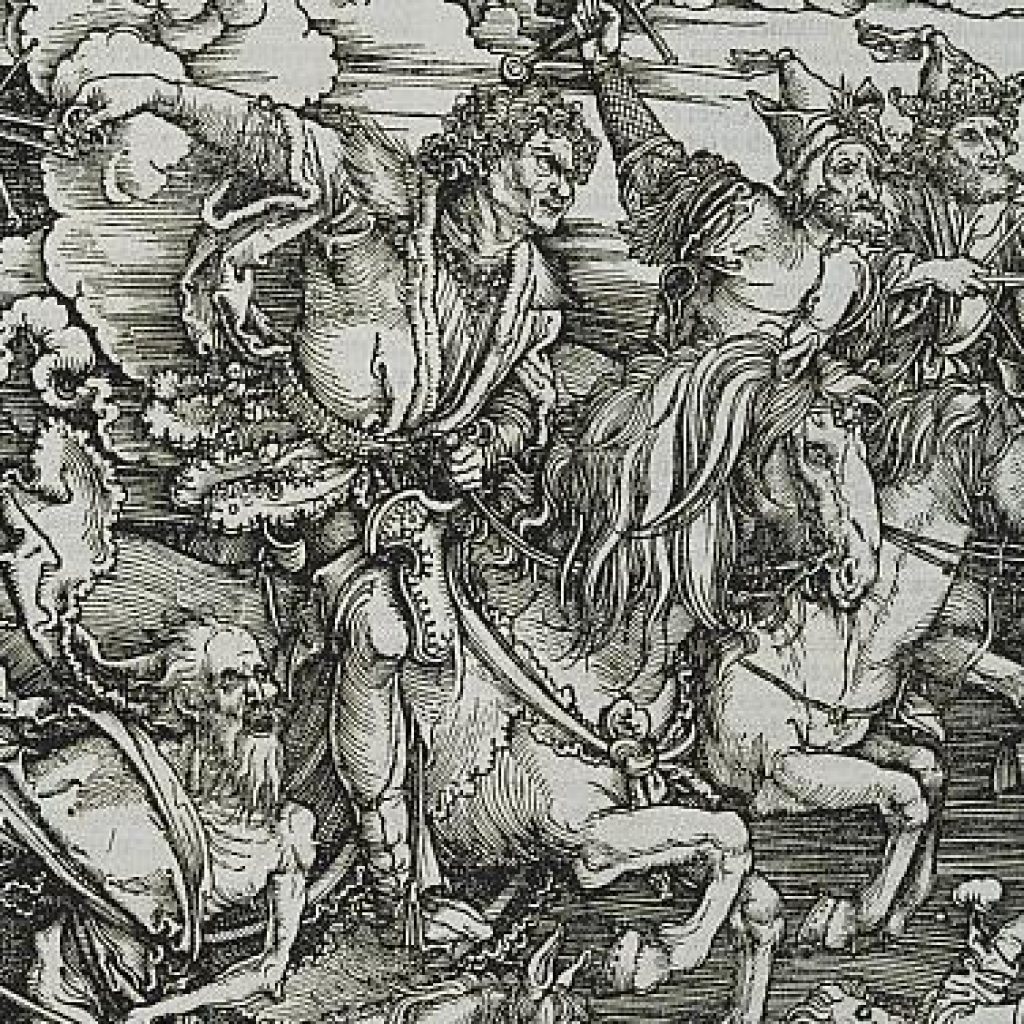
The skills of artists such as Rembrandt van Rijn, Francisco Goya and Albrecht Dürer, are on display in The Printmaker's Art.
The post The Printmaker's Art appeared first on Park West Gallery.
]]>
EDINBURGH — A collection of iconic prints by some of the finest European artists of the past 500 years is on view at the National Gallery of Scotland. The skills of artists such as Rembrandt van Rijn, Francisco Goya and Albrecht Dürer, are on display in The Printmaker's Art , which showcases some of the most beautiful and intricate prints ever made. Exhibit highlights include an impression of Dürer's celebrated woodcut The Four Horsemen of the Apocalypse, and Rembrandt's tour-de-force etching, The Three Crosses.
Albrecht Durer, Park West Gallery, fine art printsDetail from Albrecht Dürer's 'The Four Horsemen of the Apocalypse" from "The Apocalypse: Revelation of Saint John the Divine'" (ca. 1497).
The exhibition website explains:
"Prints are made by drawing onto a surface such as a woodblock, metal plate or lithographic stone, and then transferring the image, using a variety of means, onto a separate sheet of paper. Over the centuries, artists have exploited a diverse range of printmaking techniques to create an array of distinctive effects that cannot be achieved in any other medium. In the process many great artists, such as Blake, Goya and Toulouse-Lautrec, have produced prints that are considered to be among their most brilliant and influential works.
The 30 works on display have been selected not only for their exquisite beauty, but also to trace the development of printmaking techniques over the centuries, and to demonstrate the sophisticated processes that led to their creation."
The Printmaker's Art is on view through May 23.
For more information on this exhibit, please visit www.nationalgalleries.org
As the demand for rare works by the greatest of the Old Masters continues to escalate throughout the world, Park West Gallery is pleased to offer timeless and historic works by some of the most important artists of all time. Please visit the Park West Gallery fine art collection online to view selections by master printmakers including Rembrandt, Goya and Dürer.
The post The Printmaker's Art appeared first on Park West Gallery.
]]>
Rembrandt was a master of manipulating light and shadow to capture the intricate details and nuances of his subjects.
The post Celebrating Shadows, Even On Groundhog Day appeared first on Park West Gallery.
]]>
Today, February 2, 2010, is Groundhog Day!
And in case you haven't heard, Punxsutawney Phil emerged at sunrise in Gobbler's Knob, but unfortunately the little guy saw his shadow. That means we're stuck with six more weeks of winter — can you hear all of us at Park West Gallery (in frigid Michigan) groaning?
Just when the Park West Gallery bloggers were about to curse shadows and wish them out of existence forever, we got to thinking about how shadows can be an essential part of bringing artwork to life, in creating depth and dimension. The artworks of Dutch master Rembrandt van Rijn, for example, are praised for the artist's dramatic use of chiaroscuro (strong contrasts of light and shade).
Rembrandt was a master of manipulating light and shadow to capture the intricate details and nuances of his subjects. In Susan Stamberg's recent NPR broadcast, the dramatic allure of Rembrandt's 400-year-old sketches is discussed:
"I don't know about you, but I walk right past sketches when I'm at a museum. I head for the color: the oils, the big things," Stamberg says. "But in a large, dimly lit show at the Getty Museum in Los Angeles — the lights are down to preserve the 400-year-old works on display — it's the sketches that are the main attraction. That's because the sketches are by Rembrandt, or at least most of them are."
"A sketch," says curator Lee Hendrix, "is putting your thoughts on paper. It was an end in itself. For Rembrandt, drawing was a way to work through subjects. I mean, he was one of the greatest dramatic artists who ever worked," Hendrix continues. "I think of Rembrandt as a kind of Shakespeare."
So despite the bleak forecast, maybe there is a reason to celebrate shadows today…
Related Links:
- Rembrandt Etching Discovered in a University Bathroom
- Authentic Rembrandt Painting Emerges From Hiding
- Rembrandt Invades SoCal…and the Internet
- Rembrandt in Focus at the National Museum Wales
- Park West Gallery Master Sites: Rembrandt van Rijn
The post Celebrating Shadows, Even On Groundhog Day appeared first on Park West Gallery.
]]>The post The Evolution of Printmaking from Masters to Modern Artists appeared first on Park West Gallery.
]]>During the Renaissance, printmakers created woodcuts, engravings and etchings after notable paintings (Read about The Art of Etching at the Park West Gallery | Rembrandt website). Artists began altering compositions and creating prints after their own works and throughout modern art history, masters including Salvador Dali, Pablo Picasso and Henri Matisse, embraced and advanced printmaking techniques. Contemporary artists of today are continuing to develop the field using advanced technology and processes.
Art historian, author, and art critic Joseph Jacobs writes of contemporary artist Itzchak Tarkay's use of printmaking:
"Because they are multiples as opposed to unique works of art, prints, quite mistakenly, are often considered a secondary medium. But in Tarkay's hands it is clear they are not. One look at a work such as In the Lounge, and it can be immediately seen that the artist has a powerful affinity for the physicality of the printer's ink that virtually transforms this silkscreen into a painting. We can see and feel the three-dimensionality of the ink; it is rich and unctuous, like oil paint. We would hardly know that the pigment was squeezed onto the paper through a fine screen as opposed to being applied with a brush.
Tarkay's prints are testimony to the extraordinary technical richness of printmaking and the degree to which it can be transformed into a medium of great personal expression. The artist has turned printer's ink into oil paint, varnish, glazes, watercolor, wash, gouache, graphite, pen and ink, brush and ink, crayon and charcoal. The artist's touch is so prominent, it is hard to believe that for any print there could be another example that is even similar in appearance."
Read the full essay at the Park West Gallery | Tarkay website
In the Footsteps of Masters: The Evolution of the Reproductive Print , a new exhibit at the Figge Art Museum in Davenport, Iowa, examines the role of printmaking in the development of visual culture. Open through May 23, the exhibition covers a span of 500 years, featuring approximately 80 European and American prints from the 15th to the 20th century.
On view are original prints by artists Albrecht Dürer, Jusepe De Ribera, Edouard Manet, Jean-Baptiste Corot, Jean-Honoré Fragonard, William Blake, Francisco Goya and Grant Wood, and others made after the works of famous masters such as Raphael, Peter Paul Rubens, Annibale Caracci, Rembrandt, Jan Vermeer, Jan Van Eyck, Titian, Michelangelo and others.
For more information on this exhibit, please visit www.art-dma.org
Related Links:
- Park West Gallery Master Sites: Rembrandt van Rijn
- Itzchak Tarkay | Park West Gallery
- Albrecht Durer: Virtuoso Printmaker
The post The Evolution of Printmaking from Masters to Modern Artists appeared first on Park West Gallery.
]]>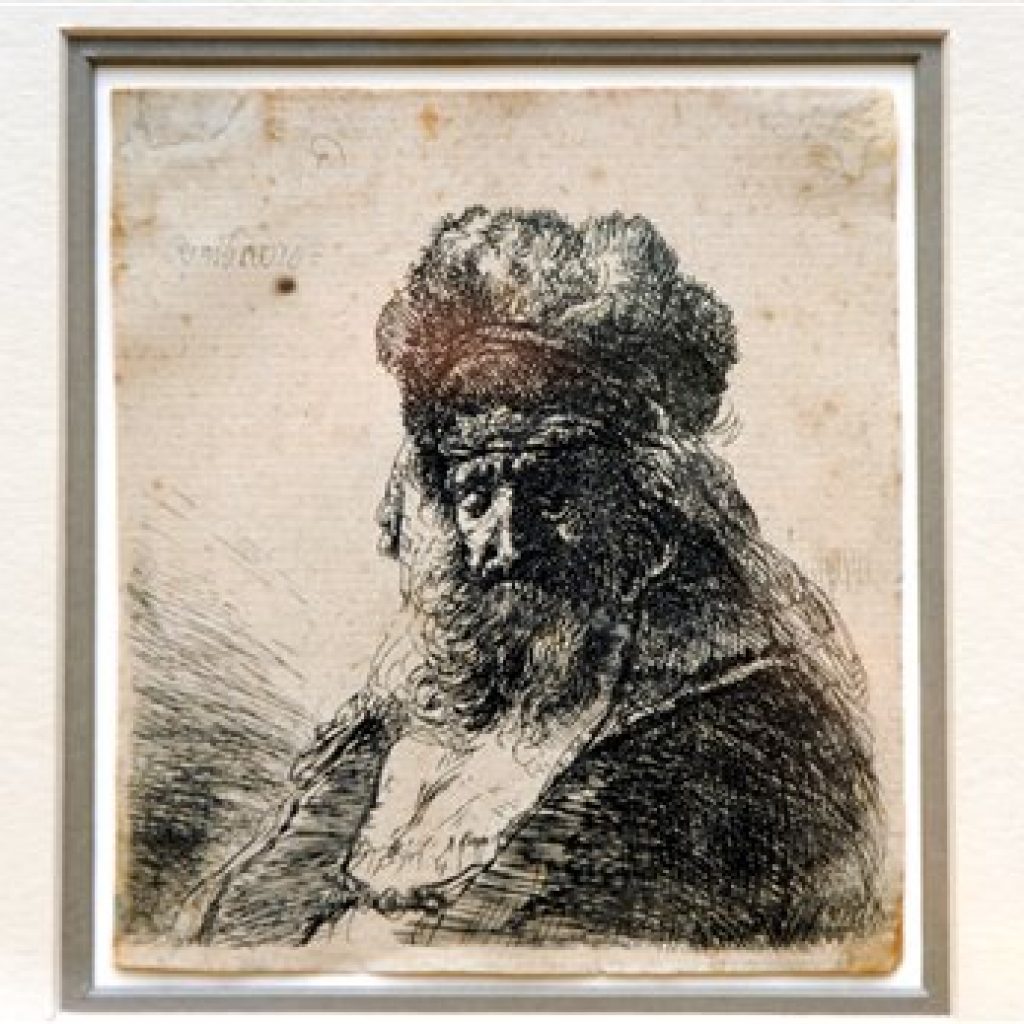
How did an original Rembrandt etching find its way into a bathroom cabinet at The Catholic University of America (CUA) and then for years remain hidden there, obscured from public view?
The post Rembrandt Etching Discovered in a University Bathroom appeared first on Park West Gallery.
]]>
WASHINGTON D.C. — A fun part of collecting artwork from Park West Gallery (from anywhere really) is deciding where the piece should hang to best fit in with your decor. Art is created to be seen, displayed and enjoyed each and every day; not to be tucked away, lost or forgotten. So how did an original Rembrandt etching find its way into a bathroom cabinet at The Catholic University of America(CUA) and then for years remain hidden there, obscured from public view?
This etching by 17th century Dutch master Rembrandt van Rijn was discovered in a bathroom in Nugent Hall at The Catholic University of America. [Credit: AP Photo/The Catholic University of America, Ed Pfuellera]
"I went into the restroom in Nugent Hall and opened a cabinet there," explained CUA's president Rev. David O'Connell, who found the Rembrandt print while searching for paper towels in a university bathroom. "I found the paper towels but as I was closing the cabinet door, I noticed on the bottom shelf under some junk, a picture frame jutting out. I bent down, pulled out the frame only to discover an etching that looked familiar to me. Why it was there or how it got there, I'll never know."
The small 4.5″x5″ etching of a bearded old man contains a handwritten inscription in French on the back of the work which reads: "The bust of an old man with a great beard seen about most of the face. His head a little perched gives him the attitude of a man who sleeps."
CUA archivist Leslie Knoblauch says an appraiser has confirmed the authenticity of the Rembrandt, which is currently the centerpiece of a new exhibit at the university. "We saw his name twice on the piece, but we still couldn't believe that's what this was," Knoblauch told The Washington Post. "Who finds a Rembrandt randomly in their home?"
Fine Lines: Discovering Rembrandt and Other Old Masters at Catholic University is on view through May 21, 2010 and features several other drawings, etchings, engravings and woodcut prints by American and European artists.
To learn more about the exhibit, please visit www.cua.edu
Related Links:
- Authentic Rembrandt Painting Emerges From Hiding
- Rembrandt Invades SoCal…and the Internet
- Major Collection of Rembrandt Etchings and the Artist's Studio on View
- Rembrandt in Focus at the National Museum Wales
- Park West Gallery Master Sites: Rembrandt van Rijn
The post Rembrandt Etching Discovered in a University Bathroom appeared first on Park West Gallery.
]]>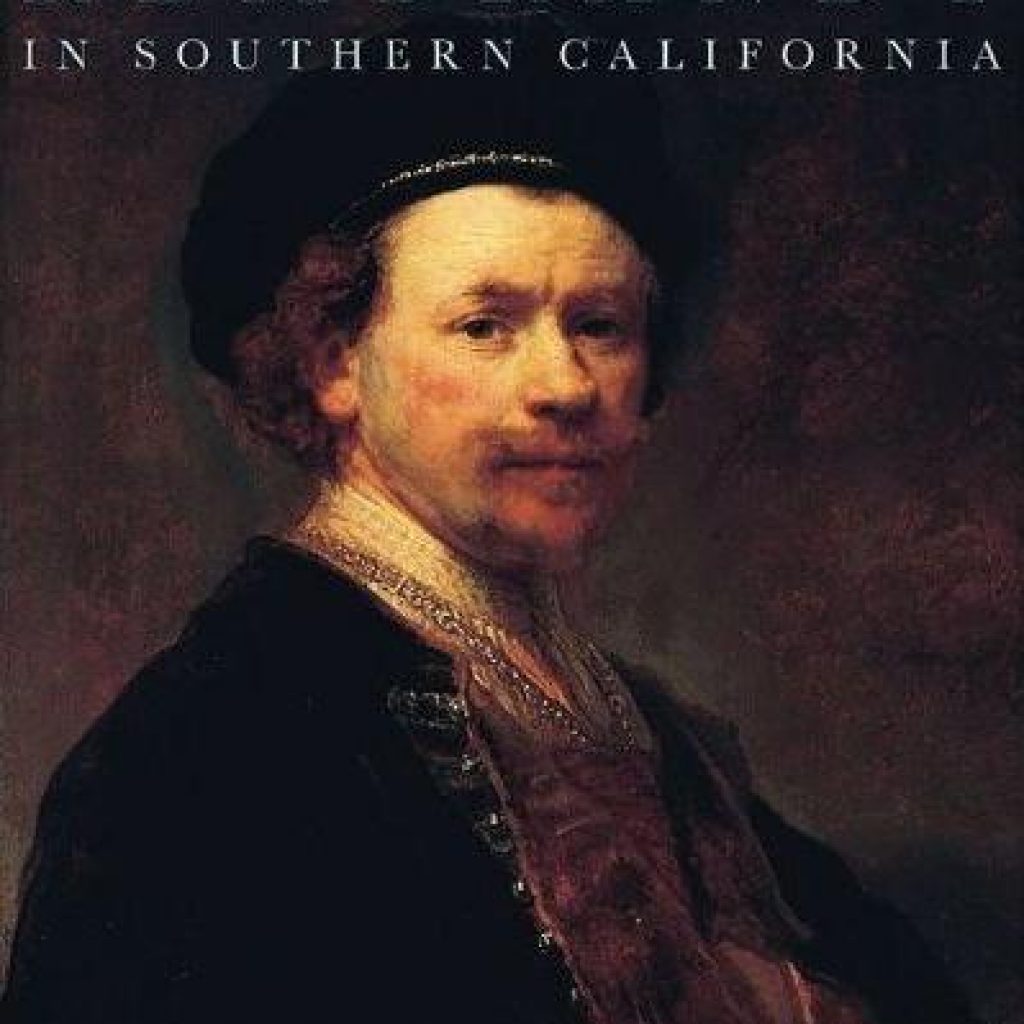
A handful of notable museums in Southern California have created a unique collaborative online exhibition focused on the seventeenth-century Dutch master, Rembrandt van Rijn.
The post Rembrandt Invades SoCal… and the Internet appeared first on Park West Gallery.
]]>

The Rembrandt in Southern California website offers a virtual exhibition of 14 paintings by the artist, with each work of art accompanied by an audio discussion from museum curators and directors. If you can't travel to sunny California, the online guided tour is an exceptional way to learn about the paintings, and with your own virtual docent no less.
Southern California is home to the third-largest assemblage of Rembrandt paintings in the United States. By comparison, the Park West Gallery Rembrandt Collection isn't quite as extensive, but we can certainly attest that launching a website is a really great way to educate the public about art. (You can visit the Park West Gallery Rembrandt website here.)
In addition to coordinating the Rembrandt in Southern California website, the five area museums – the Hammer Museum, the J. Paul Getty Museum, and the Los Angeles County Museum of Art in Los Angeles; the Norton Simon Museum in Pasadena; and the Timken Museum of Art in San Diego – are also offering tours, lectures and exhibits centered around Rembrandt and his peers.
For a full schedule of events and exhibitions, visit www.rembrandtinsocal.org
Related Links:
- Park West Gallery Master Sites: Rembrandt van Rijn
- Rembrandt's People at the Wadsworth Atheneum Museum of Art
- Rijksmuseum Presents Tavern Scenes, Prints and Drawings
- Major Collection of Rembrandt Etchings, Artist's Studio on View
- Rembrandt in Focus at the National Museum Wales
The post Rembrandt Invades SoCal… and the Internet appeared first on Park West Gallery.
]]>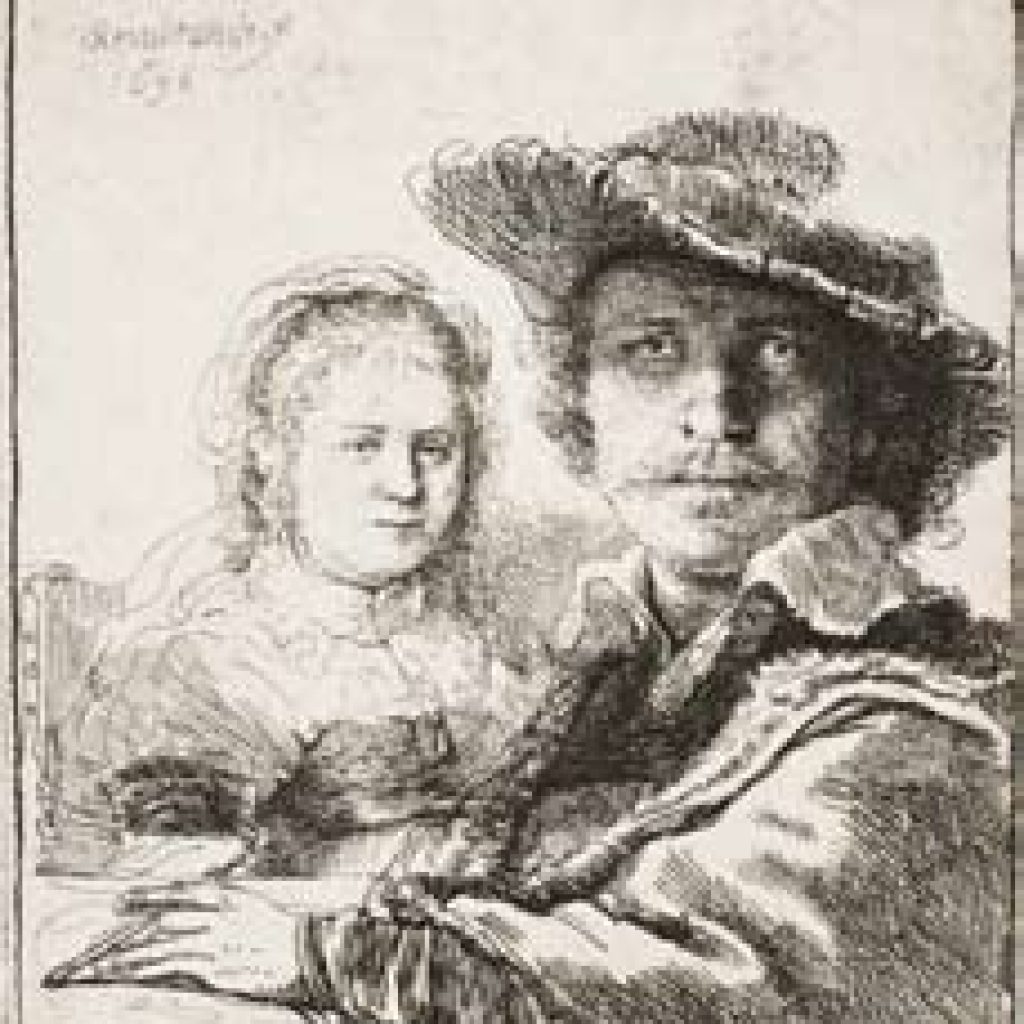
The Norton Simon Museum presents The Familiar Face: Portrait Prints by Rembrandt, an exhibition of 15 etchings by Dutch master Rembrandt van Rijn (1606–1669).
The post Portrait Prints by Rembrandt at the Norton Simon Museum appeared first on Park West Gallery.
]]>
For over 40 years, Park West Gallery has been a world-wide source for collectors of original etchings by Rembrandt Van Rijn, the artist viewed by so many as the greatest etcher of all time. Learn all about Rembrandt and the art of etching at the Park West Gallery/Rembrandt Website >>
PASADENA, Calif. — The Norton Simon Museum presents The Familiar Face: Portrait Prints by Rembrandt , an exhibition of 15 etchings by Dutch master Rembrandt van Rijn (1606–1669). Rembrandt's prominence as a painter of portraits, particularly those of the merchants and burghers of Amsterdam, is well known. But the artist's etched prints also have a place and purpose in recording the visages of his contemporaries. A skilled, innovative printmaker, Rembrandt embraced etching as a means of expression and experimentation. The artworks in The Familiar Face illustrate the artist's keen power of observation as well as his gift for drama and humor.
Culled from the Norton Simon's extensive collection of Rembrandt prints, the artworks on view offer a window to some of the personalities of Rembrandt's age. Although 17th-century Holland had an active trade in the portraits of politicians, heroes and renowned scholars, the majority of portrait prints made by Rembrandt were not intended for such a market. We know this because his prints do not bear the characteristic etched captions identifying the name and public role of the subject.
Together, the 15 works presented in The Familiar Face shed light on Rembrandt's world and introduce us to some of his friends, family members and contemporaries. The exhibition addresses the function of these portrait prints, whether they were commissioned, created at the artist's initiative, or perhaps done as a meditation on the visage of a loved one.
The Familiar Face: Portrait Prints by Rembrandt is now on view through March 22, 2010.
For more information, please visit www.nortonsimon.org
Related Links:
- Park West Gallery Master Sites: Rembrandt van Rijn
- Rembrandt in Focus at the National Museum Wales
- Rembrandt's People at the Wadsworth Atheneum Museum of Art
- The Brilliant Line: Following the Early Modern Engraver
- Major Collection of Rembrandt Etchings, Artist's Studio on View
- Rijksmuseum Presents Tavern Scenes, Prints and Drawings
The post Portrait Prints by Rembrandt at the Norton Simon Museum appeared first on Park West Gallery.
]]>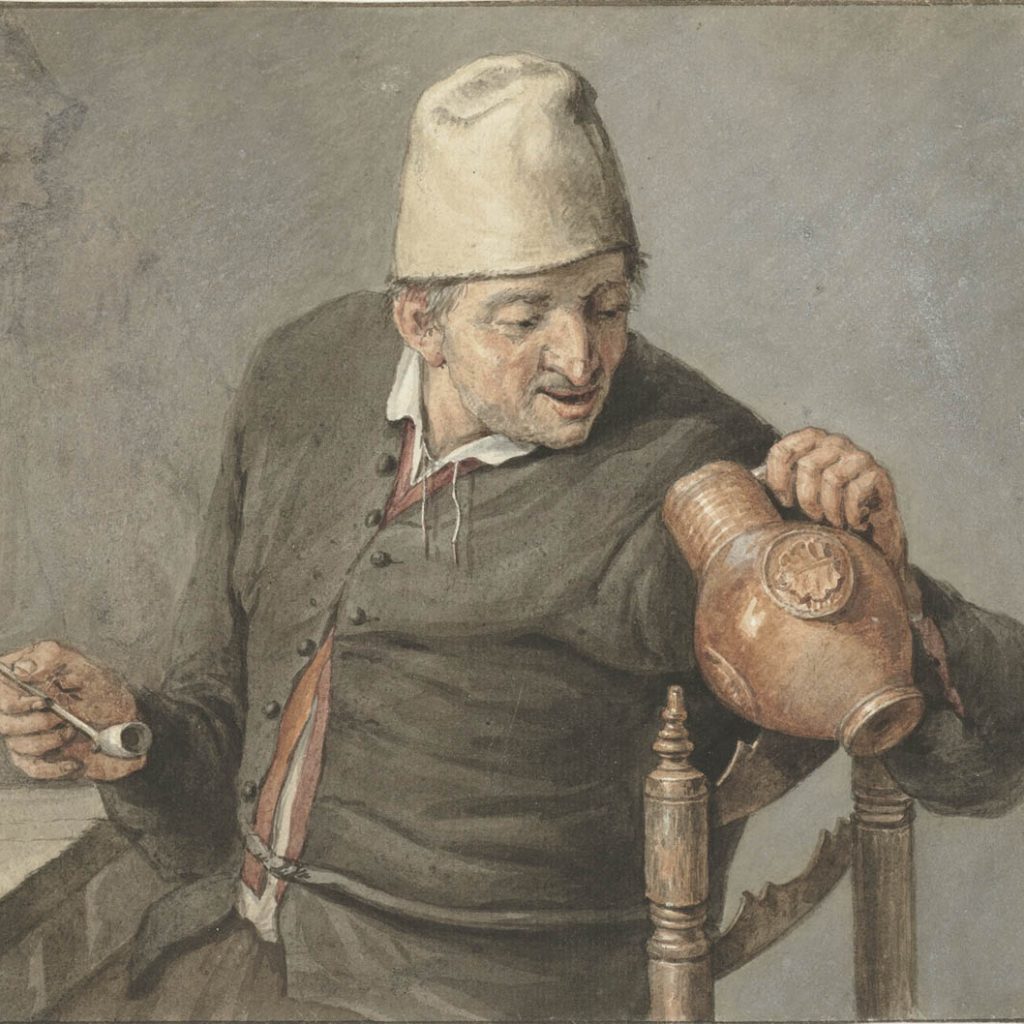
The Rijksmuseum's Tavern Scenes exhibition gives an idea of what it was like to be in a tavern in the 16th and 17th century.
The post Rijksmuseum Presents Tavern Scenes, Prints and Drawings appeared first on Park West Gallery.
]]>
For over 40 years, Park West Gallery has been a world-wide source for collectors of original etchings by Rembrandt Van Rijn, the artist viewed by so many as the greatest etcher of all time. Learn all about Rembrandt and the art of etching at the Park West Gallery/Rembrandt Website >
AMSTERDAM — The Rijksmuseum's Tavern Scenes exhibition gives an idea of what it was like to be in a tavern in the 16th and 17th century. Taverns, fairs, village revelries and the accompanying feasting and fighting were favourite themes in art of the Low Countries in the 16th and 17th centuries, and were meant to be both entertaining and educational. This graphic pub-crawl in 18 prints and drawings takes in some of the most colourful watering-holes in the Rijksmuseum Print Room collection.
Princes would pay huge sums to add a painting of rustic merrymakers by Pieter Bruegel to their collection. Prints after his drawings appeared in huge numbers and inspired generations of Dutch artists. Descendants of Bruegel's villagers are featured in this presentation in the raucous drunkards depicted by Adriaen Brouwer, and likewise in the amiable drinking companions portrayed by Cornelis Dusart later in the 17th-century. Also shown are prints and drawings by masters such as Rembrandt, Adriaen van Ostade and Cornelis Bega who knew how to depict life in Holland's taverns like no other.
Tavern Scenes is now on view through March 1, 2010.
For more information, please visit www.rijksmuseum.nl
Related Links:
- Park West Gallery Master Sites: Rembrandt van Rijn
- Rembrandt in Focus at the National Museum Wales
- Rembrandt's People at the Wadsworth Atheneum Museum of Art
- The Brilliant Line: Following the Early Modern Engraver
- Major Collection of Rembrandt Etchings, Artist's Studio on View
The post Rijksmuseum Presents Tavern Scenes, Prints and Drawings appeared first on Park West Gallery.
]]>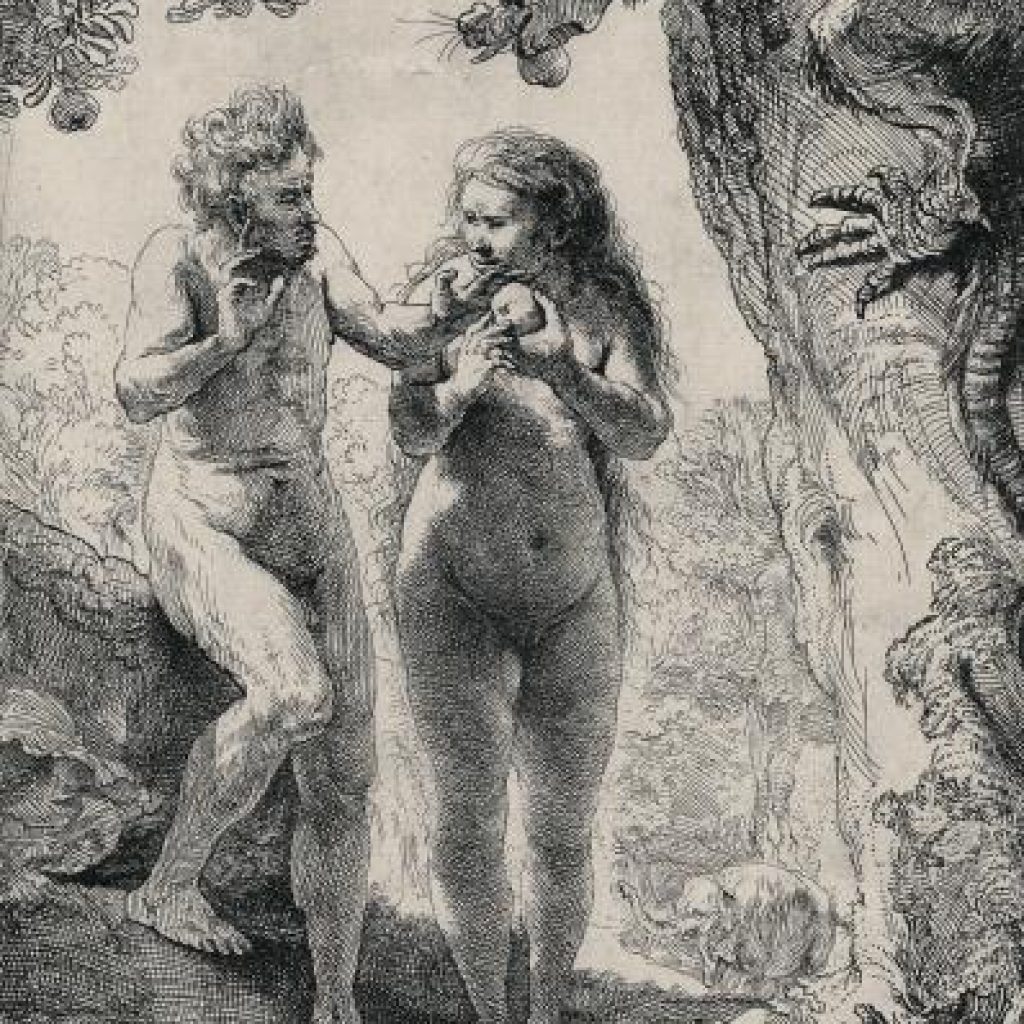
Celebrating the life and legacy of the legendary Dutch painter and etcher Rembrandt van Rijn, the Nevada Museum of Art presents a major exhibit of etchings in Rembrandt: The Embrace of Darkness and Light.
The post Major Collection of Rembrandt Etchings and the Artist's Studio on View appeared first on Park West Gallery.
]]>
For over 40 years, Park West Gallery has been a world-wide source for collectors of original etchings by Rembrandt Van Rijn, the artist viewed by so many as the greatest etcher of all time. Learn all about Rembrandt and the art of etching at the Park West Gallery/Rembrandt Website >
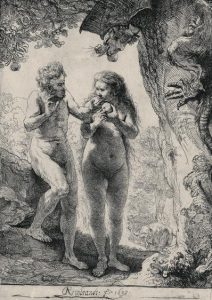
"An expressive storyteller, Rembrandt is perhaps best recognized for achieving dramatic narratives and emotionally-charged scenes by emphasizing and embracing contrasts between darkness and light," said Ann Wolfe, Curator of Exhibitions and Collections, Nevada Museum of Art. "In this exhibition, viewers will experience a gallery space that has been transformed using elements inspired by the 17th-century Dutch architecture Rembrandt would have encountered during his lifetime."
Presented in an intimate jewel-box setting, the small-scale etchings trace Rembrandt's entire career as a printmaker and demonstrate his innate understanding of the human condition. Unlike many artists before him, Rembrandt recognized that the practice of etching responded best to a lighter touch resulting in a baroque richness of detail and texture. His method of copper-plate etching, using fine lines and flicks without outlines, was original and rarely used by artists who came after him.
The exhibition features a number of recognizable works including Self-Portrait Leaning on a Stone Sill, a 1639 etching, in which Rembrandt depicts himself as a Renaissance courtier dressed in opulent attire with an upturned collar and embroidered gloves—an appropriate costume for an artist just beginning to taste the fruits of his success following his permanent move to Amsterdam the same year. In The Woman With the Arrow (Venus and Cupid), a 1661 etching, Rembrandt depicts the female nude, a primary theme in his printmaking from 1658 to 1661. Deep in the shadows one can barely make out a mysterious face with coal-black eyes. Some have suggested that the figure is Cupid—taunted by Venus who has taken away his arrows. In the lively 1638 biblical etching depicting the story of Adam and Eve, Rembrandt seized the opportunity to explore the battle of the sexes with comic irony. Eve is clearly the stronger figure who enticingly displays the fatal apple, while Adam appears surprisingly weak and hesitant. The serpent, Satan, takes the form of a winged dragon, while a tiny elephant represents the animal population of a lush and leafy paradise.
Rembrandt: The Embrace of Darkness and Light is now on view through January 17, 2010.
For more information, please visit www.nevadaart.org
Related Links:
- Park West Gallery Master Sites: Rembrandt van Rijn
- Rembrandt in Focus at the National Museum Wales
- Rembrandt's People at the Wadsworth Atheneum Museum of Art
- The Brilliant Line: Following the Early Modern Engraver
The post Major Collection of Rembrandt Etchings and the Artist's Studio on View appeared first on Park West Gallery.
]]>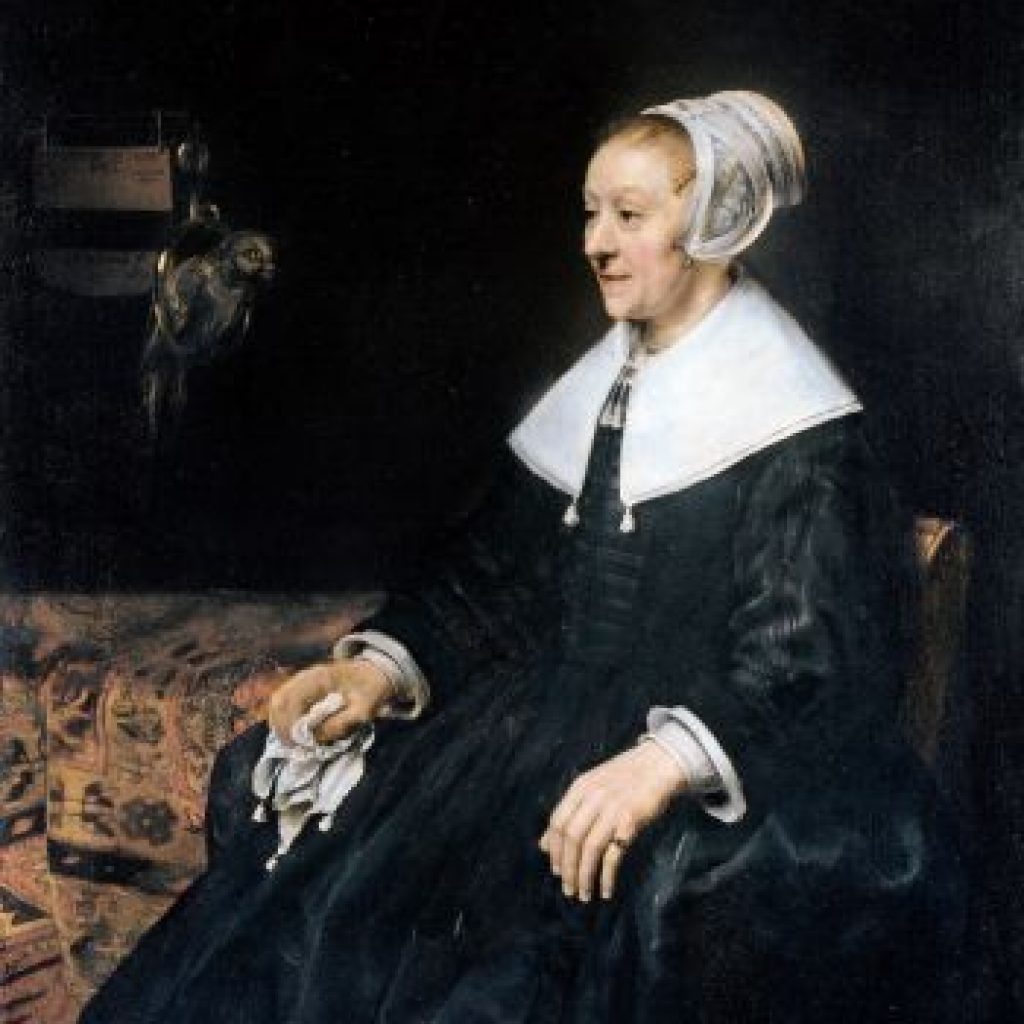
A special loan of Rembrandt van Rijn's (1606-1669) Portrait of Catrina Hooghsaet from Penrhyn Castle is on view at National Museum Cardiff.
The post Rembrandt in Focus at the National Museum Wales appeared first on Park West Gallery.
]]>
For over 40 years, Park West Gallery has been a world-wide source for collectors of original etchings by Rembrandt Van Rijn, the artist viewed by so many as the greatest etcher of all time. Park West – Rembrandt Website >
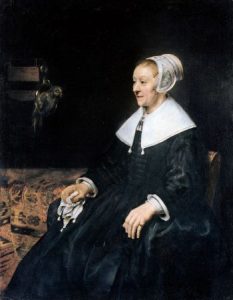
The portrait of the wealthy Amsterdam lady, painted in 1657, is an example of Rembrandt's outstanding talent for painting characters, not just faces. It demonstrates his ability to combine fine detail, blurred impressions and dramatic effects of light and shade.
Rembrandt was also a brilliant printmaker. Examples of his etchings, with which he experimented to achieve unprecedented tones and expressive effects, also form part of the Rembrandt in Focus display. These are joined by Netherlandish portraits of three other women including a painting of the Welsh heiress Katheryn of Berain, attributed to Van Cronenburgh.
During the 1650s, Rembrandt was the most celebrated artist in Amsterdam. Today, he's recognized as one of the most important figures in the history of art and his work continues to inspire artists across the globe.
Rembrandt in Focus is now on view through March 21, 2010.
For more information, please visit www.museumwales.ac.uk/en/home
Related Links:
- Rembrandt's People at the Wadsworth Atheneum Museum of Art
- The Brilliant Line: Following the Early Modern Engraver
The post Rembrandt in Focus at the National Museum Wales appeared first on Park West Gallery.
]]>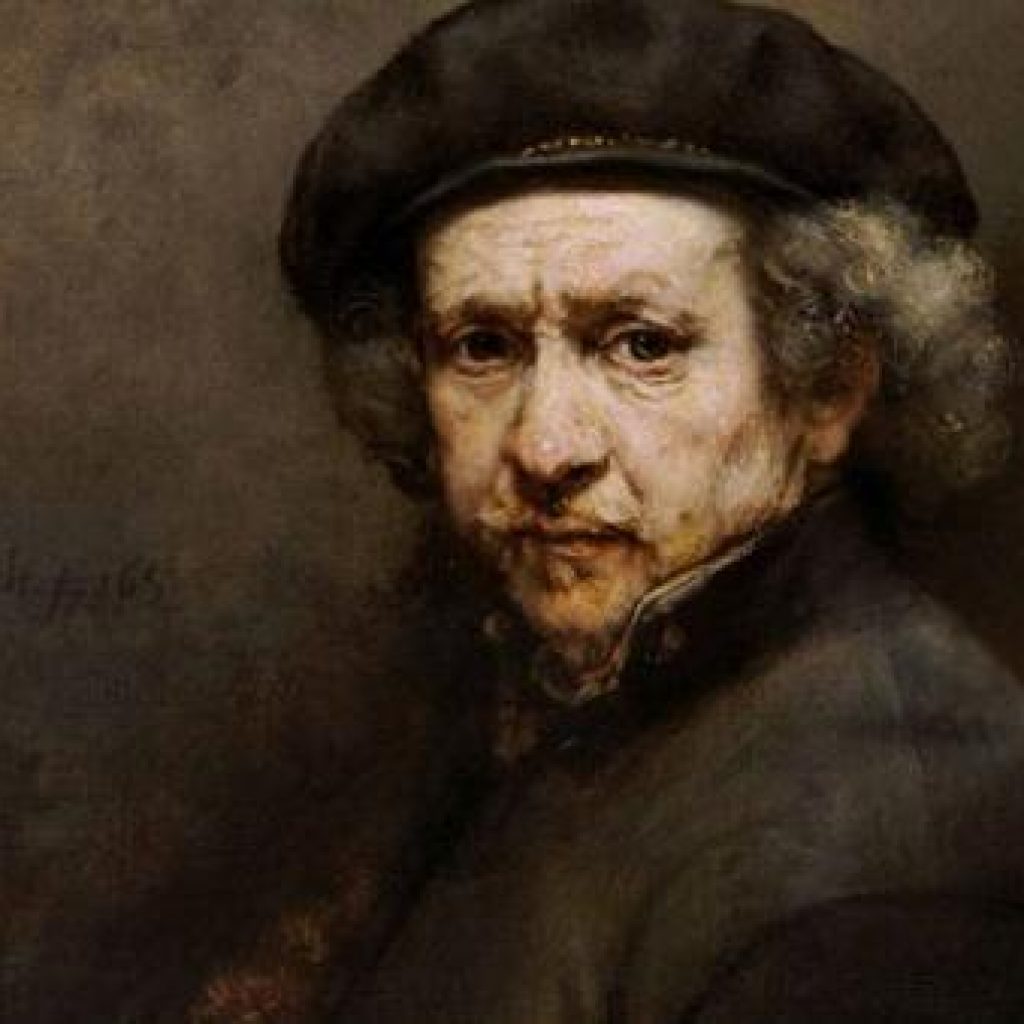
Seven of Rembrandt's most expressive portraits are on view in a new exhibition, entitled Rembrandt's People, at the Wadsworth Atheneum Museum of Art.
The post Rembrandt's People at the Wadsworth Atheneum Museum of Art appeared first on Park West Gallery.
]]>
For over 40 years, Park West Gallery has been a world-wide source for collectors of original etchings by Rembrandt Van Rijn, the artist viewed by so many as the greatest etcher of all time.
More about the Park West Gallery – Rembrandt Collection >>
HARTFORD, CONNECTICUT — Seven of Rembrandt's most expressive portraits are on view in a new exhibition, entitled Rembrandt's People , at the Wadsworth Atheneum Museum of Art. The exhibition features Rembrandt's powerful figure paintings, which are hailed as his greatest artistic achievement. The show will bring the first authentic Rembrandt paintings to Hartford in almost 70 years. The exhibition will showcase works from throughout the artist's career, including his iconic Self Portrait from 1659.
Rembrandt's People will feature nine paintings, encouraging visitors to look closely at Rembrandt's most expressive portraits. Each painting in the exhibition has its own significance, but particularly outstanding is Rembrandt's powerful Self Portrait, which he painted at age fifty-three. In addition to the self portrait, Rembrandt's People will present a range of iconic portraits including Rembrandt's depiction of a humble young Jewish man (ca. 1663) and the well-dressed Lady with a Lap Dog (ca. 1662).
The Wadsworth's own connection to Rembrandt has been elusive and debate over the authenticity of "Rembrandt" paintings continues within the art world. Included in the exhibition are two portrait paintings originally acquired by the Wadsworth as Rembrandts, but both attributed by later research to the "School of Rembrandt." The exhibition of these two paintings along side their authentic counterparts will enable visitors to make direct comparisons between Rembrandt's own work and that of his studio.
Rembrandt's People is now on view through January 24, 2010.
For more information, please visit www.wadsworthatheneum.org
Related Links:
- Turner and the Masters at Tate Britain
- The Brilliant Line: Following the Early Modern Engraver
The post Rembrandt's People at the Wadsworth Atheneum Museum of Art appeared first on Park West Gallery.
]]>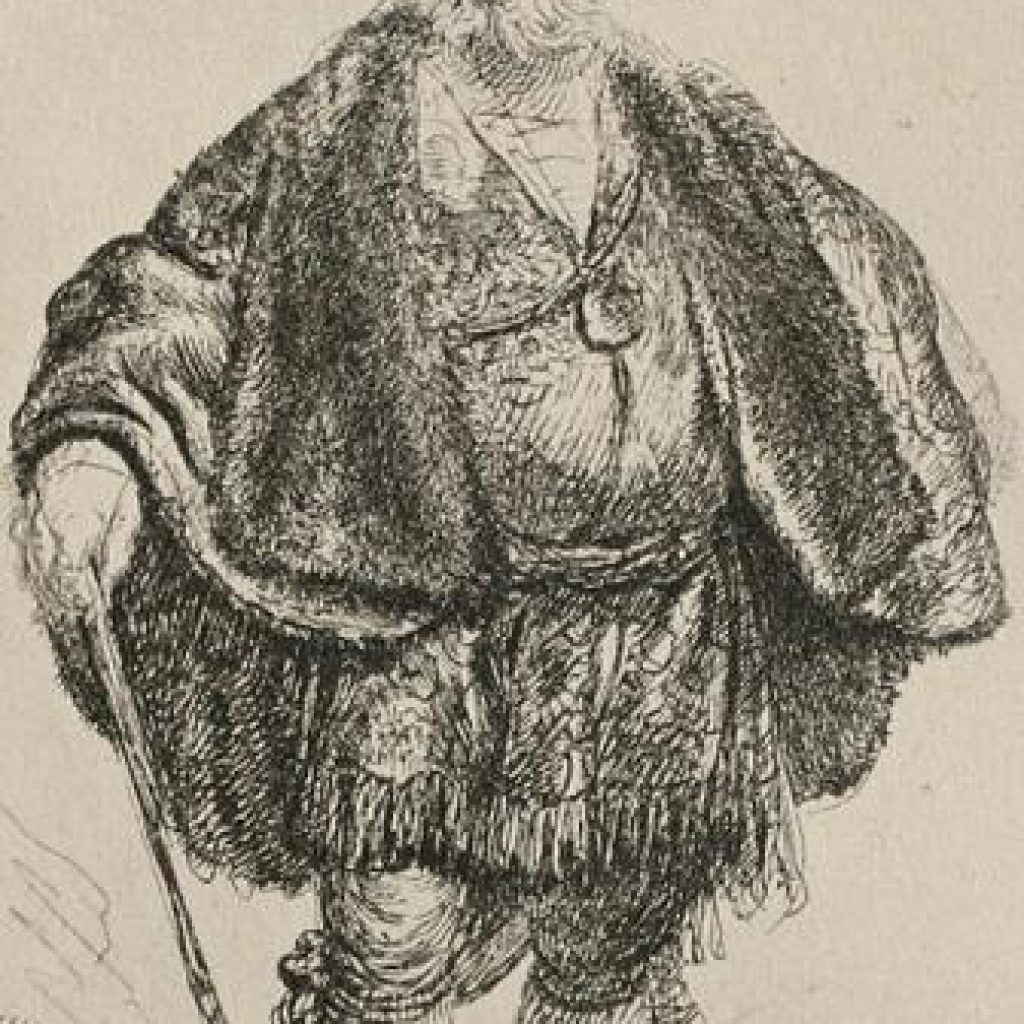
An extraordinary collection of prints and drawings is on view for the first time at the Currier Museum of Art.
The post Currier Museum of Art Presents Evolution of a Shared Vision appeared first on Park West Gallery.
]]>
Started in the 1960s, the Park West Gallery masterworks collection is one of the world's finest, showcasing artwork by Old Masters like Dürer and Rembrandt. For information on the Park West Gallery Rembrandt collection or to learn more about the artist and the art of etching, please visit the Park West Gallery – Rembrandt Collection Website >
MANCHESTER, NH — An extraordinary collection of prints and drawings, carefully assembled over a 50-year period by long-time New Hampshire residents David and Barbara Stahl, is on view for the first time at the Currier Museum of Art.
The earliest prints are by some of the most important old master print-makers including Dürer, Rembrandt, and Callot. The strength of the collection is in American twentieth-century prints and drawings by internationally-known artists such as Edward Hopper, John Sloan, and Reginald Marsh. Also notable is an exquisite group of impressions by German Expressionist artists George Grosz, Erich Heckel, Max Beckmann, and Emil Nolde.
As young collectors in the late 1950s and early 1960s, Barbara and David Stahl sought out the sage advice of Charles Buckley, director of the Currier from 1955 through 1964. The union of Mr. Buckley's art historical knowledge and academic acumen and the Stahls' passion for the arts and willingness to learn were the guiding forces from which this distinguished collection was formed.
David Stahl encourages young art appreciators to begin collecting. "When we started collecting, there were many surprising purchases made for modest sums. It's not so easy for young collectors now, but there are younger artists working in various print media, and older artists as well, many of whose works are affordable for serious collectors of limited means," said Stahl. "There are still opportunities out there, and the quest itself is rewarding."
Evolution of a Shared Vision is now on view through Jan. 3, 2010.
For more information on this exhibit, please visit www.currier.org
Related Links:
- Turner and the Masters at Tate Britain
- The Brilliant Line: Following the Early Modern Engraver
The post Currier Museum of Art Presents Evolution of a Shared Vision appeared first on Park West Gallery.
]]>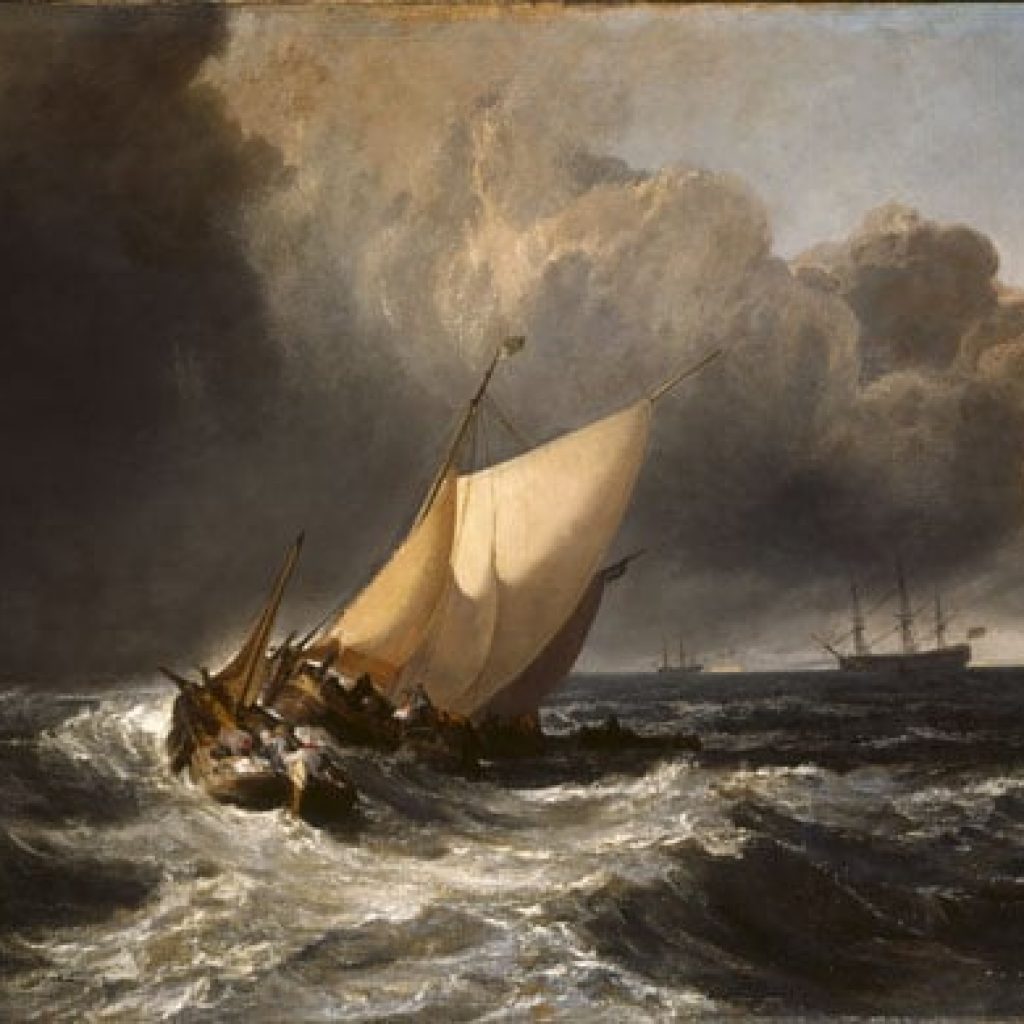
On view at the Tate Britain, Turner and the Masters places beautiful masterpieces by Canaletto, Rubens, Rembrandt and Titian next to some of JMW Turner's most dramatic paintings.
The post Turner and the Masters at Tate Britain appeared first on Park West Gallery.
]]>
Since 1969, Park West Gallery has been a reliable resource for the artwork of Old and Modern Masters, including Rembrandt van Rijn. To learn more about Rembrandt and his artwork, visit rembrandt.parkwestgallery.com >
LONDON — On view at the Tate Britain, Turner and the Masters places beautiful masterpieces by Canaletto, Rubens, Rembrandt and Titian next to some of JMW Turner's most dramatic paintings. It shines light on a lesser-known side of the British Romantic painter: his obsession to prove he was just as good, if not better, than the old masters who he so admired.
Turner was born into a working-class family and relentlessly pursued his ambition to be a great artist, once proclaiming, 'I am the great lion of the day.' He entered into direct competition with artists – past and present – who he considered as worthy rivals to his own fame. In a final act of self-promotion, he asked in his bequest that two of his paintings hang in the National Gallery alongside the work of Claude Lorrain – and you can see these stunning paintings in this exhibition.
Turner also had a great rivalry with John Constable. At the Royal Academy exhibition in 1832, Turner upstaged Constable by adding a dash of red to his own painting at the last minute – and Constable was none too pleased.
This is the first exhibition ever to explore the full range of Turner's challenges to the past, and his fierce rivalry with his contemporaries. Many works are reunited here for the first time in hundreds of years and others have never been seen together before in this light.
Turner and the Masters is currently on view through January 31, 2010.
Exhibit details >>
Related Links:
The post Turner and the Masters at Tate Britain appeared first on Park West Gallery.
]]>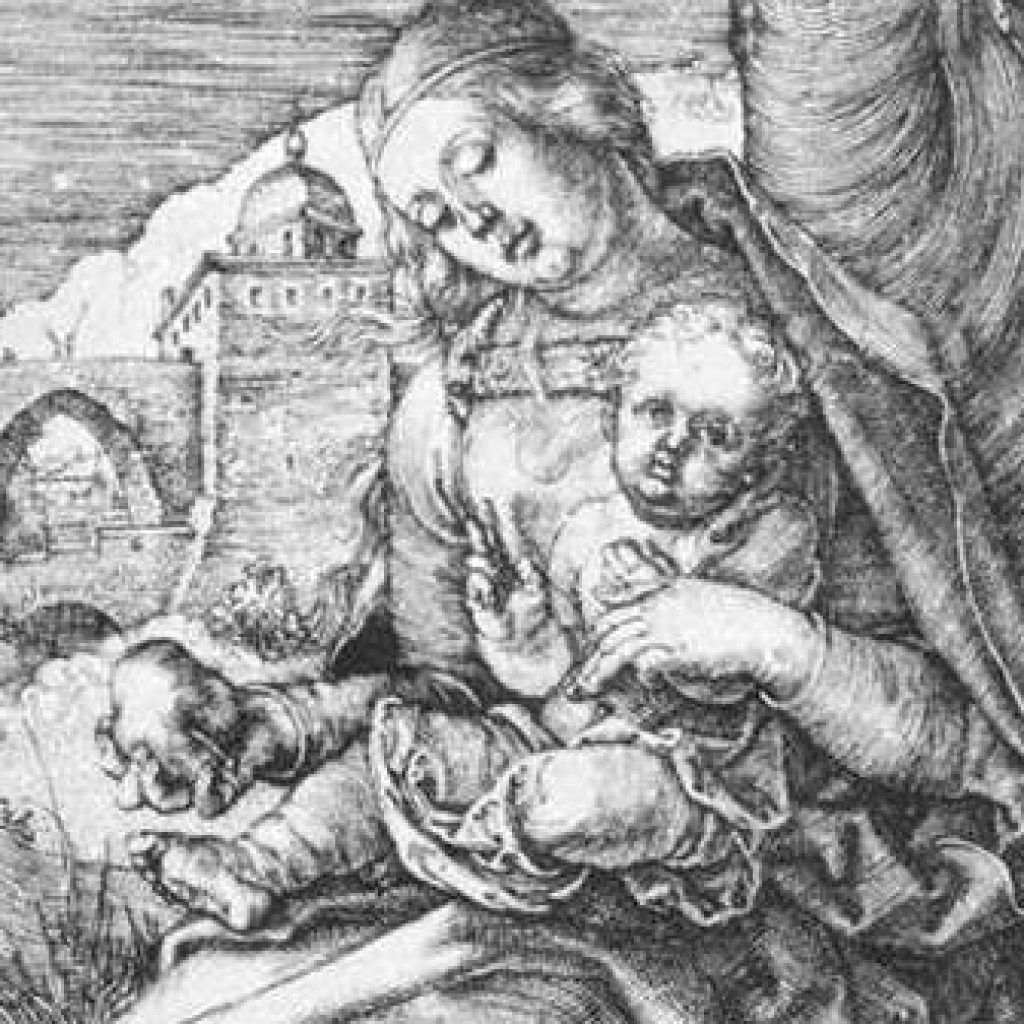
The RISD Museum of Art presents The Brilliant Line: Following the Early Modern Engraver, 1480-1650.
The post The Brilliant Line: Following the Early Modern Engraver appeared first on Park West Gallery.
]]>
The Park West Gallery collection features rare art prints by Old Masters, including Albrecht Dürer – best known for exquisite, intricate woodcuts, engravings and etchings. View selections from the Park West Gallery collection
PROVIDENCE, RHODE ISLAND — The RISD Museum of Art presents The Brilliant Line: Following the Early Modern Engraver, 1480-1650 , featuring 85 objects from the RISD Museum's outstanding collection of Renaissance and Baroque prints — until now unpublished and rarely viewed — as well as objects from major public institutions such as the National Gallery of Art, and the Metropolitan Museum of Art.
Although most people see and even touch an engraving every day — US currency and many stamps are engraved on steel — few artists work in the medium today. In the Renaissance engraving was new, and one of the world's first reproducible art forms, full of possibility for the spread of designs of all types throughout Europe. The Brilliant Line focuses on the height of the medium, from 1480 to 1650, when engravers made dramatic and rapid visual changes to engraving technique as they responded to the demands of reproducing artworks in other media.
Engravers learned quickly from one another by buying and trading engravings and meeting fellow practitioners on transcontinental travels. The exhibition takes an international approach, following connections among engravers from Nuremberg, to Rome, to Paris, and the cumulative effects of the knowledge they shared. Objects on view lay out the medium's continuities, or "systems" — those visual tricks that responded so well to the pictorial problems of tone, texture, and volume — while highlighting the exceptional ingenuity of individual engravers.
Visitors will be invited to think about the relationships between spectacular prints by Albrecht Dürer and Marcantonio Raimondi, Cornelis Cort and Agostino Carracci, or Martin Schongauer and Robert Nanteuil. Where many Renaissance print exhibitions have emphasized the regional specificity of particular schools, assembling all printmaking techniques together, this exhibition outlines the fluid geography of engraving and the particular history of one medium as it was shaped by its specific applications and circumstances of production.
The Brilliant Line is currently on view through January 3, 2010.
For more information, please visit www.risdmuseum.org
Related Links:
- Word and Image/Word as Image at the Portland Art Museum
- The Park West Gallery Rembrandt Collection website
- Discover more about your favorite artists at Park West Gallery
- View selections from the Park West Gallery artwork collection
The post The Brilliant Line: Following the Early Modern Engraver appeared first on Park West Gallery.
]]>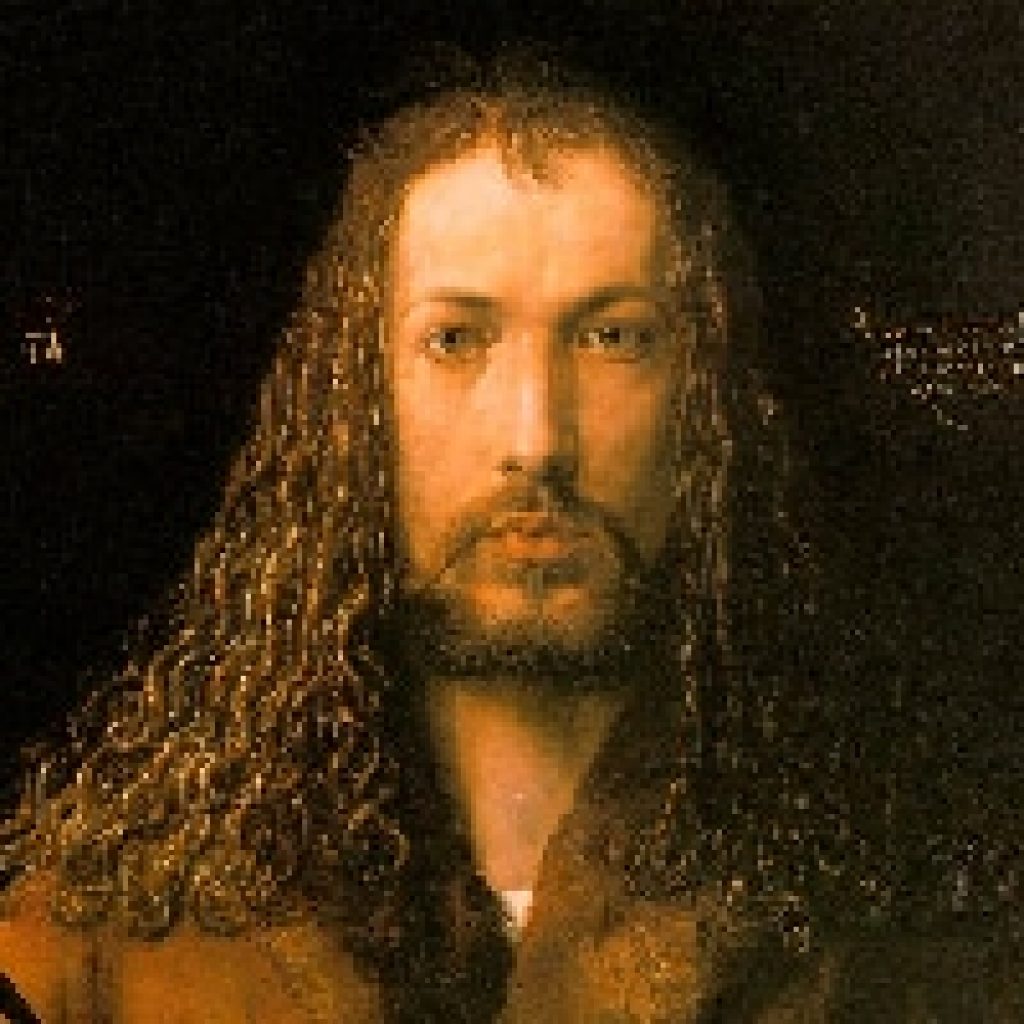
August 13 is International Lefthanders Day! Southpaws, celebrate your uniqueness along with the other 7-10% of the world's left-handed population, including these 10 artists.
The post Top Ten Lefty Artists appeared first on Park West Gallery.
]]>
AUGUST 13 is International Lefthanders Day! The holiday was first observed on this day in 1976 as an effort to promote awareness of the inconveniences facing left-handers in a predominantly right-handed world. It is often speculated that lefties are right-brain dominant – the side of the brain linked to non-verbal thinking, artistic ability and creative skills.
So southpaws, celebrate your uniqueness along with the other 7-10% of the world's left-handed population, including these 10 artists:
1) Albrecht Dürer
2) Raoul Dufy
3) M.C. Escher
4) Thomas Kinkade
5) Paul Klee
6) Michelangelo
7) LeRoy Neiman
8) Raphael
9) Rembrandt van Rijn
10) Leonardo da Vinci
Source: About.com
Related Links:
- See more famous and celebrity lefties
- Learn more about the history of International Lefthanders Day
- Visit the Park West Gallery – Thomas Kinkade website
- Visit the Park West Gallery – Rembrandt website
- Discover more about your favorite artists at Park West Gallery
The post Top Ten Lefty Artists appeared first on Park West Gallery.
]]>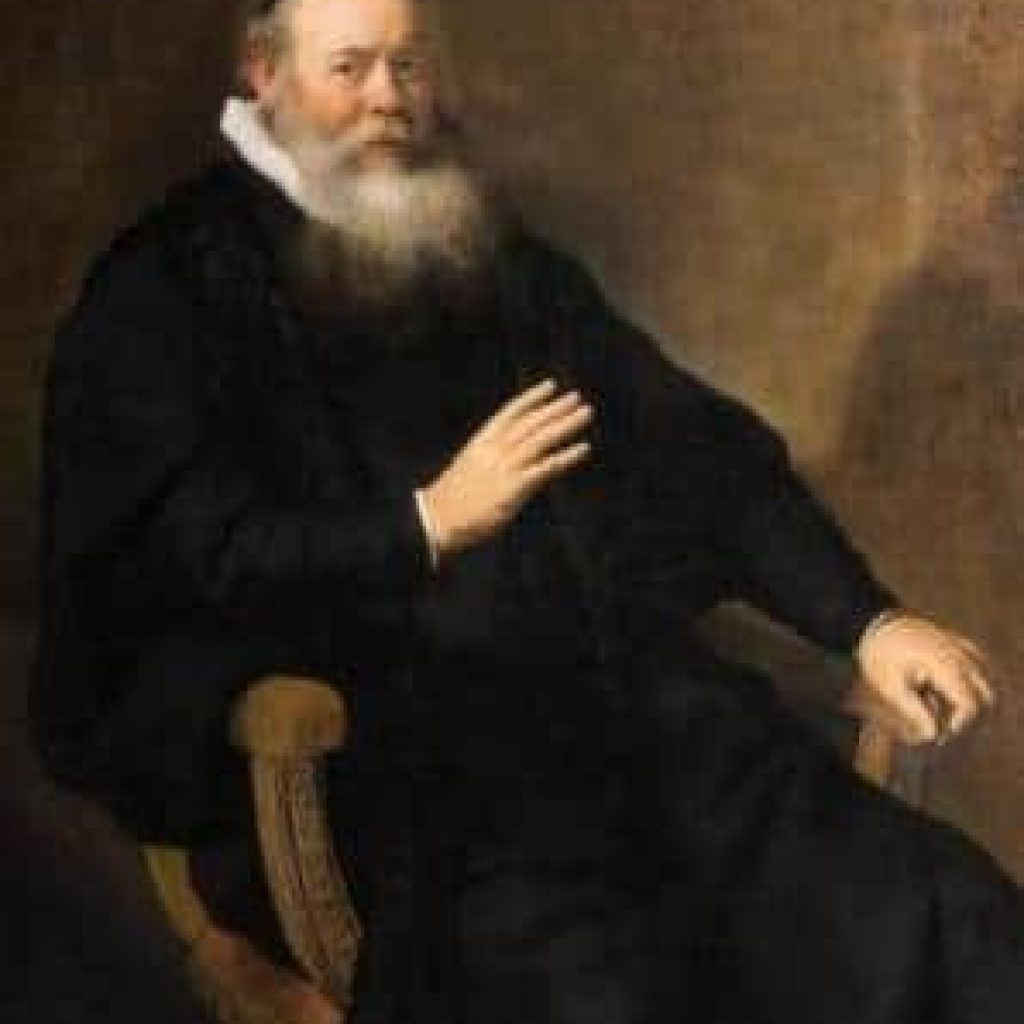
The painting has been there since 1886, but it is only now that the Royal Museum of Fine Arts of Antwerp is 100% sure: the portrait of Eleazar Swalmius is an authentic Rembrandt.
The post Authentic Rembrandt Painting Emerges From Hiding appeared first on Park West Gallery.
]]>
ANTWERP, BELGIUM — "The painting has been there since 1886, but it is only now that the Royal Museum of Fine Arts of Antwerp is 100% sure: the portrait of Eleazar Swalmius is an authentic Rembrandt." So leads De Morgen's culture page.
The painting of the preacher, which had been part of a collection belonging to Louis XIV's brother, the Duke of Orléans, was bought by the museum for 200,000 francs (the equivalent of 5,000 euros). For many years it was attributed to Govert Flinck, another painter of the period, and at one point was even placed in storage.
An anonymous Dutch businessman financed the recent restoration, which removed several layers of yellowed varnish to reveal "a magnificent and dazzling work." Fresh evidence from x-rays, and more research on the signature and the threads used in the canvas have left no doubt about its authenticity.
Dutch art historian and Rembrandt expert Ernst van de Wetering explains that "the freedom in the structuring of the image, the manner of painting and the temperament are typically Rembrandt."
Source: presseurop
Related Links:
The post Authentic Rembrandt Painting Emerges From Hiding appeared first on Park West Gallery.
]]>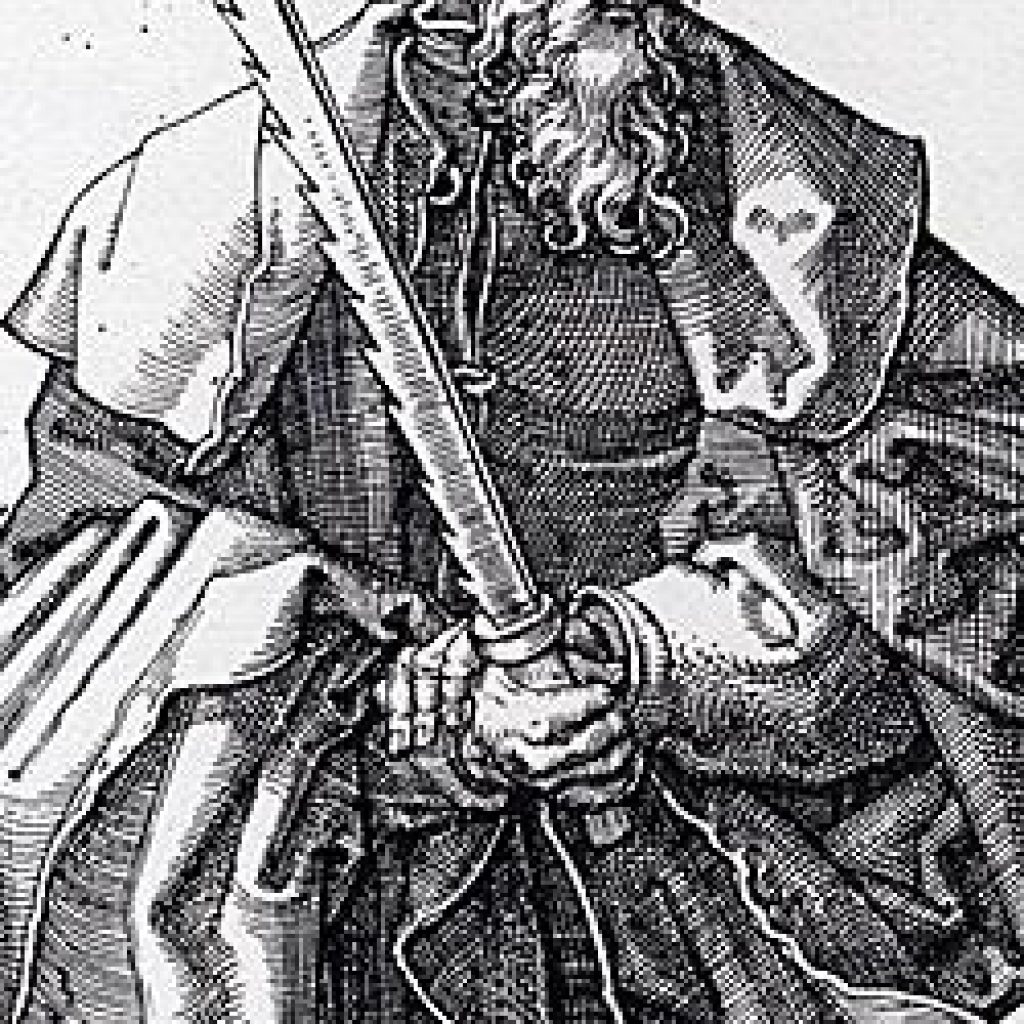
The Bell County Museum is hosting an astonishing exhibition of prints, The Inspired Line: Selected Prints of Albrecht Durer and Rembrandt van Rijn.
The post The Inspired Line: Selected Prints of Albrecht Durer and Rembrandt van Rijn appeared first on Park West Gallery.
]]>
BELL COUNTY, TEXAS — The Bell County Museum is hosting an astonishing exhibition of prints, The Inspired Line: Selected Prints of Albrecht Durer and Rembrandt van Rijn . The collection consists of 40 prints and provides an opportunity to view the religious works of these great masters side by side and consider the historical contexts, religious backgrounds, and aesthetic approaches of each.
Although Albrecht Dürer (German, 1471-1528) and Rembrandt Harmensz van Rijn (Dutch, 1601-1669) created their artwork a century apart, connections between their prints are significant, intriguing, and often remarkable.
At a young age, Dürer was trained as a metalworker by his father in Nuremberg, Germany. Later, Dürer applied the same exacting methods to his woodcuts and engravings. His strong admiration for Leonardo da Vinci and the Italian Renaissance led him to become the father of the Northern European Renaissance. Though Dürer was Catholic, he was encouraged by an enthusiastic patron to befriend chief figures of the Protestant Reformation, an act that involved him in religious controversy until his death.
Rembrandt, who began his career as a scholar, imbued his portraits with psychological depth and masterly light and shadow. At the height of his career, he was the most successful artist of the Baroque era on Holland, a time of great prosperity. A lifelong member of the Dutch Reformed Church in a predominately Protestant country, Rembrandt received no church commissions; rather, his patronage came from the thriving middle class. He was a highly accomplished etcher who created unique, profound interpretations of biblical stories.
Both artists rendered multiple scenes of Jesus' life and other New Testament stories, and prints of these biblical themes are especially strong in this collection. Viewed together, the works illustrate the differences in aesthetic movements and religious influences of their times, yet by sharing a subject matter, they are ideal counterpoint images.
The Inspired Line: Selected Prints of Albrecht Durer and Rembrandt van Rijn is currently on view through August 18, 2009.
Source: www.bellcountytx.com/Museum
________________________________________________________
Related Links:
The post The Inspired Line: Selected Prints of Albrecht Durer and Rembrandt van Rijn appeared first on Park West Gallery.
]]>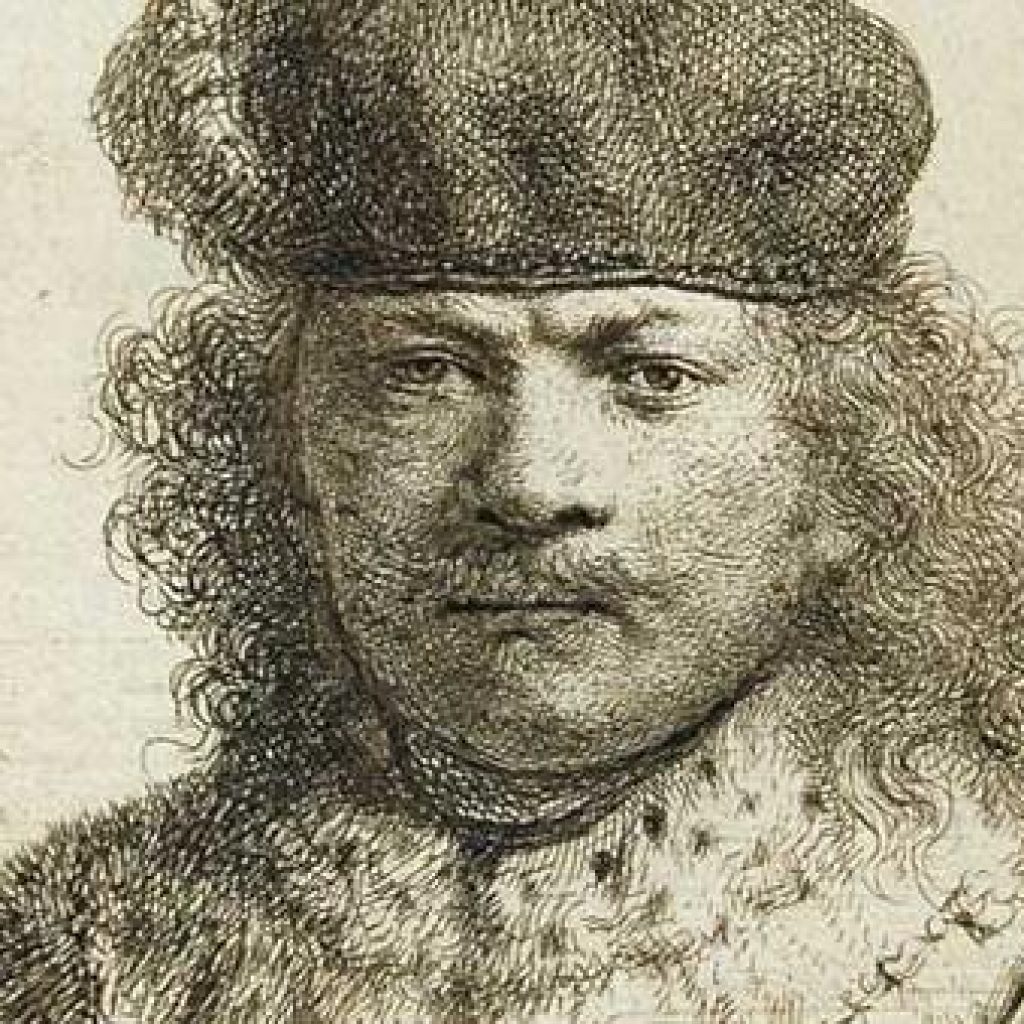
Al Salmi Library will present Rembrandt in Oman, a grand exhibition of 100 original Rembrandt prints from the Rembrandt House Museum in Amsterdam.
The post Rembrandt Exhibit in Oman Will Be the First of Its Kind in the Middle East appeared first on Park West Gallery.
]]>
MUSCAT, OMAN /OmanObserver.com — Al Salmi Library will present Rembrandt in Oman , a grand exhibition of 100 original Rembrandt prints from the Rembrandt House Museum in Amsterdam.
"This will be the first time the works of Rembrandt will be on public display not only in Oman but also in the entire Middle East and North African region," said Stefan van Wersch, Ambassador of the Netherlands.
Rembrandt Harmenszoon van Rijn was the first to develop etching as a true artistic medium by using the scribbling strokes to produce extraordinary and expressive lines. He used a variety of subjects in his etchings that include portraits, landscapes and scenes from everyday life, said Abdullah Salem al Salmi, chairman, Al Salmi Library. The grand exhibition is going to illustrate the full range of subjects including scenes from the Bible, mythology and other classical sources.
Rembrandt in Oman will be on view at the Grand Hyatt Muscat from August 19 to September 19.
Read the full article >>
Related Links:
-
To learn more about Rembrandt, visit Park West Gallery's new website dedicated to the master rembrandt.parkwestgallery.com
-
View selections of Rembrandt artworks from the Park West Gallery collection sales.parkwestgallery.com
The post Rembrandt Exhibit in Oman Will Be the First of Its Kind in the Middle East appeared first on Park West Gallery.
]]>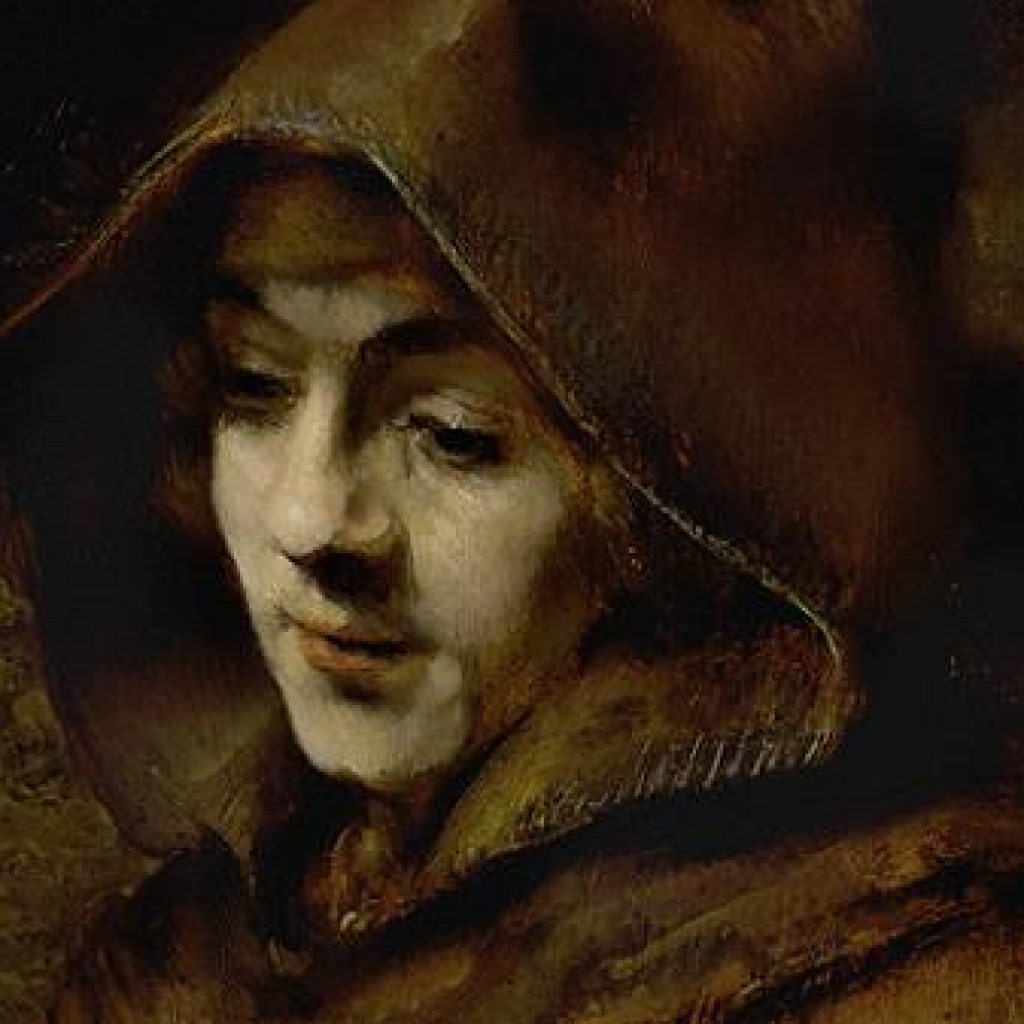
The Vancouver Art Gallery is currently showing Vermeer, Rembrandt and the Golden Age of Dutch Art: Masterpieces from the Rijksmuseum, the largest and most significant collection of 17th century Dutch art ever presented in Canada.
The post Vermeer, Rembrandt and the Golden Age of Dutch Art: Masterpieces from the Rijksmuseum appeared first on Park West Gallery.
]]>
VANCOUVER, BC — The Vancouver Art Gallery is currently showing Vermeer, Rembrandt and the Golden Age of Dutch Art: Masterpieces from the Rijksmuseum , the largest and most significant collection of 17th century Dutch art ever presented in Canada.
On view now until September 13, 2009, the exhibition of 128 works of art features some of the finest paintings by celebrated masters such as Frans Hals, Rembrandt van Rijn and Johannes Vermeer, as well as a remarkable selection of drawings and decorative arts.
The seventeenth century in the Netherlands, a time now known as the Golden Age, saw the new Dutch Republic emerge as one of world's foremost powers. The five decades of the Golden Age set the stage for one of the most spectacular periods in European art history.
Vermeer, Rembrandt and the Golden Age of Dutch Art is divided into eight sections: Maritime Power, The Artist and His World, Still Life, The City, The Dutch Landscape, Travelling Artists, Portraiture and Scenes of Everyday Life, each revealing intriguing details about life in the burgeoning Republic.
Source: www.vanartgallery.bc.ca
Did you know? Park West Gallery has a website dedicated to Dutch master, Rembrandt van Rijn! Visit rembrandt.parkwestgallery.com — and be sure to comment below with your feedback!
Related Links:
-
View selections of Rembrandt artworks from the Park West Gallery collection sales.parkwestgallery.com
The post Vermeer, Rembrandt and the Golden Age of Dutch Art: Masterpieces from the Rijksmuseum appeared first on Park West Gallery.
]]>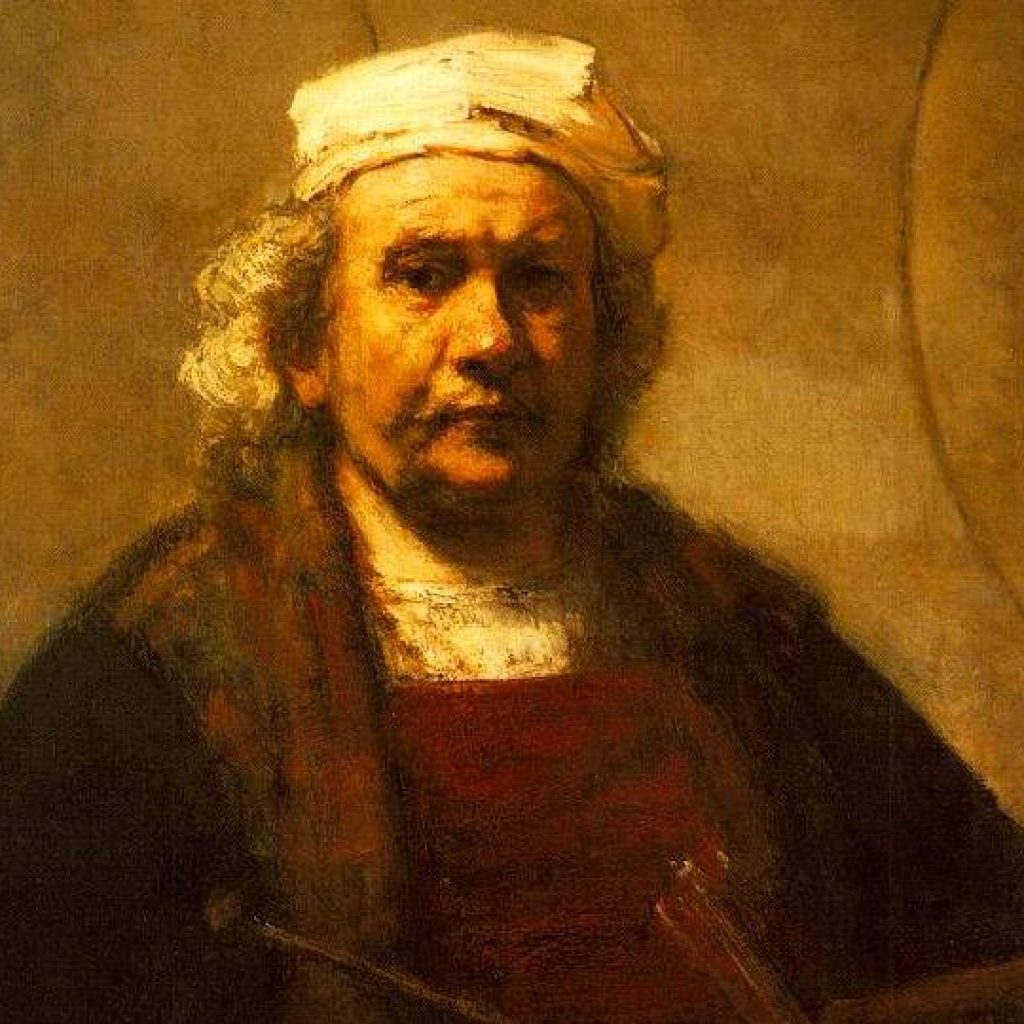
Few realize that Rembrandt Harmenszoon van Rijn revolutionized the medium of printmaking.
The post Happy Birthday Rembrandt van Rijn, the Most Important Painter and Etcher in Dutch History appeared first on Park West Gallery.
]]>
"Try to put well in practice what you already know;
and in so doing, you will in good time,
discover the hidden things which you now inquire about."
—Rembrandt Harmenszoon van Rijn (July 15, 1606 – Oct 4, 1669)
Rembrandt Van Rijn: A Life Etched in Copper
Who was Rembrandt? Most art lovers would answer that he was a painter. A Baroque Master. An emotive genius whose works come to life through a dramatic interplay of shadow and light.
But a printmaker? Fewer people realize that Rembrandt Harmenszoon van Rijn revolutionized the medium. He painted portraits to make a living; he created etchings to test his boundaries.
Rembrandt produced his first etchings by the age of 20 and created more than 300 images during his lifetime—often revisiting the same etching time and again to perfect its execution. His work influenced some of the most renowned print makers in history—including Goya, Whistler, Chagall and Picasso—yet none, save perhaps Picasso, managed to eclipse his virtuosity in the medium.
Popular Success and Personal Tragedy
The ninth of ten children born to Harmen Gerritzsoon van Rijn, a prosperous miller, and Neeltgen Willemsdochter van Zuytbrouck, the daughter of a baker, Rembrandt was born in Leiden, Holland—then considered to be one of the principal artistic and intellectual centers in Holland.
At the age of 13 he enrolled in Leiden University, but soon left to pursue art, first as an apprentice to a history painter in Leiden and later under the tutelage of Pieter Lastman, a famous artist in Amsterdam. Returning to Leiden, Rembrandt opened a studio—while still in his teens—with his friend, Jan Lievens, who had also studied under Lastman.
By the end of 1631, Rembrandt returned to Amsterdam, having accepted a commission from a well-known physician in the city. He lived with Hendrik van Uylenburg, a successful art dealer, whose cousin he married in 1634. Rembrandt's marriage to Saskia van Uylenburg was a boon to his career, providing him access to wealthy patrons who eagerly commissioned his portraits.
As his career flourished, Rembrandt's private life was beset by tragedies. Of the couple's four children, three died before reaching the age of three months. The artist suffered more heartbreak when Saskia died shortly after the birth of their son, Titus, who lived to adulthood—but would pre-decease his father.
After Saskia's death, Rembrandt hired Geertje Direx to care for his young son. When the relationship soured—leading to a legal battle—he turned to Hendrickje Stoffels, who eventually became his common-law wife. While the couple's first child died as an infant, their daughter, Cornelia, survived.
Rembrandt had a penchant for an ostentatious lifestyle and was plagued with an obsessive desire to accumulate art and other possessions. After years of living beyond his means, he was forced to declare bankruptcy in 1656. Over the next two years, his home and many of his possessions were auctioned to pay his creditors.
Having lost his wealth, Rembrandt moved with Hendrickje and his children to a small cottage on the outskirts of Amsterdam. He outlived both Hendrickje, who died in 1663 at the age of 37, and Titus, who died in 1668. Within a year of his son's death, Rembrandt died—on October 4, 1669 in Amsterdam—and was laid to rest in an unmarked grave in the Westerkerk.
Related Links:
-
For more information on the artist Rembrandt, visit our new website dedicated to the master rembrandt.parkwestgallery.com
-
View selections of Rembrandt artworks from the Park West Gallery collection sales.parkwestgallery.com
Do you have a favorite work of art or quote by Rembrandt? Share it here!
The post Happy Birthday Rembrandt van Rijn, the Most Important Painter and Etcher in Dutch History appeared first on Park West Gallery.
]]>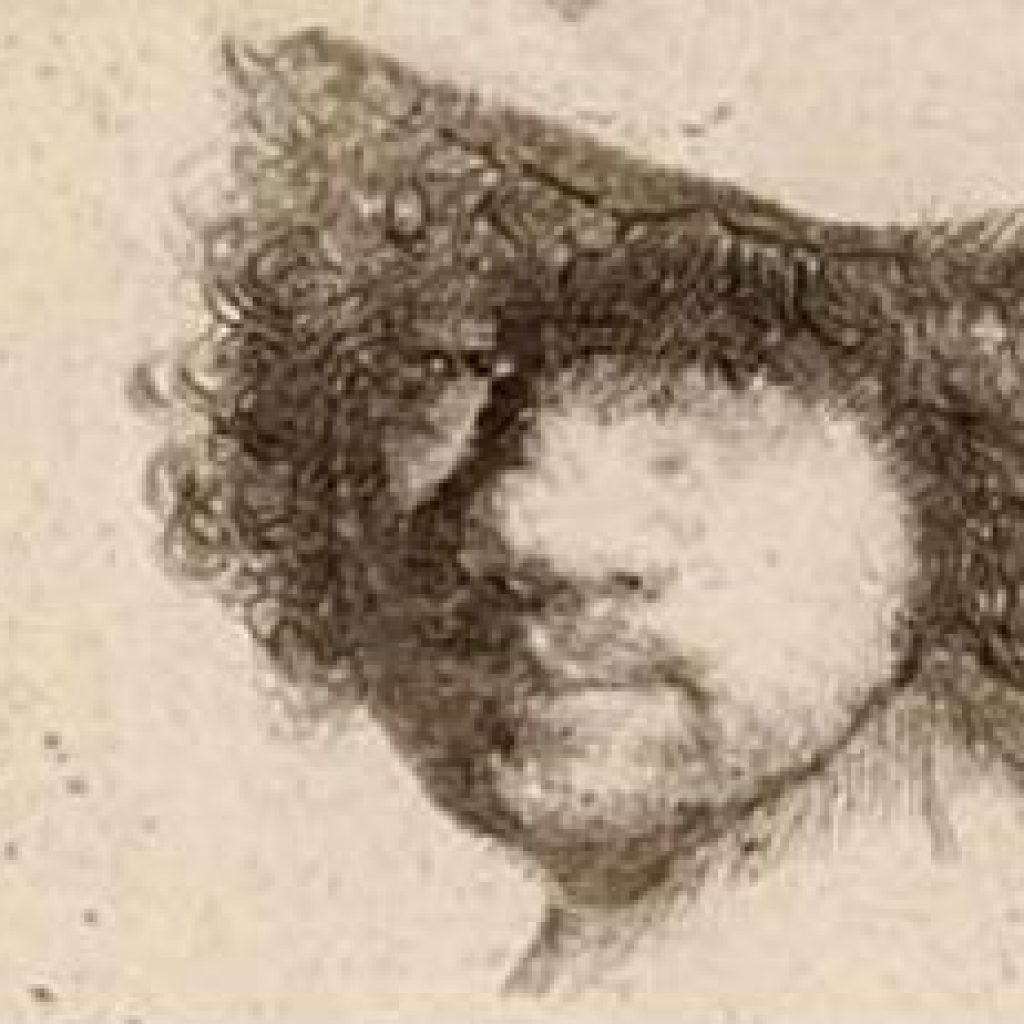
The Bowers Museum is inviting the public to join in its celebration of the 403rd birthday of Dutch master Rembrandt van Rijn. The event, on Wednesday, July 15, will include performances, art projects, and a film screening.
The post Celebrate Rembrandt's 403rd Birthday appeared first on Park West Gallery.
]]>
SANTA ANA, CALIFORNIA — The Bowers Museum is inviting the public to join in its celebration of the 403rd birthday of Dutch master Rembrandt van Rijn. The event, on Wednesday, July 15, will include performances, art projects, and a film screening.
From 10am to 4pm, museum visitors who dress up as Rembrandt or wear their favorite Renaissance costumes will receive free admission all day long. Those in costume will also receive a free piece of cake with any purchase at the museum café.
The exhibition, Sordid and Sacred: The Beggars in Rembrandt's Etchings , features 35 rare etchings executed between 1629 and 1654 and is currently on view at The Bowers Museum until August 23.
In his essay for the exhibition catalogue, Gary Schwartz – Dutch author, art historian, and editor of The Complete Etchings of Rembrandt – writes:
"The image of the beggar in Netherlandish art was no better than in society as a whole. It would not then have been out of line with the convictions of his society, with Netherlandish artistic tradition or classical art theory, had Rembrandt depicted beggars as contemptible or loathsome creatures. Indeed, some of his work fits perfectly well into this picture.
This kind of crossover between street life and sacred history matches a pattern that is found elsewhere in Rembrandt's work. Mean and sordid though they may have been in life and in art theory, in Rembrandt's etchings beggars are bestowed with sanctity and individuality.
This constellation of images and of markets – from the pennies paid for small etchings of beggars to the veritable fortunes Rembrandt earned for paintings for the stadholder – shows how essential Rembrandt's etchings of beggars were in his formative years as an artist. The way he imagined the beggar is inextricable from the way he imagined himself, the way he imagined Christ, the way he conceived of imagery itself."
Rembrandt van Rijn is widely recognized as the greatest practitioner of the etching technique in the history of art.
-
For more on Rembrandt's birthday event, visit www.bowers.org
Have you seen the new Park West Gallery website dedicated to Rembrandt and his etchings? Please visit rembrandt.parkwestgallery.com and share your feedback below!
The post Celebrate Rembrandt's 403rd Birthday appeared first on Park West Gallery.
]]>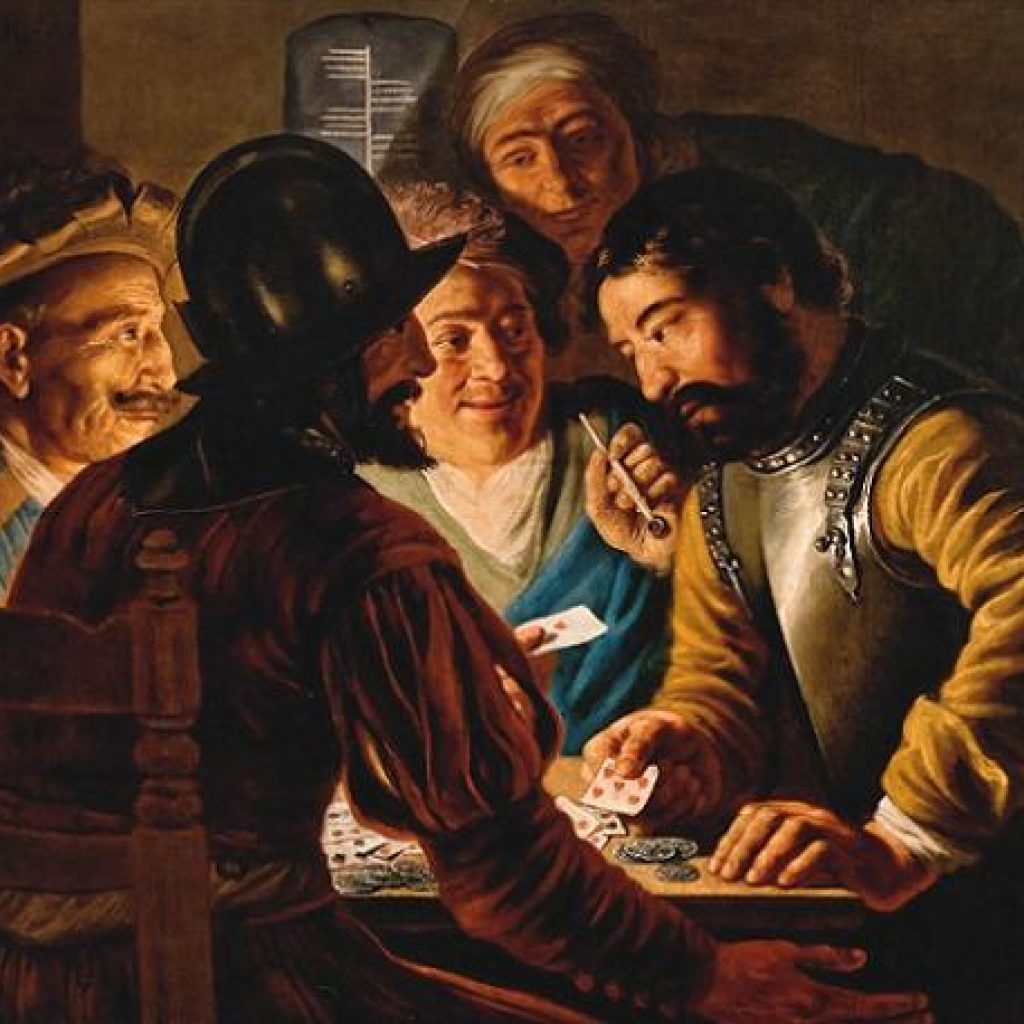
The earliest depiction of Rembrandt has been identified in a painting by his colleague, Jan Lievens.
The post The Teenage Rembrandt Revealed appeared first on Park West Gallery.
]]>
Leading scholar believes that the 16-year-old artist features in a Lievens painting
AMSTERDAM / July 1, 2009 — The earliest depiction of Rembrandt has been identified in a painting by his colleague, Jan Lievens. American art historian Dr. Arthur Wheelock, of the National Gallery of Art in Washington, DC, says that Rembrandt is the central figure in The Cardplayers , 1623-24, when Rembrandt was aged 16.
The painting (shown above), owned by a private collector, is currently on show in a Lievens exhibition at the Rembrandthuis in Amsterdam until August 9. Rembrandt and Lievens studied together in Amsterdam under Pieter Lastman.
Dr. Wheelock is convinced that Rembrandt was the model for the jovial central figure wearing a blue cloak. The figure is similar to Lievens' later Portrait of Rembrandt of 1629 (on loan to the Rijksmuseum from a private collection). The closest Rembrandt self-portrait to the image in The Cardplayers is one of 1629-30, Self Portrait in a Gorget (Germanisches Nationalmuseum, Nürnberg). The figure in the Lievens painting is a jaunty young man, relishing the fate of the loser in the game.
Source: TheArtNewspaper.com
- For Lievens exhibition information visit www.rembrandthuis.nl
- Learn about the Park West Gallery Rembrandt Collection at http://rembrandt.parkwestgallery.com
The post The Teenage Rembrandt Revealed appeared first on Park West Gallery.
]]>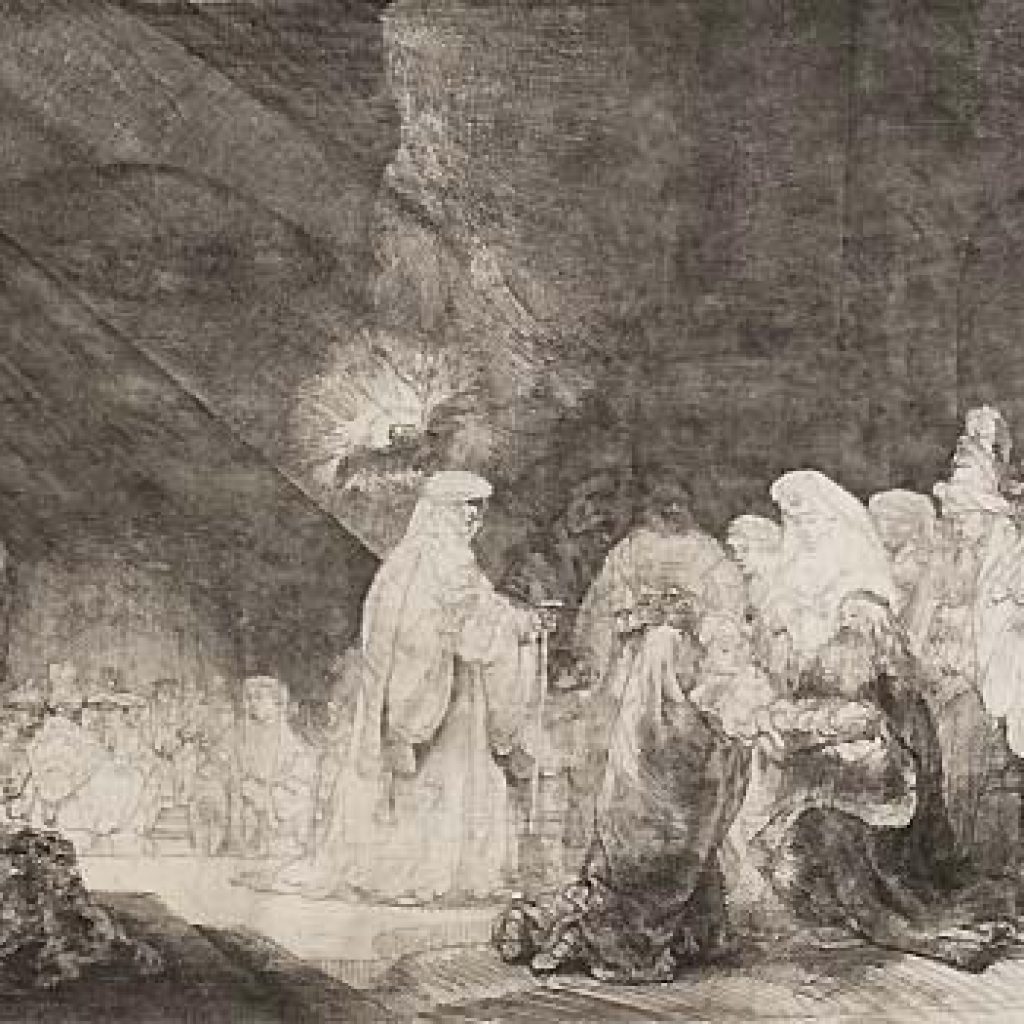
Most Rembrandt etchings fall into one of five categories: Biblical subjects, self-portraits, portraits, landscapes and genre scenes.
The post Subjects of Rembrandt Etchings appeared first on Park West Gallery.
]]>
Most Rembrandt etchings fall into one of five categories: Biblical subjects, self-portraits, portraits, landscapes and genre scenes.
Biblical Subjects
Rembrandt's Biblical subjects comprise a substantial portion of his etching ouvre. They have traditionally been some of the most sought after by collectors and were innovative for their time because of the manner in which they reveal Christ's interaction with the people of His time.
Presentation in the Temple
Self-Portraits
In the late 1620s, Rembrandt began to paint and etch his first self-portraits. Throughout his career he produced many subsequent self-portraits in both mediums. Scholars differ as to Rembrandt's motivation for creating self-portraits. The earliest notion that he could not afford to pay for models has given way to the more cogent idea that in his pursuit of the "psychological portrait," the desire to reveal the human and spiritual nature of the sitter, he used his own face to more deeply contemplate this revolutionary approach for the time.
Self Portrait in a Flat Cap and Embroidered Dress
Portraits
The vast majority of the portraits Rembrandt etched were meant to be used by the sitter, many of which were friends and acquaintances of Rembrandt's, as opposed to being sold to the general public. His earliest portraits are rather simple in terms of the techniques and designs used where as later portraits have more elaborate details and more complex compositions.
Clement de Jonghe, Printseller
Landscapes
During Rembrandt's lifetime prints of the Dutch landscape were extremely popular, and he too used the Dutch landscape as a subject. The inspiration for a large portion of his landscape etchings came from Amsterdam and the surrounding areas; however, Rembrandt is known for putting imaginary elements in the landscapes such as mountains and foreign buildings. While Rembrandt completed most of the landscape etchings indoors by using his drawings as a reference, the spontaneous lines in a few of the etchings indicate that he may have, on occasion, etched outdoors while at the actual location.
Landscape with a Cow Drinking
Genre Scenes
Rembrandt created several etchings that depict everyday scenes, also called genre scenes, and often used street characters such as rootless musicians, beggars and the homeless as his subjects. The compassion he used while portraying these individuals was not the norm at the time. Rembrandt's series of male and female nudes fall under the category of genre as well. Contrary to the majority of his contemporaries who focused on the classical ideal of beauty, Rembrandt depicted his models realistically, revealing their bodies' flaws.
The Strolling Musicians
Learn more about Rembrandt and the Art of Etching
The post Subjects of Rembrandt Etchings appeared first on Park West Gallery.
]]>
Park West Gallery recently launched websites dedicated to two 'Old Masters' - Rembrandt Van Rijn and Pablo Picasso.
The post Park West Gallery Launches Rembrandt and Picasso Websites! appeared first on Park West Gallery.
]]>
Fine Artwork by the 'Old Masters' Featured Exclusively
Park West Gallery recently launched websites dedicated to two 'Old Masters' – Rembrandt Van Rijn and Pablo Picasso. As one of the largest and most respected dealers of both Rembrandt etchings and Picasso graphic works, Park West Gallery has launched these sites to share its knowledge of both masters with collectors and fine artwork appreciators worldwide. The websites feature the works that make up the Park West Rembrandt and Picasso Collections.
Collectors and 'Old Master' aficionados alike will enjoy visiting both sites and learning more about the master artists and their works. Through these new websites, Park West Gallery has made Rembrandt and Picasso fine artwork viewable worldwide and continues its mission of bringing fine art to people everywhere.
The Park West Gallery Rembrandt Website
Features extensive information on the Millennium Edition – a limited edition of posthumous impressions printed by master printer, Marjorie Van Dyke. The site also features many other Rembrandt works available through the Park West Collection. Additional information includes the provenance of Rembrandt's copper plates, the etching process, a timeline of Rembrandt's life and work, and information on the current market for Rembrandt etchings. Visit http://rembrandt.parkwestgallery.com/
The Park West Gallery Picasso Website
Features extensive information on the 347 Series (347 works that were created over a seven month period and became the last hand-signed etchings and engravings Picasso ever produced), and the Suite Vollard (100 Picasso etchings, aquatints and drypoints that are regarded as some of Picasso's greatest graphic achievements). Park West Gallery holds the world's largest collection of works from the 347 Series and one of the largest collections of Suite Vollard etchings. Visit http://picasso.parkwestgallery.com/
The post Park West Gallery Launches Rembrandt and Picasso Websites! appeared first on Park West Gallery.
]]>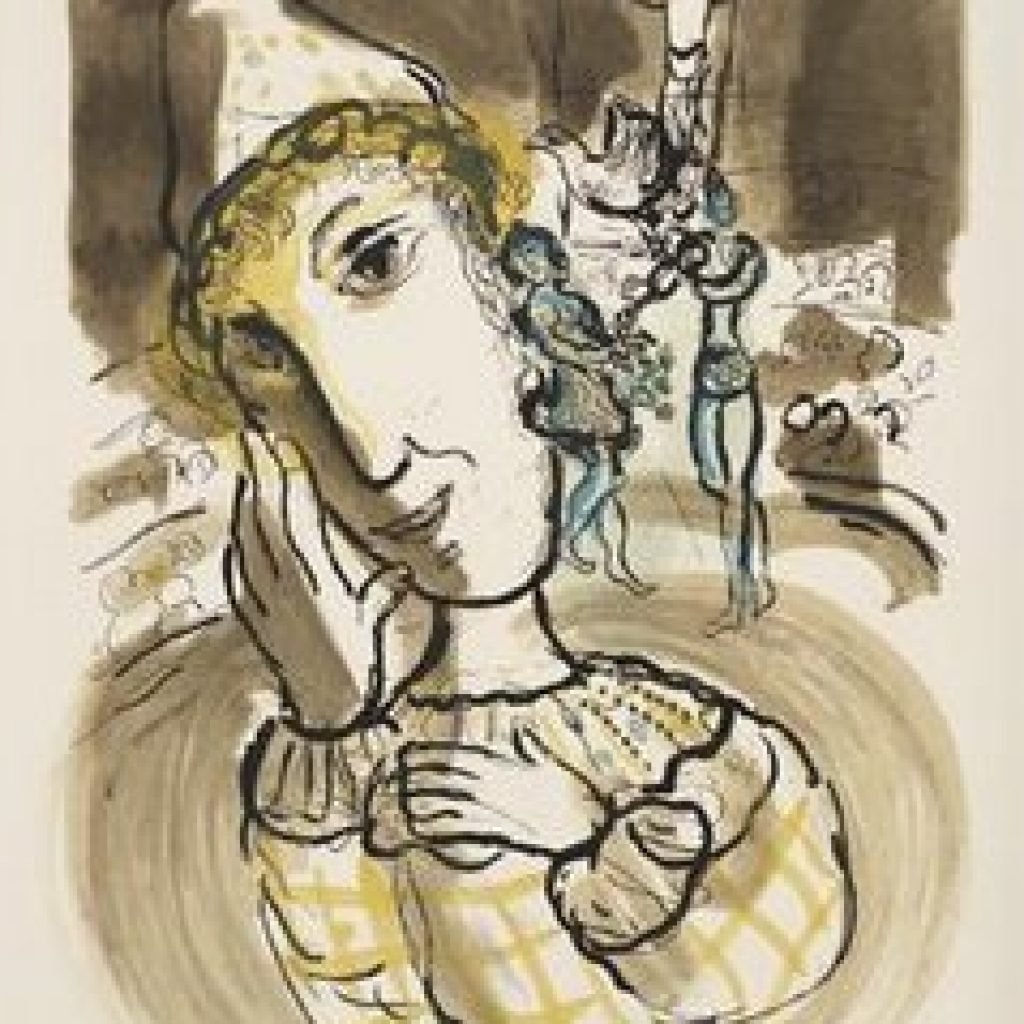
Although April 15th is primarily known for being Tax Day, it is important to remember that it is Art History Day as well.
The post Happy Art History Day from Park West Gallery! appeared first on Park West Gallery.
]]>
Although April 15th is primarily known for being Tax Day, it is important to remember that it is Art History Day as well. Art is all around us and thus time should be spent learning about and appreciating it. Works of art tend to be a reflection of the society in which they were produced, but art can also have a profound effect on society. Some artists have come to be known as masters of the types of art they produced, and their works – no matter how long ago they were created – are still relevant today and continue to speak to those who view them.
The collection of fine art Park West Gallery has amassed over the years is made up of works from a wide variety of artists including those considered masters. One of the masters whose work Park West has made available to collectors is Marc Chagall. Like the French Fauvres who used color without inhibition, Chagall moved toward an expressionist art using "primitive" distortion, simplified line, and large areas of bold unbroken color.
Another old master whose works can be obtained through Park West Gallery is Rembrandt. He was the great master of the Baroque Age, a time known for its dramatic use of light and shadow (chiaroscuro). While he may be known best for his paintings, he revolutionized the medium of etching and remains one of history's most innovative and influential original printmakers.
Over the past 30,000 years that art has been created, a lot has changed in terms of what is considered art and how it's produced amidst other things. Whenever society looks back at the artwork from generations past, much is learned about the history of art and those who created it, but much is also learned about history in general.
The post Happy Art History Day from Park West Gallery! appeared first on Park West Gallery.
]]>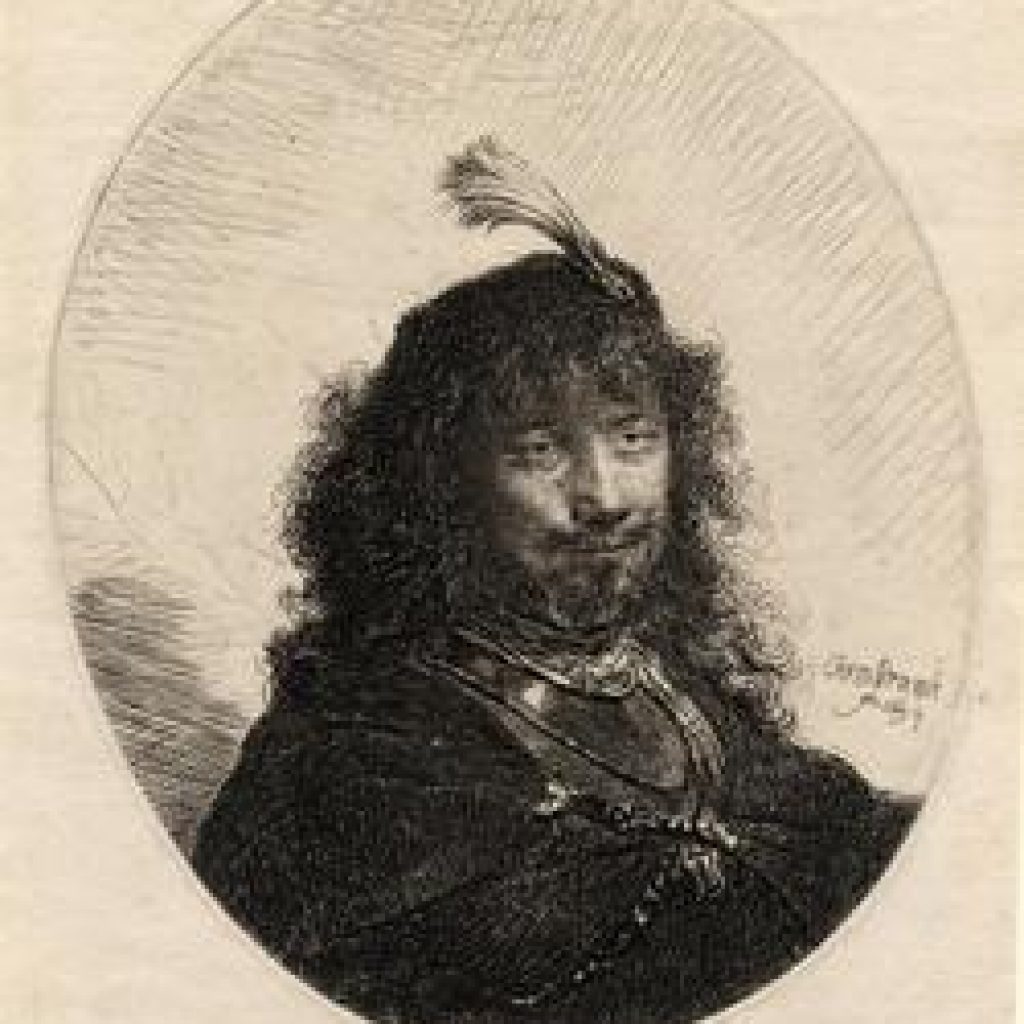
Rembrandt van Rijn is considered by many to be the most innovative and influential etcher and engraver of all time. Rembrandt's contributions to etching and engraving have inspired countless artists, including many of the most important masters of etching who followed him such as Goya, Whistler, Chagall and Picasso.
The post Art Is Nothing But the Dexterity Of An Illusion appeared first on Park West Gallery.
]]>
"Art is nothing but the dexterity of an illusion"
—Rembrandt van Rijn (1606-1669)
Rembrandt van Rijn is considered by many to be the most innovative and influential etcher and engraver of all time. Rembrandt's contributions to etching and engraving have inspired countless artists, including many of the most important masters of etching who followed him such as Goya, Whistler, Chagall and Picasso.
In many ways, Rembrandt's etchings and engravings are his most important artistic contributions, even more so than his paintings. He revolutionized a medium that was in his day simply a copyist's tool. Rembrandt painted portraits to sustain himself financially. He made etchings and engravings for his personal pleasure, to extend the potential of the medium, and to feed his desire for continual creativity. He carried with him a copper plate as most artists carry a sketchbook. Rembrandt created more than 300 etchings during his lifetime, many of which he labored over obsessively, often resulting in multiple states, or variations in the evolution of an image.
Scholars have divided Rembrandt's etching and engraving output into different categories according to the subjects he chose. Each reveals a different facet of the personality of Rembrandt. His portraits reveal his desire to capture the psychological complexity of the sitter and his self-portraits express his general moods and changing personal circumstances over the years. His many religious works demonstrate a vast knowledge of both testaments, while his beggar and genre scenes are still being analyzed for their meaning and intent. As he was the great master of the Baroque Age, a time known for a dramatic use of light and shadow (chiaroscuro), his etchings often convey a powerful mood and a highly theatrical quality, one which has extended his influence to filmmakers and photographers even into the 20th Century.
More than 350 years later, Rembrandt's etchings and engravings continue to astonish us with their virtuosity, insight and dramatic presence.
The post Art Is Nothing But the Dexterity Of An Illusion appeared first on Park West Gallery.
]]>The post What's In a Name? Possibly Everything, for an Artist appeared first on Park West Gallery.
]]>-
François Ledan | aka "Fanch" — a Breton nickname for François
-
Pablo Picasso | birth name: Pablo Diego José Francisco de Paula Juan Nepomuceno María de los Remedios Cipriano de la Santísima Trinidad Martyr Patricio Clito Ruíz y Picasso (imagine signing that on a canvas!) — a series of names honoring various saints and relatives, with Ruiz and Picasso for his father and mother, respectively, as per Spanish custom
-
Yaacov Agam | birth name: Yaacov (or "Jacob") Gipstein
-
Erté| pseudonym derived from French pronunciation of R.T. — the initials of his birth name: Romain de Tirtoff
-
Francisco Goya | birth name: Francisco José de Goya y Lucientes
-
Marc Chagall | birth name: Moishe Shagal — a dialectal North-Eastern Yiddish variant of the surname "Segal"
-
Salvador Dalí | birth name: Salvador Domingo Felipe Jacinto Dalí i Domènech (say that five times fast!)
-
Peter Max | birth name: Peter Max Finkelstein
-
Csaba Markus | Csaba, meaning "he who leaves his country" and Markus, a traditional Hungarian surname derived from Mars (the Greek god of war)
Read the biographies of your favorite Park West Gallery artists
The post What's In a Name? Possibly Everything, for an Artist appeared first on Park West Gallery.
]]>This Printmaking Process Means "stone Writing" In Greek.
Source: https://www.parkwestgallery.com/category/rembrandt-van-rijn/feed/
Posted by: mirandalacceir.blogspot.com

0 Response to "This Printmaking Process Means “stone Writing” In Greek."
Post a Comment